

All Destinations , Asia , Nepal
Best everest base camp trek itinerary (12 days).

Whether you’re planning on hiking in Nepal with a guide or trekking the Khumbu region independently, this Everest Base Camp trek itinerary should give you a clear idea about what to expect.
Everest Base Camp has been on my bucket list for 15 years, ever since I learned about the Himlayas at school.
But I never had a chance to do it until Spring 2024, when my partner’s friends organised a group of us to undertake the hike.
When I was preparing for the hike, I was full of questions. How much money do I need? Is it safe? How should I train?
But, above all, what is the standard Everest Base Camp trek itinerary?
We were provided an itinerary for the trail, but I was craving more details.
So, when I was doing the trek, I decided to put together our detailed Everest Base Camp itinerary to help any future hikers!
This is the standard itinerary that’s followed by most tour groups, with a few variations, and my experience and thoughts about it. If you’re hiking independently I have put a few suggested tweaks in that I think could improve the itinerary.
Let’s get into it!
Everest Base Camp trek itinerary
The typical Everest Base Camp itinerary is as follows:
- Day 1: Flight from Kathmandu to Lukla; trek to Phakding
- Day 2: Phakding to Namche Bazar
- Day 3: Acclimatization day in Namche Bazar
- Day 4: Namche Bazar to Tengbouche
- Day 5: Tengbouche to Dingboche
- Day 6: Acclimatization day in Dingboche
- Day 7: Dingboche to Lobuche
- Day 8: Lobuche to Gorak Shep; visit Everest Base Camp
- Day 9: Hike to Kala Patthar; return to Gorak Shep; trek down to Pangboche
- Day 10: Pangboche to Namche Bazar
- Day 11: Namche Bazar to Lukla
- Day 12: Flight from Lukla back to Kathmandu

This is the itinerary that most tour companies use, give or take a few stops (for example, some groups hike to Manjo rather than Phakding on the first day, or stay in Periche rather than Pangboche on day 9).
And of course, if you’re trekking independently, yours might look a bit different.
Here’s what to expect on each day!
Day one – Fly to Lukla – hike to Phakding

- Start Elevation: Lukla – 2,860 meters (9,383 feet)
- End Elevation: Phakding – 2,610 meters (8,563 feet)
- Elevation Loss: 250 meters (820 feet)
- Distance: Approximately 8 km (5 miles)
- Difficulty: Easy
Your Everest Base Camp hike begins by flying to Lukla airport – often dubbed the “world’s most dangerous airport” ( you can see my thoughts on it here ).
The timing of your flight can vary greatly – it depends on the weather, which is incredibly temperamental at Lukla (as expected at 2,800 metres altitude) and how many passengers. Flights might depart as early as 6 AM or as late as mid-afternoon.
Keep in mind, there’s a 50% chance flights could be cancelled due to weather. If this happens, you might need to wait for the next available flight (which could be the next day) or opt for a helicopter ride at an additional cost (we were told that this would be $400 per person, although I have heard of people paying much cheaper).
Upon arrival in Lukla – elevation 2,860 meters – you’ll feel the anticipation buzzing through the crisp mountain air.
Compared to other villages along the trail, Lukla is positively cosmopolitan, with a variety of shops and tea houses.
The trek to Phakding is a gentle introduction to the Himalayan terrain.
It’s mostly downhill (although there are some ups, too – this is Nepali Flat ) and takes about 3 to 4 hours, covering around 8 kilometres. As you descend to Phakding (2,610 metres), you’ll pass through beautiful landscapes dotted with traditional Sherpa villages and monasteries and walk along the Dudh Koshi River.
The path is well-maintained, with plenty of spots to rest, grab a snack or use the toilet. While the altitude here is significant, it’s generally not high enough to trigger acute mountain sickness, though some of us started feeling the elevation!
Some hikers continue to Monjo, but whether you’ll be able to do this depends on what time your plane lands. I wouldn’t recommend counting on being able to hike past Phakding.
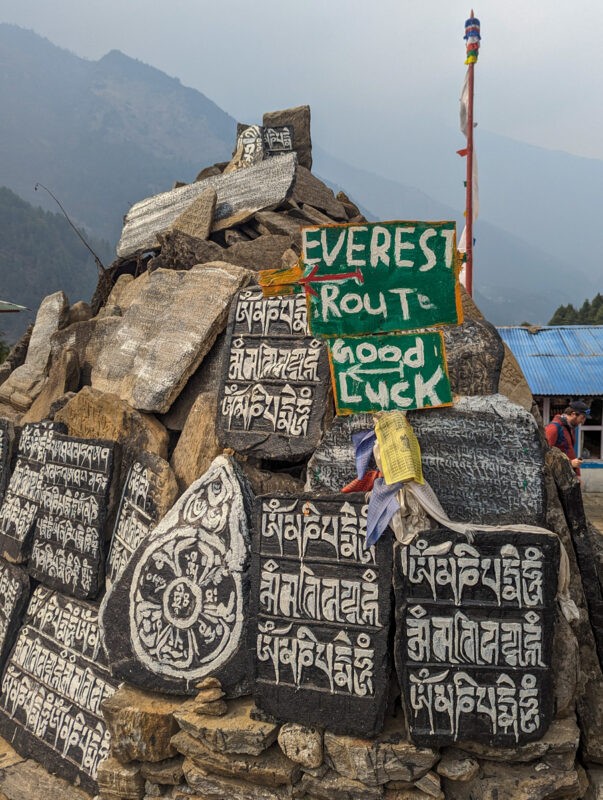
My Suggestions
For a less tiring start to this journey, I’d advise spending the night in Ramechhap or flying to Lukla a day early.
Staying in Kathmandu requires waking up around 2am for the drive to Ramechhap, which can be exhausting even before your trek begins!
Many tour companies offer accommodation arrangements in these locations – if you’re on a private tour, just ask your organiser before heading out.
Where to stay
We stayed in Trekkers Lodge Phakding , which was cosy and well-appointed – I loved the outdoor sitting area with views of the hills! Rooms were en-suite, with a shower – although the water was freezing cold.
Day Two – Phakding to Namche Bazar
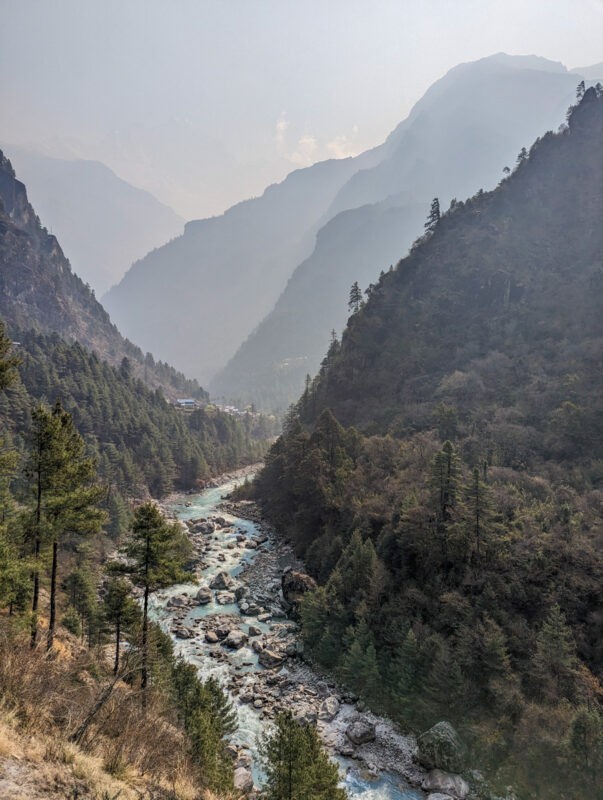
- Start Elevation: Phakding – 2,610 meters (8,563 feet)
- End Elevation: Namche Bazar – 3,440 meters (11,286 feet)
- Elevation Gain: 830 meters (2,723 feet)
- Distance: Approximately 10-12 km (6-7.5 miles)
- Difficulty: Moderate
Today is your first full day on the trail!
Today’s trek from Phakding to Namche Bazar is where the real climbing begins.
The hike starts with a pleasant walk along the Dudh Koshi River, but don’t be fooled by the easy path – it will get more difficult! You’ll cover approximately 10 to 12 kilometres today, which usually takes about 5 to 7 hours without breaks, depending on your pace.
As you leave Phakding, the trail meanders through magnificent pine forests, crossing and recrossing the river several times on suspension bridges draped with prayer flags that flutter in the wind. I found these bridges to be rather hair-raising, but they are stable!
The most famous is the Hillary Suspension Bridge , named after the first Westerner to summit Everest (along with Sherpa Tenzing Norgay ).
Elevation gain is a key part of today’s hike, as you ascend from Phakding at 2,610 meters to Namche Bazar at 3,440 meters – this is quite a lot of altitude to gain at once, but unfortunately, there’s not really anywhere else you can stop (as you’ll gain most of this elevation on the steep climb up to Namche!).
As you approach the village, you might start feeling the altitude – I found the last ascent into Namche particularly challenging.
Namche Bazar, often considered the gateway to the high Himalayas and the largest town in the Everest region, is a bustling sherpa community that offers a warm welcome to trekkers. Here, you’ll find an array of cafes, bakeries shops and the world’s highest Irish pub !
It’s a cultural hub where trekkers can soak up the local culture and prepare for higher altitudes in the days to come.
Hotel 8848 was a fun tea house with a great atmosphere. I’d definitely recommend staying here, and try the veggie burger in the restaurant – it’s excellent!
Day Three – Acclimatization in Namche Bazar
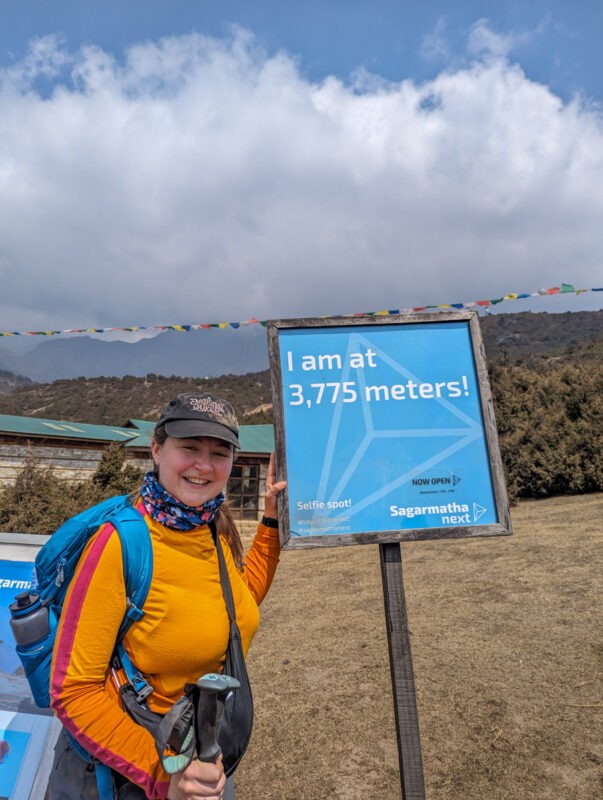
- Activities: Hiking uphill and then down for acclimatisation
- Difficulty: Easy to moderate
Take today to acclimatise and explore the heart of the Khumbu region, Namche Bazar.
Your body will thank you for allowing it time to adjust to the higher altitude!
All organised treks will include a day of acclimatisation in Namche , and I’d highly recommend doing the same if you’re hiking independently.
However, acclimatisation doesn’t mean resting all day! In fact, the best way to acclimatise is to keep active.
Start your morning with a short hike up about 150 meters to the Sagarmatha National Park Museum .
As it’s just above Namche, this climb not only helps with acclimatisation but you can also catch a glimpse of Mount Everest on a clear day!
The museum itself is well worth a visit – here, you’ll discover insights into Sherpa people, the history of Everest expeditions and its geography.
After your museum visit, continue your hike up to the Everest View Hotel.
Aim to reach early; the views are best in the morning, as afternoons are often cloudy!
The hotel is apparently the highest luxury hotel in the world and we visited for a cup of tea. It was surprisingly the most underwhelming—and the priciest—tea I had, served DIY style with just a pot of hot water and the raw ingredients.
Also, note trekkers are expected to use the external bathrooms, so keep some toilet paper handy!
If I did the trek again and it was unlikely that I’d see Everest from the hotel, I’d probably stop a bit before it and return to Namche. The last part of the trail is flat, so you could just hike to 4800 metres and then descend rather than pay for the Khumbu region’s most expensive tea at the hotel!
After lunching at our tea house, we had the afternoon at leisure. Our tea house (Hotel 8848) had hot showers which was bliss, and I did a bit of last-minute shopping!
Day Four – Namche Bazar to Tengboche
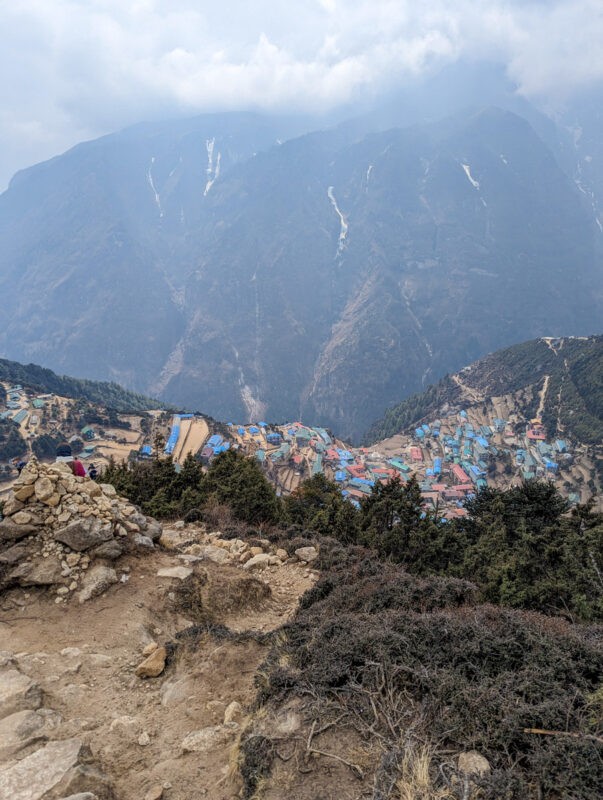
- Start Elevation: Namche Bazar – 3,440 meters (11,286 feet)
- End Elevation: Tengboche – 3,860 meters (12,664 feet)
- Elevation Gain: 420 meters (1,378 feet)
- Distance: Approximately 9-10 km (5.6-6.2 miles)
First up on day four is a climb out of Namche Bazar, heading up to a path that runs above the town. Then, it’s generally flat for a while, with a few minor uphills and downhills.
While this is fairly easy, it was here that I started feeling awful – low energy, headachey and a bit sick.
At our tea stop, I started taking Diamox as I thought it might be due to altitude sickness.
We lunched just before the infamous uphill zig-zag path that leads to Tengboche monastery.
This path is steep and relentless – it took us about two hours to reach the top (elevation: 3,800 metres).
Here, the air is noticeably thinner. Dominating the landscape is the majestic Tengboche Monastery.
It’s well worth popping into – with an entry fee of just 300 rupees, it offers not only a moment of spiritual reflection but also a chance to admire its intricate artistry up close. When we visited, we even got a blessing from one of the resident monks!
Inside, the air is heavy with the scent of incense; the walls, stories high, are adorned with ancient thangkas.
However, by the time we reached the top of the zig-zags, we didn’t have the energy for a monastery visit – instead, we popped in on the way back down.
From Tengbouche Monastery, it was a 45 minute walk to Good Luck Tea House , where we were staying for the night.
Despite the name, this was not a lucky night for me. My nausea had worsened and I retreated straight up to our room, where I was quickly quite sick! (Luckily, we had an en-suite bathroom, unluckily, the walls were paper-thin).
I wasn’t sure if this was altitude or food-related, but I thankfully did start feeling a lot better after I was sick. My guide was an angel and brought me dinner and reassured me that I was ok for the moment, and could see how I felt in the morning regarding altitude.
I had one episode of diarrhoea in the night, but thankfully woke up in the morning feeling fragile, but lots better and able to continue the hike.
Good Luck Tea House was decent, although my memory of being there is marred by feeling awful!
Day Five – Tengbouche to Dingboche
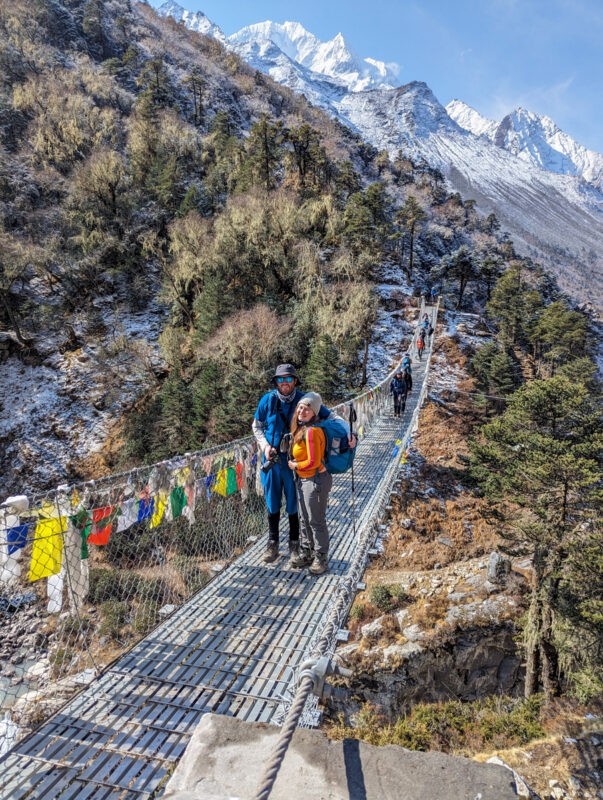
- Start Elevation: Tengbouche – 3,800 meters (12,467 feet)
- End Elevation: Dingboche – 4,410 meters (14,470 feet)
- Elevation Gain: 610 meters (2,000 feet)
- Distance: Approximately 11 km (6.8 miles)
- Difficulty: Moderate
The trek was starting to get harder due to the altitude, but other than that, this hike is a lot more manageable than previous days.
However, as I was still quite fragile, I struggled with the first part of it!
We weaved out of Tengbouche and through the last of the trees – after our lunch stop, we’d be hiking above the tree line.
As the trail ascends toward Dingboche, the increase in altitude becomes more apparent, and the air noticeably thinner.
However, the ascents are nowhere near as severe as the previous days.
Dingboche, sitting at an altitude of 4,410 meters is a critical acclimatisation stop. It’s very important to take a day to acclimatise here!
We stayed at Good Luck Tea House again – it’s a branch of the same tea house in Tengboche – and had a couple of hours in the afternoon to relax before dinner. I couldn’t face much food – I was scared of being sick again – so I just had a bowl of plain pasta with salt and pepper.
Day Six: Acclimatization Day in Dingboche
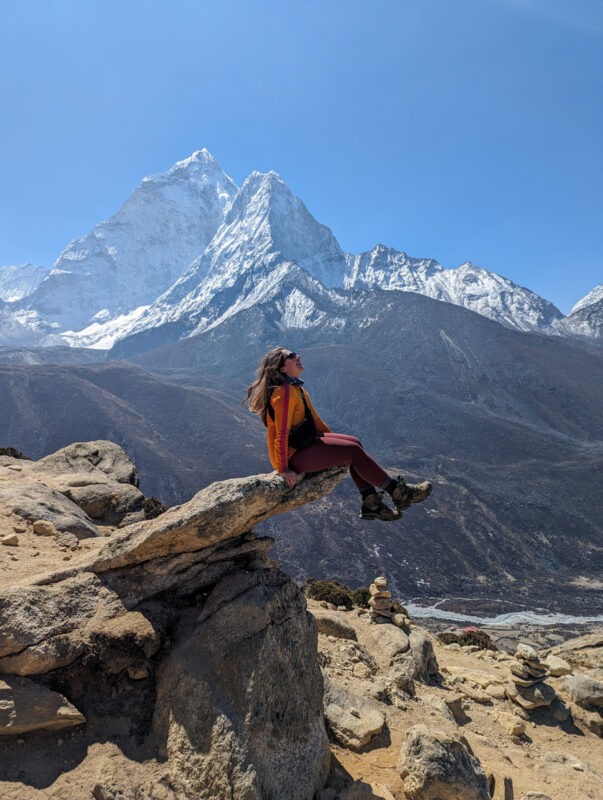
- Elevation: Dingboche – 4,410 meters (14,470 feet)
- Activities: Short acclimatization hike
- Total Hiking Time: Approximately 2 hours
- Elevation Gain: 300 meters
- Difficulty: Easy
Day six on the Everest Base Camp trek is a key acclimatization stop in Dingboche. There are a variety of hikes to do around the village – we opted for a fairly easy but still hilly trek. You can do longer, but for our group, this worked well to acclimatise while still having ample time to rest.
Above Dingboche, there are three flagpoles, the highest of which is 300 meters above the town. We opted to hike to the highest one.
This hike is easier and shorter than the previous acclimatisation day in Namche Bazar, taking about 2 hours in total.
I was feeling much better today, so felt quite invigorated as we hiked around!

There are lots of photo stops on the way too – the mountain views are stunning – including the famous rock that everyone gets a photo at. Climbing on it isn’t as scary as it looks!
After returning to Dingboche, you have the rest of the day to relax!
We decided to visit Cafe 4410, a popular bakery serving hot drinks, cakes and heavier meals. Try one of their luxury hot chocolates!
We actually ended up in the cafe for hours – the waiter put on the Everest movie, so we watched that and enjoyed being stationary for a bit!
Day Seven: Dingboche to Lobuche
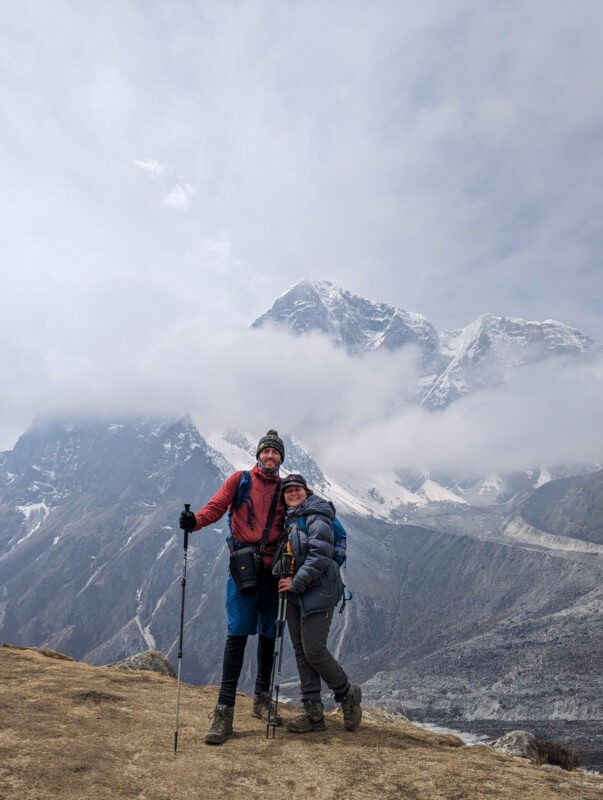
- Start Elevation: Dingboche – 4,410 meters (14,470 feet)
- End Elevation: Lobuche – 4,900 meters (16,076 feet)
- Elevation Gain: 490 meters (1,608 feet)
- Distance: Approximately 7-8 km (4.3-5 miles)
- Difficulty: Moderate to Challenging
You’re going to hike to nearly 5,000 metres today, so buckle up!
Leaving Dingboche behind, you’ll feel like you’re saying farewell to the vestiges of normality as the landscape transitions into more stark, alpine scenery.
Today’s route progresses from 4,410 meters in Dingboche to 4,900 meters in Lobuche, navigating through changing terrains and increasing altitudes.
The trek starts gently – it’s more or less flat as it exits Dingboche.
Then, it follows up the valley, gradually gaining elevation slowly.
We stopped for lunch in Thukla at the Yak Lodge. I’d recommend having the ramen noodles here (simple, but gives you hydration and energy) and avoiding the fried noodles – I had them on the way down and they were awful.
After Thukla, it’s time to climb up the cliff face! This looks short, but the altitude and steepness mean it’ll take around an hour.
At the top of the climb, you’ll find a memorial site which honours climbers who have lost their lives trying to summit Everest.
It was especially poignant for us, as we’d just watched the Everest movie the day before, which focuses on the 1996 disaster .
We saw memorials to Rob Hall and Scott Fisher, who were two of the victims. It’s a harrowing reminder of how dangerous the mountains can be, but don’t worry – the dangers lie after base camp, not before it (take a look at my article about Everest Base Camp safety for more information ).
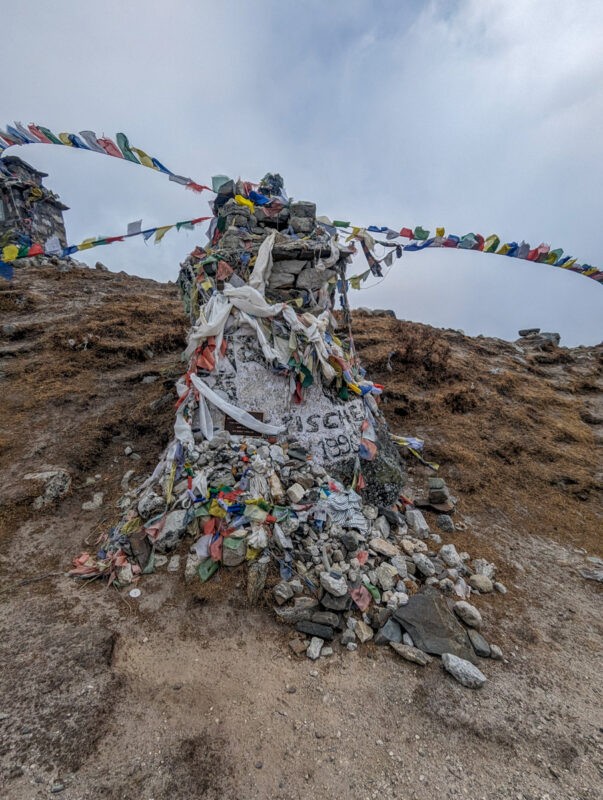
After passing the smaller Lobuche Base Camp, the trek continues for another 90 minutes to reach the village of Lobuche.
While the hike is not technically difficult aside from the uphill section, the increasing altitude makes the physical exertion feel more intense, and symptoms of altitude sickness may start to become more noticeable!
Lobuche is known for housing the world’s highest bakery ; it’s not as well stocked as Dingboche, but I was surprised to see it at all!
I can’t recommend our tea house in Loboche (Mother Earth)
It was notably less comfortable compared to previous nights, with no lights in the bedrooms and substandard toilet facilities. It also backed onto the stables, so we could smell animals from the corridor!
This is partially due to it being such high altitude but our tea house in Gorak Shep, 300 metres higher, was a lot better!
Day Eight – Loboche – Everest Base Camp – Gorak Shep

- Start Elevation: Lobuche – 4,900 meters (16,076 feet)
- End Elevation at EBC: Everest Base Camp – 5,364 meters (17,598 feet)
- End Elevation at Gorak Shep: Gorak Shep – 5,164 meters (16,942 feet)
- Elevation Gain: 464 meters (1,522 feet) to EBC
- Distance: Approximately 15 km (9.3 miles) total
- Difficulty: Challenging
Today’s the day!
We finally reached the base of the highest mountain in the world.
The morning journey from Lobuche to Gorak Shep had relatively gentle uphills, but at altitudes surpassing 5,000 meters, the air is notably thinner—oxygen levels hover around 55% of what they are at sea level.
This significant reduction in oxygen can make even slight inclines feel disproportionately challenging!
This was also the only area around Everest Base Camp where I felt like it was too busy. The pathway is narrow here, and lots of hikers were on their way to base camp, so it was quite chaotic at times!
You will catch your first view of Everest Base Camp (and the Khumbu icefall) here.
In Gorak Shep, a small settlement at 5,200 meters, we stopped for lunch and a brief rest. As I mentioned, the tea house here was much better than Loboche!
Then, it was time for the final leg to Everest Base Camp!
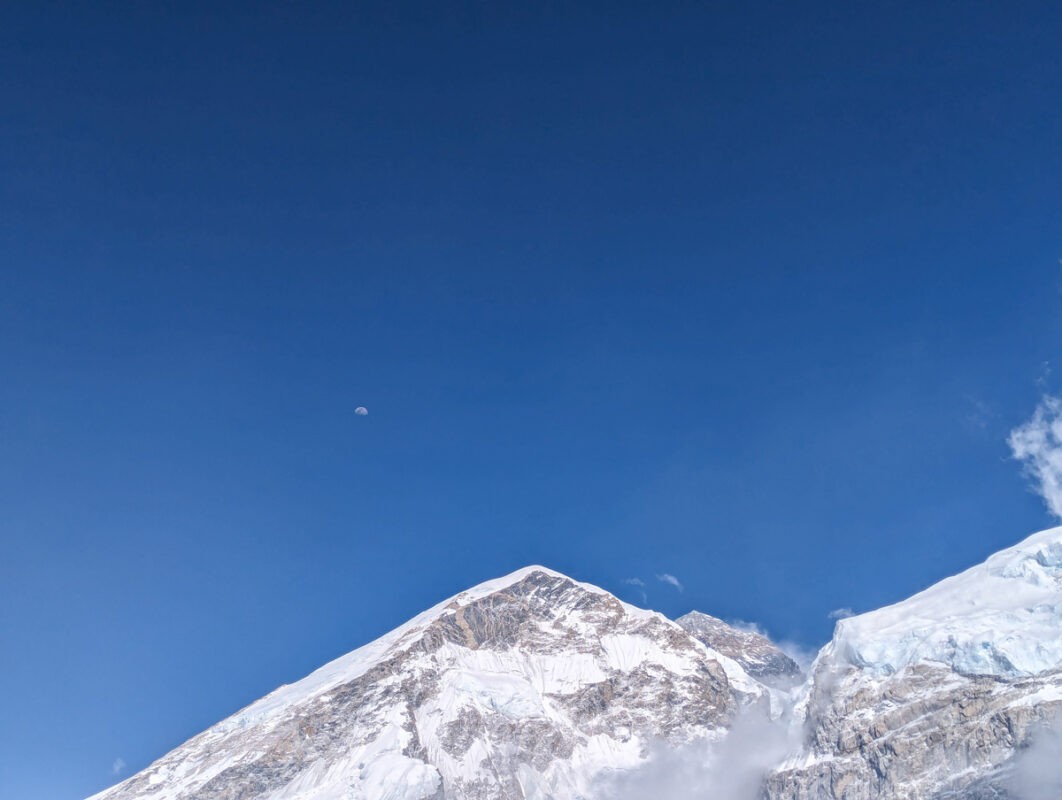
The trail followed the same pattern as the morning – a net incline of 164 metres, but a lot of downhill and uphill along the route.
After around 2.5 hours, we made it! Everest Base Camp is 5,364 metres high, and it’s where summiteers stay for around two months while preparing to hike to the summit of Mount Everest, the highest point in the world.
As a tourist, access is restricted to the periphery of the actual campsite, but even from the edges, the sense of adventure and the scale of the expeditions are palpable.
You can catch a view of Everest from the base camp, and of course take photos with the signature rock. Although, since 2024, there’s been a sign over part of it, so photos are more limited these days!
We stayed at Buddha Lodge , which, while basic, was remarkably better than Mother Earth in Loboche. For such high altitude, I was impressed with their food offerings. Try the hash brown!
Day Nine: Gorak Shep – Kala Patthar – Pangboche
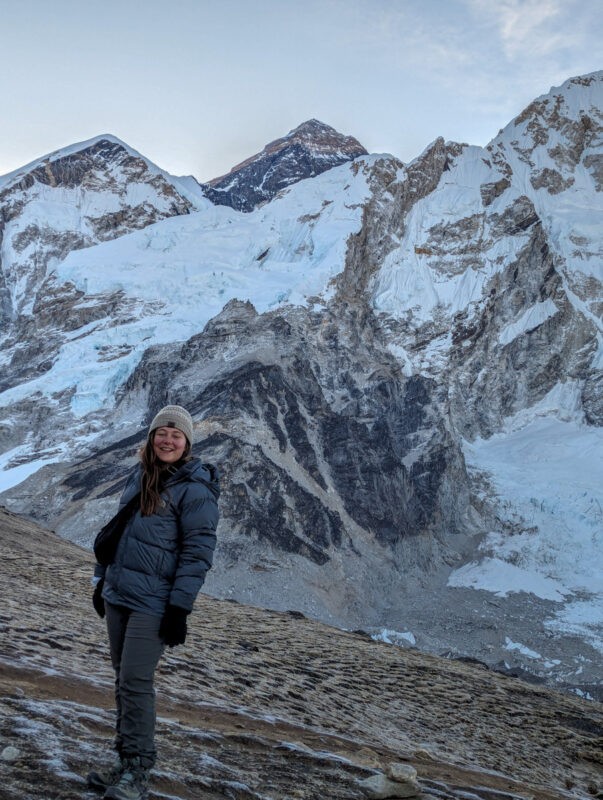
- Start Elevation: Gorak Shep – 5,164 meters (16,942 feet)
- Highest Point: Kala Patthar – 5,545 meters (18,192 feet) – this is the highest altitude that you’ll go on the trek
- End Elevation: Pangboche – 3,985 meters (13,074 feet)
- Distance: Approximately 15-16 km (9-10 miles)
- Difficulty: Challenging due to altitude and initial ascent, then easier descent
The best view of Everest isn’t actually from Everest Base Camp!
If you can handle even higher elevations, I’d recommend a pre-dawn hike from Gorak Shep to Kala Patthar.
This is just a steep climb from Gorak Shep, and while the full ascent to Kala Patthar’s peak is popular, a partial hike still offers incredible views of Everest and the surrounding peaks, some of which mark the border between Nepal and Tibet.
Not many of us in our group opted to do this trek, but I’d highly recommend it if you can get out of bed (we left at 5am). I found standing underneath the world’s highest mountains as the sun came up to be absolutely enchanting.
The trail then leads down! We retraced our steps, back to Loboche and then further downhill. The first hour was still up and down, which was tough, but then it swiftly got easier.
We were originally aiming for Periche on this day, which sits just below Dingboche, but ultimately decided to descend further to Pangboche, as we had daylight and knew that we’d feel better the further we descended.
The trail was mostly downhill, and was very easy for the most part.
We stayed at Buddha Lodge and Restaurant , which was quite cosy – we were the only people there!
Day Ten: Pangboche – Namche Bazar

- Start Elevation: Pangboche – 3,985 meters (13,074 feet)
- End Elevation: Namche Bazar – 3,440 meters (11,286 feet)
- Distance: Approximately 14-15 km (8.7-9.3 miles)
- Difficulty: Moderate
Continuing the descent, the path from Pangboche to Namche Bazar winds through beautiful Himalayan forests (the trees are back!) and traditional Sherpa villages.
Don’t forget to visit Tengboche Monastery on the way back if you didn’t while ascending.
The trek is mostly downhill, although just as the trail was up and down on the way up, it’s down and up on the way back! There is a particularly hilly section midway through the day.
Once you arrive in Namche, you’ll feel like you’re in the land of mod cons!
We had our first shower in a week and then went to the Irish pub for an alcoholic drink. The Irish pub also serves excellent pizza, easily the best thing I ate all week!
We stayed at Hotel 8848 again.
Day Eleven: Namche Bazar to Lukla

- Start Elevation: Namche Bazar – 3,440 meters (11,286 feet)
- End Elevation: Lukla – 2,860 meters (9,383 feet)
- Distance: Approximately 18-19 km (11-12 miles)
- Difficulty: Challenging due to the afternoon uphill section
It’s the final day of trekking!
The first descent is easy (I do recommend hiking poles, they’ll make this part of the trek much easier), but once we were down in the valley, we then had to climb uphill.
It wasn’t as hard as climbing at high altitudes, but on the last day of the trek, the very last thing I wanted to do was go uphill some more!
However, Lukla is a welcome respite from the trekking; here, you can purchase Everest souvenirs (although you can also get these in Kathmandu) and relax at one of the tea houses. We stayed at The Nest.
We stayed at The Nest , which is where we had lunch on the first day. We had en-suite bathrooms with showers, which could be made hot (for free!) but the beds were incredibly hard here. But, it was our last day in tea houses before we flew back to Kathmandu!
Day Eleven: Flight back to Ramechhap

Another 18 minute flight beckons on this day, but while it’s a very short time in the air, you could end up waiting a while for it!
For us, it wasn’t too bad. We stayed at The Nest (which is right by the airport) until it was time to check in, and then had around a 45 minute wait in the airport before we boarded.
Then, our van was waiting for us to take us back to Kathmandu!
If you have an international flight out of Nepal, I’d recommend leaving a couple of days before it, just in case the weather doesn’t play ball and you end up stuck in Lukla!
How many days do I need for the Everest Base Camp trek?
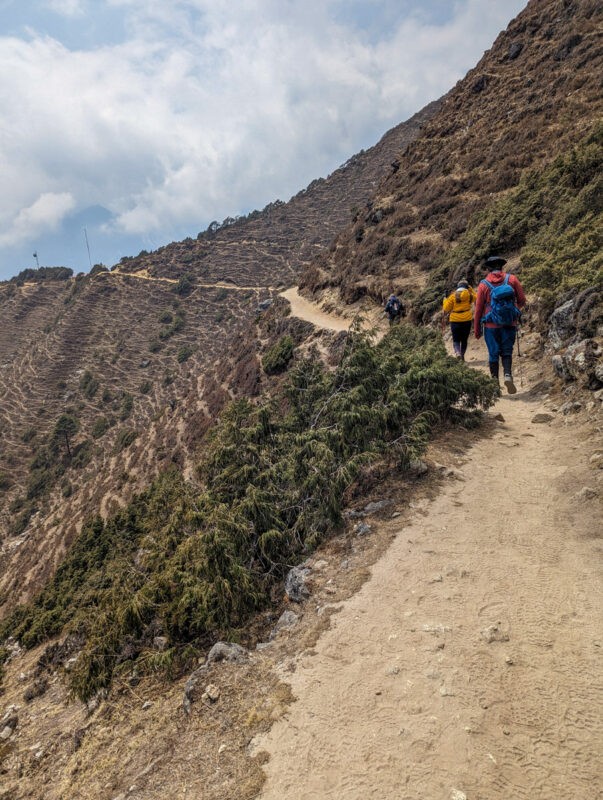
Most Everest Base Camp itineraries are 12 days long (not including days in Kathmandu). This is because most tourists only have two weeks off work, and it lets them fit it into their holiday time.
It’s possible to do it quicker, but I wouldn’t recommend it unless you have experience at similar altitudes. Acclimatisation is all-important on this hike! If you really need a day less, you could fit the descent into two days rather than three.
Plus, if you’re hiking independently and are able to, I’d recommend taking longer on the hike. Allowing an extra day for acclimatisation in Namche Bazar and stopping more on the way from Namche to base camp could help you avoid feeling unwell.
Having extra days to play with also helps in case of bad weather and flight cancellations.
When is the best time to hike to Everest Base Camp?
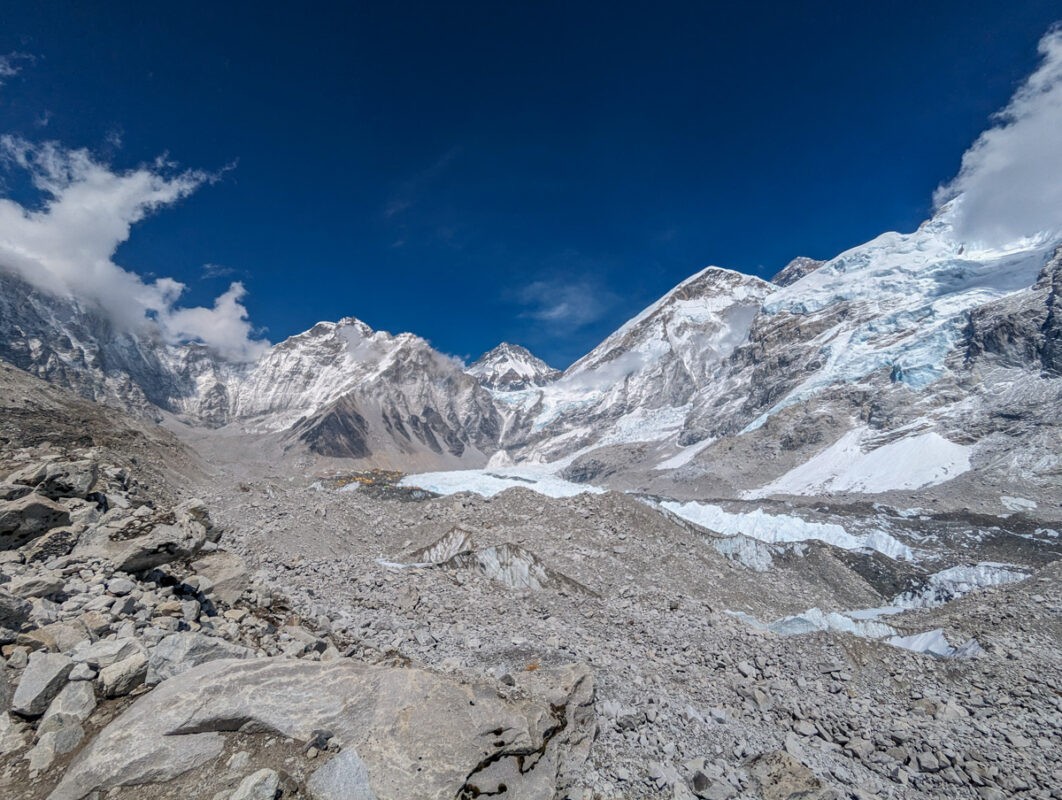
The best times to hike Everest Base Camp are during the pre-monsoon spring months of March, April and May, and the post-monsoon autumn months of October and November.
Spring (March, April and May):
Spring is a popular time as the weather is generally stable and relatively warm. Of course, it’ll be much colder in March than May!
Additionally, as it’s pre-monsoon, the likelihood of rain is lower so typically the trails are dry and safer for trekking.
It’s also when most summit attempts leave from Base Camp, so you’ll see most of the activity at the actual camp at this time (usually from mid-April through May). At other times of year (including March), base camp will be a lot quieter.
Autumn (October and November):
The Autumn season is another prime trekking time, with clear skies and temperate weather.
The air after the monsoon is fresh and clear, offering some of the best views of Everest and the surrounding Himalayas.
Plus, the trails aren’t as crowded as they are in the spring months – but you won’t see anywhere near the amount of activity at base camp.
Off-Peak Seasons
Trekking is possible year-round, but most hikers don’t attempt it in the monsoon season (June to early September) or winter.
In the monsoon season, trails can be slippery, mountain views obscured and there’s a much higher chance of landslides.
In the winter season, temperatures are freezing, with lots of snow and the chance of some passes being closed.
Do you need a guide to hike Everest Base Camp?

In the Everest region, unlike other areas in Nepal, hiring a guide is not mandatory. However, I couldn’t imagine doing the hike without a guide.
Our guide helped us manage health concerns like altitude sickness, trekking permits, ensured safe navigation on the trail (ours helped us deal with the many oxen that we had to share the trail with!), facilitated interactions with local communities, and handled logistics such as accommodations and flights.
Their knowledge and skills in addressing sudden medical issues or route changes are invaluable. Plus, hiring guides (and porters!) helps the local economy.
I’d also recommend hiring a porter for this reason; while it feels lazy not carrying your gear, porters are accustomed to the altitude and carrying heavy loads (although not too heavy! Ours could carry a maximum of 30kg, split between two people). Hiring them gives them work, which isn’t always easy to find in the remote Himalayas.
Are you ready to hike Everest Base Camp?
There’s no experience in the world quite like hiking to Everest Base Camp, seeing the world’s highest mountains and fathoming what an undertaking summitting Everest is. While it was tough, I’d recommend it to anyone who feels able to. You’ll quite literally feel like you’re on top of the world!
I have lots of blog posts and YouTube videos to come, and I’ve already been posting on TikTok and Instagram , so hopefully I’ll be covering all bases regarding the EBC trek. If you have any questions, feel free to reach out on social media and I’ll try my best to answer you!
- New Zealand
- The Philippines
- The Netherlands
- United Kingdom
- Inspiration
- Overland Itineraries
- Packing Lists
- Travel Tips
- Working Abroad
- Accomodation Guides
- Overland Travel
- Preserving Cultures
- Protecting Animals
- Living Abroad
I'm hiking Nepal for 3 weeks, do I trek Everest Base Camp or Annapurna Circuit?

Feb 22, 2024 • 3 min read
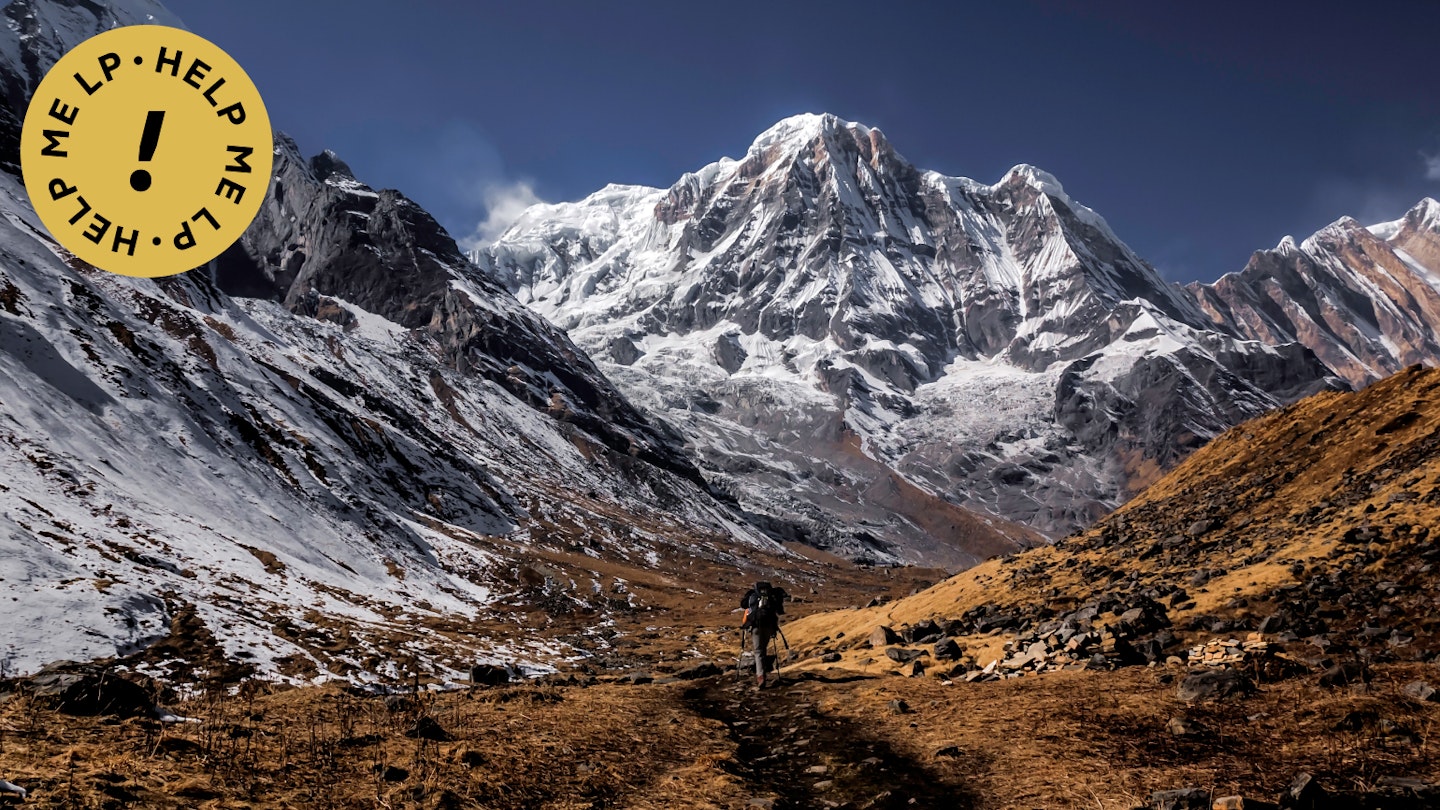
We can help you choose between the Everest Base Camp and Annapurna Circuit treks in Nepal © Russ Nordstrand / 500px
Himalayas specialist Bradley Mayhew, who writes our guidebooks to Nepal, Bhutan and Tibet, answers a question about trekking routes in Nepal.
Question: I have three weeks planned for trekking in Nepal and I can’t decide between the Everest Base Camp and Annapurna Circuit treks. Can you help?
Answer: Ah, so many trails in Nepal, so little time…
Firstly, the Annapurna Circuit and Everest Base Camp treks have some things in common. Both offer excellent lodging in hundreds of trailside teahouses and an infrastructure of shops, bakeries, wi-fi and guides that makes for easy logistics. Both have world-class mountain scenery in valleys flanked by some of the world’s highest peaks, both require acclimatization to altitudes of over 5400m (17,717ft) and both are packed with trekkers in the high season months of October, November and April.
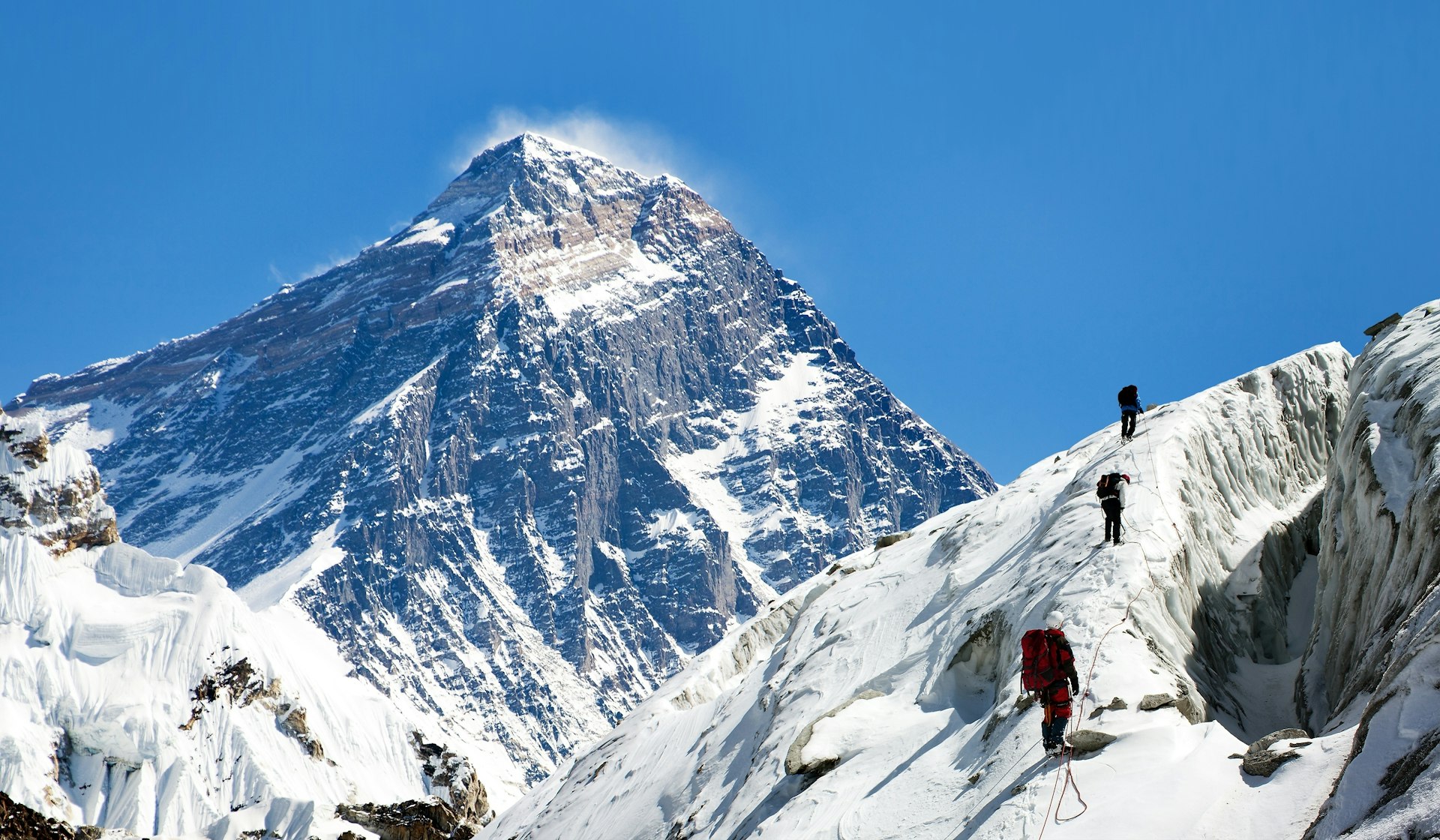
Everest is iconic, but more costly and complicated to reach
There are also differences between the two treks. Everest is a bit more complicated and expensive to reach. Most people fly to the trailhead Lukla and start the trek straight off the runway, which is convenient but expensive (US$430 return) and can present challenges when bad weather grounds flights for days at a time. (Be aware also that during high season flights to Lukla often depart from Ramechhap, not Kathmandu , which adds on a five-hour drive.) The only alternative to flying is a long, punishing ride in shared jeeps, or a weeklong walk (my preferred option, if you have the time).
You need a minimum of two weeks to trek to Base Camp and back, and I would strongly recommend adding up to a week to investigate the quieter but equally stunning side valley of Gokyo. In contrast, the core Annapurna Circuit section to Jomsom can be done in as little as nine days.
Everest has the irresistible lure of the world’s highest peak but you actually don’t see much of it; far more interesting is the climbing literature and the fact that you are walking in the footsteps of the world’s great climbers. The Everest trek gets you closer to the heart of the high mountains than the Circuit, which offers more in the way of traditional village life. Finally, Everest Base Camp is an out-and-back trek, so you’ll repeat some sections, whereas Annapurna is by its nature an A to B loop.

Annapurna's trails are often roadside, but offer greater flexibility
The Annapurna region is a lot more accessible; in fact you can be walking the trails in less than an hour by bus from Pokhara town. The big downside with the Annapurna Circuit (and it’s a big downside) is road construction. A jeep road now reaches as far as Manang on the eastern side, and Muktinath on the western side, which leaves only three days of roadless walking between them. The roads have taken a lot of the charm away from the circuit, so if you do decide to walk it I’d really urge you to read up on the alternative NATT trails that lead you away from most of the dusty road. During the second half of the trek in the Kali Gandaki Valley these side trails and excursions make for some stunning day walks, returning to roadside teahouses. It’s a different kind of walking, but it gives you great flexibility, meaning you can adjust your Annapurna Circuit trek to anywhere between a week and 21 days.
So, which is better?
Both trails offer a fabulous taste of Nepal trekking, but both are busy in high season and reward a bit of research into the excellent alternative trails and side trips which, for me, make these treks stand out. If avoiding the crowds is important to you, consider something different completely: the wonderful Manaslu Circuit teahouse trek, or an adventurous rough-and-ready trek out to the base of Kangchenjunga in the far east. Whatever you choose, your first trek in Nepal will almost certainly not be your last.
Explore related stories
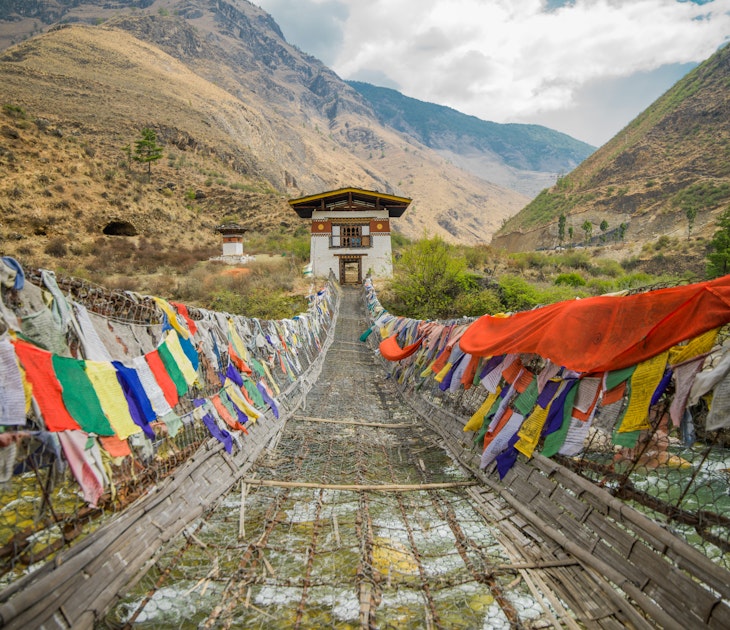
Aug 31, 2023 • 11 min read
When Bhutan reopened after the pandemic, the government raised tourist fees dramatically. Now they are coming back down. Here’s what you need to know.
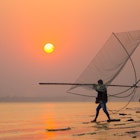
Oct 10, 2019 • 9 min read

Jun 11, 2024 • 9 min read

Jun 6, 2024 • 6 min read

Jun 3, 2024 • 8 min read
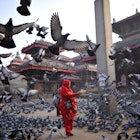
May 31, 2024 • 6 min read

May 29, 2024 • 8 min read

May 22, 2024 • 7 min read
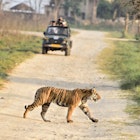
Apr 16, 2024 • 13 min read

Jan 11, 2024 • 4 min read
- Tips & Tricks
- Tales from the Trails

The Ultimate Insider’s Guide to Trekking Everest Base Camp
CAMPING TIPS & TRICKS , Hiking / Camping / Tour Companies , TRAVEL

At 8,848 meters, 29,029 feet above sea level, Mt. Everest is the tallest mountain in the world, towering over the surrounding peaks in the Himalayas mountain range on the border between Nepal and Tibet.
Even if you’re not a diehard mountaineer, you can still explore this beautiful region of Nepal with a trek to Everest base camp (EBC).
Not only will you get lifelong bragging rights for completing the trek to base camp, but it’s also a beautiful trek in its own right. Amazing vista can be seen passing through the Sagarmatha National Park and the awe-inspiring Himalayas .
Although the trek takes about two weeks, it’s surprisingly accessible and has been completed by many first-time trekkers.
Everest Base Camp: A Brief Overview
Since the first successful summit in 1953 by Sir Edmund Hillary and Sherpa Tenzing Norgay, the imposing peak has attracted decades of adrenaline-seekers wishing to add their name to the list of successful summiteers. A good portion of these climbers never returned .
Despite the intimidating statistics, the sister trek through the picturesque Khumbu Valley to the base camp used by professional mountaineers is an attainable goal for many people.

Located at an altitude of 5,361 meters, 17,590 feet above sea level, you don’t need fancy equipment or mountaineering skills to reach EBC. Certainly, it takes just a positive attitude and a reasonable level of fitness.
There’s a sense of camaraderie and a tangible buzz in the air as the adrenaline of the would-be Everest summiteers infects everybody around them.
The scenery at these altitudes is breathtaking and varied, ranging from rhododendrons and pine fields to rivers; suspension bridges strung with prayer flags; glaciers, lakes, valleys, high mountain passes, and finally, the spectacular Himalayan mountain peaks!
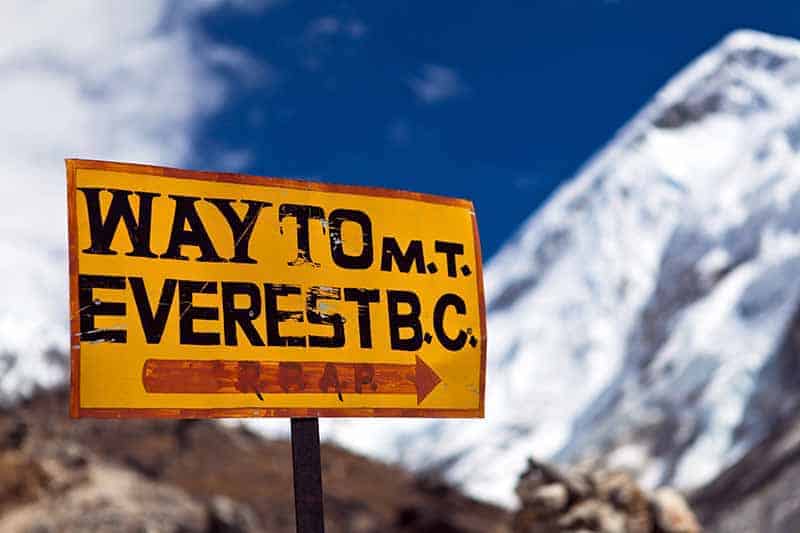
The Sagarmatha National Park is home to rare animal species such as snow leopards and red pandas – though it’s very unlikely you’ll encounter them. You’ll frequently have to step aside (to the uphill side!) as you encounter yaks on the trail.
Whether you choose to follow the traditional EBC route or one of the alternative trails, it’s guaranteed to be an experience you’ll never forget.
In contrast to most multi-day treks where you’d be camping in a tent, trekkers to base camp stay in cozy tea houses. You can find several available in a range of budgets, which function as both hotels and restaurants.
The trek is dotted with Buddhist monasteries and tiny villages almost all the way up. The relaxed pace of the trek allows plenty of time for you to explore the villages and get to know the local Sherpa culture.
Mt. Everest is increasingly covered in garbage left behind by the hordes of people who have set out to conquer its lofty heights. When you go, please respect the environment and do your best to minimize waste.
The most popular time of year to do the Everest base camp trek is between February and May – the pre-monsoon season.
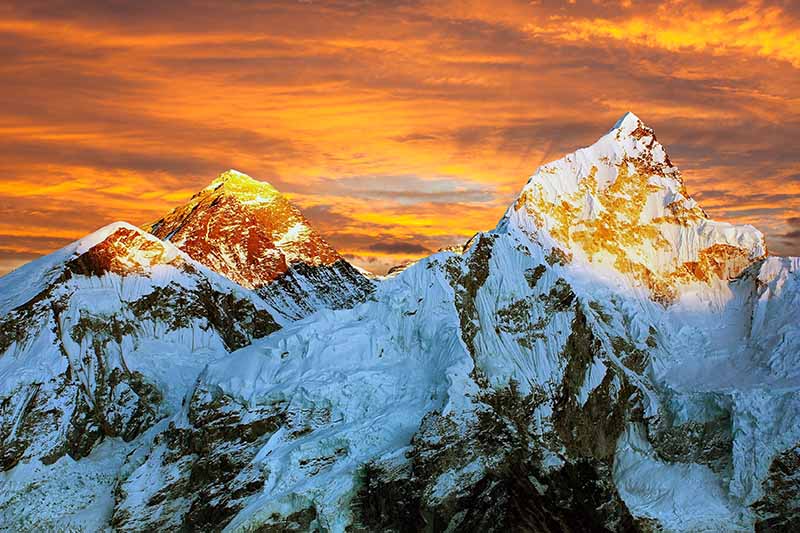
During these spring months, the weather is typically warm and dry and the mountains will be ablaze with colorful rhododendrons.
This is also peak season and while you’re unlikely to have the trails to yourself, you’ll enjoy a buzzing atmosphere at the tea houses on the way. This is also when most Everest climbers make their summit attempts.
The summer months bring the monsoon rains, resulting in slippery trails and a heightened risk of landslides. If that doesn’t deter you, the leeches and foggy weather might! It’s not recommended to attempt the trek in the summer.
It can also be difficult to fly into Lukla during the monsoon. Indeed, this is a good time to pick the Jiri trek over the classic EBC trek.

If you want fewer crowds, try going in September or October, the post-monsoon months, when you have the highest chance of clear skies, although temperatures are slightly colder.
You can even do the trek in the winter but be prepared for sub-zero temperatures most days and lots of snow.
Whenever you go, make sure you pack for unpredictable weather in case a snowstorm takes you by surprise.
Trekkers interested in the local culture might want to plan their trip dates around traditional holidays with celebrations in Kathmandu, such as Holi (February/March) or Indra Jatra (September).
Another thing to consider when planning your trip is flight prices, which can vary considerably. Check flights before booking as this might have a huge impact on when you want to go.
Lastly, be aware that it might be harder to find tour operators who provide treks in off-season months. Also, some of the paths might be closed.
Conversely, if you want a stab at actually sleeping in Everest Base Camp, then late spring is your best option. It will be rare to find tour operators who might be able to wrangle this.
Everest Base Camp Packing list
If this is your first multi-day trek, don’t forget to budget for all the equipment you’ll have to take with you.
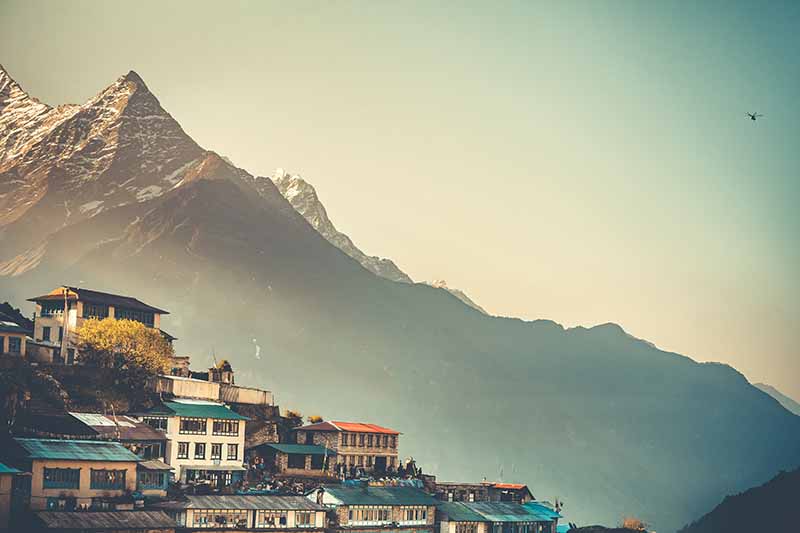
You can choose between renting or buying your gear. Hikers who plan on doing more multi-day treks might want to invest in their own equipment.
If you’re doing a two-week trek, it makes more sense to rent your sleeping bag and down jacket. For trekkers who plan on trekking for a whole month, it makes more financial sense to buy.
The neighborhood of Thamel in Kathmandu offers plenty of options for buying and renting. However, the products on offer may be of questionable quality.
Further on, Namche Bazaar is a last-resort option if you find you’ve forgotten to pack any essentials. If you keep your receipts, then talk it over with the shop when buying. Some shops will buy your gear back from you, at the end of your trek, for a reduced price.
Almost everything available for sale along the trek has been carried up the mountain, either by yaks or people. This means things get more expensive the higher you go.
Pack strategically. This means bringing the items you can’t live without while avoiding overloading your backpack. Whether you hire a porter or decide to go solo, somebody will be lugging your things up the mountain. Indeed, think twice before including unnecessary items like an extra book or five spare shirts!
Aim to pack around 10kg if you’re carrying everything yourself, and 20-25kg if you’re getting help from a porter. Don’t forget that your water adds extra weight. Try packing your bag with full water bottles, to get a more accurate idea of how much you can bring.
This list is aimed at trekkers who will be sleeping in tea houses every night. Be aware that if you don’t book early enough, the tea houses may be sold out in high season.
If you think you might end up having to camp, Then you’ll need more supplies not covered on this list, such as a winter insulated tent , sleeping pad , etc.
What to Wear
The clothes you pack will depend on which season you’re visiting in. Make sure you have enough clothing to keep warm, especially in the evenings.

Layers are crucial, as temperatures and weather conditions will change drastically between day and night and as you ascend and descend in altitude.
Tea houses often only heat the common areas, and then only in the evenings, so bring warm clothes for lounging around at night.
The higher you get, the less likely you are to have power in your tea house, or only for a few hours as they’re run off solar power.
Base layers: Your base layer should be comfortable and moisture-wicking. Stay away from cotton; go for merino wool or synthetics .
Pack a long-sleeved shirt (avoid short sleeves as you’re more likely to get sunburnt) and long underwear, if only for the cold evenings.
Fleece mid-layer: You’ll probably be putting this on and taking it off with every mountain pass. Indeed, try to find one that will fit easily into your day pack.
Outer layer: Get a down jacket with a good warmth-to-weight ratio, as you’ll be carrying it much of the time.
Waterproof windbreaker and pants.
Hiking pants: Well-insulated trekking pants , or trekking pants that can turn into shorts.
Waterproof hiking boots. We can’t stress enough how important it is to break your hiking boots in properly before your trek.
Don’t forget to bring a pair of comfortable sneakers or sandals for the evenings and for bathroom runs.
Socks: Woollen hiking socks are worth the investment – bring a few pairs that can handle very cold temperatures for the higher altitudes, and look for flat seams and padded spots to reduce blisters.
Sock liners and Vaseline are two other good ways to prevent blisters . You should also bring a pair of warm socks for base camp.
Gaiters: These will be especially useful during the rainier months.
Gloves : Pack a thin pair of “inner” gloves and a very warm pair of outer gloves. There will be at least one or two days where your fingers will freeze otherwise – for example, the day you summit Kala Patthar.
Scarf/balaclava/buff: The trail to EBC gets infamously dusty, provoking the “ Khumbu cough ” that plagues many hikers. A buff or something similar will keep you warm as well as provide you with a layer to breathe through to minimize the amount of dust in your lungs.
Beanie and sun hat , preferably with neck cover, to protect against the sun .
Underwear and sports bras: You’ll probably be reusing these, so get good-quality, non-cotton ones.
Accessories
Drinking water: Most tour operators provide purified water. Avoid bottled water, as this is expensive on top of being an environmental disaster.

We recommend bringing two big reusable water bottles (or a water bladder for drinking on the go). Tablets take a while to work and it’s nice to have one water bottle ready to drink while the other one is getting purified.
You can also fill a bottle with hot water and sleep with it in your sleeping bag if you’re cold during the night. If you’re purifying your own water, bring water purification tablets , LifeStraw , or a Steri-pen. But remember, these need charging, and charging on the trail costs money.
You may wish to add flavor enhancers to your water. Unfortunately, at Gorak Shep the water is very mineralized so you’ll need to buy bottled water.
Showering: Whether or not you shower is up to you. Expect to pay around $5 for a hot shower. Some people rely on wet or backpacking body wipes , especially since wet hair is no fun in negative temperatures!
Sunglasses: The combination of snow and altitude is brutal on your eyes, so invest in good polarized sunglasses with wraparound arms.
Sleeping bag : The teahouses will provide blankets and pillows but you’ll want your own sleeping bag and pillowcase.
Find a mummy sleeping bag rated to -20° C – or colder, depending on the season. Consider bringing a silk liner , especially if you’re renting your sleeping bag.
Toiletries: Sunscreen , SPF chapstick (this is better than lip balm as there’s no need to smear it on with your grubby fingers), quick-drying towel, tissue, baby wipes, period supplies, compressed toilet paper tablets or biodegradable toilet paper (remove cardboard and keep in ziptop bag), hand sanitizer, toothbrush and toothpaste, etc.
Always bring toilet paper with you. Most bathrooms are squat toilets and are located only in villages.
Tip : wet wipes are more expensive than toilet paper on the trail, so if you have to choose, stock up on wet wipes and buy toilet paper when you run out.
Shewee: Ladies, you’ll be glad not to have to pull your pants down in the freezing high-altitude weather. If you need to pee, then I recommend using a portable pee device, like PeeBuddy Reusable Female Urination Device . You stand and use the portable pee funnel, so you don’t need to squat.
If you get your period on the trail and you’re not comfortable with using the DivaCup, another good option is to keep used pads/tampons in a ziptop bag and dispose of them in the next garbage can.
Personal first-aid kit: Bring diarrhea meds, altitude meds, antibiotics, ibuprofen, paracetamol, aspirin, bandaids, blister plasters, tape/trekker’s wool, Vaseline, cough drops (to beat the Khumbu cough), cold medicine, rehydration salts.
Tour operators should provide the rest. Don’t forget to get your travel vaccines before you go.
TSA approved padlock for your luggage.
Backpack: What you pack your gear in will depend on whether you’re using porters. Most porters prefer you to pack your things in a soft-sided duffel bag. Check with the tour operator in case they provide these for you.
If you have a porter, then you’ll only need a daypack for yourself. If you’re not hiring a porter, then bring a collapsible daypack anyway in addition to your backpack. This is so you can leave your big backpack in the tea house during the one-day acclimatization hikes.

Try to get a backpack with straps for hiking poles and zippers to open it from the sides. Not to mention, you won’t have to dig everything out of your bag whenever you want to access something.
Dry bag or plastic cover for your backpack and daypack to prevent water ingress.
Hiking poles : These are a must! All the treks listed here will take you uphill, downhill, uphill and downhill again. Hiking poles will save your knees, and they’ll come in handy on slippery trails during the wet season.
Headlamp or flashlight : You’ll be glad to have this in the evenings after the power goes out, and during early-morning or late-night hikes. Remember to bring extra batteries.
Trekking map: If you’re going independently, a good trekking guidebook is essential – Lonely Planet is highly recommended.
Ziptop bags: These always come in handy for protecting electronics, etc.
Camera or GoPro with memory card and extra batteries.
Money: There are ATMs at select points such as Lukla and Namche Bazaar. But these have low daily withdrawal limits and high commission fees. What’s more, they have been known to take money out of your account without actually dispensing it to you.
Since currency exchange rates on the trail are sky-high, it’s best to bring a stash of local rupees with you. You’ll need rupees to pay for meals, showers, tips, etc.
Wi-Fi: A good option for staying connected is to buy a local sim card. It will give you data to about 4000m altitudes, and sometimes in EBC itself.
You can also check Everest Link for Wi-Fi data packages. The connection is supposedly available in most teahouses along the way, but it can be slow and unreliable so don’t depend on it too much.
Top Tip : Beware of phone updates. These will eat through your Wi-Fi and data limits before you realize what just happened!

Entertainment: EBC treks usually only schedule a few hours of hiking a day, to allow you time to acclimatize. Bring books, a Kindle , cards or other games for the many hours of downtime. Certainly, bring a journal so you can remember this once-in-a-lifetime experience!
Solar charger: Many teahouses offer power points where you can charge your devices for a nominal fee. Also, don’t forget to bring an adapter. It’s a good idea to bring your own solar-powered charger and extra batteries to minimize costs.
Tip : Keep batteries, base layers , and anything else you don’t want freezing in your sleeping bag with you overnight. Keep your phone in flight mode to save power.
Important documents: Bring printouts of your travel insurance information. And make sure one of your travel buddies knows what to do and whom to contact in case of an emergency.
Bring your passport, visas, money, etc. – I always keep these documents in a zip-top bag.
Trekking solo? Bring a safety whistle , compass , pocket knife , & duct tape, especially on the less-crowded trails
High-calorie snacks: These will make a huge difference to your experience. Snacks are exceedingly expensive on the trail, and they provide welcome calories on tough trekking days.
You’ll have to decide how many you want to bring and which ones you want to buy along the trail.
Cloth bags : Many trekkers use these to separate dirty laundry and organize different outfits.
Earplugs: You’ll be glad for these when the tea houses are alive with the sound of Khumbu coughs.
A Note on Trekking Insurance
Be very careful when purchasing travel insurance, because regular policies usually stop covering you once you ascend higher than 3,000m/9,840ft.

At these altitudes, you have a higher chance of getting Acute Mountain Sickness. Also, there’s a pretty good chance you’ll have to be airlifted out to a hospital for injuries . To clarify, injuries like a pulled muscle or twisted ankle at sea level can be more serious at higher altitudes.
Because of these higher costs and risks , insurance companies will charge you a premium for high-altitude trekking insurance.
Luckily, there’s no shortage of insurance companies that offer travel insurance specifically tailored to Everest Base Camp trekkers.
When purchasing a policy, make sure you’re covered for trekking up to altitudes of 6,000m/19,685ft. In addition, ensure it has search and rescue costs, preferably by helicopter.
Don’t forget to check if you’re covered for different travel-related illnesses (and make sure you get your vaccinations before going!).
It’s also nice to have compensation for delayed or canceled flights and repatriation in case of death (hopefully you won’t be needing this one).
Check the clause about lost, stolen or damaged luggage to see if it will cover most of the cost of your hiking gear.

If you’re traveling in winter or shoulder season, then check for trip cancelation insurance. This is to ensure you’re covered if your trek is canceled due to weather.
You’ll likely have other considerations depending on your personal situation. Don’t just take our advice for it – remember to do your research, ask questions and read the fine print of your travel insurance policy before you purchase.
I always keep my travel insurance information handy while on the trek. Additionally, I pass it along to someone else in my group. This is so they know whom to contact in case of an emergency.
Some travel insurance providers require you to confirm with them before ordering a helicopter. Check out this option on getting trekking travel insurance for more information.
How to Avoid Altitude Sickness
Most tour operators organize a relaxed trekking schedule and follow the mantra “climb high, sleep low”. In essence, this is to avoid the risk of altitude sickness.
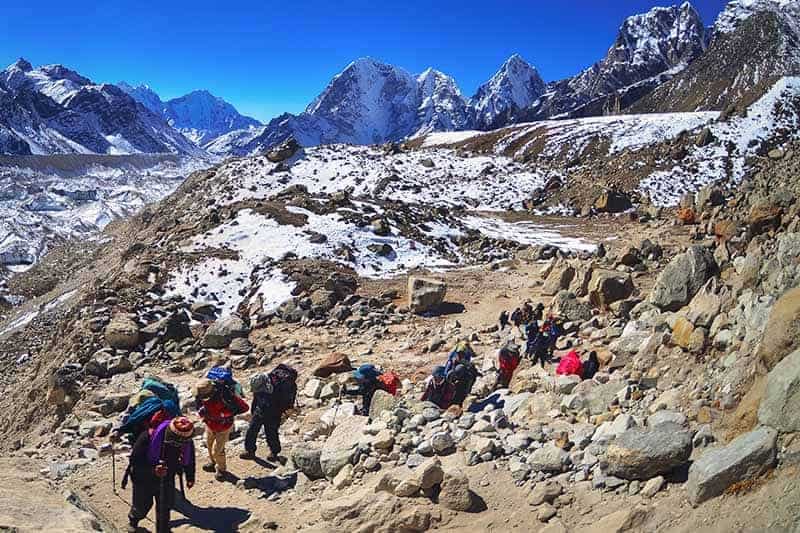
Take it slow – once you finish hiking for the day you’ll have a lot of dead hours in the teahouse. For this reason there’s really no point in racing there.
It’s important to respect the acclimatization days. The acclimatization hikes are designed to help you adjust to tomorrow’s altitude.
Try to drink 3-4 liters of water a day, as dehydration will make the altitude sickness way worse. It also goes without saying that you shouldn’t drink caffeine or alcohol or smoke during your trek.
If you can, then cut out these vices about a week before you start hiking. So that you won’t suffer from withdrawal headaches.
Many people swear by Diamox as a preventative drug against AMS. It’s your choice whether to take this or not. I personally found the tingling fingers and toes to be very off-putting, but it probably helped me acclimatize.
Altitude sickness is unpredictable and doesn’t discriminate based on fitness or age. Listen to your body and descend immediately if you think you have signs of Acute Mountain Sickness.
Check out our article on altitude sickness for a more detailed overview.
Choosing a Tour Operator
Every year there are rumors that the Nepali government will make it compulsory to go with a guide.. But so far, it’s still possible to undertake the trek to EBC on your own.

Unless you’re going in high season, you’ll can drop in at tea houses and get a bed without a reservation.
Independent trekkers can choose whether to hike all by themselves. While others choose between ring a porter, a guide, or a guide and a porter. A guide will speak some English and can help with booking accommodation. However, a porter probably won’t speak English and will only carry your bag.
You can also hire one person who acts as a guide and a porter. Another upside to hiring a guide is that you’ll be providing someone with a job. And in turn, you’ll get to immerse yourself in the Nepali culture.
Alternately, you can opt to join a guided trek with a tour operator. While this is pricier, it’s a good choice for people who have never done such a long, high-altitude trek before.
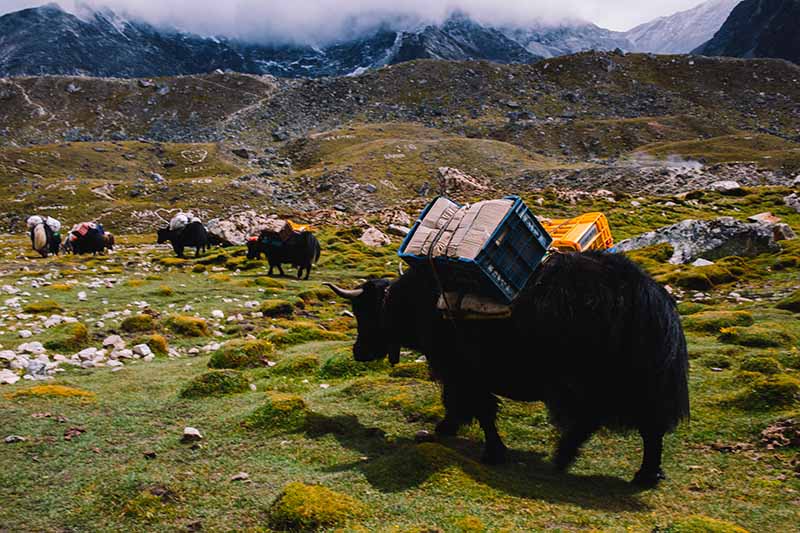
Tour operators typically arrange flights, airport transfers, accommodation, visas and permits, porters and guides. Western tour operators will usually charge more, but provide a more trustworthy service. You can expect to pay about twice as much for a Western tour operator.
Check to see if your tour operator is registered with the Trekking Agencies Association of Nepal (TAAN). TAAN regulates trekking agencies in Nepal to ensure fair treatment of employees, respect for local communities and preservation of the environment.
The Kilimanjaro Porters Assistance Project mission is to improve the working conditions of porters. They advocate for fair treatment and wages, lend free mountaineering clothing, and encourage them to work for only ethical companies. Through providing education and training opportunities, guides and porters have received classes on porters rights, Leave No Trace and are certified in First Aid.
Please make every effort to ensure the porters and guides are dressed properly, stay within the weight limit including their own luggage. Also, ensure they have adequate sleeping arrangements and insurance and are paid a fair wage.
It’s better to go with companies that employ their porters and guides full-time instead of freelance because there’s a better chance the company is providing them with benefits, sick days and health insurance.
Tipping is always a tricky subject and suggested rates will depend on whom you ask. Aim for around 15 percent of salary (if you’re traveling in a group, this number refers to the total pooled tip) per porter and/or guide, and adjust accordingly.
The classic Everest Base Camp trek winds through the Khumbu valley; once reaching Everest Base Camp, you’ll retrace your steps back down to Lukla for the return flight to Kathmandu.

If you’re interested in escaping the crowds or doing circular routes that don’t involve retracing your steps, there’s a variety of alternate routes to choose from.
You can also opt to tack small detours onto your classic EBC trek. This is especially doable if you’re traveling independently or in a small group.
You shouldn’t have any trouble booking your trek, even on the classic EBC trek.
Classic Everest Base Camp trek
The classic Everest Base Camp trek takes about 14 days, including time in Kathmandu before and after.
From Kathmandu, you’ll fly into Lukla Airport (2,860m/9,383ft) with its famously short runway – try to sit on the left side of the plane so you can catch your first views of Mt. Everest.
It’s a good idea to leave yourself a few buffer days, as Lukla flights are often delayed due to weather. Flights should be included in your tour price; otherwise they’re about USD 300, plus USD 100 for your guide’s ticket.
From the airport, you’ll trek to Phakding for the night.
The next day you’ll set out from Phakding and follow the Dudh Koshi River, crossing suspension bridges and pine forests until you reach the Namche Bazaar (3,440m/11,286ft), in the Sagarmatha National Park UNESCO World Heritage Site .
Namche Bazaar is the region’s principal trading point, so use this opportunity to stock up on supplies you might have forgotten. If you’re there on Saturday, then don’t miss the market. From here you can also catch a peak of Everest.
You’ll take a day to acclimatize in Namche Bazaar – you can make the most of the Wi-Fi, stock up on any supplies you forgot, check out the Sherpa museum or just tool around the village.
The day after you’ll follow the former Tibet-Nepal trading route via Thame to Tengboche. These villages are known for legendary views, where you can visit one of the region’s biggest monasteries .
Next you’ll hike through Phangboche to Pheriche while admiring the views of Ama Dablam. You might be interested to know that Pheriche is where the Himalayan Rescue Association makes its base – but hopefully you won’t need to use this information!
Most people stay in Pheriche for a day to acclimatize and visit local attractions like the Imja Lake or Dingboche village, which boasts views of Lhotse and Island Peak.
Now that you’re rested, you’ll be ready to tackle the trek to Lobuche, which features a 600m/1,969ft elevation gain. You’ll skirt the perilous Khumbu Glacier and witness the many memorials to sherpas and climbers who perished in their attempt to climb Everest.
From Lobuche you’ll set out towards Gorak Shep, which is the world’s highest permanently inhabited village.
Finally, it’s time to push on through the moraine towards Everest Base Camp! Since actual summiteers of Everest have priority, don’t expect to spend too long there or even be allowed inside the base camp itself.
But don’t worry, the adrenaline-filled atmosphere extends all the way down to the trekker stop point! From here you’ll go back down to Gorak Shep for the night.
You can’t actually see the peak of Mt. Everest from Everest Base Camp, so the next day you’ll make a steep ascent up to the summit of Kala Patthar (5545m/ 18,192ft) to catch amazing views of Everest, Nuptse (7,861m/25,791ft) and Lhotse (8,516m/27,940ft).
Most groups try to do this at sunset on the same day as they reach EBC, or at sunrise the next morning, when Mt. Everest sometimes turns pink in the early-morning light.
Forging on ahead, you’ll descend to Dingboche or Pheriche, and from there past Tengboche and back to Namche Bazaar the next day. Keep an eye out for the massive fields of wild rhododendrons if you’re visiting in the spring!
Your last day of trekking will take you back to Lukla, where you’ll spend the night before catching the flight to Kathmandu.
- Pros : Comparatively gentle altitude profile, can be done independently
- Cons : Have to retrace steps on the way down, can be crowded
- Length : ~130km (12-14 days)
- Highest point : Kala Patthar (5545m/ 18,192ft)
Gokyo Lakes Trek
The Gokyo Lakes Trek is popular for its beautiful glacial lakes , nestled in the quiet Gokyo valley.
Like the classic Everest Base Camp trek, the Gokyo Lakes trek starts at Lukla, breaking off towards the northwest at the Namche Bazaar.
This trek is considered slightly more challenging than the classic EBC trek, with steeper ascents and more time spent at high altitudes.
It takes 2-3 days longer, detouring around some of the most crowded sections of the classic base camp trek but still finishing at Everest Base Camp.
You’ll see glacial lakes and summit Gokyo Ri (5,357m/17,575ft) where you’ll earn views of Everest, Lhotse and Cho Oyu (8,201m/26,906ft).
Fly into Kathmandu, spend a few days acclimatizing and then take another flight to Lukla. The next day, you’ll trek down through the Dudh Koshi Valley to Phakding past several Buddhist sites.
Hiking through pine forests and along the Dudh Koshi River, you’ll cross several suspension bridges including the Hillary Suspension Bridge. After entering the Sagarmatha National Park, you’ll continue hiking until the Namche Bazaar.
You’ll then separate from the classic EBC trek and head northwest towards Dole along the Dudh Koshi valley. You’ll get some of the first views of Everest, Lhotse and Ama Dablam today.
The next day brings a steep climb towards Machhermo, which is populated with yaks in the summer.
Allow yourself a day to acclimatize and enjoy views of Ngozumpa Glacier (the biggest glacier in the Himalayas). Once you’ve enjoyed the glacier, trek to the Gokyo lakes and you’ll eventually reach Gokyo village. If you are tired by now, you’re in luck because this is where you’ll bed down for the night.
This is another popular time to take an acclimatization rest day and explore the surrounding lakes, or summit Gokyo Ri, which stands almost 5,500m/18,045ft above sea level.
Stop to take in the stunning views of Everest, Lhotse and Cho Oyu, then continue back down to the Ngozumpa glacier and on into Dragnag.
The next day is a tough one. You’ll traverse Cho La, one of the “Three Passes” (5,420m/17,782ft), cross a glacier and then spend the night in Zonglha.
Joining up with the classic EBC trek, you’ll stop for a moment of reflection at the memorials to sherpas and climbers who perished in their attempts to climb Everest, and then continue on to Lobuche for the night.
From Lobuche, you’ll skirt the Khumbu glacier, hiking up past Gorak Shep and finally you’ll reach Everest Base Camp! Enjoy it while it lasts, because the priority at EBC is the Everest summiteers, especially in the spring months.
You’ll hike back down to Gorak Shep alongside views of the Khumbu icefall . Part of the highest glacier on Earth, the icefall’s deadly crevasses, unstable seracs and unpredictable avalanches have taken dozens of lives.
The next day you’ll hike up Kala Patthar, with more views of Everest and the neighboring mountain peaks, and then down to Dingboche along the classic EBC route.
It’s time to return to Namche Bazaar. The day after you’ll hike back to Lukla through the Dudh Koshi valley, and then fly into Kathmandu.
Because the trek is longer, expect to pay more than you would for the classic EBC trek. Trekkers are advised not to attempt this trek independently, due to the increased difficulty and the fact that there are fewer people on the routes.
Like the classic EBC trek, the best time to go is during spring or fall. Because the trek isn’t as popular, you shouldn’t have to worry about crowds for most of the way, so feel free to go during peak season.
- Pros : Fewer crowds, more challenging, more sights, get to summit a peak, see the world’s highest freshwater lake system, prettier landscapes than classic trek, circular route so no need to retrace steps
- Cons : More expensive than classic EBC trek
- Length : ~220km/136 miles (16-17 days, including a few days in Kathmandu before and after)
- Highest point : Kala Patthar (5545m/18,192ft)
Jiri to Everest Base Camp
This old-school route mirrors the route taken by the first Everest summiteers in the 1950’s, starting with an 8-hour bus ride from Kathmandu to Jiri instead of flying into Lukla.
From Jiri, you’ll pass through the towns of Sete, Junbesi and Numtala in the Solu Khumbu region.
After reaching Lukla, you’ll join up with the classic EBC trek, passing through Phakding, Namche Bazaar, Tengboche, Pheriche and Gorak Shep.
In total, the Jiri route takes about 5-6 days longer than the classic route.
Jiri route trekkers will have the chance to spend a lot more time with the locals. You’ll also spend more time at low altitudes – the route starts at just 1,800m/5,905ft above sea level – meaning landscapes will forests and streams with actual running water.
Much of the trek is off the beaten path, with fewer crowds than the EBC classic trek.
Tool around Kathmandu for a day and then take an 8-hour (190km/118 mile) bus ride, following the Sun Koshi River to Jiri and then Shivalaya.
The next day, you’ll cross a suspension bridge over the river and then explore several tea houses. Go through the Deorali Pass, taking a moment to check out the prayer flags and decorated walls, and then head down to Bhandar for the night.
From Bhandar, you’ll walk through fields and forests before embarking on a steep descent t
owards the village of Kenja. Uphill again, you’ll traverse the Lamjura Pass and arrive at the town of Sete.
The next day, you’ll return to the Lamjura Pass and pass through magnificent fields of pine trees, magnolia and rhododendrons. Without a doubt, you’ll appreciate the stunning mountain views. Next,hike down the other side and you’ll arrive at the town of Junbesi.
Back into the forest, you’ll see Mt. Everest for the first time. You’ll then cross the Ringmo Khola suspension bridge and arrive at the village of Ringmo with its gorgeous Tibetan architecture. Another forest and you’ll be at Nunthala.
In the morning, you’ll head out towards the Dudh Koshi River, crossing another impressive suspension bridge on your way to Bupsa.
The next few days will take you to higher altitudes as you pass through forests with monkeys and several small villages.
Arriving in Lukla, you’ll join up with the classic EBC trek. After reaching Everest Base Camp, you’ll summit Kala Patthar for the obligatory views of Mt. Everest at dawn and then return through Gorak Shep, Namche Bazaar and finally Lukla, for your flight back to Kathmandu.
Like the classic Everest trek, the Jiri route is best undertaken in spring or fall. Caution: some parts of the Jiri trek may be closed in the winter, so we don’t recommend going during this season.
The Jiri route is only slightly more difficult than the classic Everest Base Camp route, due to its longer duration.
The average day of hiking comprises 5-6 hours, covering about 15km/9 miles. On the bright side, due to the more gradual ascent compared with the classic trek, you’re less likely to get altitude sickness.
- Pros : More authentic, less touristy, chance to see Solo Khumbu landscapes (terraced farmland, forests, Dudh Koshi river, sherpas), gradual acclimatization
- Cons : 8-hour bus ride (but scenic!)
- Length : ~250km/155 miles (22 days, of which 18 days of trekking)
- Highest point : Kala Patthar (5,545m/ 18,192ft)
Three Passes Trek
As you might infer from the name, the Three Passes trek takes you across three high mountain passes (all higher than 5,000m/16,400ft). Thus, making it more difficult than the classic EBC trek.
After reaching Namche Bazaar, the Three Passes trek splits off from the classic trek. This takes you towards Thame and the Nangpa Valley. The trek takes around 19 days in total, of which 14-15 will be spent trekking. Getting a guide is highly recommended.
After flying into Lukla from Kathmandu, you’ll work your way down to Phakding.
The next day will take you across several suspension bridges on the way to Namche Bazaar. You’ll be there for a day of acclimatizing. After which you’ll split off from the classic EBC route and head to Thame.
Crossing the Bhote Koshi river, you’ll reach Lumde and catch your first good views of the mountain peaks. The next day, you’ll tackle the first pass.
The Renjo La (5,360m/17,585ft) lies near the Dudh Koshi valley and will reward you with views of Everest. Then you’ll pass the Gokyo lakes and the village of Gokyo, where you’ll summit Gokyo Ri and catch sight of Cho Oyu.
After spending some time acclimatizing in Gokyo, you’ll walk across the Ngozumpa Glacier. This is Nepal’s largest glacier, and you’ll then spend the night in Dragnag.
The next day is notorious. You’ll traverse the next pass, Cho La (5,420m/17,782 ft), which has a glacier and prayer flags at the top. On the other side of the pass lies Zonglha.
Joining back up with the base camp trek, you’ll visit Lobuche and Gorak Shep and take in views of the Khumbu Glacier, Everest, Lhotse and Nuptse.
You’ll explore Everest Base Camp and summit Kala Patthar before retracing your steps back through Gorak Shep and Lobuche.
The trek keeps on going, past the Kongma La pass (5,535m/18,159ft), down into the Chukkung valley and up to the summit of Chukking Ri (5,550m/18,209ft) with more mountain views.
You’ll trek through Dingboche, with its views over the Khumbu Valley. Eventually, you hike down through the rhododendron fields and the village of Khumjung, ending back at the Namche Bazaar.
From here you’ll cross the Dudh Koshi, following the classic EBC route back down to Lukla.
This trek can also be done backwards; it’s up to you whether you want to head clockwise or counter-clockwise after the Namche Bazaar.
Many people recommend doing the trek counter-clockwise to avoid crossing the difficult Renjo La Pass right off the bat.
You’re best off doing this trek with a tour operator, as it’s quite off the beaten path.
- Pros : See a little bit of everything, uncrowded trails, challenging elevation profile
- Cons : Riskier terrain than classic EBC trail, long stretches with no facilities
- Length : ~21 days (150km/90 miles)
- Highest point : Chukking Ri (5,550m/18,209ft)
Island Peak (Imja Tse)
Experienced trekkers who wish to try their hand at mountaineering might be interested in summiting Island Peak (6,189 m/20,305 ft).

To master the glaciers and icy headwall during the ascent of these peaks, you’ll need to use crampons, an ice ax and potentially a ladder and ropes to cross the crevasses, depending on the weather.
Tour operators claim you can learn these skills on the fly, but it’s better to have some prior mountaineering experience before you tackle these routes, which are significantly more challenging.
That being said, Island Peak is a relatively “easy” climb as far as climbs go, so it’s a good option if you’re looking to expand your repertoire.
Since a detailed itinerary of Island Peak is outside the scope of this article, be aware that the general packing list doesn’t include the specialized mountaineering equipment you need for this trek.
Likewise, ascending Island Peak takes you above 6,000m and will probably not be covered by standard travel insurance providers, so check with your local mountaineering association for options.
Practical Information
What will I eat? How much will the trip cost? These are the questions most frequently asked.
As a general rule, the tea house lodgings themselves are very, very cheap with the condition that you eat dinner and breakfast in the same lodge.
This is where your costs will really add up – food is very expensive – so check with your tour operator when booking to see if meals are included.
Food on the trek is repetitive but nourishing. The meals are carb-heavy – think pasta dishes, dahl baht or “sherpa stew” with veggies and noodles.
What other trek offers the convenience of stopping in at a tea house or bakery for a hot lunch or freshly baked pastry? Just be prepared for stretches where you won’t see a tea house for several hours.
Hot drinks are readily available, and a popular treat is a deep-fried Mars bar. Don’t leave without trying one!
Most people recommend going vegetarian during the trek. Sagarmatha National Park has a no-kill policy so all meat has to be carried up by porters or yaks and is never very fresh, so there’s a real risk of getting sick.
Much of the garbage that’s disposed of in the villages ends up getting burned on-site, which really makes you consider the impact of your waste.
Before wantonly throwing plastic into the garbage cans, try to reduce what you use and pack out as much as you can.
The budget for your trip will vary widely depending on whether you’re trekking independently or going with a tour operator.
If you are booking with a tour operator, the flight price and permit prices should be included – usually you’ll have to pay for your guide’s flight as well.
Tour prices run from about USD 1000 to 3000 depending whether you go local or get a Western tour operator.
Budget around USD 400 for the flight from Kathmandu to Lukla Airport, including your guide’s ticket. If you go independently, consider getting help from a local agency for buying your flight tickets.
Flights have a way of being overbooked and you’re more likely to get on the plane if a local agent is vouching for you. On this note, factor in a few buffer days for your flight from Lukla back to Kathmandu, in case of weather or overbooking delays.
Nationals of all countries except India will need a visa to enter Nepal, which costs USD 25 for 15 days, USD 40 for 30 days and USD 100 for 90 days.
You’re best off getting the 30-day visa even if your trek is only scheduled to take two weeks, as weather and other factors might extend the trip unexpectedly. For the most part, you can get your visa when you land in Nepal.
It used to be mandatory to purchase a Trekkers Information Management System (TIMS) card, but the laws on this are constantly changing and there is a new local tax being charged, so check before you go unless your tour operator is arranging paperwork for you.
You will need a Sagarmatha National Park entry permit, which you can get ahead of time or at Monjo, when entering the park.
The price of the permits will normally be included in the trip price if going with a tour operator. Bring several passport photos for the permits.
All Set: Are You Ready?
The name “Everest” may sound intimidating, but this is actually one of the more approachable multi-day treks out there.

If you have a reasonable fitness level and are comfortable walking uphill for several hours a day carrying a heavy backpack, then you should be able to complete the trek. The key is to go slowly to avoid altitude sickness.
You don’t need special mountaineering know-how or an incredible level of fitness. The hike to EBC is a relaxed one, as hikes go.
The pace is slow, to allow you the time to acclimatize, so you’ll have plenty of free hours to peruse the village cafés, tuck into a slice of apple pie and snuggle up with a good book or make friends over a game of cards back at the teahouse.
That being said, of course it’s a good idea to prepare for the trek by hitting the gym in the months prior to your departure, and plenty of practice hikes starting two months before you go.
Don’t forget to practice hiking with a heavy backpack on! Check out this article for more tips on preparing for an uphill hike .
In total, the trek is around 130km/81 miles round trip, with an elevation gain of 2,685m/8,809ft between Lukla (2,860 m) and Kala Patthar (5,545 m).
It’s usually done in just under two weeks, including rest days for acclimatization. The outward leg will take longer and you can expect to trek 5-6 hours per trekking day, covering an average of 15km/9 miles.
The hike from EBC back to Lukla will go much faster since you’ll already be acclimatized.
Plenty of people with no prior trekking experience manage to complete the EBC trek and you can too! Like any non-technical trek at altitude , the key is a proper pace, a decent level of fitness and most of all, a good attitude!
Have you been trekking in Nepal? Let us know about it in the comments section below!
Disclaimer : This post is for information only and is not intended to replace the advice of an experienced guide. Always do your research and check with local weather stations, etc. before attempting to undertake treks in the wild. Distances are approximate and routes may vary depending on your tour operator.
Photos via Depositphotos.
- Insider’s Guide to Hiking Machu Picchu
- Inspirational Mountains: Exciting Summits for Ordinary Hikers
- Climbing Kilimanjaro: Everything you Need to Know
- Four Pass Loop (This Hiking Trail Should Be at the Top of Your List)

How to Stay Warm in Sleeping Bag

Mountaineering Gear Essentials: What You Must Bring

15 Reasons Why You Should Get Your Hands on The North Face Gear

Camping Games for Kids: Fun and Thrills in the Great Outdoors
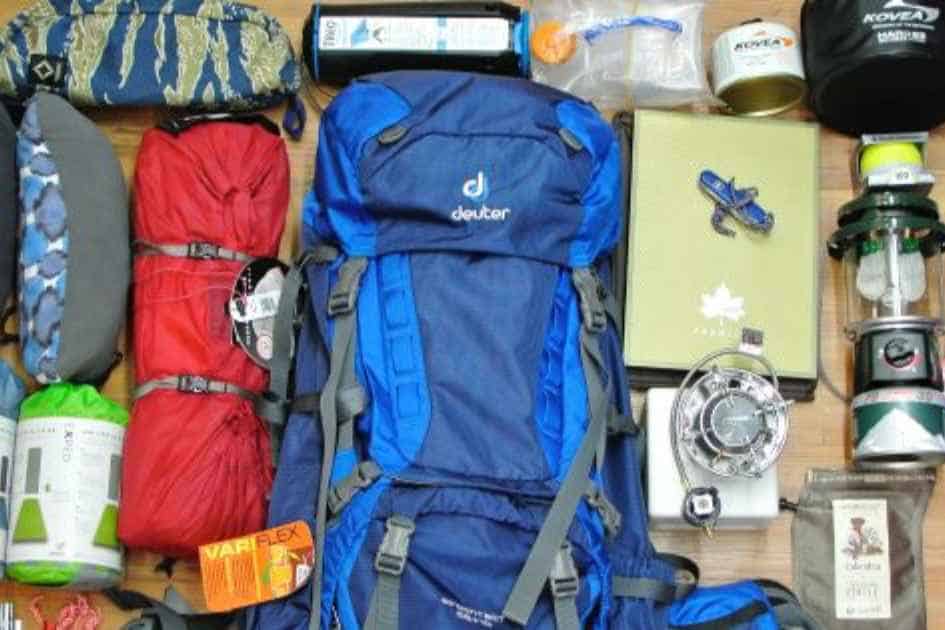
Camping for Beginners Checklist – Gear & Tips to Survive

10 Types of Tents Buying Guide

Camping Cots vs Air Mattresses – What’s Better?

Pillows for Camping- Review [Maximize Your Adventure & Sleep]😴

Pole Tent vs Frame Tent – Which Is Better?

The Best of Outdoor and Camping Near Berlin

How to Find a Good Campsite (Tips from Experienced Campers)

The Ultimate Guide to Choosing the Best Backpacking Towel for Your Next Trip

Jetboil Zip vs Flash: Battle of the Boilers
Last update on 2024-06-13 / Affiliate links / Images from Amazon Product Advertising API
How To Do The Everest Base Camp Trek In Nepal
The Mount Everest Base Camp Trek in Nepal is one of the world’s best bucket list hikes. In less than 2 weeks, you can trek to the foot of Mt Everest and other snowy peaks in the Himalayan mountains.
The good news is that it’s not a super difficult hike, and you don’t need a big budget to do it. The EBC trek is worth it for the fun and accomplishment alone, but you also get views of the Himalayas that are out of this world.
This travel guide will explain how you can do the Mt Everest Base Camp hike independently (with or without a tour guide), along with a recommended packing list and everything else you need to know before you go!
Best Everest Base Camp Tours
First of all, if you’d rather skip the hassle of planning your own EBC Trek, Klook has Everest Base Camp Tours starting as low as $900 USD for a full 12-day trek.
You may be able to find something cheaper than this once you land in Kathmandu, but booking online with a vetted tour company has some big advantages, and the reviews on their website are very positive.
We’ve used Klook for lots of tours and activities around the world, and they’re great! Highly recommended.
Book Now: Everest Base Camp Tours

When To Do The EBC Trek
The Mt Everest region has 4 different trekking seasons:
- March – May: High season. Best weather, with stable temperatures and bright sunny days, but the trails can get crowded. During these months you may share the EBC trail with pro climbers on the way to go summit Everest.
- June – August: Monsoon season. There’s a lot more rain during these months, and the trails are mostly empty.
- September – October: Clear days and busy trails. This is one of the most popular trekking seasons.
- November – February: Coldest season, but the weather is stable and dry. The trails are mostly clear.
I trekked in early February, and even though it was nice having the trail mostly to myself, the cold in the evenings and mornings was straight up misery.
My home state of Missouri can get very cold in the winter, but the cold has just never been my thing. If I could go back and change it, I would definitely do my Everest Base Camp hike later in the season.

Everest Base Camp Weather
Temperatures on the Mt Everest Base Camp Trek can range from 5 °C (40 °F) to 20 °C (70 °F) depending on month, and as low as -30 °C (-22 °F) at night during the winter months.
If you trek during the warmer months (Mar-May and Sep-Oct), the cold is not a big problem and shouldn’t be hard to cope with. Winter is a different story. Your snot will freeze in your nose at Gorak Shep.
Sunshine is key for winter trekking in Nepal, and thankfully you should have lots of sun in most months outside of the monsoon season. On my February hike, I often found myself shedding all my layers while trekking because I was heating up in the sun.
If you do your Everest Base Camp hike during the winter, the biggest issue is staying warm in the evenings and at night. For this, you’ll definitely want a top quality down jacket and sleeping bag.

All About Everest Base Camp Trekking
My everest base camp itinerary.
- Day 1: Kathmandu to Lukla to Benkar .
- Day 2: Benkar to Namche Bazaar .
- Day 3: Namche Acclimatization Day .
- Day 4: Namche to Deboche .
- Day 5: Deboche to Pangboche .
- Day 6: Pangboche to Dingboche .
- Day 7: Dingboche Acclimatization Day .
- Day 8: Dingboche to Thukla .
- Day 9: Thukla to Gorak Shep .
- Day 10: Everest Base Camp .
- Day 11: Kala Patthar to Gorak Shep to Pheriche .
- Day 12: Pheriche to Namche .
- Day 13: Namche to Lukla .

If you ever need motivation to keep going on the Everest Base Camp hike, just look at how much the porters are carrying!

Mount Pumori as seen from the Kala Patthar viewpoint, just a short distance from Mt Everest Base Camp.

Ama Dablam, one of my favorite mountains on the Mt Everest Base Camp Trek.
EBC Trek Packing List / Gear
This isn’t a complete list of everything to bring on a Mt Everest Base Camp Trek, and you may have to change things up a little depending on what month you go, but these are just some of the basics.
You can find most of this gear in Kathmandu, but in my opinion you’ll get higher quality and a wider selection if you order online.
- Beanie: I only wore this at night, but it definitely helped keep my ears warm.
- Down Jacket: Bring the biggest, warmest DJ possible. This is your most important piece of gear. You can use it as an extra cover at night.
- Fleece Sweater: This is the only jacket you’ll need to wear while trekking most days, especially if it’s sunny.
- Shirts: Something comfy with quick dry material.
- Trekking Pants: Something lightweight and breathable.
- Thermal Underwear: May not be needed if you trek in the warmer months.
- Gloves: I only wore these at night, but they definitely helped keep my hands warm.
- Socks: Merino wool is best for staying warm and stopping moisture.
- Headlight: Smart to have at least a small one, just in case.
- Tumbler: 1 liter water bottle to refill daily on the trek.
- Sunblock: It’s easy to sunburn at high altitudes. A small bottle is plenty.
- Sunglasses: Good for snow. May not be necessary unless you plan to hike a mountain pass like Cho La.
- Hat: I wore old faithful throughout the hike.
- Watch: An altimeter watch would be fun to play with here.
- Camera: Duh. You can’t do the Mt Everest Base Camp Trek without taking lots of pictures.
- Power Bank: Bring a big power bank and you might only need to recharge it once on the whole trek.

Everest Base Camp Trek Cost
For a 13 day trek, I paid about $21 USD per day for food, drinks, and room. Porter/guide was an extra $25 per day, although it’s not a requirement. Flights to Lukla were $330 return, but again not a requirement if you hike in.
You can read the sections below for more info on the daily trekking costs and what you get for your money. It’s not a very expensive trek, all things considered!
Keep in mind, these numbers are from 2020. They’ll go up a little over time. Exchange rates may also vary, so check the latest rates .

The flight to Lukla from Kathmandu is $165 USD each way. You can shop for flights to Lukla at Skyscanner.
If your budget is tight or you have extra time, you can skip this flight by hiking from Jiri to Lukla rather than flying. It only adds a couple days to the itinerary.

Guide / Porter / Solo
You can do the EBC trek with a guide, porter, OR independently (solo).
A guide will show you the way to Mt Everest Base Camp and help with lodging, navigation, advice, taking pictures for you, etc. A porter-guide will do these same things and also carry a 20 kg (45 lb) pack for you.
A porter or guide is NOT a requirement to do this hike, especially if you go in the warmer months when you may not need as much gear. In 2023, they were supposedly introducing a guide requirement for EBC, but so far that has not been enforced at all, thankfully.
With that said, there are some good advantages to hiring a guide, and it’s pretty cheap by Western standards. A porter is only $15 or $20 USD per day, and a porter-guide is $25 per day. A popular arrangement is to hire one porter for two hikers, splitting the cost and still making things easier for both of you.
In the end, this all depends on your budget and hiking preferences.

Hiking Fees
If you’re hiking EBC independently, you’ll need to be aware of two fees you have to pay near the start of the trek.
There’s a local government tax that they’ve now started collecting in Lukla. This one is currently 2,000 Rupees ($17 USD).
There’s also an Everest park fee/ticket you have to pay at the Sagarmatha National Park entrance just beyond the small village of Monjo, Nepal. This one is currently 3,500 Rupees ($30 USD).
No TIMS card is needed anymore for independent hikers. That fee has been retired for the Mount Everest Base Camp Trek.

Accommodation & Amenities
Throughout the Everest Base Camp hike, you’ll stay and sleep at small guesthouses along the way, called teahouses.
This is where you get your meals and drinks for the trek, along with the occasional amenities like showers, charging, or WiFi. The teahouses start out decent, but quickly get more shabby as you go further up the trail.
You have to pay for everything you use, of course, and the prices get quite high as you go, because everything has to be hauled up on the backs of the poor porters.

Guesthouses
The teahouses on the EBC trek are cold and dingy, with drop toilets and cracks in the walls. Don’t expect luxury.
Most rooms are free as long as you buy your meals there (the meals are how they make their money). If you stay at a lodge and don’t eat there, you’ll be expected to pay for the room.
In some cases, I was charged 500 Rupees for a room on top of my meal costs. I’m not sure why some teahouses do this and others don’t, but I never paid more than 500 Rupees for a room, and most were free with the meals.

Food & Drink
I’m happy to report that the food and drinks on the Everest Base Camp hike are top notch, especially after you’ve worked up an appetite trekking.
You have western food choices, or the standard local staples like veggie fried rice, steamed momos (dumplings), and mushroom soup. Everything was hot and fresh. Meal prices for these ranged from 250 to 750 Rupees depending on altitude. Not too bad.
For drinks I tried hot chocolate, lemon/apple/mint tea, and occasionally bottled water for my tumbler. These ranged from 100 to 400 Rupees. If you want to avoid plastic bottles, there’s usually boiled water available and this is safe to drink too.
Getting enough water on the trek is never a problem. Just fill up a 1 liter tumbler in the morning, and this will last you until evening, especially since you’re likely to pass more tea houses along the trail as you’re hiking throughout the day.

Showers are only available at a few lodges, depending on the season and how high up you are, and they cost 600 to 1200 Rupees. In the winter, water higher up will be frozen most of the time.
I never had a shower on my February EBC trek, and that seems to be the norm (although I got one or two opportunities in Namche). Yes, it’s gross. I could smell myself by trek’s end, and it wasn’t pretty.
But aside from the fact that I hate to fork out money for something as basic as a shower, I also never really got close to other people for very long on the trek, so I didn’t feel too guilty about it.
Most days were cold enough that the thought of stripping down for a shower was not really appealing, either. Your best bet is baby wipes and deodorant.

WiFi / Cell Service
WiFi costs anywhere from $5 to $10 USD per day if you buy it from the teahouses.
Alternatively, you can buy a 10 GB/30 Day Everest Link WiFi card in Namche Bazaar and use this for the entire EBC trek. During my Mount Everest Base Camp Trek the WiFi was down across the whole region, so unfortunately I wasn’t able to use either of these options.
I bought an Ncell local SIM card in the Kathmandu airport and had 3G service for half the days of the Everest Base Camp hike. Coverage is still improving in the area, so if you need to stay connected I’d definitely bring a local SIM.

Electricity
All of the teahouses on the way to Mt Everest Base Camp sell outlet charging for electronics, and the prices range from $2 to $10 USD for a full charge, depending on how far up the trail you are.
The key is to bring a big power bank and then use this to charge all of your other electronics (phone, camera, etc). I did this and only paid once to recharge my power bank on the whole trek.

How Much Cash To Bring
Everything you buy during the Everest Base Camp hike (meals, WiFi, charging, etc) will have to be paid for with cash. Credit cards won’t work. There are no ATMs outside of Lukla and Namche Bazaar (Days 1-4), and even the ATMs there are not reliable.
What this means is that you’ll have to withdraw enough cash (Nepalese Rupees) at an ATM in Kathmandu to cover your entire trek. The ATM fees will bite you, and I hate to carry large amounts of cash, but it’s not really avoidable here.
All up, I spent about $20 USD (2,400 Rupees) per day on the Mount Everest Base Camp Trek, and never spent more than $25 USD in a single day. With that said, I didn’t splurge on WiFi, showers, charging, or alcohol. The only things I bought were the bare necessities: room, food, and drinks.
If you hire a porter/guide, you don’t need to factor that into your daily cash carry. That’s paid before the trek starts. But do reserve a little cash for a decent tip.

Mount Everest Base Camp Trek Difficulty
I’m not going to lie, this is a difficult trek. And if you do it in the winter like I did, it’s even harder. With that said, if you are in decent shape, determined, and obey the guidelines for altitude sickness prevention (more on that below), then you’ll have no problem reaching base camp.
There is a lot of elevation gain and loss on this hike. At times near Lukla, the constant ups and downs will make you feel like you’re hiking a roller coaster, but the trail is never too steep or dangerous. After Namche, it’s mostly a slow uphill plod.
This trek has been completed by old seasoned hikers in their 70s, and young kids in their pre-teens. It’s also been flunked by healthy 20-30 somethings who try to push through it quickly without enough acclimatization to altitude.
Patience and discipline are key for trekking to Everest Base Camp. Slow and steady wins the race here.

Trekking Distance
The one way trekking distance from Lukla to Mt Everest Base Camp is about 65 kilometers (40 miles).
That means the total roundtrip distance of an EBC Trek is about 130 kilometers, even if you don’t do any of the detours.
Don’t let that scare you off. It’s a lot of hiking, but every step is worth it.

Altitude Sickness
By far your biggest danger on the Mount Everest Base Camp Trek is altitude sickness, also known as Acute Mountain Sickness (AMS).
No one is immune to this, and it doesn’t matter how fit you are. If you gain altitude too fast, you can get sick and in some cases even die. Plenty of people have died from AMS on the EBC Trek.
The problem is that overzealous hikers push the envelope on this hike all the time, and a lot of them end up needing a very expensive helicopter evacuation to lower ground.
The best way to avoid altitude sickness is to go slow . At altitudes above 3,000 meters (10,000 feet), don’t increase your sleeping elevation by more than 300-500 meters (1,000-1,500 feet) per night.
Every 1,000 meters (3,000 feet) you should also spend a second night at the same elevation. If you get a bad headache, dizziness, or nausea, descend to a lower altitude until you feel better. As long as you follow these general guidelines, you shouldn’t have any issues.
You can take Diamox (acetazolamide) on the trek for extra AMS prevention. This medication can be found in Kathmandu or Namche. I bought mine in Namche and it seemed to help my headache and slight foggy feeling. I didn’t have any side effects aside from the usual tingling toes/fingers.

Everest Base Camp Altitude
The Mount Everest Base Camp altitude is 5,364 meters (17,598 feet). At this elevation, there is 50% of the oxygen at sea level.
However, most treks also go to Kala Patthar, a viewpoint even higher than base camp where you can get the best views of Mount Everest.
The elevation at Kala Patthar is 5,644 meters (18,519 feet). From there, you’ll be rewarded with an incredible panorama of Mount Everest and other icy peaks like Pumori, Lhotse, and Nuptse.
Happy travels!

If you’d rather skip the hassle of planning your own EBC Trek, Klook has Everest Base Camp Tours starting as low as $900 USD for a full 12-day trek.
You may be able to find something cheaper than this once you land in Kathmandu, but booking online with a vetted tour company has some big advantages, and the reviews on their website are very positive for this Mt Everest Base Camp tour.
More Nepal Travel Tips
Hopefully you were helped by this guide for the Everest Base Camp Trek. Let me know in the comments below if I can help answer any questions.

You may also like
Fulidhoo island guide: shark & stingray beach in maldives, how to visit dhigurah island: budget paradise in maldives, 10 best hikes in aruba: family friendly trails, how to visit tanjung puting national park in indonesia, sanur bali travel guide: 24 best things to do, coron vs el nido: which is better all differences explained.
So much useful detailed information.
Thanks for the straight forward information. Beautiful photos

Leave a Comment Cancel Reply
Save my name, email, and website in this browser for the next time I comment.
You are using an outdated browser. Please upgrade your browser to improve your experience.

Everest Base Camp Trek Khumbu Valley, Nepal • 17,300' • 5273m Expedition Details Dates and Prices
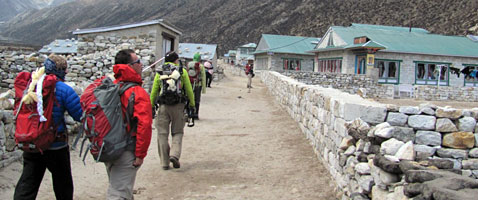
- Sign Up!
- Gear List
IMG Covid-19 Vaccine Policy
Nepal Treks with International Mountain Guides
The Everest Base Camp Trek is a classic adventure! IMG offers treks through the Khumbu Valley of Nepal to the Everest South Side Base Camp as well as through Tibet to Everest North Side Base Camp. Dozens of companies offer Everest Treks, but we believe our experience, safety precautions, and solid record of trekking and climbing in the Himalayas make IMG your best choice for trekking Nepal and Tibet.
IMG also offers the opportunity to combine your Nepal trek with a climb of Lobuche Peak (20,075') or the unique chance to climb to the Western Cwm of Everest through the Khumbu Icefall and beyond . Please read on to find out what makes the International Mountain Guides Everest Base Camp Trek different from all the rest.
Classic Nepal Everest Base Camp Trek
The trek to Everest BC is one of the world's classic human powered adventures! We have three trekking departures to Base Camp; each trek accompanies the IMG climbing team and sees all the famous sights on the way up and down the Khumbu Valley. Our itinerary includes staying in lodges between Lukla and Pheriche, then in our custom Lobuche Peak base camp (for fantastic acclimatization hiking) for several nights prior to moving on up to Everest BC at the beginning of the expedition. Rub shoulders with the climbers and see what a real expedition is like. Climb Kala Pattar, hike up to the base of the Khumbu Icefall and get some photos, then join in with the expedition puja ceremony at Base Camp. You stay overnight at Everest Base Camp as a guest of the expedition; only trekkers associated with expeditions are allowed to stay at EBC. Then, trek back out to Lukla with our crack guide team for the flight to Kathmandu.
We have a limited number of positions available on these Classic EBC Treks, accompanying each of our three climbing teams.
Gokyo Extension to EBC Trek
For trekkers wishing to extend their trek, we have the Gokyo Extension Option with Trek Team 2 which adds 6 days of trekking. You'll cross two more high passes (Cho La and Renjo La @ 5300+m) and visit the famous Gokyo Valley. What a classic! From the summit of Gokyo Ri you see Cho Oyu (8153m), Gyangchung Kang (7922m), Lhotse (8501m), Makalu (8475 m), Cholatse (6440m), Taweche (6542m), Kantega (6685m), Thamserku (6808m), Lobuche (6145m) and Mt. Everest (8848m).
Sherpa Trek with Local Guides to Everest BC
Our Nepalese led Everest trek offers top notch support and logistics. This group also stays at IMG Base Camp, near the end of the expedition, normally about the time of the summit bids. This is an exciting time to be there! After the Base Camp overnights, trek back out to Lukla with our local guide team for the flight to Kathmandu. With a slightly accelerated itinerary, you can do this trip in 3 weeks of vacation time!
Lobuche Peak Summit Climb
If you would like to visit Everest Base Camp with our Teams 1, 2 or 3 and stay longer and go higher, bring your crampons and ice axe and add a climb of Lobuche Peak (to over 20,000 feet — we stop at the false summit — the last pitch to the real summit is difficult technical climbing).
After spending several nights at Everest BC for acclimatization, our Lobuche climbers and members of the Guide Team will drop one day back down the valley to climb this beautiful peak, with world class views of Everest from the summit. From the beautiful IMG Lobuche Base Camp tucked up a side valley from the EBC trek route, the route climbs to a high camp which leads to the summit ridge. The steeper parts of the climb to the ridge are normally fixed with about 500 meters of rope.
Lobuche Peak is a perfect objective if you are fit and have Mt. Rainier type skills (ice axe, crampons, and roped glacier travel). We will review use of fixed ropes for climbers who have not done this before. Afterward, trek back out to Lukla with our crack Nepalese Guide Team for the flight to Kathmandu.
Please see the Lobuche Expedition Pages for more info specifically on Lobuche Peak.
Note on Dates
Dates are listed starting with the arrival day to Kathmandu to the arrival day back to Kathmandu from Lukla at the end of the trip.
The ending dates for the EBC Classic Trek, Sherpa Trek, and Lobuche Climb are FIXED, but you should add one contingency day in Kathmandu at the end, before flying home, in case of Lukla flight delay.
Expedition Organization and Leadership
International Mountain Guides (IMG) IMG is the oldest and most respected high-altitude climbing service in the world and its Himalayan mountaineering programs are organized and directed by Eric Simonson. Their teams include a group of professionals who are the best in the business. Since 1990, we have conducted over 60 Himalayan 8000 meter expeditions, and over 800 IMG team members have summited the world's classic 8,000-meter peaks, including Everest, Lhotse, Cho Oyu and Shishapangma.
IMG's Philosophy IMG leads the way! Our goal is to minimize risk while helping as many members as possible reach their goal, and we invest in the logistics and manpower to make this possible. We will not sit back and let other teams do the work. Our IMG Staff is part of the rope fixing efforts preparing the route for future summit bids. We value our reputation as one of the premiere international climbing companies. If you would like to join a world-class team in Nepal, we encourage you to contact us to discuss your goals and qualifications for membership in the IMG Nepal trek team!
Ang Jangbu Sherpa and the Nepalese Team A veteran of dozens of expeditions and an Everest summiter, Ang Jangbu has worked on every IMG Himalayan program since 1991 and is an immensely popular leader. Ang Jangbu Sherpa and his staff put together one of the very best Guide teams for IMG. We are proud to have a group of Local Guides working for us who are among the best paid, best led, best equipped, and best trained in the business.
Joining a high-altitude trek or expedition is a serious decision. You should be completely confident in the organization and leadership before you make that decision. Many of you have climbed with us before, and because your experience with us was good, you're considering another climb with us. For those of you who haven't climbed with us before, we strongly encourage you to interview us thoroughly and also talk to our past clients. When you're ready to make the decision, we'll be happy to provide you with a complete list of references.
Please also browse comments online from our trekkers and climbers.

EVEREST BASE CAMP TREK

EVEREST BASE CAMP

Pin Tweet Share WhatsApp
THE ESSENTIAL GUIDE
In this guide we cover everything you need to know about the Everest Base Camp Trek in Nepal. This includes suggested itineraries and practical information about accommodation, costs, what to pack, independent vs. guided treks, transport, and more. We also offer a route map with GPX download for use on the trek. And along with this written guide, we also share ‘silent hiking’ films that work well as a visual guide to the trail.
A chance for an adventurous and exciting journey, the Everest Base Camp Trek serves up spectacular scenery and gets you close to the world’s highest mountains, and as one of Nepal’s best known treks, it attracts people of all ages and experience levels. The trek ascends to high altitude (5000 m +) and is challenging, but it is achievable with a sensible itinerary that includes proper acclimatisation. Read on to discover more and start planning your own EBC trek.
Use the drop down menu below to jump to each section of this guide
TABLE OF CONTENTS
EVEREST BASE CAMP TREK OVERVIEW
EBC TREK FILMS
EVEREST BASE CAMP MAP & GPX DOWNLOAD
ELEVATION PROFILE & 3D ROUTE MAP
EVEREST BASE CAMP ITINERARIES
- THE CLASSIC EBC TREK
- EBC TREK VIA KHUMJUNG & PHORTSE
- EBC VIA KONGMA LA (5514 m)
- EBC AND GOKYO LAKES TREK
- BUFFER DAYS
EVEREST BASE CAMP TREK SUMMARY
- LULKA TO NAMCHE BAZAAR
- NAMCHE ACCLIMATISATION DAY
NAMCHE BAZAAR TO DINGBOCHE
- ALT. ROUTE VIA KHUMJUNG & PHORTSE
DINGBOCHE ACCLIMATISATION DAY
Dingboche to everest base camp.
- ALT. ROUTE VIA KONGMA LA
EVEREST BASE CAMP TO LUKLA
- ALT. ROUTE VIA CHO LA & GOKYO LAKES
BEST TREKKING SEASONS
HOW TO GET TO LUKLA
HOW TO GET TO LUKLA WITHOUT FLYING
EVEREST BASE CAMP TREK PERMITS & FEES
TREKKING INDEPENDENTLY
TREKKING WITH A GUIDE (& PORTER)
RECOMMENDED TREKKING AGENCY
ACCOMMODATION ON THE EBC TREK
FOOD ON THE EVEREST BASE CAMP TREK
SAFE DRINKING WATER
WIFI, PHONE SIGNAL & CHARGING
EVEREST BASE CAMP TREK COST & BUDGET
MONEY & ATMs ON THE EBC TREK
WHAT TO PACK FOR THE EBC TREK
ALTITUDE AWARENESS & AMS
TRAVEL INSURANCE
GETTING TO NEPAL
NEPAL TOURIST VISAS
Nepal visa on arrival process.
WHERE TO STAY IN KATHMANDU
BUDGET KATHMANDU ACCOMMODATION
Mid-range kathmandu accommodation, high-end kathmandu accommodation.
MAPS, GUIDEBOOKS & APPS
*Some of the links in this post are affiliate links – if you purchase a product or service via these links, we may earn a small commission at no extra cost to you . This helps offset the cost of running this blog and keeps us travelling so that we can continue to produce great content for you. As an Amazon Associate, we earn from qualifying purchases. We greatly appreciate your support!*
- DISTANCE | 120 -143 km depending on route taken (incl. acclimatisation/day hikes)
- DURATION | 12 – 15 days depending on route (incl. flying to/from Lukla)
- START/END | Lukla
- PERMITS REQUIRED | Khumbu Trek Card 2000 NPR; Sagarmatha National Park Fee 3000 NPR (SAARC nationals 1500 NPR / Nepali nationals 100 NPR)
- TREKKING SEASON | Best Seasons: April to Mid-May , October to Mid-November ; Shoulder Seasons: March, Late May, September, Mid-November to December ; Avoid: June to August, January to February
- TREK DIFFICULTY | Moderate (challenging if including Kongma La or Gokyo Lakes)
- ELEVATION GAIN/LOSS | +/- approx 7600 metres (Classic EBC Trek incl. acclimatisation/day hikes)
- MAX ALTITUDE | 5611 m (Kala Patthar)
- GUIDE MANDATORY? | Khumbu Pasanglhamu Rural Municipality has stated that it is NOT mandatory to trek with a guide in the Khumbu region
- ACCOMMODATION | Teahouses/Guesthouses in villages along the trail
- TREK COST | $35 – $144 USD per person, per day (budget independent trekker to fully inclusive package)
- RECOMMENDED TREKKING AGENCY | Himalayan Masters , Quote HOGG5 for 5% discount
DISTANCE 120 -143 km depending on route taken (incl. acclimatisation/day hikes)
DURATION 12 – 15 days depending on route taken (incl. flying to/from Lukla)
START/END Lukla
PERMITS REQUIRED Khumbu Trek Card 2000 NPR Sagarmatha National Park Fee 3000 NPR (SAARC nationals 1500 NPR, Nepali nationals 100 NPR)
TREKKING SEASON Best Season April to Mid-May October to Mid-November Shoulder Seasons March, Late May, September Mid-November to December Months To Avoid June, July, August January and February
TREK DIFFICULTY Moderate (challenging if including Kongma La or Gokyo Lakes)
ELEVATION GAIN/LOSS +/- approx 7600 metres (Classic EBC Trek incl. acclimatisation/day hikes)
MAX ALTITUDE 5611 m (Kala Patthar)
GUIDE MANDATORY? Khumbu Pasanglhamu Rural Municipality has stated that it is NOT mandatory to trek with a guide in the Khumbu region
ACCOMMODATION Teahouses/Guesthouses in villages along the trail
TREK COST $35 – $145 USD per person, per day (budget independent trekker to fully inclusive package)
OUR RECOMMENDED TREKKING AGENCY Himalayan Masters , Quote HOGG5 for 5% discount
EVEREST BASE CAMP TREKKING FILMS
Get a sense of the Everest Base Camp trekking route in our ‘silent hiking’ style ambient films.
EVEREST BASE CAMP TREK MAP & GPX DOWNLOAD
MAP & GPX DOWNLOAD
We have created a detailed Everest Base Camp trekking map to accompany this guide. It shows the Classic Everest Base Camp trekking route along with the alternative routes outlined in this guide, going via Khumjung and Phorste, Kongma La, and Cho La and Gokyo Lakes. The main side/acclimatisation hike options are included too, and the overland route between Salleri and Lukla is also marked.
Detailed stats and an elevation profile are included for each route section. Guesthouse settlements and tea shops are also marked, as well as key sights and practical info such as checkpoints, hospitals, and transport hubs. Guesthouses as per our own trek itinerary are marked, including info about prices and services, phone numbers (where possible), and a copy of the menu. Photos are included with almost every pin.
You can use the digital map online, or download it for offline use with a mapping app such as Organic Maps, Maps.me or Gaia GPS. This is very helpful for navigation assistance on the trail. It allows you to quickly pinpoint key places and services along the way and calculate distances and elevation differences between destinations.
Note that while we’ve tried to be as accurate as possible when recording and mapping the route, changes on the ground are inevitable (especially on routes crossing glaciers) and this map should not be solely relied upon for navigation.
EVEREST BASE CAMP TREK ELEVATION PROFILE
ELEVATION PROFILE
The image below shows the elevation profile of the Classic Everest Base Camp trek, starting and ending in Lukla. The route shown here includes the various acclimatisation and side hikes as outlined in the suggested itinerary below. Elevation is displayed in metres and distance in kilometres.

3D ROUTE MAP
Watch our 3D relief map video to visualise the landscape and get a sense of the Everest Base Camp trek.
EVEREST BASE CAMP TREK ITINERARY
ITINERARY OPTIONS
There is more than one trekking route to Everest Base Camp . In this section we outline the Classic EBC trek itinerary, but also include three alternative itineraries which enable you to vary your route on the way to and from Base Camp and see much more of the Khumbu region.
We have created an overview table for each of the Everest Base Camp trek itinerary options. These include trekking distances and approximate trekking times for each day (excluding lunch stops, breaks, etc), as well as stats on elevation gain/loss and sleeping altitude. For each itinerary the assumption is that you will fly into Lukla on the morning of Day 1 and start trekking. You will need to add 3 – 5 days if you plan to travel overland from Kathmandu to Lukla or vice versa.
It is also possible to combine the following itineraries to create your own alternative EBC trek. For example, you could trek via Khumjung, Phortse and Kongma La on the way to EBC, or you could include both Kongma La and Gokyo Lakes. A few minor possible alternatives along the way are noted below each itinerary, such as alternate overnight stops.
If viewing the itinerary tables on a mobile device or tablet, scroll to the right to see the full table or flip your screen to landscape mode
CLASSIC EVEREST BASE CAMP TREK ITINERARY
A classic Everest Base Camp trek itinerary is 11 nights/12 days, following the exact same route on the way to and from EBC. If you have limited time, this is the shortest itinerary you can follow while sticking to safe altitude ascent rates.
DAY 1 ALT. INFO*
*Alternatively, continue to Monjo (2830 m) where fewer people stay overnight (a further 5.1 km, approx 2 hours trekking time) . Doing this means the trail will be less busy for both your Phakding to Monjo section, and the Monjo to Namche section the following morning.
DAY 4 ALT. INFO**
**Alternatively, continue to Pangboche (3950 m) where fewer people stay overnight (a further 4.2 km, approx 1.5 hours trekking time). Pangboche is a lovely village with fantastic views of Ama Dablam, and there are many guesthouses. Tengboche, on the other hand, only has two guesthouses and it can be difficult to get a room here in peak season. Continuing to Pangboche also means the trail will be less busy for both your Tengboche to Pangboche section, and the Pangboche to Dingboche section the following morning.
DAYS 8 & 9 ALT. INFO***
***On days 8 and 9 the classic itinerary that most people follow is to visit EBC after lunch at Gorak Shep, then hike up Kala Patthar in the dark for sunrise the next morning (when it is bitterly cold). If you swap these two around as per the above suggested itinerary, you are guaranteed to have a less busy experience at both EBC and on the trail up Kala Patthar. As the skies are usually clearer in the morning you are also likely to have better views at EBC, however it is possible that the views from Kala Patthar will be obscured by afternoon clouds. If you’re lucky and have clear afternoon skies, then you will be treated to a fiery sunset glow on Everest and the surrounding mountains. If you hike up Kala Patthar in the morning, your mountain views will be brief as the sun rises directly behind Everest and you’ll soon be looking directly into the sun.
ALTERNATIVE EVEREST BASE CAMP TREK ITINERARY VIA KHUMJUNG AND PHORTSE
Our first alternative Everest Base Camp trek itinerary is 12 nights/13 days. This itinerary follows a different route between Namche Bazaar and Pangboche on the way to EBC, by trekking via Khumjung and Phortse. The overall difficulty of this route remains moderate, and the additional day allows you to explore more of the region and gives more time for acclimatisation. It’s also a great option for avoiding crowds during the peak trekking seasons, as far fewer people trek this alternative route.
DAYS 9 & 10 ALT. INFO**
**On days 8 and 9 the classic itinerary that most people follow is to visit EBC after lunch at Gorak Shep, then hike up Kala Patthar in the dark for sunrise the next morning (when it is bitterly cold). If you swap these two around as per the above suggested itinerary, you are guaranteed to have a less busy experience at both EBC and on the trail up Kala Patthar. As the skies are usually clearer in the morning you are also likely to have better views at EBC, however it is possible that the views from Kala Patthar will be obscured by afternoon clouds. If you’re lucky and have clear afternoon skies, then you will be treated to a fiery sunset glow on Everest and the surrounding mountains. If you hike up Kala Patthar in the morning, your mountain views will be brief as the sun rises directly behind Everest and you’ll soon be looking directly into the sun.
EVEREST BASE CAMP VIA KONGMA LA TREK ITINERARY
Our second alternative Everest Base Camp trek itinerary is 13 nights/14 days. This changes the route taken between Dingboche and Lobuche on the way to EBC by crossing a high pass called Kongma La (5514 m). This section is more challenging than the rest of the route, but it offers incredible scenery and the chance to explore much quieter sections of trail than you’ll experience on the classic EBC route.
DAY 8 ALT. INFO**
***There are two viewpoints on the Chukhung Ri acclimatisation hike, the lower one (5380 m) which most people visit and the higher one (5516 m) which involves a tough and steep climb towards the end.
DAYS 10 & 11 ALT. INFO****
****On days 8 and 9 the classic itinerary that most people follow is to visit EBC after lunch at Gorak Shep, then hike up Kala Patthar in the dark for sunrise the next morning (when it is bitterly cold). If you swap these two around as per the above suggested itinerary, you are guaranteed to have a less busy experience at both EBC and on the trail up Kala Patthar. As the skies are usually clearer in the morning you are also likely to have better views at EBC, however it is possible that the views from Kala Patthar will be obscured by afternoon clouds. If you’re lucky and have clear afternoon skies, then you will be treated to a fiery sunset glow on Everest and the surrounding mountains. If you hike up Kala Patthar in the morning, your mountain views will be brief as the sun rises directly behind Everest and you’ll soon be looking directly into the sun.
EVEREST BASE CAMP AND GOKYO LAKES TREK ITINERARY
Our third alternative Everest Base Camp trek itinerary is 14 nights/15 days. This varies the route taken between Lobuche and Namche Bazaar on the way back from EBC, by crossing a high pass called Cho La (5368 m) and descending via the spectacular Gokyo Lakes. Again, this route is more challenging than the classic or first alternative EBC itineraries we suggest, due to the extra distance and overall elevation gain. However, it is a highly rewarding trek which includes some of the most spectacular locations in the Khumbu region. The sections of trail that you must repeat on the way to and from EBC are kept to an absolute minimum on this itinerary.
IMPORTANCE OF BUFFER DAYS
Building in buffer days to your Everest Base Camp itinerary is highly recommended, especially if you plan on flying to/from Lukla. Flights are regularly cancelled due to poor weather conditions, sometimes for a number of days. If everything runs smoothly, it takes half a day or less to get to/from Lukla at the start/end of your trek. However, if flights are not operating, it can take up to 3 days to travel overland from Kathmandu to Lukla, using a mixture of buses and jeeps, and by trekking too. Therefore, it’s wise to have at least 3 or 4 days between the end of your planned trek itinerary and any international flight. This would allow you time to get from Lukla to Kathmandu overland if necessary.
Of course, a delay could also happen at the start of your trek while trying to get to Lukla, and this might leave you struggling to catch up with your original itinerary. Having a couple of buffer days built in will mean you don’t have to drastically alter your itinerary, avoiding the need to walk extra long distances to save a day or skipping places because you don’t have time.
Buffer days also allow you to alter your itinerary on the go more easily. For example, if you get sick and need to spend an extra night somewhere, or the weather is bad and you want to wait it out before continuing your trek, then you have the extra days on hand.
It’s worth knowing that should everything go to plan and you don’t need to use any buffer days during your trek, it’s straightforward for a trekking agency to change the date of your flight, bringing it forward a few days for example. However, this is not so easy if you have booked your flight online, independently.
OUR RECOMMENDED TREKKING AGENCY
We partnered with Himalayan Masters for our Langtang Valley, Gosainkunda, EBC and Everest Three Passes treks, and found them to be professional and committed to a high level of service
To enquire about booking your own trek, get in touch via email at [email protected] and mention the code HOGG5 to get a 5% discount off the cost of your trip
ROUTE SUMMARY
LUKLA TO NAMCHE BAZAAR
The first two days of the Everest Base Camp trek are repeated in reverse on the final day of the trek. With only one route connecting Lukla and Namche Bazaar, unfortunately there’s no avoiding this.
This section of the trek passes through numerous villages and teahouse settlements, the last of which is Jorsale, shortly beyond the entrance to Sagarmatha National Park. There are five suspension bridges to cross, including the 125 metre high Hillary Bridge, and numerous smaller fixed metal bridges. The Khumbu Trek Card Registration desk (where you get your Khumbu Trek Card and pay your Sagarmatha NP entrance fee) is shortly beyond Lukla, and there are further checkpoints at Toc Toc, Monjo, and just before Namche Bazaar.
The route follows a mixture of wide stone paths, riverside paths, and forest trail, with plenty of up and down along the way. There is one notable ascent, a 700 metre climb immediately after crossing the Hillary Suspension Bridge, on the last stretch before Namche. This section is a pleasant couple of days and a good introduction to the trek, with greenery and the chance to see colourful rhododendrons and blossoms in spring, plenty of scenic river views, and a definite buzz thanks to all the people coming and going and the numerous villages dotting the trail.
With only one route up and down to Namche, traffic jams are common along this section, with trekkers, porters, and pack mules, yaks and their handlers all sharing the same trail. Bottlenecks are particularly common at suspension bridges and on the steep climb up to Namche. Be sure to wait on the side of the trail without a drop-off when letting pack animals pass, and don’t start crossing a bridge if you can see them coming in the opposite direction – let them cross first. Finally, stick to the left side when walking by any mani stones, mani walls and prayer wheels, as it’s both common practice and culturally appropriate.
For more detail about this section of the route, see Days 1 and 2 of our Everest Three Passes Route Guide .

The Hillary Suspension Bridge as seen from the valley floor, with the old bridge still in place below

NAMCHE BAZAAR ACCLIMATISATION DAY
It’s important to acclimatise properly throughout your Everest Base Camp trek. This allows your body time to get used to the ever-increasing altitude as you ascend to 5000 metres and above. Building in rest days, staying well hydrated, and going on acclimatisation hikes (where you climb higher during the day but sleep lower at night) are all good ways of helping your body acclimatise.
Unless you are already acclimatised (for example you have been at altitudes of 4000 metres and higher within the previous week), spending a second night at Namche Bazaar is highly recommended and this is standard on virtually all Everest Base Camp trek itineraries. You should do this even if it seems like you feel physically fine.
The most common destination for an acclimatisation hike from Namche Bazaar is the Hotel Everest View (3880 m) , where you can get lunch or a drink and enjoy fantastic views from the terrace. It takes around 3 hours to hike up to the hotel and back down again. A must-visit on the way is Sagarmatha Next , a learning / experience / visitor centre and gallery championing waste management solutions for the Khumbu region.

Morning view over Namche Bazaar from the northeast

Morning view of Namche Bazaar from the northeast
For a longer hike and the chance to see more of the local area, doing a loop via Khumjung is a great option. Khumjung is the largest Sherpa village in the region, with an impressive monastery and a school founded by Edmund Hillary in 1960. The original classroom is now the Sir Edmund Hillary Visitor Centre , another great place to visit and learn about the Khumbu region. The loop hike (including Hotel Everest View) is around 7.5 km, and you should allow up to 5 hours for the hike. It’s also possible to include a visit to Khunde village, home to another monastery. This would extend the loop route to around 9.1 km and you should allow up to 6 hours.
If you plan to overnight at Khumjung on day 4 of your trek, following the ‘Alternative Everest Base Camp Itinerary’ outlined above, you might want to opt for a shorter Namche acclimatisation hike. Hiking 100 metres up to the helipad on the western side of the village is a good choice. There is an excellent view over Namche from here, where you can see it curving around the sloping hillside in amphitheatre-like fashion.
Various Namche acclimatisation hiking routes are marked on our EBC Trek map .
CLASSIC ROUTE VIA TENGBOCHE
This two-day section of the Everest Base Camp trek offers fantastic mountain scenery and a beautiful trekking trail, passing through forest and open hillside. There is one notable big climb between Phunki Thanga and Tengboche but otherwise the trail is mostly straightforward, with just a few short steep sections, and plenty of flat, undulating, or gentle climbs. There are a handful of small villages along the route, two suspension bridges, a checkpoint at Phunki Thanga, and an impressive monastery at Tengboche which is well worth visiting (daily 7am – 8am, 9am – 11am, and 1pm – 5:30pm, monks chanting at 3pm). After Pangboche you are more or less above the treeline, surrounded by imposing mountains and expansive views.
For more detail about this section of the route, see Days 4 and 5 of our Everest Three Passes Route Guide .

Trekkers pass through Shomare on the way to Dingboche, with the twin peaks of Ama Dablam rising behind

Trekkers pass through the village of Shomare on the way to Dingboche, with the twin peaks of Ama Dablam rising behind
ALTERNATIVE ROUTE VIA KHUMJUNG AND PHORTSE
This three-day route section follows an alternative trail between Namche and Pangboche before joining the classic Everest Base Camp trail for the final stretch to Dingboche. Opting for this itinerary allows you to vary your route on the way to and from EBC and take advantage of much quieter trails. Plus, the extra day allows for a slower ascent pace, which is a good option for anyone who knows they are slow to acclimatise or prefers to follow a more cautious itinerary.
This route climbs initially to Khumjung, the largest Sherpa village in the region, then stays above the ‘Classic EBC’ route to Pangboche, offering fantastic views throughout. There is a small guesthouse settlement at Mong La (3970 m) which is the highest point on the way to Phortse, a scenic village with a number of guesthouses, local homes, and the Khumbu Climbing Centre .
There is plenty of up and down on this section of the trek, with some notable climbs to Khumjung, Mong La, and both before and after Phortse. However, this route is not considerably more challenging than the ‘Classic EBC’ route, especially as it is split over three days instead of two.
Spending two nights at Dingboche, a sizeable village situated at 4300 m, is advisable in order to ensure you ascend to very high altitude at a safe rate. Going on an acclimatisation hike is also an important part of acclimatising to such altitudes, and Nangkartshang Peak (5039 m) is a great option. This hill rises to the north of Dingboche and there are fantastic views throughout the climb, especially of Ama Dablam. There is an obvious path all the way to the rocky top, which is festooned with prayer flags and spacious enough for plenty of people. The 766 metre climb should take around 2.5 – 3 hours, with the descent about half that. It’s advisable to start early (around 7:30am) for the best chance of clear views and calm conditions.

After a 760 metre climb, people rest and enjoy the views at the prayer flags on Nangkartshang

For a longer and less busy acclimatisation hike, a great option is the side hike up the valley to the east of Dingboche to Chukhung Village and Chukhung Ri, a viewpoint situated at 5380 m. The views from Chukhung Ri are fantastic, looking back down the valley and across to an impressive ice wall, and you’ll be surrounded by numerous majestic snowy peaks including Lhotse, Nuptse, Island Peak and Ama Dablam. Allow up to 8 hours for this return hike.

Plenty of outstanding views to appreciate while hiking up to Chukhung Ri

Plenty of outstanding views to stop and appreciate while hiking up to Chukhung Ri
Whichever acclimatisation hike you decide to do, ensure you have plenty of water, snacks, and warm layers with you.
For more detail about these hikes, see Day 6 (Nangkartshang) and Day 8 (Chukhung Ri) of our Three Passes Route Guide.
CLASSIC ROUTE
If you’re following the Classic EBC route you’ll trek from Dingboche to Base Camp over 2 – 2.5 days, spending a night at Lobuche and then at Gorak Shep. From Gorak Shep you’ll do a return hike to EBC. Most people also include a side hike to Kala Patthar, the highest point of the trek at 5611 m, where you can get a view of Mt Everest (which isn’t actually visible from Base Camp.)
The route heads up the valley to the northwest of Dingboche, climbs to Thok La pass, then heads northeast, running parallel to the Khumbu Glacier all the way to Base Camp. It’s a gradual ascent for most of the way, but at these altitudes (4300 m – 5300 m) even a gentle climb can take your breath away. The climb to Thok La on the way to Lobuche, the short but steep climb on the way to Gorak Shep, and the undulating rocky glacier section immediately before Gorak Shep are among the most challenging sections.
The views are wonderful throughout and the final sight of Everest Base Camp, encircled by soaring peaks, is a memorable one. This is especially true if you’re trekking during the peak climbing season, when a sea of tents sprawls across the glacier at the foot of the Khumbu Icefall – seen from the trail, these tiny yellow dots emphasise the enormity of the surroundings even more.

First sight of Everest Base Camp from the trail

Posing for the obligatory photo on the ‘EBC Rock’
Seen from the Kala Patthar trail about 30 minutes before sunset , the clouds part to reveal the summit of Mount Everest (8849 m)
Lobuche is a small settlement of guesthouses on the edge of the Khumbu Glacier, a very busy spot where everyone going to and from EBC stops for food and/or spends the night. Gorak Shep is even smaller, busier, and more basic with just four guesthouses and no good water supply.
For more detail about this section of the route, see Days 10 and 11 of our Everest Three Passes Route Guide .
ALTERNATIVE ROUTE VIA KONGMA LA
This alternative route to Everest Base Camp is a three day trek between Dingboche and Lobuche, via Chukhung, Chukhung Ri and Kongma La. At Lobuche you rejoin the classic route for the final section to Gorak Shep, Kala Patthar and EBC. This is part of the Everest Three Passes trek and is a challenging but very rewarding addition to the EBC trek. With far fewer people trekking this route compared to the Classic EBC route, you can expect the trail to be much quieter.
The route follows a gently ascending trail up the scenic valley to the northeast of Dingboche before reaching the small guesthouse settlement of Chukhung. It’s advisable to spend two nights here, using the extra day for an acclimatisation hike to the spectacular viewpoint of Chukhung Ri (5380 m) before crossing Kongma La the following day. The scenery around the village is very dramatic, as are the views seen throughout the hike to Chukhung Ri, with Ama Dablam rising to the south, Island Peak to the east, and Lhotse and Nuptse to the north, along with countless other peaks and the dramatic ice wall of the Chukhung Glacier.
The trek to Kongma La (5514 m) involves a long ascent but other than a couple of short steep sections, it’s mostly a steady climb, and the landscape is striking. From the pass you have incredible 360 degree views and you can see all the way down to Lobuche, a small cluster of buildings on the far side of the rocky Khumbu Glacier. The descent is somewhat steep and slippery at first due to loose dirt, shale, and small rocks, but becomes less steep as you work your way down to the eastern side of the glacier. The final section, crossing the glacier itself, involves plenty of up and down as you work your way across jumbled rocks and around small glacial lakes; on the other side, a final downhill stretch leads to Lobuche.
For more detail about this section of the route, see Days 7 – 9 of our Everest Three Passes Route Guide .

On the final approach to Kongma La

The Classic Everest Base Camp trekking route follows the same trail on the return to Namche Bazaar, covering the distance in three days with overnights at Pheriche, Namche, and Lukla. As you drop in altitude more oxygen flows through your blood and the physical strain on your body reduces. This combined with the fact that you no longer need to think about acclimatisation enables you to cover a much greater daily distance than on previous days. The return section of the trek is not all downhill however, and three 17 – 19 km days in a row can be very tiring!
ALTERNATIVE ROUTE VIA CHO LA AND GOKYO LAKES
An alternative route connects Lobuche and Namche Bazaar via Cho La and Gokyo Lakes. This turns your trek into a loop hike commonly known as the Everest Base Camp and Gokyo Lakes trek. Following this route over six days, you’ll cross Cho La (5368 m), a high pass to the west of Lobuche, descend from the pass and traverse the rocky Ngozumpa Glacier to reach Gokyo and a string of brilliant blue lakes, then follow the Gokyo Valley back to Namche where you’ll join the trail to Lukla. The route takes in some of the best scenery in the Khumbu region and is a fantastic alternative to the Classic EBC trek, although definitely more challenging with the addition of the high pass.
This route diverges from the classic trail a little south of Lobuche, working its way around a hillside to the northwest to reach the small guesthouse settlement of Dzonglha. The ascent to Cho La on the next morning is initially gradual, after which there are a couple of steep sections and the crossing of an icy glacier (microspikes recommended) just before the pass. The descent starts off steeply (aided by a fixed metal rope) before becoming more gradual as it works its way down the valley to the guesthouses at Dragnag (Thangnak). On the following morning* you have to cross the Ngozumpa Glacier, the largest glacier in Nepal, with a rocky, undulating trail passing small glacial lakes to reach Gokyo on the other side. The descent onto and climb off the glacier is quite steep.
*If you are looking to save a day it is possible to continue to Gokyo after crossing Cho La, without spending the night at Dragnag (Thangnak). It will very much depend on your energy levels and the weather conditions on the day.

Trekkers crossing the icy glacier towards Cho La (5368 m), the rocky dip ahead

Gokyo, a medium-sized teahouse village, sits on the western side of the glacier, on the shores of Dudh Pokhari, or Gokyo 3rd Lake. The setting is beautiful. You can visit the 4th Lake on a side hike to the north, and climb the steep trail to Gokyo Ri early the next morning for some of the most impressive views in the region. The return to Namche Bazaar is via the Gokyo valley, following the Dudh Koshi river. A good option is to break your journey at the small village of Dole, then continue beyond Namche to overnight at Monjo before the final stretch back to Lukla.

Early morning at Gokyo

Beyond Dole the trail descends towards Phortse Tenga, then climbs to Mong La, on the same route as outlined in the ‘Alternative Route via Khumjung and Phortse’ section. From Mong La it’s possible to descend all the way to Sanasa and take the same trail back to Namche that you followed on the way to Tengboche, or stay higher and follow a trail to the large Sherpa village of Khumjung before descending to Namche. The route between Namche and Lukla is the same as at the start of the trek.
For more detail about the Everest Base Camp to Gokyo section of the route, see Days 11 – 15 of our Everest Three Passes Route Guide .
SEE MORE FROM NEPAL

Everest Base Camp Trek: The Essential Guide

Everest Three Passes Trekking Route Guide

Everest Three Passes Trek: The Essential Guide

Gosainkunda Helambu Trekking Route Guide

Gosainkunda Trek: The Essential Guide

Langtang Valley Trekking Route Guide

Langtang Valley Trek: The Essential Guide

What To Pack For Trekking In Nepal

Upper Mustang Trek: The Essential Guide

Upper Mustang Trek Itinerary: A Day By Day Account

Annapurna Circuit Trek: The Essential Guide

Annapurna Circuit Trek Itinerary: A Day By Day Account

Manaslu Circuit Trek: The Essential Guide

Manaslu Circuit Trek Itinerary: A Day By Day Account
Everest base camp trekking season.
TREKKING SEASON
Like many treks in Nepal , the peak seasons for trekking the Everest Base Camp route are April to mid-May and October to mid-November . These months typically offer the best chance of both clear skies and warmer temperatures, although weather patterns are becoming increasingly unpredictable in Nepal and across the world, so you should still be prepared for snow and colder temperatures during these periods.
The spring trekking season coincides with the Everest climbing season , so the Khumbu region is very busy with helicopters and yaks transporting supplies to Everest Base Camp. If trekking at this time, you will have the chance to see base camp fully set up with all the tents, and there is a great buzz about the place. Outside of the climbing season, there are no tents or any other infrastructure at EBC.

Trekkers crossing the moraine-covered glacier between Lobuche and Gorak Shep on a clear skies spring morning

Trekkers crossing the moraine-covered glacier before Gorak Shep on a clear spring morning
In autumn, expect less wind and higher temperatures than in spring, while in late March and April, blooming rhododendrons and other spring flowers are a beautiful sight at some lower elevations.
The shoulder seasons are March, May, September and mid-November to December. During these times it can be much quieter on the trail. There is typically cold weather in March and December. In March there is a high chance of lingering or fresh snow. December typically has sunny weather and clear skies throughout the day. In late May and early September there is a higher chance of early or lingering monsoon rains and cloudy skies.
The summer months of June, July, and August coincide with the monsoon season . Trekking during this period means lots of walking in rain, muddy trails, leeches, and poor visibility with clouds obscuring the surrounding mountains. Many guesthouses close during this period, and it is not a good time to trek. Flights to and from Lukla are likely to be cancelled regularly and for days at a time.
The winter months of January and February are considered too cold by most to trek and many guesthouses are closed.
PLAN A TREK IN THE LANGTANG VALLEY

PLAN YOUR LANGTANG VALLEY TREK WITH OUR COMPLETE GUIDE

DETAILED TRAIL NOTES AND OTHER INFO FOR THE LANGTANG TREK
Lukla is the gateway for all treks in the Khumbu region, including Everest Base Camp, Everest Three Passes , and Gokyo Lakes. Nestled in the mountains at 2855 m, the closest dirt-road access is approximately 1 day’s walk away, with a tarmac road 3+ days’ walk away. The majority of people arrive in Lukla by air, landing at the small runway or helicopter pad at Tenzing-Hillary Airport (LUA). If you prefer not to fly, it’s possible to get to Lukla overland in 3+ days, by taking a bus/jeep then trekking on foot.
FLYING TO LUKLA
Flights to Lukla operate year-round from either Kathmandu or Ramechhap/Manthali (approx 4 hours’ drive from Kathmandu), although cancellations and delays are common as flights can only run in favourable weather conditions. The flight time is 30 minutes from Kathmandu, and 15 minutes from Ramechhap/Manthali. The Lukla runway is just 527 metres long and is sloped at an 11.7% gradient, making taking off and landing challenging for pilots and a little daunting for passengers.
Flights are operated by Tara (Yeti) Air , Summit Air , and Sita Air , with each company using small 15 seater twin propeller planes . Flights usually only operate in the morning, when the skies are clearer and there is less wind. There is a weight limit of 10 kg checked baggage + 5 kg hand baggage . The cabin is not pressurised and it’s very noisy. There are no assigned seats. For the best mountain views, try to sit on the left while flying to Lukla and the right on the return flight.
During peak trekking and climbing seasons , Lukla flights operate to and from Ramechhap/Manthali in order to ease congestion at Kathmandu Airport. The dates change annually, but this is roughly April 1st – May 20th and September 20th – November 20th . See below for how to get from Kathmandu to Ramechhap/Manthali.

The runway at the Tenzing-Hillary Airport in Lukla, sloped at an 11.7% gradient and just 527 metres long

The runway at Tenzing-Hillary Airport in Lukla, on an 11.7% gradient and just 527 metres long
Flight tickets cost $180 one way from Kathmandu and $152 one way from Ramechhap/Manthali . You can book online directly with the airline, or via an agency in Kathmandu. If you are booking an inclusive trekking package, for example with our recommended local trekking agency Himalayan Masters , your flight will be organised for you. Booking the earliest possible flight time is best as clouds tend to move in and the wind picks up through the morning, with later flights more likely to be cancelled. Note that agencies sometimes have access to earlier flights than are available to book online.
It is free of charge to change your flight date (in advance by calling the airline or in person at the airport) and it’s a good idea to reconfirm the day before you fly to avoid being bumped onto a later flight. Again, if you have booked through a trekking agency, they can take care of any flight changes and reconfirmations for you. This makes the whole process much more straightforward than if you have booked independently (especially if you’re trying to make changes while trekking with limited phone service or internet connection).
Be aware that it can be a bit chaotic at the airport and being bumped onto a different flight time and/or standing around confused about what’s happening is pretty normal. The situation is certainly easier to manage if you are with a guide, who will be used to the process, speaks the local language, and will take care of everything for you.
FLYING TO PHAPLU/SALLERI
Sometimes when flights can’t depart for Lukla, there is an option to fly to Phaplu (2 km north of Salleri) instead. From Phaplu it’s possible to trek to Lukla in about 3 days, or you can take a jeep as far as Thamdada (subject to road conditions) and trek the remaining distance to Lukla in 1 day.
See stages 2 and 3 in the ‘how to get to Lukla without flying’ section below for more details.
HOW TO GET FROM KATHMANDU TO RAMECHHAP AIRPORT (MANTHALI)
You can get from Kathmandu to Ramechhap Airport (RHP) (also known as Manthali) by public bus, shuttle bus, or private car. The journey takes around 4 hours.
Public buses depart between approx 0600 – 1100 from Ratna Park (also known as Old Bus Park) near Thamel, costing approx 600 NPR ($4.50 USD). The journey takes around 4 – 5 hours. You will need to spend one night at a guesthouse in Manthali before flying to Lukla the following morning. There are guesthouses within walking distance of Ramechhap Airport. You can just show up and buy a bus ticket on the day. Buses arrive at the Manthali Bus Park .
Shuttle buses depart from the Thamel area of Kathmandu at 0130 and 0200, allowing you to fly to Lukla the same morning. They also depart at 1100, if you prefer to travel during the day and spend one night in Manthali before flying to Lukla. The journey takes about 4 hours. You must make a reservation in advance. You can do this via a local agency, ask staff at your accommodation to help, or book online via Viator or Get Your Guide . Tickets cost up to $30 USD.
A private car costs approx 14000 NPR ($100 USD), which can be shared by up to 4 passengers. The road condition does not require a jeep/4×4 vehicle. The journey takes about 4 hours, with door-to-door service. You can book a private car via a local agency or ask staff at your accommodation to help organise it.
For the return journey from Ramechhap/Manthali to Kathmandu you must pre-arrange your shuttle transfer or private car transfer. If travelling back to Kathmandu by public bus, you should be able to get one from the Manthali Bus Park after arriving on the flight from Lukla.
HELICOPTER TO LUKLA
It is also possible to fly from Kathmandu to Lukla by helicopter. Helicopters can often fly in weather conditions that would ground twin propellor planes, they are generally considered safer, and they operate out of Kathmandu Airport year-round (unlike planes which only depart from Ramechhap/Manthali during peak season). Flying by helicopter is considerably more expensive though, costing around $500 USD one way per person (assuming there are enough people to fill five seats). You can book via a local travel or trekking agency, or book online in advance via Viator .

Morning mountain views on the helicopter ride to Lukla

Morning mountain views on the helicopter ride
It’s possible to get to Lukla without flying by using a combination of bus and/or jeep and trekking. This takes 3 – 5 days. Eventually there will be a road built all the way to Lukla, but for now the closest you can possibly get by jeep on a dirt road is Thamdada (1 day walk to Lukla), and by bus or jeep on a sealed road is Salleri/Phaplu (3 – 4 days’ walk to Lukla). Buses and jeeps stop for food and toilet breaks along the way. As the road between Salleri/Phaplu and Thamdada is unsealed, its condition can vary greatly depending on how much rain there has been. Sometimes it’s not possible to drive all the way to Thamdada, and you may only be able to reach Bupsa, Kharikhola, or Adderi.
Although it may be possible to get all the way from Kathmandu to Thamdada in one day, we do not recommend this as it means travelling on a dirt road with challenging hairpin bends and steep sections in the dark. Instead, it’s advisable to spend one night in Salleri where there are lots of guesthouses and travel to Thamdada the following day. At Thamdada, there is a guesthouse (Kare Hotel) at the jeep stop and two more approximately 25 minutes’ walk from the jeep stop. Additionally, there are many more guesthouses at Paiyu, which is around 2 hours’ walk away. It’s also possible to stop shortly before Thamdada to stay at a guesthouse in Kare (approx 1 hours’ walk to Thamdada).
The trekking route from Salleri to Lukla goes via Ringmu, Nunthala, Kharikhola, Bupsa, Kari La (Thamdada), Paiyu and Surke. Common overnight stops are at Nunthala, Bupsa, and Surke, after which you join the classic Lukla (or Cheplung) to Namche Bazaar route. There is a lot of elevation gain and loss on the Salleri to Lukla trekking route, so expect plenty of tiring up and down. The driving route from Salleri to Thamdada goes via Adderi and joins the trekking route shortly before Kharikhola.
KATHMANDU TO LUKLA OVERLAND STAGES
Step 1 // drive kathmandu to salleri/phaplu.
9 – 12 hours travel time (mostly sealed road); Phaplu is about 2 km north of Salleri
B us is approx 1700 NPR ($13 USD); departs from Chabahil Chowk (approx 0430) or from Koteshwor Chowk (approx 0500); no advance booking required
Shared Jeep is approx 2600 NPR ($20 USD) per person; d eparts from Chabahil Chowk and Koteshwor Chowk ( approx 0500); b est to reserve seat in advance (ask local travel agency or accommodation staff)
Private Jeep is approx $280 (can be shared between up to 7 people); d oor-to-door service, depart any time in morning; b ook via a local travel/trekking agency
STEP 2 // DRIVE SALLERI/PHAPLU TO THAMDADA (or Bupsa, Kharikhola, Adderi or elsewhere depending on road condition)
6 – 7 hours travel time (unsealed road)
Shared Jeep is approx 2600 NPR ($20 USD) per person; d eparts approx 0600; b est to reserve seat in advance; (ask your accommodation owner to book when you arrive in Salleri)
Private Jeep is approx $235 (can be shared between up to 7 people); d oor-to-door service, depart any time in the morning; b ook in advance in Kathmandu via a local travel/trekking agency
STEP 3 // TREK THAMDADA TO LUKLA OR CHEPLUNG
You can bypass Lukla itself and join the trail to Namche at Cheplung instead (you can get your Khumbu Trek Card from the checkpoint at Toc Toc as you will not pass the checkpoint at Lukla). There is a lot of up and down on this section. It is possible to cover the distance over two days if you prefer, staying at a guesthouse along the way (for example at Chheubas or Surke). The route and villages/guesthouses along the way are marked on our map .
To Lukla: 13.3 km | approx 7 hours trekking time | +1870 m / – 1744 m
To Cheplung: 13.9 km | approx 7 hours trekking time | +1785 m / – 1825 m
EVEREST BASE CAMP TREK PERMIT AND FEES
PERMIT AND FEES
You need two permits for the Everest Base Camp trek. Both are issued locally in the Khumbu region so you don’t need to organise permits in advance in Kathmandu. You will need your passport and the fee in cash in Nepalese rupees.
Keep your permits in a safe place as you will need to show them at various checkpoints during the trek.
KHUMBU TREK CARD
Issued at checkpoint (Lukla or Toc Toc)
C an register in advance online (not mandatory)
SAGARMATHA NATIONAL PARK FEE
(1500 NPR SAARC nationals/ 100 NPR Nepali nationals)
Pay at checkpoint in Lukla or NP entrance beyond Monjo
TREKKING EVEREST BASE CAMP INDEPENDENTLY
The Nepal Tourism Board announced on March 9th 2023 that as of April 1st 2023, all international trekkers in Nepal are required to hire a licenced trekking guide and obtain the TIMS card through an authorised trekking agency registered with the government of Nepal.
However, the Khumbu Pasanglhamu Rural Municipality has confirmed that it is NOT mandatory to trek with a guide in the Khumbu region. This means that you do not need to have a guide for the Everest Base Camp trek , or indeed for any other trek in the region such as the Gokyo Lakes or Three Passes treks. We have included copies of the official press release from April 2nd 2023 and an info card from September 2023 stating that a guide is not mandatory in the Khumbu region. You can check the Khumbu Pasanglhamu Rural Municipality Facebook page for any further updates.

PROS AND CONS OF INDEPENDENT TREKKING IN NEPAL
While having a guide in the Khumbu region is not mandatory, this does not mean that trekking to EBC independently is the right decision for you, especially if you are an inexperienced high altitude trekker. If you are thinking about doing the Everest Base camp trek without a guide, here are a few thoughts on the pros and cons of independent trekking in Nepal.
This is the cheapest way to trek to Everest Base Camp. You won’t have to pay for anything extra beyond your daily food and accommodation costs, permit fee, and transport to/from the trailhead.
You have complete freedom and flexibility. You can choose how long to trek for each day, what route to take and where to stay. If you like somewhere, you can choose to stay an extra day without having to consult anyone else or consider their needs.
It is easier to enjoy a bit of ‘alone time’ on the trail. If you are trekking with a guide or group it can be harder or more awkward to branch out and enjoy walking alone with your thoughts.
You’ll likely have more interaction with locals. If you are trekking with a guide it is common practice for them to deal with everything at your guesthouse and act as a go-between. It’s normal for your guide to take your order, bring out your food, and settle up the bill on your behalf, which means you may have little interaction with the owner or staff yourself. But, you’ll be doing all that by yourself if you trek independently.
With freedom and flexibility comes more responsibility and the need to do more research, preparation and daily planning. You will need to spend time organising things both on and off the trail. You will need to sort out all the logistics like your permit, transport, and accommodation by yourself, and be confident in your route planning and navigation.
You are more vulnerable in an emergency situation or if you get sick. This is especially true if you are trekking solo. You should prepare as best you can with a comprehensive medical kit, emergency contact numbers at the ready, and ideally an emergency communication device like the Garmin inReach .
In peak trekking season you may find it harder to get a room. Many guesthouses prefer bigger groups with organised companies and will give preference to them over independent solo trekkers or those in small groups. Guides with existing local contacts often call ahead to book rooms, something which isn’t as easy for independent trekkers with no personal contacts. Tengboche, Lobuche, and Gorak Shep all have limited accommodation options and it’s not uncommon for guesthouses here to be full during the peak seasons.
You miss out on all the insights a knowledgeable, English speaking guide can offer. Your understanding of the region, and Nepal in general, is likely to be much broader after spending two weeks in the company of a Nepali guide rather than going it alone.
This is the cheapest way to trek the Everest Base Camp. You won’t have to pay for anything extra beyond your daily food and accommodation costs, permit fee, and transport to/from the trailhead.
You have complete freedom and flexibility. You can choose how long to trek for each day, what route to take and where to stay. If you like somewhere, you can choose to stay an extra day without having to consult anyone else or consider their needs.
It is easier to enjoy a bit of ‘alone time’ on the trail. If you are trekking with a guide or group it can be harder or more awkward to branch out and enjoy walking alone with your thoughts.
In peak trekking season you may find it harder to get a room. Many guesthouses prefer bigger groups with organised companies and will give preference to them over independent solo trekkers or those in small groups. Guides with existing local contacts often call ahead to book rooms, something which isn’t as easy for independent trekkers with no personal contacts. Tengboche, Lobuche, and Gorak Shep all have limited accommodation options and it’s not uncommon for guesthouses here to be full during the peak seasons.
TREKKING EVEREST BASE CAMP WITH A GUIDE (AND PORTER)
TREKKING WITH A GUIDE (AND PORTER)
Although not mandatory, many people choose to do the Everest Base Camp trek with a guide, and often with a porter too. If you are an inexperienced high altitude trekker we would absolutely recommend hiring a guide for this trek, but even if you are experienced, trekking with a guide is a great option. Not only can a guide be invaluable when it comes to your safety, a guide can also enrich your experience on the trail, giving you the opportunity to learn more about the history, culture, and geography of the land. Hiring a porter to carry your bag will put less strain on your body, making your trek much easier and perhaps allowing you to better enjoy the surroundings. Hiring a guide and/or porter also provides jobs and supports the trekking tourism economy.
One guide can accompany a maximum of five trekkers. A porter shouldn’t be asked to carry more than 25 kg, ideally no more than 20 kg. If you pack appropriately, one porter can carry two trekkers’ bags. Ensure that your guide and porter have appropriate clothing and equipment for the trail, including warm clothing for high altitudes (a down jacket, hat, gloves), boots, sunglasses, and waterproofs.
WHAT TO EXPECT WHEN TREKKING WITH A GUIDE
If you are doing the Everest Base Camp trek with a guide you may meet them in either Kathmandu or Lukla. If you meet in Kathmandu, you will travel to the trailhead together and return to Kathmandu together at the end. Professional guides in Nepal are both licenced and insured, and will speak English (sometimes other languages too).
During your trek a guide will walk with you on the trail, suggest the best spots to stop for lunch, and take you to their recommended overnight accommodation. At busy times, they may call ahead and pre-book a room for you. They will act as your go-between at each guesthouse, arranging your room, taking your food orders, and settling the bill. It’s normal for a guide to run through the following day’s itinerary each evening, giving you an overview of the trail, trekking time, and any other relevant information.

A guide can help with many practical things, provide insight into local culture, and be a good companion on the trail

Your guide will always be around at your guesthouse, but they won’t stick by you constantly. You will have plenty of freedom to hang out in your room or the dining room, read your book, chat with other guests, play cards, etc. Guides sleep and eat in the same guesthouse as you, always in a separate room. A guide’s meals and accommodation are usually provided free of charge by guesthouses in exchange for their trekking clients’ custom. If a guesthouse is busy, your guide may share a room with other guides or be obliged to sleep in the dining room.
WHAT TO EXPECT WHEN TREKKING WITH A PORTER
If you’re doing the Everest Base Camp trek with a porter, you will usually meet them locally at the start of your trek. It is not common for porters to travel with you from Kathmandu due to the expense of getting to/from the Khumbu region. Trekking agencies usually have a pool of porters that they work with regularly and can arrange a porter as part of any trekking package. As porters usually do not speak English, your guide will communicate and organise the day-to-day logistics with your porter during the trek.
Porters often go at their own pace so you won’t always trek with them. It’s common to pack your bag and have it ready for them before breakfast, and for your bag to already be in your room when you arrive at your guesthouse for the evening.

A porter putting in the hard work on the Everest Base Camp Trek

CONDITIONS FOR PORTERS IN THE KHUMBU REGION
Conditions for trekking porters across Nepal are far from ideal, however they are particularly poor in the Khumbu region. Unlike in other trekking regions, guesthouse owners in the Khumbu do not permit porters to sleep or eat in their guesthouses alongside trekkers and guides (with the exception of a rare few based on our own experience). Instead, porters sleep and eat at designated Nepali hotels or porter shelters in each village or teahouse settlement in the Khumbu region. Also, unlike in other regions, porters in the Khumbu must pay for their meals, with a large proportion of their daily wage being spent on food.
The conditions in which porters sleep, often in one dormitory-style room with up to 100 or more porters, are much more basic than those experienced by trekkers and guides in guesthouses. Sometimes porter accommodation is full, and porters must walk to a different village to find available accommodation, returning to meet their trekking clients in the morning. This is especially common at Lobuche and Gorak Shep, where limited accommodation means that porters often have to walk for hours, back to Thukla or Pheriche to spend the night before returning early the next morning.
You can read more in the informative paper ‘ Uphill Struggle: Impediments and Facilitators to Porter Health in the Khumbu Region ’ by Nate Barott (2018).

Porters stop for a break at Lawi Schyasa, between Namche Bazaar and Tengboche on the Everest Base Camp trail

HOW TO ORGANISE AN EVEREST BASE CAMP TREKKING GUIDE (AND PORTER)
The easiest way to arrange a trekking guide is via a trekking agency . You can book an inclusive Everest Base Camp trekking package which covers your transport, entrance fees, guide (and porter), accommodation costs, and three meals a day. Alternatively, you can pay for a guide (and porter) only, and then pay-as-you-go for your accommodation, food, transport, and entrance fees (although this involves more day-to-day hassle than opting for an inclusive package).
Choosing a trekking agency is often the trickiest part as there are thousands of registered agencies in Nepal and the quality of service can vary greatly between them. Many trekkers will choose a guide or agency based on a trusted recommendation from a friend or fellow trekker, and this is a good approach. An alternative option is to visit a number of trekking agencies in person when you arrive in Thamel (Kathmandu) to get a feel for a company that you like, or to contact agencies online in advance.
Having trekked with three different agencies and three different guides on three visits to Nepal, our best experience has been with Himalayan Masters . We partnered with them for our Langtang , Gosainkunda Helambu , and Everest Base Camp and Three Passes treks, and found them to be very professional, committed to a high level of service, and competitively priced.
We really appreciate the fact that Sandip, the agency owner, is super flexible when it comes to itinerary amendments that don’t just follow the norm. He’s also a problem solver and what we’d call a real ‘go-getter’, a trait that’s highly valuable to his clients, whether he’s retrieving a swallowed bank card from a Thamel ATM in record time, or fixing logistical issues when things go wrong last minute at 2am (both real life examples experienced by us or fellow Himalayan Masters clients we met on the trail!).
We’d also highly recommend our Himalayan Masters guide, Govinda Rai, who we spent over a month trekking with in Nepal. He is very professional, taking care of everything you would expect from a guide, but also tailoring his suggestions and advice specifically to his clients, resulting in a more enjoyable trekking experience overall. We quickly came to trust his choices for lunch stops and accommodation as we felt they were always among the best options available. His knowledge of the trail was excellent, and his advice on trekking times for each day (based on our own pace) was spot-on, making it easier for us to plan our itinerary and make on-the-go changes as we saw fit. And on a personal level, we found Govinda to be easy-going, friendly, and an all-round great person to spend time with.

Govinda, o ur Himalayan Masters guide

Govinda, our Himalayan Masters guide
We also met a number of other Himalayan Masters guides while out on the trail, including Dipak who we chatted with lots, as our Langtang Valley trek itinerary coincided for three nights at the same guesthouses. From our interactions with Dipak, and positive feedback shared over dining room chats with his two trekking clients, we’re confident that Himalayan Masters are working with great guides across the board.
In addition to our guide, Govinda, we’d also highly recommend our porter, Prakas Tamang, organised last minute for us by Himalayan Masters. He knows the trail inside out, portering on the Everest Base Camp route, along with various others in the Khumbu region, multiple times a season. We felt he went above and beyond his role as a trekking porter, especially when breaking trail for us in snowy conditions while crossing Ngozumpa Glacier and Renjo La.
To discuss planning your Everest Base Camp trek you can get in touch with Himalayan Masters at [email protected] and you’ll get a 5% discount off your trip cost by using our code HOGG5 .
HOW ABOUT TACKLING THE MANASLU CIRCUIT?

DAY BY DAY ACCOUNT
ACCOMMODATION ON THE EVEREST BASE CAMP TREK
Accommodation.
Accommodation on the Everest Base Camp trek is in the form of guesthouses, also known as teahouses or lodges. These can be found regularly along the trail in local villages (such as Namche Bazaar and Dingboche) or in guesthouse-only settlements (such as Lobuche and Gorak Shep). In general, the standard of accommodation is decent on the EBC trek, but it becomes more basic at higher altitude, with accommodation at Gorak Shep (5160 m) the most basic (and the toilets the most unpleasant) of the whole trek.

The accommodation at Gorak Shep (5160 m) is the most basic on the Everest Base Camp Trek, but the mountain views are spectacular

Guesthouses provide both accommodation and meals, and you are expected to eat dinner and breakfast at the guesthouse you sleep at. Lunch is usually at a different guesthouse along the trail, unless you arrive early at your destination for the day.
Rooms are basic, but comfortable. They usually have two single beds, although some places will have rooms sleeping three, or just one. Beds always have a sheet-covered mattress, a pillow with a pillowcase, and a blanket. We have seen plenty of bedding hanging out to dry which would suggest sheets, pillowcases, and blankets do get washed, however there is no guarantee that they will be freshly laundered for each guest. Personally, we always trek with our own sleeping bag and silk liner, using the blanket over our sleeping bag for extra warmth at higher altitudes.
There is always a light in the room, powered by mains electricity or solar. Often there is a small table, some hooks on the wall, and a bin, and there is almost always a window with curtains. Some guesthouses will have charging sockets in the room, but this is not always the case. There is no heating in guesthouse rooms, only ever in the main dining room.
DINING ROOM
Every guesthouse has a dining room where you can eat your meals, drink tea, and hang out. There are usually tables and benches around the perimeter of the room, with plenty of plastic chairs for huddling around the central stove. Expect to see a display cabinet of snacks and sundries for sale (eg. chocolate bars, biscuits, Pringles, toilet paper, soft drinks), and often a Buddhist prayer altar, too. The dining room is the only room with a stove. This is usually lit in the late afternoon or early evening as the sun goes down and it starts to get cold, making it nice and cosy.

The dining room of Mountain Paradise Lodge in Dragnag/Thangnak on the Everest Base Camp and Gokyo Lakes Trek

The dining room of Mountain Paradise Lodge in Dragnag/Thangnak, a small teahouse settlement on the Everest Base Camp and Gokyo Lakes Trek
TOILETS AND SHOWERS
There are usually rooms with attached bathrooms (ensuite) available as far as Dingboche. After Dingboche, rooms with shared (common) bathrooms are generally all that is available. If you have an attached bathroom this will usually have a toilet, sink (not always), and shower. Shared bathroom facilities normally consist of separate toilets and shower rooms, with a sink outside, although sometimes there is no dedicated sink and you’ll need to wash your hands/brush your teeth at an outdoor tap.
Toilets may be sit-down or squat style. Toilet paper is never provided , so you’ll need to pack your own and buy more as you go. Do not flush toilet paper down the toilet, always put it in the bin next to the toilet (this may be an old tin can, a cardboard box, a plastic container, or such like.) Sit-down toilets will likely have an automatic flush, although at higher altitudes in cold weather, the pipes can freeze and you may need to flush the toilet using a bucket of water. Squat toilets never have an automatic flush; you always need to flush using the scoop and bucket of water provided.
A gas shower is usually available although sometimes the water is solar heated. If neither are available, guesthouses can provide a bucket of hot water which you can use to wash. You can expect to pay up to 800 NPR for any kind of hot water shower at guesthouses between Namche Bazaar and Lobuche. There are no shower facilities at Gorak Shep.
COME JOIN US ON INSTAGRAM

FOOD AND DRINK
Every guesthouse serves meals and you are expected to eat dinner and breakfast at the guesthouse you are sleeping at, otherwise the cost of the room will be much higher. There are also a few bakeries, coffee shops, and tea shops along the route where you can pop in for treats.
Every guesthouse has a menu, and the options for breakfast, lunch, and dinner are similar at each. Prices increase the higher you go as food and fuel needs to be transported further via porters or pack animals, resulting in additional costs. Meat is on the menu at most guesthouses (usually buffalo, yak, or chicken), but it’s advisable to stick to vegetarian food; meat is not usually fresh or kept refrigerated and the chance of getting an upset stomach is much greater if you eat it.
EVEREST BASE CAMP TREK MENU
Click into the slider to see a typical example of a menu on the Everest Base Camp trek. This menu is from Dingboche, where prices are more expensive than at lower altitudes but fairly representative of prices above 4000 m.
We have included photos of the menu from every guesthouse that we stayed at on the Everest Base Camp trek in our accompanying map .

Breakfast dishes include porridge, muesli, eggs, Tibetan bread (a kind of fried dough), chapati (flat, unleavened bread), and pancakes . Honey, jam, peanut butter, apples, chocolate sauce, and yak cheese are common accompaniments on offer.
Breakfast options are generally priced between 300 – 1200 NPR (approx $2 – $9 USD), depending on location and item.
LUNCH AND DINNER
Dal Bhat is a ubiquitous Nepali meal , eaten twice a day by many locals. It consists of plain rice, a lentil soup, veggie curry, papad (poppadom), and some sort of pickle. Depending on the veggies available, you may also get saag (spinach) or something similar. Everything is served on a big plate, and you can get free refills of each item (apart from the papad!).

There are always free refills of rice, dal and curry with Dal Bhat , giving rise to the familiar catchphrase ‘Dal Bhat power 24 hour’

With Dal Bhat , t here are always free refills of at least the rice, dal and curry, giving rise to the familiar catchphrase, ‘Dal Bhat power 24 hour’
Other options include various soups (some fresh, some from a packet), basic pasta dishes (usually fried), fried rice, fried noodles, boiled or fried potatoes, and momos (steamed or fried dumplings). Ingredients more or less revolve around eggs, cheese, potatoes, carrots, cabbage, onion, garlic, and tinned tuna.
Lunch and dinner options are generally priced between 350 – 1200 NPR (approx $2.5 – $9 USD), depending on location and item.
Various hot drinks include black/green/milk/masala/mint/ginger lemon honey tea, instant coffee, and hot chocolate . You can order a single cup or a small/medium/large thermos (called ‘pots’). Cups or pots of hot water are also available.
Soft drinks like Coke, Fanta, and Sprite are available to buy at each guesthouse shop, along with bottled water (although we recommend purifying tap water to drink instead of buying bottled water). You can also buy beer (bottles/cans) and small bottles of Khukuri rum , however it’s best to avoid alcohol at higher altitudes as this dehydrates you and makes acclimatisation more difficult.
Hot drinks are on average about 80 – 350 NPR per cup ($0.60 – $2.60 USD), or up to 800 – 3000 NPR per large pot ($6 – $22 USD). Soft drinks are about 300 – 600 NPR ($2.30 – $4.50 USD), bottled water is about 100 – 500 NPR ($0.75 – $3.80 USD), and beer is about 800 – 1200 NPR ($6 – $9 USD).
SNACKS AND DESSERTS
You can buy chocolate bars, biscuits, and Pringles at most guesthouse shops. Other snacks like popcorn, papad, prawn crackers, yak cheese, or french fries are often available on the menu, and you can usually get desserts like apple, Snickers, or Mars spring rolls/fritters/pies/momos.

A typical example of what’s on sale in guesthouses

A fairly typical example of what’s on sale
Prices for Snickers/Mars start from 300 NPR ($2.30 USD), packets of biscuits start from 100 NPR ($.75 USD), and Pringles start from 600 NPR ($4.5 USD). Desserts range from 350 – 900 NPR ($2.70 – $6.80 USD).
BAKERIES AND COFFEE SHOPS
You’ll find bakeries and coffee shops (some with even proper coffee machines!) in various villages along the Everest Base Camp trekking route. These include Namche Bazaar, Tengboche and Dingboche. Common bakery treats include brownies, cinnamon buns, and apple pie. A few bakeries in Dingboche also show mountain-related films every afternoon.
Coffee costs around 300 – 400 NPR ($2.20 – $3 USD); bakery treats are usually around 400 – 600 NPR ($3 – $4.5 USD).
FANCY THE BIGGEST TREKKING CHALLENGE IN THE KHUMBU REGION?

PLAN YOUR TREK WITH OUR GUIDE

TRAIL NOTES AND OTHER INFO
SAFE DRINKING WATER ON THE EVEREST BASE CAMP TREK
Bottled water is available to buy along the trail, however a much better option (environmentally and economically!) is to treat tap water and drink this instead. Come prepared with a refillable water bottle and/or water bladder , and a method of treating the water to make it safe for drinking.
The cheapest option is to use water purification tablets . You drop these into the water, wait about 30 minutes, then your water is safe to drink (although it can have a strange taste due to the active chemical in the tablets, ie. iodine or chlorine). You can buy these easily in supermarkets and outdoor shops in Kathmandu.
Our preferred method of water sterilisation is to use a Steripen Ultra in conjunction with a filter . The filter screws onto the top of our Nalgene water bottle and ensures any weird floaty bits or particulates are filtered out. Then we stick the Steripen into 1 litre of water for 90 seconds and the UV light sterilises the water, making it safe to drink immediately and with no change to the taste. The Steripen Ultra model is rechargeable via USB, so we can charge it using our solar panel, power bank, or an electrical socket. We always carry water purification tablets as an emergency backup, although we’ve never had to use them during 6+ years of using the Steripen.
Other common sterilisation methods include a Lifestraw , Grayl , Water-To Go , or a squeeze filter system .
As pipes can freeze overnight at higher altitudes, be sure to fill water for the following day before going to bed . There is usually a tap where you can fill your water bottle, but if not your guesthouse owner/staff can fill it for you from their water storage container.
The only place on the Everest Base Camp trek where it is not possible/advisable to drink the local water is at Gorak Shep . There is no good water supply here. The local guesthouses have to fill water from a questionable spring and store it in containers for use in the kitchen. Given the scarcity of water and the effort involved to carry it to the guesthouse, staff will not fill your bottle for you. The only option is to buy bottled water (500 NPR) or do as we did and carry enough water with you from Lobuche. Given the poor water supply and likely less than ideal hygiene standards at high altitude Gorak Shep (5160 m), it is not uncommon for people to get sick here. We would advise caution with what you order, perhaps avoiding hot drinks (which may not have been properly boiled).

WIFI, PHONE SIGNAL, AND CHARGING ON THE EVEREST BASE CAMP TREK
WIFI, PHONE SIGNAL, AND CHARGING
Nepal Telecom SIM cards work best on the Everest Base Camp trek. With NTC you’ll have a phone signal and usually a data connection for most of the trek between Lukla and Pangboche . You’re unlikely to get much of a signal beyond here.
WiFi is available at most guesthouses and bakeries along the trail. Between Lukla and Pangboche the usual WiFi cost for unlimited use at a guesthouse is around 300 NPR ($2.30 USD), although sometimes it’s free. Beyond Pangboche you can connect to the internet via Airlink . To do so you buy a card with an individual access code and this costs 600 – 700 NPR for 24 hours. Poor weather conditions can affect WiFi connectivity so there are no guarantees it will be working 24/7.
Most guesthouses run off solar power, and free in-room charging isn’t usually available. Instead you pay per device , charging in the dining room. Prices increase the higher you go, with one phone battery full charge costing between 200 – 800 NPR ($1.50 – $6 USD), and a power bank full charge costing between 1000 – 2000 NPR ($7.60 – $15 USD). Some guesthouses do offer free in-room charging (and a hot shower) if you are paying for a more expensive room with an attached bathroom. Depending on how many devices/batteries you need to charge, paying for the more expensive room can sometimes work out better value overall. Some coffee shops (notably in Dingboche) offer free phone charging with the purchase of food or drink.

One of the cafes in Dingboche offering free phone/battery charging for customers

It’s definitely a good idea to pack a power bank (or two, depending on your usage), enabling you to charge your phone and batteries on-the-go. A portable solar panel allows you to charge your devices for free in sunny conditions, and may be worth buying if you’ll continue to use it on future trips.
EVEREST BASE CAMP TREK COST AND BUDGET
COSTS AND BUDGET
The cost of your Everest Base Camp trek will very much depend on how you choose to trek (independently or with a guide), how many people you share the costs with, how much you eat and drink, and how often you want to have a hot shower, connect to the internet, or charge your devices.
EVEREST BASE CAMP TREK BUDGET SUMMARY
An inclusive Everest Base Camp trekking package with a local agency such as Himalayan Masters (quote HOGG5 for a 5% discount! ) usually works out at around $125 per day . This normally covers your accommodation during the trek in a mixture of rooms with attached and shared bathrooms, three meals and three hot drinks per trekking day, a guide and porter, internal flights, all airport transfers, all permits, and a couple of nights accommodation in Kathmandu. You will need to pay for any extras during your trek such as hot showers, charging devices, WiFi, and snacks – budget about $20 per day to cover all of this. You should also budget for a tip for your guide and porter.
An independent trekker with a mid-range budget (travelling without a guide or porter) could expect to pay around $50 – $55 per day on the EBC trek. This would cover flights to and from Lukla, your permits, accommodation in a mixture of rooms with attached and shared bathrooms, three meals and three hot drinks plus one treat a day (such as a Coke, Snickers, or real coffee), connecting to WiFi, charging a power bank, and having a hot shower every other day, and charging a phone or camera battery every day.
The minimum that we estimate a budget independent trekker could spend on the Everest Base Camp trek is about $35 per day . This would mean trekking without a guide or porter, opting to travel overland by public transport (minimum 16 days required Kathmandu to Kathmandu), sharing a twin room and using shared bathroom facilities every night, eating three simple meals a day with no snacks or treats, and not paying for any WiFi, hot showers, or device charging.
DETAILED EVEREST BASE CAMP TREK BUDGET
Below is a complete breakdown of the average costs for an Everest Base Camp trek. This should allow you to plan your budget according to your own style of trekking. We have calculated these costs based on the actual prices charged at each guesthouse we stayed at, averaged out over an 11 night/12 day itinerary as outlined in our Classic Everest Base Camp Itinerary table above .
TRANSPORT COSTS
Flight: Kathmandu < > Lukla; $180 (one way)
Flight: Ramechhap < > Lukla; $152 (one way)
Helicopter: Kathmandu < > Lukla; $500 (one way)
Kathmandu to Ramechhap
Local Bus: Kathmandu < > Ramechhap; 600 NPR ($4.50) (one way)
Shuttle Bus: Kathmandu < > Ramechhap; $30 (one way)
Private Car: Kathmandu < > Ramechhap; 14000 NPR ($100) (one way) (cost can be shared among 4 people)
Kathmandu to Salleri
Local Bus: Kathmandu < > Salleri; 1700 NPR ($13) (one way)
Shared Jeep: Kathmandu < > Salleri; 2600 NPR ($20) (one way)
Private Jeep: Kathmandu < > Salleri; $250 (one way) (cost can be shared among 7 people)
Salleri to Thamdada
Shared Jeep: Salleri < > Thamdada; 2600 NPR ($20) (one way)
Private Jeep: Salleri < > Thamdada; $235 (one way) (cost can be shared among 7 people)
PERMITS/ENTRANCE FEES
2000 NPR ($15) Khumbu Trek Card
3000 NPR ($23) Sagarmatha National Park Fee (1500 NPR SAARC nationals / 100 NPR Nepali nationals)
Twin Room with attached bathroom: 1000 – 1500 NPR ($7.50 – $11) per night (cost can be shared between 2 people)
Twin Room with shared bathroom: 500 – 1000 NPR ($3.80 – $7.50) per night (cost can be shared between 2 people)
11 nights twin room with shared bathroom average cost 750 NPR ($5.70) per night (cost can be shared between 2 people)
11 nights twin room with attached bathroom where possible average cost 1200 NPR ($9) per night (cost can be shared between 2 people)
3 x meals with hot drinks, average 3150 NPR ($24 USD) per person, per day
Costs based on 1 x chapati with omelette (breakfast) + 2 x dal bhat (lunch and dinner) + 3 x masala tea per day
It will cost extra if you want to have soft drinks, snacks, desserts, etc.
For a detailed look at food prices, check out the menus for each guesthouse we stayed at in our Everest Base Camp map
Average 500 NPR ($3.80) per day (if using wifi every day)
PHONE/CAMERA BATTERY CHARGING COSTS
Average 400 NPR ($3) per day (if charging one phone or camera battery every day)
POWER BANK CHARGING COSTS
Average 550 NPR ($4) per day (if charging one power bank every day)
HOT SHOWER COSTS
Average 550 NPR ($4) per day (if taking a hot shower every day)
TREKKING GUIDE
$20 – $30 USD per day (cost can be shared with up to 5 people)
$18 – $25 USD per day (max weight carried 25 kg, cost can be shared between 2-3 people)
GUIDE AND PORTER TIPS
Guides and porters rely on tips to supplement their daily wage and it is expected that you tip at the end of your trek
Recommended minimum amount is:
500 NPR ($4 USD) per person, per day for guides
400 NPR ($3 USD) per person, per day for porters
For larger groups, tip 10% of total tour cost to be split between all trekking staff
Average 500 NPR ($3.80) per day (if using wifi every day)
PHONE/CAMERA BATTERY CHARGING
Power bank charging, money and atms on the everest base camp trek.
MONEY AND ATMs
You will pay for everything in cash on your Everest Base Camp trek. It is best to bring all the cash you need from Kathmandu , in Nepalese rupees . There are ATMs in Lukla and Namche Bazaar, but we advise you to think of these as emergency ATMs only and not to rely upon them. It’s a good idea to have a mixture of large and small bills, as guesthouses, shops, and bakeries don’t always have change.
ATMs in Nepal have maximum withdrawal limits (usually 35,000 NPR) and your bank card is also likely to have a max daily withdrawal limit . Be sure to plan ahead and start withdrawing cash a few days in advance. If this is not possible, for example you plan to depart for Lukla soon after arriving in Nepal, you will need to have enough foreign currency (USD is best) to exchange for Nepalese rupees.
If you are trekking independently you will need to carry quite a lot of cash. You will need less cash if you choose an inclusive trekking package as your guide will pay for accommodation and food during the trek, but you will still need enough to cover daily expenses such as hot showers, snacks, and device charging. You should also ensure you have enough cash to tip your guide and porter at the end of the trek, as one or both may not be returning with you to Kathmandu.
PLAN YOUR JOURNEY ON THIS CLASSIC NEPAL TREK

WHAT TO PACK FOR THE EVEREST BASE CAMP TREK
WHAT TO PACK
Everything you need for your Everest Base Camp trek is covered in our dedicated packing guide, What To Pack For Trekking in Nepal , so be sure to check this out for a complete rundown. You can also download our Nepal Packing List , a useful online or printable checklist for your trek.
In a nutshell, you will need layers suitable for trekking in warm and cold conditions and dry clothes for the evening, gear which you will use on the trail and at your guesthouse, any relevant electronics , hygiene and first aid items, and a few essentials such as cash , emergency contact details , your travel insurance documents, and your passport . We would highly recommend carrying microspikes (crampons) for crossing the icy glacier at Cho La, and in case you encounter any other snow or ice during the trek.
If you arrive in Nepal without the appropriate gear for trekking, you can buy and/or rent everything you need in Kathmandu (either fake or genuine items). Some trekking agencies provide gear free of charge to clients. Himalayan Masters , for example, provide sleeping bags, down jackets, trekking poles, water bottles, purification tablets, caps, T-Shirts, and a duffel bag if you’re trekking with a porter.
There are also lots of trekking shops in both Lukla and Namche Bazaar , with others dotted along the trail in various smaller villages. You can buy genuine gear from the likes of Icebreaker, Osprey, and Black Diamond at Sherpa Adventure Gear stores in Namche. There is also a branch of The North Face in Namche. Most other shops sell counterfeit/cheap gear.
You can leave any excess luggage at your hotel in Kathmandu and pick it up when you return from your trek.

WHAT TO PACK FOR YOUR TREK

Download our handy Nepal packing list to print or fill in digitally using a PDF reader
ALTITUDE AWARENESS AND AMS
Acute Mountain Sickness (AMS) , also commonly referred to as Altitude Sickness, can affect people at heights of around 2500 m and above . It can affect anyone regardless of age, physical fitness, or other factors. The higher you go the less oxygen there is, and it takes time for your body to adjust. Symptoms of AMS, such as headaches, nausea, vomiting, dizziness, fatigue or loss of appetite, can occur when your body is not properly acclimatised to being at a particular altitude.
The highest sleeping altitude on the Everest Base Camp trek is at Gorak Shep (5160 m). The highest point you are likely to trek to is Kala Patthar (5611 m) . These altitudes are considered ‘ very high altitude ’ in trekking terms.
AMS can develop into the life-threatening conditions of HACE or HAPE, therefore symptoms of AMS should never be ignored. Read up on the causes, symptoms, and treatments for AMS prior to your trek – it could save your life or that of a fellow trekker! We have found the altitude.org website helpful, along with the PDF booklet about Travel at High Altitude (available in a number of languages) produced by Medex . A number of other medical websites, such as the NHS , are also good resources.
In a nutshell, the best way to avoid developing AMS (or the life-threatening conditions of HACE or HAPE) is to follow medically advised best-practices . This includes ascending slowly, sleeping no more than 300 – 500 metres higher than the previous night, taking a rest day for every 1000 metres ascended above 2500 m, staying well hydrated by drinking lots of water, and going on acclimatisation hikes where you can climb high but return to sleep at a lower altitude.

Ascending at the correct rate and doing acclimatisation hikes like this one (Nangkartshang) will help your body adjust to high altitude properly

Ascending slowly and doing acclimatisation day hikes like this one (Nangkartshang) will help your body adjust to high altitude properly
If you develop AMS symptoms, do not ascend any higher. Rest, drink water, eat something, take paracetamol and ibuprofen to help with the pain, and assess whether your condition is worsening or improving. If it is worsening, you should descend to a lower altitude immediately. If it is improving or staying the same, rest at the same altitude for a night and allow your body more time to acclimatise before ascending.
Acetazolamide (Diamox) is a tablet that can be taken as a preventative to AMS, or as a treatment to help reduce the symptoms. It helps to speed up the acclimatisation process by causing you to breathe deeper and faster, resulting in higher oxygen concentrations in the body. It usually comes in tablets of 250 mg and the dosage is 125 mg twice a day. You can speak to a medical professional prior to your trip about taking Acetazolamide (Diamox). It is available to purchase over the counter at pharmacies in Kathmandu and trekking guides will often carry it in their first aid kit. Common side effects of taking Acetazolamide (Diamox) are tingling fingers, lips, and/or feet.
Note that many guides and locals will advise you to eat garlic soup as a remedy to AMS, but there is no medical evidence to support this notion.
TRAVEL INSURANCE FOR TREKKING IN NEPAL
You will have the chance to trek up to 5611 m on the Everest Base Camp trek. Trekking to this altitude is NOT automatically covered by most travel insurance providers , but you should be able to pay extra for an add-on ‘activity pack’ or such like which will cover you for trekking at such heights. When choosing your travel insurance policy, it’s also wise to ensure you have Search and Rescue cover and Medical Evacuation cover included.
Always check the inclusions and exclusions of your policy carefully. Some travel insurance providers have specific exclusions or conditions when it comes to trekking in Nepal. For example, the excess for helicopter evacuation may be considerably higher for Nepal than elsewhere. This is due in part to a scam in recent years whereby trekkers who become ill are pressured or encouraged to fly out of the mountains by helicopter for medical attention, with unscrupulous guides, helicopter companies, doctors, and even some trekkers themselves, profiting from the scam.
You should also make a note of the correct procedure for medical emergencies and the insurance company emergency contact number. Add this information to your phone, and keep a written copy with you while trekking.
Whether you are currently in your home country or are already travelling, two travel insurance policy providers that can cover you for trekking in Nepal are World Nomads (for residents of 140+ countries) and True Traveller (for UK and EEA residents only). We have purchased travel insurance policies from both of these companies on numerous occasions and have found their policies to be comprehensive, and their online claims and extension processes straightforward.
If you still need to organise your travel insurance, we’d suggest getting a quote from each to see which suits you best.
Click the links below to get a quote
Click the links to get a quote.
It’s possible to travel overland from India to Nepal, crossing the border at Sunauli. The route and details are described in this post on Seat 61 .
The easiest way to get to Nepal is by flying and this is how the vast majority of people arrive. A number of different airlines operate flights to Nepal’s only international airport, Tribhuvan International Airport, on the outskirts of Kathmandu. There are very few long distance direct flights to Nepal, so you can expect to transfer somewhere in Asia or the Middle East, depending on your direction of travel.
It’s best to book your flights at the earliest possible opportunity . During busy times, such as the peak trekking seasons in spring and autumn, flights are often fully booked.
CHECK FLIGHT OPTIONS HERE
Arriving at kathmandu airport.
There is a money exchange booth next to the visa payment counter , prior to passing through immigration. There is an ATM next to the visa payment counter too, however it is unreliable. More ATMs are available after passing through immigration, but it’s best to have some cash with you just in case.
You can arrange a SIM from NCell or Nepal Telecom at arrivals , and SIM cards are also available from many small shops in Thamel.
AIRPORT TAXI
A taxi from the airport to Thamel costs approximately 800 – 1000 NPR ($6 – $7.50 USD) and takes between 15 – 30 minutes depending on traffic and the time of day. There are prepaid taxi counters at arrivals, or you can negotiate a fare with a taxi driver outside (there are no metered taxis). You need to pay cash .
PLAN YOUR TREK TO UPPER MUSTANG

Tourist visas are available on arrival at Tribhuvan International Airport and at all land border crossings that are open to foreign travellers .
While tourist visas on arrival are available for many foreign passport holders, citizens of some countries are required to get a visa prior to arrival, while those from SAARC countries can get their visa free of charge.
See the Nepal Immigration website for more details.
NEPAL VISA ON ARRIVAL
There are three Nepal tourist visas available and three things you must have to get one on arrival:
- 15 Days – 30 USD
- 30 Days – 50 USD
- 90 Days – 125 USD
WHAT YOU NEED
- A passport valid for at least six months
- At least one blank page in your passport
- The visa fee in cash (US Dollars is best)
The Nepal tourist visa on arrival process is as follows:
- Go to the machines to the right as you enter the arrivals hall. You’ll need your passport details and hotel address . After filling in the required details on the screen, take a photo of the confirmation page on your phone (the printer doesn’t work).
- Next, you need to pay for your visa at the desk on the left as you enter the arrivals hall. You can show the confirmation on your phone. They want a cash payment for the visa. A sign indicates that a number of currencies are acceptable, including EUR, GBP, CAD, USD, AUD, JPY, KRW, AED, SGD, THB, MYR, CHF, DKK, QAD, SAR, CNY, HKD, KWD, and BHD. Note that they will NOT accept Bank of Scotland GBP notes, only Bank of England notes. You cannot pay in NPR. The sign says they accept card payments, but they will refuse and advise you that you must pay cash. If you insist hard enough, then they’ll send you to the desk on the far left to pay at a card machine with a $1 surcharge. The machine can be temperamental and the payment may fail to go through a few times. Also, it’s treated as a cash advance from your credit card, not a transaction, so you’ll probably be charged a cash withdrawal fee by your credit card company. After paying for your visa you’ll get a receipt .
- Take the receipt of visa payment, your passport , and boarding pass for your flight into Kathmandu to the immigration desk and get stamped through.
RECOMMENDED KATHMANDU ACCOMMODATION
Thamel is the main tourist hub in Kathmandu , with plenty of restaurants, bars, shops, and services aimed at trekkers. Here are some recommendations for accommodation before and after your Everest Base Camp trek, with something to suit all budgets.
Flock Hostel | Dorm and Private rooms, modern design, close to Thamel, rooftop bar and terrace, restaurant
Zostel Kathmandu | Dorm and Private rooms, terrace, bar, restaurant, close to Thamel
Flying Yak | Dorm and Private rooms, modern design, central Thamel, bar, terrace
Yakety Yak | Dorm and Private rooms, sleek modern design, rooftop terrace, bar, restaurant, central Thamel
Bag Packer’s Lodge | Budget private rooms with shared or private bathroom, rooftop terrace, restaurant, central Thamel location
9ine Thamel | Sleek minimalist design, central Thamel, excellent restaurant
Nomad Hotel | Tasteful modern design, short walk from Thamel, restaurant and terrace
Oasis Kathmandu Hotel | Good location in Thamel, restaurant, generically ‘nice’ decor
Kathmandu Aagantuk Hotel | Good location in Thamel, restaurant, generically ‘nice’ decor, some rooms with balconies
Hotel Roadhouse | Stylish Modern design with heritage feel, central Thamel, popular restaurant on ground floor
Dalai-La | Central Thamel, courtyard restaurant, artistic Nepali design
Hotel Thamel House | Classic heritage style with lots of brick and wood, leafy courtyard restaurant, central Thamel
Kathmandu Marriott Hotel | Sleek and minimal design, walking distance to Thamel, Nimsdai store on-site
Aloft Kathmandu | Modern design, Thamel location
Baber Mahal Vilas – The Heritage Hotel | Heritage boutique hotel invoking a range of historic styles
The Dwarika’s Hotel | 5* luxury heritage style hotel, half-way between airport and Thamel
SEE MORE KATHMANDU ACCOMMODATION HERE
Everest base camp trek maps, guidebooks and apps.
MAPS, GUIDEBOOKS AND APPS
You can easily pick up trekking maps of the Khumbu region in Thamel, Kathmandu, with many shops selling them. Check that your map covers the full Everest Base Camp route, plus the section to the south as far as Salleri if you’re planning to travel overland to Lukla (or plans change at the last minute and you need to trek instead of fly!).
Good guidebooks for the Everest Base Camp trek specifically, and the Khumbu region and Nepal in general, include A Trekking Guide to Everest: Everest Base Camp, Gokyo Lakes, Thame Valley, Three High Passes, Classic Everest, Arun Valley by Sian Pritchard-Jones and Bob Gibbons (available in paperback or kindle), Cicerone’s Trekking Everest: Base Camp, Kala Patar and Other Trekking Routes in Nepal and Tibet , Lonely Planet’s Nepal Guide , the Lonely Planet Trekking in the Nepal Himalaya guide, and The Rough Guide to Nepal .
We would also suggest having a mapping app on your phone that can be used offline . Our favourite is Organic Maps ( iOS / Android ) (very similar to Maps.me, but with less ads) which is easy to use and has a straightforward interface. You can download maps for the area beforehand and use it offline with the GPS on your phone. Our Everest Base Camp Trekking E-Map includes a KML file with the various routes and all relevant places pinned, which can be imported to Organic Maps or Maps.Me for easy navigation and planning.
We also use the Gaia GPS app ( iOS / Android ) when we want more detailed topographical info, ensuring that we’ve downloaded the relevant map region online in advance. Again, our Everest Base Camp Trekking E-Map includes a GPX file download of the routes and key places, which can be imported directly into your app.
THANKS FOR READING!
If you’ve found this guide helpful, please consider leaving us a small tip. Your support is greatly appreciated and helps cover the costs of running this blog.
Kim and Del Hogg
If you’ve found this guide helpful, please consider leaving us a small tip.
Your support is greatly appreciated and helps cover the costs of running this blog.
That’s it for our guide to the Everest Base Camp trek. We hope you found it useful. If you’ve any thoughts or experiences to share, or any questions about this trek, drop them in the comments below.
ORGANISE YOUR TRIP
Still not sorted your travel insurance it’s not too late get a quote now, liked this guide pin it for later, 3 leave a reply.
Wow, there is nobody ever who even talks about the Sherpa Porters in the region. Exactly, the porters have difficulty in getting the right accommodation and good food. I really love the way it has been explained in this guide. They should be paid more and they should have as good facilities as the guides. They are superhumans.
Thanks Naresh, we were happy to highlight this issue. Ultimately, porters do a valuable job and we believe that both they and trekking guides should be well treated and provided for.
This guide is truly the most comprehensive and accurate I have come across in over 30 years! Still I would like to make a few comments: – about guides and trek packages: some guides want to have total control and not just act as helpers and fixers. Getting a trek package which does not include food and lodgings helps in this regard, as you as the paying client are responsible to pick the lodge to the stay at and also can eat anything from the menu, or nothing in some cases, without the guide having anything to say about it. … Read more »

WORK WITH US
We use cookies to ensure we give you the best possible user experience on Going the Whole Hogg. By continuing to browse this site, we assume you're happy with this.
Cookie and Privacy Settings
We may request cookies to be set on your device. We use cookies to let us know when you visit our websites, how you interact with us, to enrich your user experience, and to customize your relationship with our website.
Click on the different category headings to find out more. You can also change some of your preferences. Note that blocking some types of cookies may impact your experience on our websites and the services we are able to offer.
These cookies are strictly necessary to provide you with services available through our website and to use some of its features.
Because these cookies are strictly necessary to deliver the website, refusing them will have impact how our site functions. You always can block or delete cookies by changing your browser settings and force blocking all cookies on this website. But this will always prompt you to accept/refuse cookies when revisiting our site.
We fully respect if you want to refuse cookies but to avoid asking you again and again kindly allow us to store a cookie for that. You are free to opt out any time or opt in for other cookies to get a better experience. If you refuse cookies we will remove all set cookies in our domain.
We provide you with a list of stored cookies on your computer in our domain so you can check what we stored. Due to security reasons we are not able to show or modify cookies from other domains. You can check these in your browser security settings.
We also use different external services like Google Webfonts, Google Maps, and external Video providers. Since these providers may collect personal data like your IP address we allow you to block them here. Please be aware that this might heavily reduce the functionality and appearance of our site. Changes will take effect once you reload the page.
Google Webfont Settings:
Google Map Settings:
Google reCaptcha Settings:
Vimeo and Youtube video embeds:
You can read about our cookies and privacy settings in detail on our Privacy Policy Page.
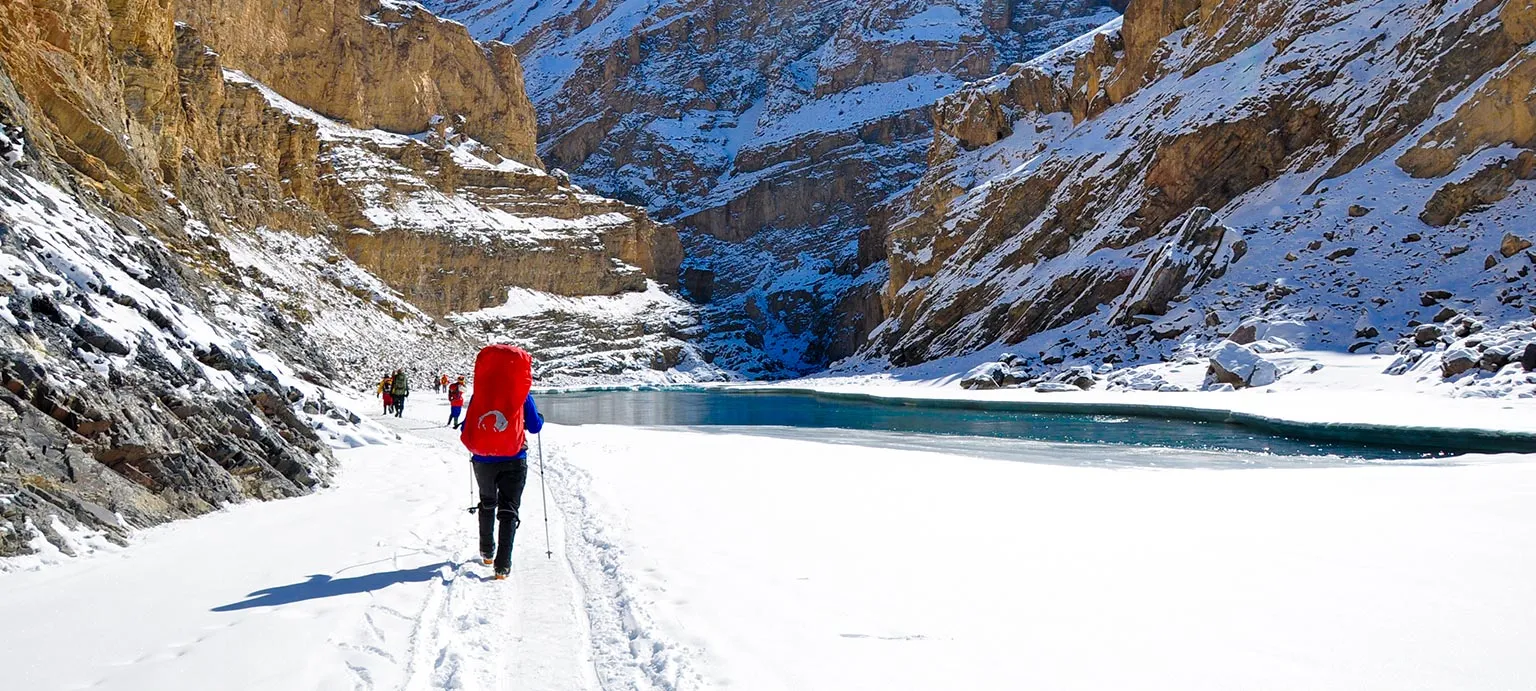
Chadar Trek Frozen River
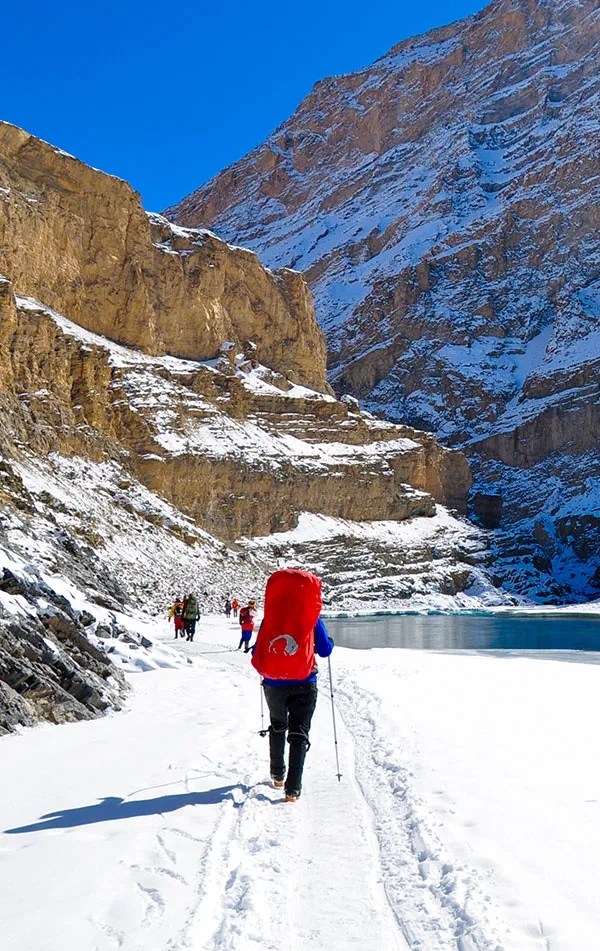
Ladakh | India
Max Altitude
Trekking Km
Help & Support
26500 /person $ /person.
- +5% GST (goods and services tax).
- Services Leh to Leh.
For more information. Please complete this form.
Help & Support
Trek Name: Chadar Trek Frozen River
Adventure Type: Trekking
Base Camp: Leh
Season: Winter |
Month: January | December |
Country: India
Altitude: 11100 Ft.
Grade: Difficult
Rail Head: -
Stay: Hotel & Camping
Food: Meals while on trek
Location: Ladakh
Distance: 62 Km.
Trail Type: Point to point trail | Camping at the same location upon returning.
AirPort: Leh (Kushok Bakula Rimpochee)
Why Chadar Frozen Trek is a Must-Do Trek?
- The Chadar Frozen Trek is renowned as one of the world's most iconic and challenging treks, offering a unique and extraordinary experience for adventurers.
- Takes trekkers through the starkly beautiful and remote landscapes of Ladakh, providing an opportunity to witness the untouched beauty of the region.
- Trekkers traverse the frozen Zanskar River, experiencing the thrill of walking on a solid ice sheet, transforming the river into a surreal frozen wonderland.
- Trekkers face extreme winter temperatures, with the mercury often plummeting well below freezing, reaching as low as -30°C (-22°F) during the night. This challenging environment adds an element of resilience to the trek.
- Provides an incredible cultural experience as trekkers pass through the remote villages and interact with the local communities along the frozen river.
- Highlights the awe-inspiring Nerak Waterfall, a significant milestone on the trek. The frozen cascade of ice is formed due to the chilling temperatures, creating a mesmerizing natural wonder.
- Features the Tibb Cave, a naturally formed overhang along the frozen river cliffs. This cave serves as a crucial shelter for trekkers, offering respite from the biting cold, wind, and a place to rest, warm up, and prepare meals.
- The trek is only possible during the frozen winter months, making it an exclusive and limited-access adventure that adds to its allure.
- For those seeking a rare and challenging experience in the Himalayas, the Chadar Trek is considered the ultimate choice, providing a blend of natural beauty, cultural immersion, and physical challenge.
The Chadar Frozen Trek , located in the northernmost part of India in the region of Ladakh, is one of the world's most iconic and challenging treks. The trek takes adventurers on an extraordinary journey along the frozen Zanskar River offering a unique opportunity to explore the starkly beautiful and remote landscapes of Ladakh, complete with breathtaking ice formations and an incredible cultural experience.
The Chadar Trek takes place in the Zanskar region of Ladakh, India. The trek begins near the village of Chilling and extends through the frozen Zanskar River. The Chadar Frozen Trek occurs during the coldest months of the year, typically from January to February when the Zanskar River freezes over. This is the only time when it's possible to undertake this unique adventure. Winter temperatures in the Zanskar region can plummet well below freezing, often reaching as low as -30°C (-22°F) during the night.
For those seeking a rare and challenging experience in the Himalayas, Chadar Trek is the ultimate choice.
Frozen Landscape
The trek takes you through a surreal frozen wonderland, where the Zanskar River transforms into a solid ice sheet. Trekking on the Chadar , or frozen riverbed, is a remarkable experience.
Nerak Waterfall
Nerak Waterfall, often referred to as Nerak Waterfall Camp, is a significant milestone on the Chadar Frozen Trek . This awe-inspiring site is a cascade of frozen ice that has formed as a result of the chilling temperatures in the Zanskar region.
Tibb Cave is another remarkable feature along the Chadar Trek . It's a naturally formed overhang in the rocky cliffs along the frozen river. This natural shelter provides trekkers with a respite from the biting cold and wind, offering a place to rest, warm up, and even prepare meals.
- Who can Participate
- Important Links
- How to Reach
- Trek Essential
Who Can Participate
- Age; 12 years +.
- First timers can apply; previous trekking experience is more appreciated.
- The climber must be fit and have sufficient stamina to cover 5 km of distance in 35 minutes without stress.
- The climber should be able to carry a 10-15 kg backpack.
Reporting day at Leh
- Altitude: Leh 3,500 m/ 11,500 ft.
- Keep your woolen cap and gloves handy at the Airport.
- Airport pickup is not included in the cost.
- Orientation & Briefing of the trek at 12:00 noon (Mandatory).
- Check-in Hotel 10:00 am | Centrally heated room | Attached washroom in running condition | Hot water in buckets.
- Bring a copy of your ID proof and 2 photographs. Foreigner, a copy of passport and visa.
- Keep the boarding pass with you, it will be needed for permission on the third day.
- The network is available (only post-paid).
- ATM is available.
- Visiting any very high-altitude place or pass is not advisable.
- Consumption of alcohol and smoking is strictly prohibited.
- Spend the day in the room itself to acclimatize.
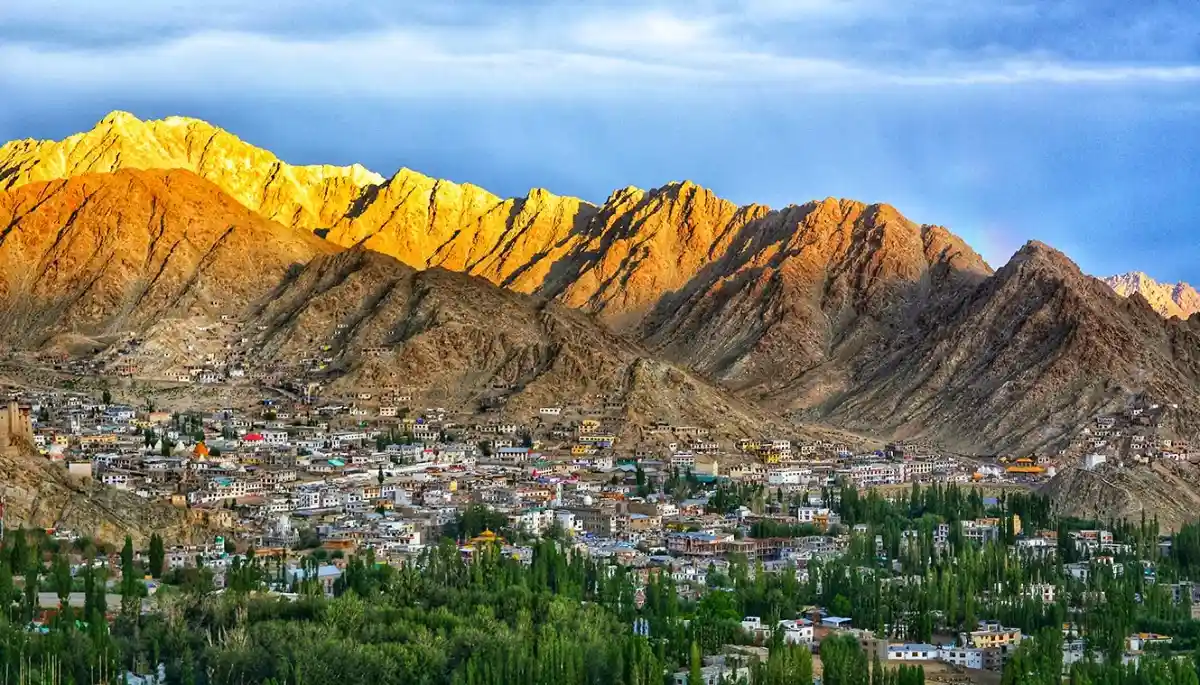
You will be landing at the Leh airport which is one of the most picturesque airports that you will come across. Just before touchdown time, you'll be greeted with the entire range of snow-capped peaks that will surely get you wonderstruck. It's important to keep your warmies handy as you'll feel the sudden drop in temperature as soon as you arrive at Leh airport. A jacket, woolen gloves, and a woolen cap is a necessity. After reaching the guesthouse you will be given enough time to relax and acclimatize to the conditions. Later in the evening, you can spend some time at the Leh market for last-minute window shopping. It is very important that you get used to the cold temperature in Leh because the temperature will only tend to fall as you start walking on the frozen Zanskar. From the end of January to mid-February, the temperature can be anything between -10 to -15 degrees during the day. It is also important to keep your body hydrated by increasing the intake of fluids that will help to maintain your body temperature.
Acclimatization Day
- Rest + Acclimatisation day.
- Sightseeing included in the cost (Hall of Fame, Shey Monastery, Thiksey Monastery).
- Visit of any very high altitude place or pass is not advisable.
- Stay in Hotel | centrally heated room |attached wash room in running condition | hot water in buckets.
Keeping in mind the health problems that trekkers are facing (AMS), as per the new regulations applied, anyone doing the Chadar Trek should be atleast spending two days in Leh to get your body fully acclimatize to the weather conditions. It is irrevocable and it is important that it is strictly followed by every trekker. You can spend the day by visiting the places around the city. You can also join us while we conduct a small sight seeing session(included in the cost). It is only for 3-4 hours, covering all the major spots of Leh. It is advisable that you avoid visiting places which are at a higher altitude. Crosscheck your essentials before going to bed.
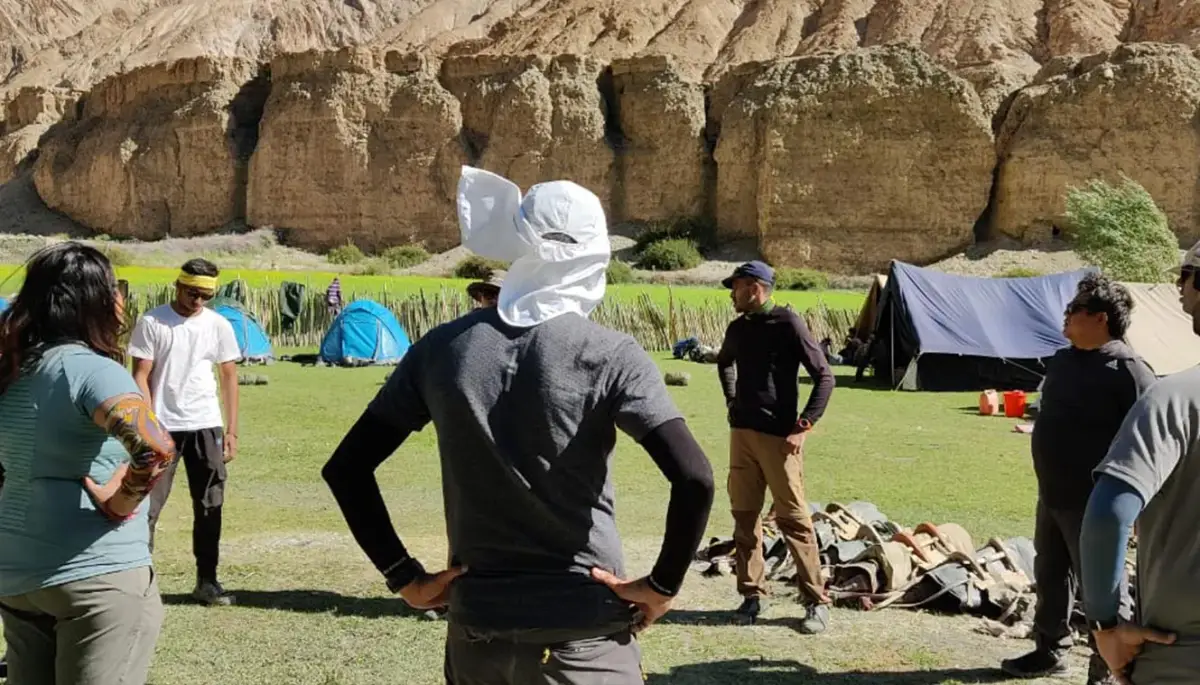
Medical test day
- Wake up early and get ready for medical tests | height & weight, blood pressure and oxygen level.
- Drive/Walk to the Government Medical camp.
- Get your Oxygen and BP reading (There is a long queue due to rush of tourists. It may take 3-4 hours depending on the rush).
- Late afternoon insurance formalities.
- Enjoy evening in Leh.
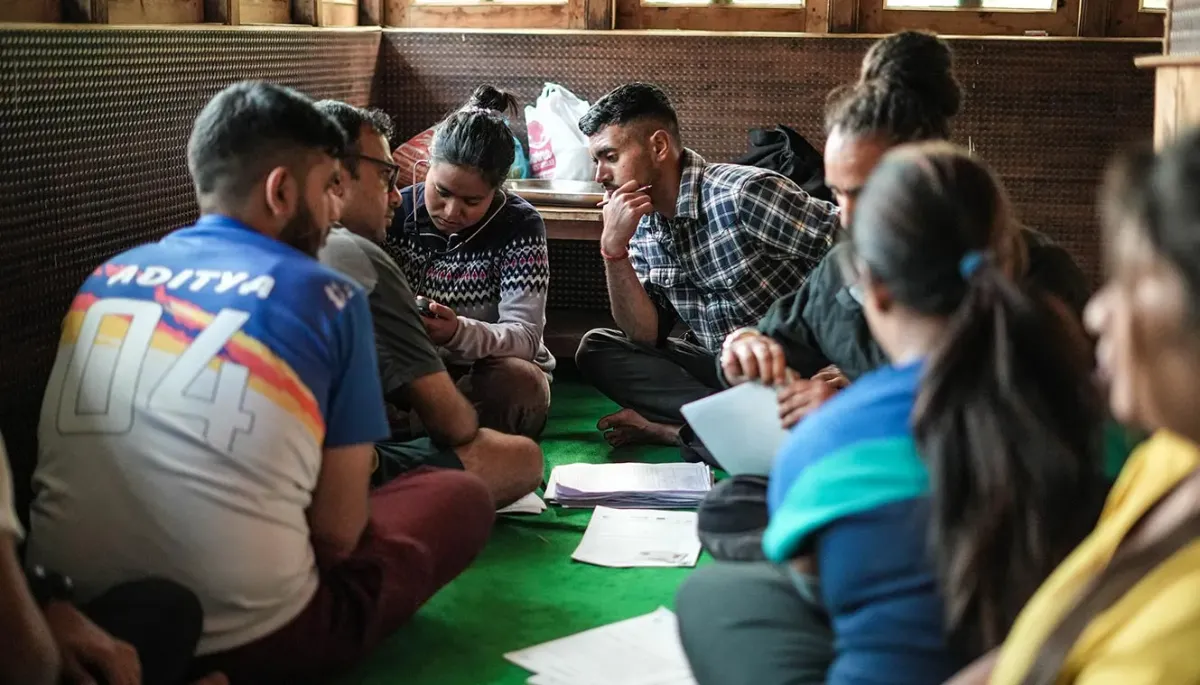
Note: Walking in gumboots will take a while, so be prepared for some slips and falls! It’s advisable to carry a small backpack which will protect your back at the time of falls.
On this day, you'll be headed to the first campsite which is Tsomo Paldar via Chilling & Shingra Koma. Shingra Koma is the most unique place of Chadar for it is placed at U bend of Zanskar. Forming a wonderful place with lots of views. Today will be one of the most scenic drives which lets you witness some of the top spots in Ladakh. Gurudwara Pathar Sahib, Magnetic Hill and the confluence of the Zanskar and Indus are some of the places where you can take a pit stop for clicking pictures. After 3-4 hours drive along the Zanskar will get you to Shingra Koma. The car will drop you right where the road ends, this will be your starting point of walking on the Zanskar.
The layer of Chadar may seem thin here, but you can also see various rock formations. Walking with gumboots on will definitely be a challenge in the initial stage. Understanding the ice patterns will take time, slowly but steadily you will know which surface is fragile and which is trustworthy. There are multiple ice surfaces that you would come across while walking on the mighty Zanskar and as you start walking you will know more about it. Planting your foot will be important in most cases, you can check for the ice for its steadiness with your walking stick before stepping on it wholeheartedly. A small and light backpack will help as you will able to manage your body weight in an effective manner. After an hour and a half of slipping, falling and trying to gather your balance you'll be reaching your first campsite at Tsomo Paldar. This will be your first experience of camping under sub-zero temperatures.
Tsomo Paldar to Tibb Cave
- Altitude: 3,350m/ 10,950 ft.
- Trek Distance: 14 km | 6-7hr.
- Make sure you fill your thermos with warm water before you leave.
- Pass through a waterfall which never freeze.
- It will be sunny only around 9-10 in the morning.
- Hot Lunch on the way.
- Visit small cave, in that cave the local porters rest for the night.
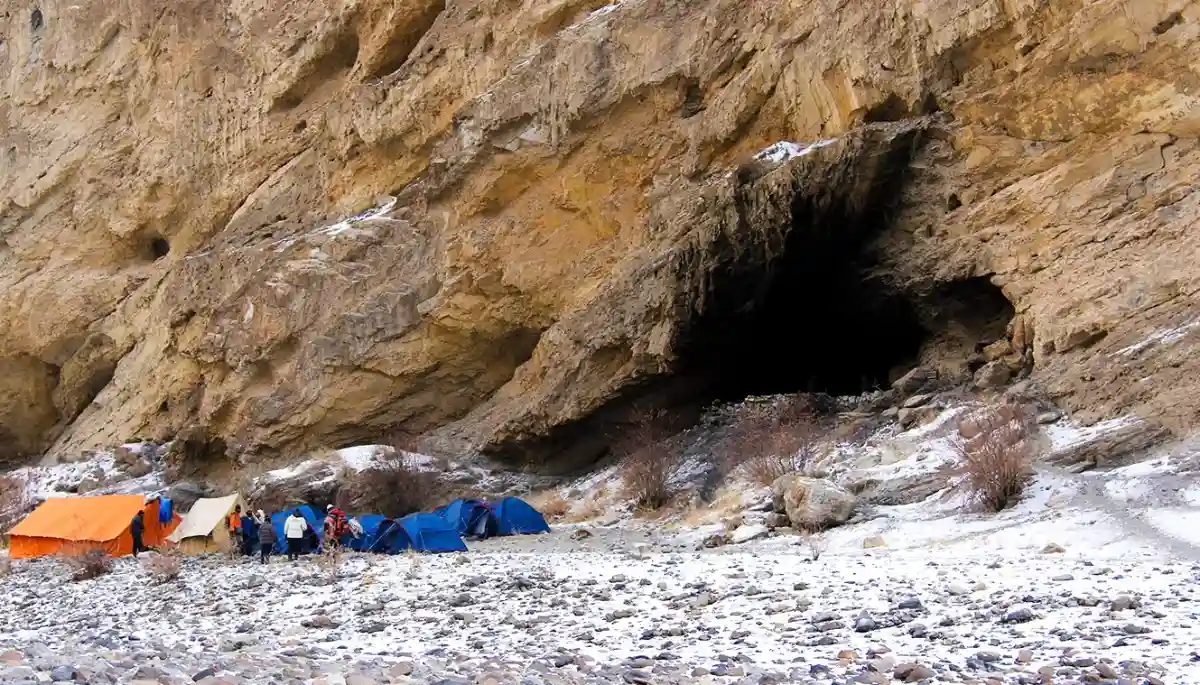
Chadar is one such trek where you are not gaining altitude in quick succession. Slowly but gradually from Tsomo Paldar to Tibb Cave (6-7 hours), you will be gaining an altitude of 400ft. (Tsomo Paldar: 11,400 to Tibb Cave: 11,800) After spending a cold night in the tent at Tsomo Paldar get done with you breakfast that will re-energize your senses in the morning. The much-needed hot cup of tea will be special in such frosty conditions. As you start heading to the next campsite which is Tibb Cave, this trek route has some of the most eye-catching frozen waterfalls that youll see. Waterfalls that stand frozen in time. The source of some of these frozen waterfalls is still unknown and there are a lot of myths amongst the villagers. The mighty Zanskar will be flowing all along with you on the trail and the emerald green water will have a smooth soothing You will be served lunch midway to Tibb cave. After walking for a couple of hours you'll come across different rock patterns along the way which look like art looks when the sun rays fall on them making their way from behind the clouds. You will be camping near the Tibb cave which is surrounded by dry sand.
Tibb Cave to Nerak
- Altitude: 3,400 m / 11,100 ft.
- Trek Distance: 13 km | 6-7 hrs.
- Attraction Frozen waterfall.
- Nerak is the first village of the Zanskar region.
- If we reach Nerak Camp on time, we can go to Nerak village.
- Stay in a tent.
As you move on to the most awaited campsite of the trek which is Nerak, the 13km long trail will take you to the most iconic landmark of the Chadar trek. i.e. The frozen waterfall. The frozen waterfall is a nature masterpiece that attracts trekkers from around the world. Hot lunch will be served on your way to Nerak. By far, Nerak will be the coldest of all the campsites on the trek where the temperature goes down to as low as -30 degrees during the night. It will be important that you wear proper clothing in layers to stay safe from the biting cold. If you manage to reach the waterfall on time, there are chances of paying a visit to the Nerak Village as well. You will be camping at a distance of 15-20 minutes from the waterfall.
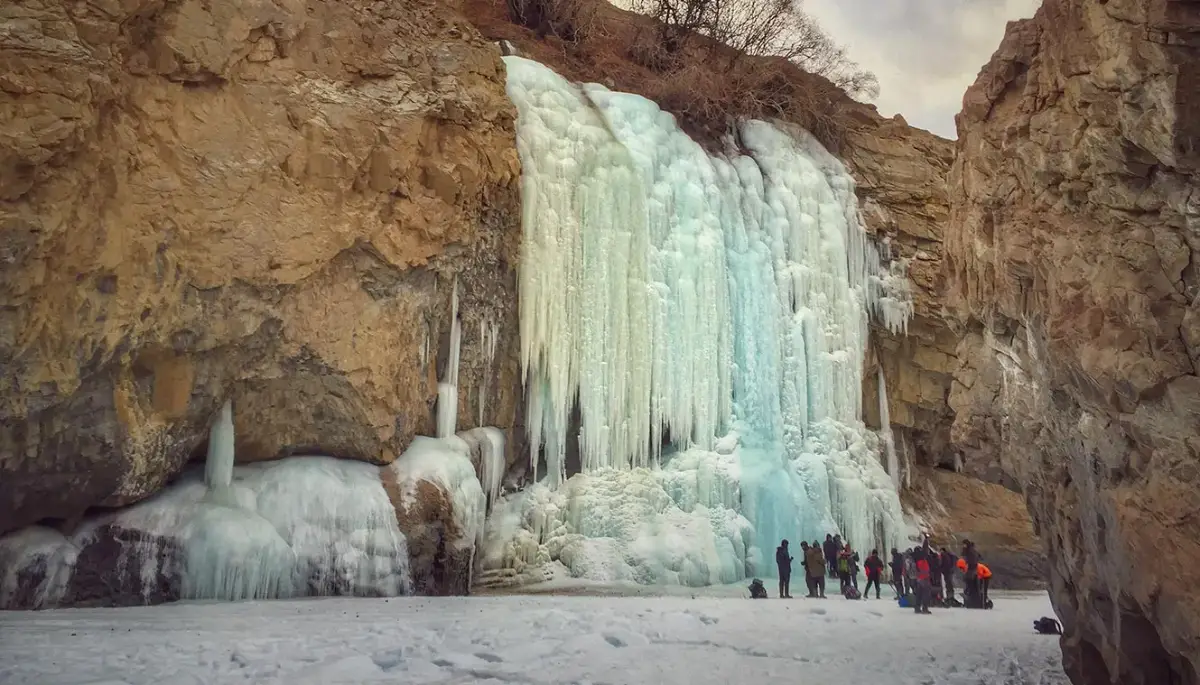
Nerak – Tibb Cave
- Altitude: Nerak- 3,400 m/ 11,100 ft | Tibb cave- 3,350 m/ 10,950 ft.
- Trek Distance: 3 km / 5-6 hrs.
You might have heard stories of how unpredictable the weather patterns can get here on the Chadar trek. There are instances where the formation of Chadar no longer exists on your way back from Nerak. In the same way, you will witness a new layer of Chadar formed at some. Even though it's the same route, you'll be amazed to see how different it appears while coming back. Chadar Trek is the experience of a lifetime that every trekking enthusiast should witness. And then, what if we told you that these eight days of your life are going to be some of the best days youve lived so far and that youll cherish these moments till the very end.
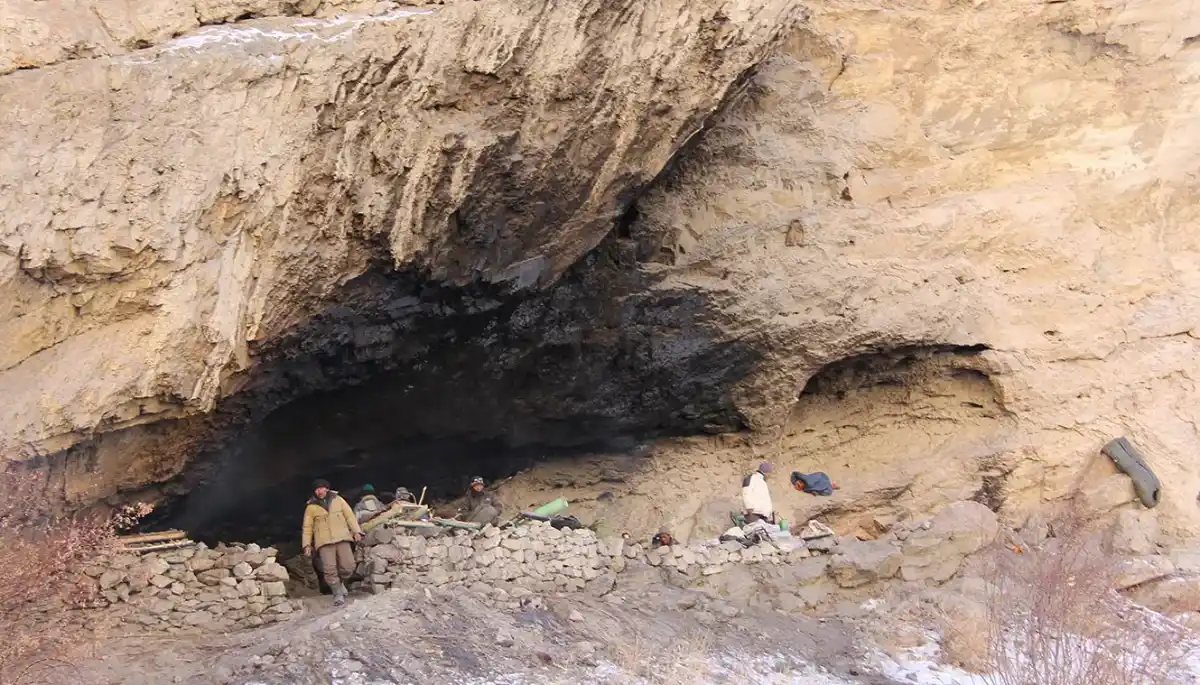
Today retrace your steps back to Tibb Cave. You get another last chance to cherish, relive, and gather the memories. Wave goodbye to all the locals while you make your way back. Be careful and enjoy your last stay in tents.
Tibb Cave to Shingra Koma then Drive to Leh
- Altitude: Tibb cave- 3,350 m/ 10,950 ft | Shingra Koma- 3,150 m/ 10,300 ft.
- Trek to Shingra Koma : 17 km | 5-6 hours.
- Drive to Leh: 70 km | 3-4 hours.
- You will reach Leh by the evening.
- Stay in a hotel (Centrally heated room) (Running hot water in taps).
Again wake up early for a long walk back. It is not retracing steps because you may observe a lot has changed. Chadar may have melted, a layer of Chadar may have gotten thin, and wonderful rocks are visible now. We all, know the beauty of nature and the Chadar trek. Reach Shingra Koma and get ready to board on vehicles. Another bumpy ride and you will arrive in Leh.
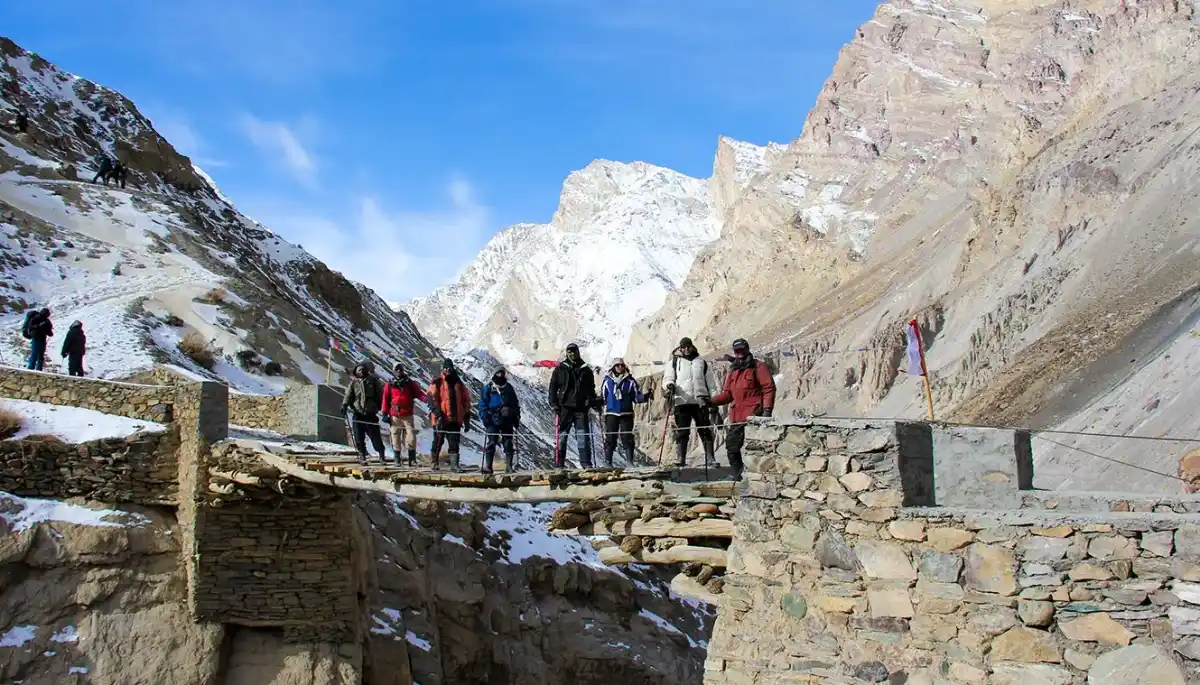
- Keep 1 or 2 buffer days in your travel plan.
- If buffer day is not used in the travel then it can be used to Explore Leh.
- Distance, Altitude, and Trekking hours are approximate and rounded off.
- Keep the original and copy of ID proof handy.
- Come one day early if planning to come by plane.
Day-1: Reporting day at Leh
Day-2: acclimatization day, day-3: medical test day.
- Wake up early and get ready for medical tests.
Day-4: Leh to Shingra Koma drive & Trek to Tsomo Paldar
Day-5: tsomo paldar to tibb cave.
- Altitude: 3,350 m/ 10,950 ft.
Day-6: Tibb Cave to Nerak
- Altitude: 3,400 m/ 11,100 ft.
Day-7: Nerak – Tibb Cave
- Trek Distance: 3 km | 5-6 hrs.
Day-8: Tibb Cave to Shingra Koma then Drive to Leh
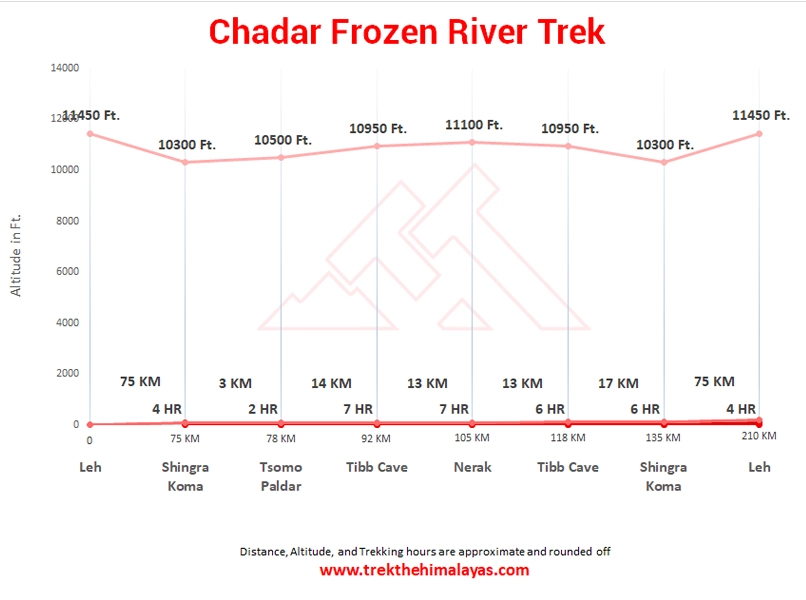
Pulse rate at rest must be in between (60 to 90 beats per minute).
Blood Pressure Reading must be in between (DIASTOLIC 70 – 90, SYSTOLIC 100 - 140 mm Hg).
Respiratory rate at rest must be in between (12 to 20 breaths per minute).
Should not have Liver and kidney issues.
Should not have Diabetes Mellitus, Bronchial Asthma, Heart problems, Hypertension, etc.
No pacemaker implant.
People with Sinus issues, Epilepsy please contact to trek coordinator before booking the trek.
If your BMI is not normal, Please contact our Trek coordinator before Trek booking.
Medical & Disclaimer Form (Mandatory Documents) Click here to download Medical & Disclaimer Form
- Government Employees can avail the benefit of Special Casual Leave (SCL) when they join us for a trekking expedition. As per the rules of the Pay Commission, Special Casual Leave can be availed for up to 30 days in a calendar year for trekking/mountaineering expeditions through a registered organization. Trek The Himalayas is a registered adventure tour operator by the Indian Mountaineering Foundation (IMF) and the Ministry Of Tourism (MOT).
- Trekkers have to apply for leave at least 20 days before the trek departure date.
- This service is exclusive to Indian government employees and is applicable only for treks within India.
- Do mail at info@trekthehimalayas to apply and mention your booked trek date and trek name.
Junior trekkers (below 15 years) should have a company of parents/guardians.
Trekkers between 15 to 18 years can come solo with the disclaimer form signed by parent/guardian.
- Medical & Disclaimer Form (Mandatory Documents) Click here to download Medical & Disclaimer Form
Exercise For Difficult
Fitness Regime For:
Calculate Your Bmi
Your BMI value is
Congratulations, your body is in good conditions!
Medical & Disclaimer Form (Mandatory Documents) Click Here.
How To Reach
It is essential for everyone to arrive at Leh (01:00 pm)
The only way to travel is to fly to Kushok Bakula Rimpochi Airport located in Leh. It is just 4 km away from the main city. The airport is well connected to Delhi and also receives flights from Mumbai, Srinagar, Jammu, Chandigarh and other general destinations in India. Even international travellers can fly directly from major cities like Kolkata, Mumbai and Delhi.
It's quite convenient to secure a cab from outside the airport to reach our hotel. Alternatively, you can inform your coordinator to arrange a cab for you. Upon booking the trek, your trek coordinator will furnish you with the hotel details.
Travelling by both the road routes, the Manali-Leh Highway and Srinagar-Leh Highway, is not possible since they are not open in the snowy winters of Ladakh.
The Manali-Leh and Srinagar-Leh highways are generally closed by October-November
For your return journey from Leh , you have to choose only air transport options. Please ensure an early check-out in the morning, as all flights operate during the morning hours.
It's highly advisable to keep 2 buffer day in your travel plan. If the buffer day is not needed, it can be used to explore Leh.
.webp)
1. Accommodation (as per the itinerary):
- Guest house (centrally heated room)(attached washroom) in Leh on Day 1, Day 2, Day 3 & Day 8 (twin sharing basis, triple in very rare cases).
- Camping during the trek (Day 4 to Day 7).
2. Meals (Veg + Egg):
- All meals while on trek. .
- Day 4 breakfast to day 8 lunch.
3. Support:
- 1 Versatile base camp manager handles communication and deploys extra manpower in emergencies.
- 1 Mountaineering & First aid qualified professional expedition leader.
- 1 Experienced high altitude chef.
- Local experienced guides (Number of guides depending on the group size).
- Enough support staff.
4. Trek equipment:
- Sleeping bag, Sleeping liners (if required), Mattress, Utensils.
- 3 men all season trekker tent (twin sharing), Kitchen & Dining tent, Toilet tent.
- Camping stool, Walkie talkie.
- Ropes, Helmet, Ice axe, Harness, Gaiters & crampons (if required).
5. First aid:
- Medical kit, Stretcher, Oxygen cylinder, Blood pressure monitor, Oximeter, Stethoscope.
6. Transportation (as per the itinerary):
- Leh (Guest house) to trekking point (Day 4).
- Trekking point to Leh (guest house) (Day 8).
7. Clock room service at Leh. 8. Mules/porters to carry the central luggage. 9. All necessary permits and entry fees, up to the amount charged for Indian. 10. Services from Leh to Leh.
1. Food in Leh. 2. Insurance (Mandatory). 3. Any kind of personal expenses. 4. Pick up and drop from Leh airport. 5. Mule or porter to carry personal luggage. 6. Emergency evacuation, hospitalization charge, etc. 7. Anything not specifically mentioned under the head Inclusion. 8. Any additional cost due to the final decision incurred by the Administrative. 9. Pre Medical Check-up and Rescue fee, Wildlife/environmental charges, ALTOA NOC, and entry fees up to 6K to 8 K paid to the authority on the spot.
Things can be provided on demand and availability (participant has to pay extra for these things).
1- Gamow/PAC HAPO Bag (Portable Hyperbaric Bag) - is a unique, portable hyperbaric chamber for the treatment of acute mountain sickness (AMS), also known as altitude sickness.
2- AEDs (Automated External Defibrillators) - are portable life-saving devices designed to treat people experiencing sudden cardiac arrest, a medical condition in which the heart stops beating suddenly and unexpectedly.
Cancellation terms:
Cancellations prior to 25 days from the start of the Trip
Refund options
- 5% deduction of trek fee
- 100% cash voucher for any trip till one year
- Transfer your trek (any trek, any date) to your friend
Cancellation between 24 days and 15 days to the start of the Trip
- 30% deduction of trek fee
- 100% cash voucher for same trip till one year
- 85% cash voucher for any trip till one year
- Transfer your trek (same trek, any date) to your friend
Cancellation between 14 days and 10 days to the start of the Trip
- 50% deduction of trek fee
- 80% cash voucher for same trip till one year
- 70% cash voucher for any trip till one year
- Book the same trek, in the same season, with any other batch
Cancellation less than 9 days to the start of the trek
- No cash refund
- 20% cash voucher for the same trip till one year
- 10% cash voucher for any trip till one year
- Transfer your trek (same trek, same date) to your friend
Note- If a booking is made using a voucher or discount code, the policies related to vouchers and discounts cannot be modified.
In the unlikely event that TTH cancels a trek prior to the scheduled departure date:
While it is extremely rare for TTH to cancel a trek, we understand that unforeseen circumstances or natural disasters may occasionally require us to do so before the scheduled departure. These circumstances could include continuous rain or snow, thunderstorms, snowstorms, landslides, floods, earthquakes, or any other natural calamity that poses a risk to the safety of our trekkers. Additionally, unforeseeable events such as local riots, curfews, pandemics, lockdowns, government orders, or any similar situations that compromise the safety of the trekking experience may also necessitate a cancellation.
In the event of such a cancellation, TTH will provide you with a voucher equivalent to the amount you paid for the trek. This voucher can be redeemed for any of our treks within the next year, allowing you to still enjoy an adventure with us at a later date.
The issuance of a voucher is not applicable in situations where you are required to descend from the trek for any reason. The trek leader may make the decision to send you down from the trek due to factors such as insufficient fitness level, symptoms of Acute Mountain Sickness (AMS), high blood pressure, exceeding the designated turn-around-time, health concerns, or if you are found smoking, drinking, or violating the rules set for the trek. In such cases, the provision of a voucher does not apply.
In the rare event that TTH shifts a trek:
We would like to emphasize that weather conditions in high-altitude areas are highly unpredictable and can undergo sudden changes at any time, irrespective of the day. Additionally, circumstances beyond our control, such as natural disasters, political unrest, pandemics, and lockdowns, may impact the feasibility of conducting a trek. In cases where we are unable to proceed with an event due to such circumstances that are beyond our direct control, we will make every effort to provide you with an alternative trek that is safer and more suitable.
In such situations, we will issue a voucher to offset the cost difference between the originally scheduled trek and the alternative trek. This voucher can be redeemed at any time within one year from the date of issue. Please note that a refund fee or reimbursement of the cost difference is not applicable in these cases.
- Change of trek batch is dependent on the availability of seats in the batch
- In case of transferring a trek to a friend, he/she should satisfy all the mandatory requirements put forward by TTH
- TTH holds the right to change/cancel the policies, without prior notice
- Cash refund is applicable only in case of bookings made without using any promotional offer code or vouchers
Cash Voucher Terms:
- This is a non-transferable voucher
- The voucher cannot be merged with any other offer of Trek The Himalayas
- The voucher is valid for Trek booked directly with Trek The Himalayas in India
- To avail the voucher please use your register phone number or e-mail id
- All the other Terms of booking a trek with Trek The Himalayas are applicable to the voucher
- Trek The Himalayas holds rights to add/remove any of the Terms and Conditions without prior notice
Itineraries are based on information available at the time of planning and are subject to change. "Trek The Himalayas" reserves the right to change expedition dates, people or itineraries as conditions warrant. If a trip must be delayed or the itinerary changed due to bad weather, road conditions, transportation delays, government intervention, airline schedules, sickness, or other contingency for which TTH or its agents cannot make provision, the cost of delays and/or other changes are the responsibility of the participant. TTH reserves the right to decline, or accept, any individual as a trip member for any reason whatsoever.
Trek Essentials
PDF Of Trek Essential Download
Frequently Asked Questions(FAQ)
How to register/create an account with tth.
To register with TTH, visit our website - www.trekthehimalayas.com and create your account. To create your account you will need to use your email address and fill in all the details, set your unique password and your account is ready to use.
How to book a trek?
- To book a trek with TTH, you first need to register with us and create an account.
- Choose the trek that you want to do and click on available dates.
- You will land at the login page, fill in the required details.
- Add Participants, choose add-on services click on the Pay now button, choose your preferred payment method, and make the payment. TTH accepts multiple payment options, including credit/debit cards, net banking, and UPI.
- You will receive a confirmation email from TTH with all the necessary details about the trek, including the meeting point, transportation, accommodation, and other important instructions.
Made a payment but did not receive any confirmation.
please send an email to us at [email protected] or reach out to the numbers provided in the Help and Support section of your Trek Page. We will ensure that your issue is promptly resolved.
How to book off-load luggage and transportation?
To book services such as off-load luggage and transportation, you can find them listed as add-ons. These additional services can be booked at the time of your initial booking. If you miss booking add-ons during the initial reservation, you can log in anytime and easily book 4 days before the departure date add-ons through the platform.
If I have booked the wrong trek or date, how can I make changes?
In such a situation, please log in to your account and transfer your trek or date to the desired one within 12 hours or drop us an email at [email protected] 10 days before the departure date of the trek. After the initial 12-hour period, any changes will be processed according to the cancellation policy.
I am a beginner and confused which trek to book.
We recommend visiting our "Suggest Me a Trek" page. By filling out the form, our experts will contact you with the best possible trek options based on your preferences and experience level. Alternatively, you can reach out to us via email at [email protected] or give us a call using the numbers provided on our website for personalized assistance and recommendations.
How is family trek different from regular trek?
Family treks differ from regular treks by focusing on ease of difficulty, offering shorter durations for younger participants, Kid-friendly and easily digestible foods, child-friendly activities, maintaining a higher guide ratio for diverse age groups, and implementing additional safety measures for families.
Ideal treks for children.
Family Trek with Kids recommendation Only Dayara Bugyal and Chopta Chandrashila Trek.
Minimum age for children to trek with TTH.
Minimum age for TTH treks is typically 7 years, though this may vary depending on the specific trek.
Can we take children to high altitudes with their guardian?
Yes, you can take a kids to a high-altitude trek with a parent. Discuss with a trek expert before booking a trek.
Can we send kids without Parents/guardian?
Medical & Disclaimer Form (Mandatory Documents) Click here to download medical and disclaimer form
How to prepare a child for a high altitude trek?
Physical Fitness: Ensure your child is physically fit. Engage them in regular exercise, outdoor activities, and hikes to build stamina and endurance. Hydration: Emphasize the importance of staying hydrated at high altitudes. Encourage your child to drink water regularly, even if they don't feel thirsty. Proper Nutrition: Provide a well-balanced diet with sufficient carbohydrates for energy and foods rich in iron to prevent altitude sickness. Adequate Sleep: Ensure your child gets enough sleep in the days leading up to the trek. Quality rest is crucial for altitude adaptation. Educate on Altitude Sickness: Teach your child about the symptoms of altitude sickness, such as headache, nausea, and dizziness. Encourage them to communicate any discomfort immediately. Appropriate Clothing and Gear: Dress your child in layers to adjust to changing temperatures. Ensure they have appropriate trekking gear, including sturdy footwear. Positive Mindset: Foster a positive mindset. Encourage your child, and let them know it's okay to take breaks when needed. Medical Check-Up: Schedule a medical check-up before the trek to ensure your child is fit for high-altitude activities. Consult with a healthcare professional about any potential health concerns.
Kind of food will be served during the trek for children.
TTH takes special care to provide wholesome and nutritious food for children on treks. Here are some of the foods that are typically served for children: Breakfast: For breakfast, TTH serves a variety of options like porridge, cornflakes, bread, butter, jam, honey, boiled eggs, omelettes, and pancakes. Children can choose from these options to fuel themselves for the day's trek. Lunch: For lunch, TTH serves lunch which includes rotis, vegetables, rice, dal, and salad. The rotis are usually made fresh on the trek and are a good source of carbohydrates. The dal and vegetables provide protein and other essential nutrients. Snacks: TTH provides healthy snacks like fresh fruits, dry fruits, energy bars, cookies, and biscuits to keep the children energized throughout the day. Dinner: For dinner, TTH serves a hot and wholesome meal which includes soup, rice, dal, vegetables, and a non-vegetarian dish (if requested in advance). Children can also choose from a variety of desserts like custard, jelly, and fruit salad. Dietary requirements: If a child has any special dietary requirements, TTH can cater to those needs as well. For example, if a child is lactose intolerant or allergic to nuts, the kitchen staff can make arrangements to accommodate those requirements.
How to choose the right trek?
Choosing the right trek for a beginner can be a bit overwhelming as there are many factors to consider such as distance, elevation gain, terrain difficulty, weather, and time of year. Here are some tips that can help you choose the right trek for a beginner:
1. Determine fitness level: Assess the fitness level of the beginner to understand their physical capabilities. This will help you select a trek that is challenging but not too difficult.
2. Choose a well-traveled trail: A well-traveled trail will have more amenities such as signposts, water stations, and shelter. It is also safer as there will be other hikers on the trail.
3. Consider the length of the trek: For beginners, it is recommended to start with a shorter trek that can be completed in a day or two. This will help them get acclimatized to trekking and build their confidence.
4. Look for gradual elevation gain: Choose a trek with a gradual elevation gain rather than steep ascents. This will make the trek easier and more enjoyable.
5. Check the weather: Check the weather forecast before selecting a trek. Avoid treks during the monsoon season or winter when the trails can be slippery or dangerous.
6. Research the trail: Read about the trail to get an idea of the terrain, altitude, and difficulty level. This will help you select a trek that is suitable for the beginner.
7. Consult with an expert: If you are unsure about which trek to choose, consult our trek expert Mr. Nitin (+91 70600 59773) between 10 AM to 6 PM (Tuesday - Friday). Mr. Nitin will provide you valuable advice and guidance.
Overall, it is important to choose a trek that is enjoyable, challenging but not too difficult, and suitable for the beginner's fitness level and experience.
Can a beginner choose a tough trek?
It is not recommended for a beginner to choose a difficult Himalayan trek. Trekking in the Himalayas can be physically and mentally challenging, especially if you are not used to the high altitude, steep slopes, and rugged terrain. Choosing a difficult trek without the proper experience, fitness level, and preparation can be dangerous and put you at risk of altitude sickness, injury, and other hazards.
If you are a beginner, it is recommended to start with an easier trek and gradually build up your skills and experience. This will help you understand the challenges of trekking in the Himalayas, and also prepare you physically and mentally for a more difficult trek in the future. It is also important to choose a trek that matches your fitness level, experience, and interest.

What is the age limit for a beginner trekker?
There is no specific age limit for a beginner trekker. However, it is important to consider your physical fitness, health condition, and personal interests before embarking on a trek. Trekking in the Himalayas can be physically and mentally demanding, and requires a certain level of physical fitness and endurance.
If you have any pre-existing medical conditions or are above a certain age, it is recommended to consult with a doctor before embarking on a trek. It is also important to listen to your body and take breaks as needed during the trek to prevent exhaustion or injury.
If I am solo, can I join the trek in a group?
Yes, you can join the trek. We have fixed departure groups where you can simply book your trek and we will take care of curating a group.
How does my family get updated about my Trek?
Before you start the trek, it is recommended that you make all the necessary phone calls as during the trek you may or may not receive network coverage, once you come back to the Base Camp, you can reconnect with your family via phone once again. You can share your trek coordinator contact detail with your family members to get the latest updates about your trek batch.
What food can I expect?
At TTH, we provide wholesome and nutritious meals during the trek. The food is vegetarian and includes a variety of dishes such as rice, dal, vegetables, chapati, paratha, pasta, noodles, and soup. We also offer snacks such as biscuits, and salty, and dry fruits during the trek. Special dietary requirements such as vegan, gluten-free, or Jain food can also be arranged if informed in advance.
I am allergic to some foods.
If you are allergic to some foods, you need to let us know in advance so that we can make arrangements accordingly.
How safe is trekking with TTH?
TTH is a trekking company that prioritizes the safety of all its participants, including women trekkers. They have a comprehensive safety system in place, which includes a dedicated team of experienced and trained trek leaders and support staff who are equipped to handle emergency situations and provide first aid.
TTH also takes specific measures to ensure the safety and comfort of women trekkers. They have a separate tent accommodation for women trekkers, female trek leaders, and support staff. They also provide separate toilet facilities for women and encourage a safe and respectful environment for all trekkers.
Moreover, TTH has a strict policy against any kind of harassment and has a zero-tolerance policy towards such incidents. They have a designated Internal Complaints Committee (ICC) to investigate and address any complaints related to harassment or misconduct. Overall, TTH has a good reputation for safety and responsible trekking practices, and women can feel comfortable and safe while trekking with them.
How TTH will manage if I am the only woman in the group?
In case you are the only women in the group, we provide a single sleeping arrangement. Also, during the trek, the trek leader will always remain by your side to provide optimum safety and reassurance.
How can I know that other women are in the batch?
You can reach out to the trek coordinator to inquire about the number of female trekkers and their respective states who have booked the trek. Please note that the trek coordinator cannot disclose personal details of any trekker. Once you've confirmed your booking, a WhatsApp Group will be created for all the trekkers in your batch. This allows you to connect with fellow trekkers before the trek begins.
Can I know in advance, which trek is led by a women Trek Leader?
While many of our treks are led by female trek leaders, however, it is not possible to know which trek leader is assigned to which group. But nonetheless, whether the trek leader is male or female you can be completely assured of your safety and security with us.
Can I trek with periods? If yes, then where can I dispose of the sanitary pad?
Yes, it is possible to trek with periods. However, it is important to take some extra precautions and preparations to ensure a comfortable and safe trekking experience.
Here are some tips that can help you trek during your period:
1. Use menstrual hygiene products that you are comfortable with, such as tampons, pads, or menstrual cups. It is recommended to carry enough supplies for the entire duration of the trek.
2. Pack wet wipes, hand sanitizer, and plastic bags to dispose of used hygiene products.
3. Wear comfortable and breathable clothing that allows for easy movement and reduces friction. Avoid wearing tight or restrictive clothing that can cause discomfort.
4. Carry pain relief medication, such as ibuprofen or acetaminophen, in case of menstrual cramps.
5. Stay hydrated and maintain a balanced diet to support your energy levels and overall health.
6. Take breaks as needed and listen to your body. If you feel uncomfortable or experience any unusual symptoms, seek medical attention immediately.
It is also recommended to consult with a doctor before going on a trek during your period, especially if you have a pre-existing medical condition or are taking medication. By taking necessary precautions and being prepared, you can have a safe and comfortable trekking experience even during your period.
We provide proper disposal facilities for sanitary pad disposal during the trek.
How will the accommodation be during the trek?
We offer three person tents with twin-sharing for optimum comfort. A woman trekker will share a tent with another woman trekker and if you are the only woman in the group, you will be given a single accommodation for your comfort and privacy.
Are trek poles, Jackets and other equipment available for rent from Trek The Himalayas?
Yes, we do provide gears on rent. You can book it using you TTH account directly.
Who will be with us on the trek from Trek The Himalayas?
Mountaineering qualified Experienced and first aid certified Trek Leader, First Aid Certify local guide, Cook, helpers and supporting staff.
Who can not join the trek?
People suffering from Bronchitis, Asthma, High blood pressure, Epilepsy (got faints), TB , Heart problem or on higher BMI side are strictly not allowed to go on any Himalayan trek. Apart from this if you had any medical history, please let us know.
When it gets really cold can I consume alcohol?
No. Alcohol and smocking isn’t allowed while on trek. It is totally misconception that it will keep you warm. Your body need to acclimatize properly and for that eat properly and drink enough water; these things will keep you warm.
What type of toilet facility is TTH providing at the trek?
Toilet tents provide a convenient solution for answering nature's call in the great outdoors. Dry toilets, in particular, offer a highly sanitary approach. By digging a pit and utilizing mud and a shovel, you can easily cover up your waste. This method ensures cleanliness and hygiene while camping or exploring in the forest.
Remember to pack essential toiletries to complete your outdoor bathroom kit and maintain proper personal hygiene during your adventures. With these practices in place, you can enjoy nature while also respecting it.
How do I manage the negative temperatures on the trek at higher camps? Do I need special jackets?
Layer Up From Head To Toe Eat Full Meals, never sleep empty stomach You can keep warmee (if you’re more susceptible to cold). Use sleeping bag in right way and don’t leave free space in sleeping bag.
For upper body – Thermal layer – T-shirt (full-sleeves) – Fleece T-shirt (for extreme colds) – Fleece layer – Thick Jacket/Down Jacket – Waterproof or Windproof layer (outermost layer, when it is snowing or raining) - For Lower Body – Thermal layer – Hiking pants (normal) or Winter hiking pants
Based on how warm you feel you can skip any of the above layers. Your outer later should be windproof since it is windy at high altitude. The idea behind layering is that the more insulation you have the less cold you feel, and instead of wearing a very thick jacket if you wear multiple layers, your body will be better insulated against the cold.
Do you provide crampon/micro spikes and gaiters?
Yes, we provide micro spikes and gaiters, if required.
What documents need to carry on trek?
Mandatory documents: 2 xerox of ID having address (addhar card/driving license), 2 Passport size photographs, hard copy Medical form signed & sealed by doctor, disclaimer form sign by trekker and high altitude insurance.
If we come prior the trek date, Do you provide accommodation?
No. We don’t but we can suggest you good hotel/Stay nearby pick up location.
Do we get enough water for drinking?
Yes, trekker must carry 2 water bottles 1 litre each so they can refill it at campsite for drinking and keep themselves hydrate.
What kind of shoes we should buy for the trek?
You should buy shoes which has these three features –Good grip, Ankle Support and additional water resistant layers. Generally, we advise Quechua Trek 100, MH 500 and MH 100.
What happens if some members of the team need to turn back before the summit?
No one is forced to go on. There is always enough staff to split the party according to need and regroup later at the camp. Most people have no trouble reaching the highest campsite. If some members decide not to climb the final distance they can wait for the climbers to come back down the same way or take a lateral path to the descent route.
What is Chadar Trek Frozen River?
The Chadar Frozen River Trek is a popular winter trek in the Indian state of Jammu and Kashmir. It involves walking on a frozen river, the Zanskar River, which is transformed into a thick sheet of ice during the winter months. The trek is known for its scenic beauty and challenging terrain, as well as the unique experience of walking on a frozen river.
When is the best time to do the Chadar Trek?
The best time to do Chadar Frozen River Trek is during the months of January and February when the river is frozen enough to support the weight of trekkers.
What is the difficulty level of Chadar Trek Frozen River?
Chadar Trek Frozen River is a Difficult Grade Trek.
What is the duration of the Chadar Trek Frozen River?
It is an 8 days long trek.
Are there any altitude-related concerns on the Chadar Trek?
Yes, altitude-related concerns can be a factor on the Chadar Frozen River Trek . The trek starts at an altitude of around 3,300 meters and reaches a maximum altitude of approximately 3,850 meters . While this may not be extremely high, it is still significant enough to cause altitude-related issues for some trekkers.
Altitude sickness, also known as acute mountain sickness (AMS), is a common concern on the Chadar Trek . Symptoms of AMS can include headache, nausea, dizziness, and shortness of breath. Trekkers can take several precautions to avoid AMS, such as acclimatizing properly, drinking plenty of fluids, and taking necessary medications.
It is also essential to be aware of frostbite and hypothermia, which can occur due to exposure to cold temperatures and wind on the trek. Trekkers should dress in layers, wear proper gear, and stay warm to prevent these conditions.
Overall, while altitude-related concerns are something to keep in mind, with proper preparation and caution, many trekkers are able to successfully complete the Chadar Frozen River Trek without any significant issues..
What kind of gear is needed for the Chadar Trek?
The Chadar Frozen River Trek is a challenging winter trek that requires specialized gear to ensure the safety and comfort of trekkers in extreme cold and icy conditions. Here are some essential gear items needed for the trek:
1. quality trekking boots with sturdy soles and good traction to provide adequate grip on slippery ice.
2. Warm and waterproof clothing, including thermal layers, fleece jackets, and down jackets, to keep you warm in sub-zero temperatures.
3. Waterproof gloves or mittens and socks to keep your hands and feet dry and warm.
4. A warm hat and a balaclava or a face mask to protect your face from the cold winds.
5. Sunglasses to protect your eyes from the glare of snow and ice.
6. Trekking poles to help maintain balance and stability on the icy terrain.
7. Sleeping bags are rated for sub-zero temperatures to ensure a good night's sleep in the extreme cold.
8. Headlamp or flashlight with extra batteries to navigate in the dark.
9. First aid kit including altitude sickness medication, pain relievers, and basic medical supplies.
10. Backpack with at least 60 liters capacity to carry all your gear and supplies.
What kind of food will be provided during the Chadar Trek?
During the Chadar Trek , TTH provides all meals, including breakfast, lunch, and dinner. The meals are prepared by a team of experienced cooks, who use fresh and locally sourced ingredients to provide nutritious and tasty food to the trekkers.
Is it necessary to have the prior trekking experience to do Chadar Trek Frozen River?
While prior trekking experience is not strictly necessary for the Chadar Frozen River Trek , it is highly recommended that trekkers have some level of physical fitness and experience with hiking or trekking in challenging terrain. The trek is considered to be a moderately difficult trek, and the icy conditions can make it even more challenging.
It is important to note that the Chadar Trek requires trekkers to walk on a frozen river, which can be slippery and unstable. Trekkers must also navigate through narrow gorges, steep canyons, and frozen waterfalls, which can be physically demanding. Therefore, it is recommended that trekkers engage in regular physical exercise and prepare themselves mentally and physically for the trek.
Additionally, trekkers need to be prepared to face extremely cold temperatures, which can drop to as low as -25 degrees Celsius at night. Therefore, it is essential to have appropriate gear and clothing to keep warm and protect against frostbite and hypothermia.
What kind of physical fitness is required for Chadar Trek Frozen River?
It is recommended that trekkers engage in regular physical exercise and prepare themselves mentally and physically for the trek.
Here are some specific physical fitness requirements for the Chadar Frozen River Trek:
1. Cardiovascular endurance: Trekkers need to have good cardiovascular endurance to tackle challenging terrain and high altitude. Regular cardio exercises such as running, cycling, or swimming can help improve endurance.
2. Strength training: Trekkers need to have strong leg and core muscles to maintain balance and stability on the icy terrain. Strength training exercises such as squats, lunges, and planks can help build these muscles.
3. Flexibility: Trekkers need to have good flexibility to prevent muscle strain and injuries. Regular stretching exercises such as yoga or Pilates can help improve flexibility.
4. Mental toughness: The Chadar Trek can be mentally challenging due to the extremely cold temperatures, long hours of walking, and unpredictable weather conditions. Trekkers need to be mentally prepared to face these challenges and stay motivated.
It is important to note that the physical fitness requirements for the Chadar Trek can vary depending on the individual's age, health, and fitness level. It is recommended that trekkers consult with a doctor or a fitness trainer before embarking on the trek to assess their physical fitness and determine any necessary precautions or preparations.
Is it necessary to hire a guide for the Chadar Trek?
It is highly recommended. The Chadar Trek is a challenging trek that requires specialized gear, experienced guides, and support staff to ensure the safety and well-being of trekkers. Hiring an expert trekking organization can provide many benefits, including safety, specialized gear and equipment, and logistics and support.
- Date and Price
Rent A Gear
Trek Articles
Quick Links
Trekking & Hiking
Mountaineering
Multi Sports
Himalayan Pilgrimage
Website Privacy
Terms & Condition
Contact Info
Get in touch with us. E-mail us Monday-Saturday (10 AM to 6 PM)
Address: Trek The Himalayas, Kaintura Plaza, Badrinath Road Tapovan, Rishikesh - 249201 Uttarakhand
Phone: 8191004846
Email: [email protected]
2010 Trek The Himalayas. All rights reserved

- Everest Region Trek
- Annapurna Region Trek
- Manaslu Region Trek
- Mustang Region Trek
- Langtang Region Trek
- Makalu Region Trek
- Dolpo Region Trek
- Kanchenjunga Region Trek
- Best Selling Treks
- Nepal Trekking
- Luxury Treks in Nepal
- Challenging Treks in Nepal
- Family Treks in Nepal
- Peak Climbing
- Mountain Climbing in Nepal
- Nepal Tour Packages
- Luxury Tours in Nepal
- Helicopter Tours
- Nepal Family Tours
- Bhutan Tour
- Kailash Tour
- Pokhara Day Tour
- Kathmandu Day Tours
- Jungle Safari in Nepal
- Nepal Visa Information
- Packing List for Trekking
- Bhutan Visa
- Fitness Training
- 10 Comprehensive Nepal Trekking Tips
- Flight Cancellation
- Travel Insurance
- The Differences
- Terms & Conditions

Annapurna Base Camp Trek vs. Everest Base Camp Trek: A Comparison
: 2024-02-18
Last Updated : 2024-03-01
When it comes to trekking in Nepal, Annapurna Base Camp Trek vs. Everest Base Camp Trek always hits the mind. These two destinations stand out as popular choices for adventurers: Annapurna Base Camp and the famous Everest Base Camp.
Both offer breathtaking views, unique challenges, and unforgettable experiences.
Thus, in this article, we will compare the two very popular treks.
We will explore the differences in terrain, difficulty level, and overall trekking experience.
By the end, you will have a better understanding of what each trek has to offer.
This will help you decide which one is best suited to your preferences and abilities.
Table of Contents

The Annapurna Base Camp Trek is in the Annapurna Sanctuary region of the Himalayas in Nepal. Here, you will see stunning views of the Annapurna mountain range, dense green forests, and diverse flora and fauna.
The Everest Base Camp Trek is in the Khumbu region of Nepal, near Mount Everest . Trekkers can explore the unique Sherpa culture, high-altitude landscapes, and breathtaking views of the world’s famous highest peak.
Both treks offer a glimpse of the natural beauty and challenging terrain of the Himalayas. They provide adventurers with unforgettable experiences in different parts of Nepal.
Difficulty Level
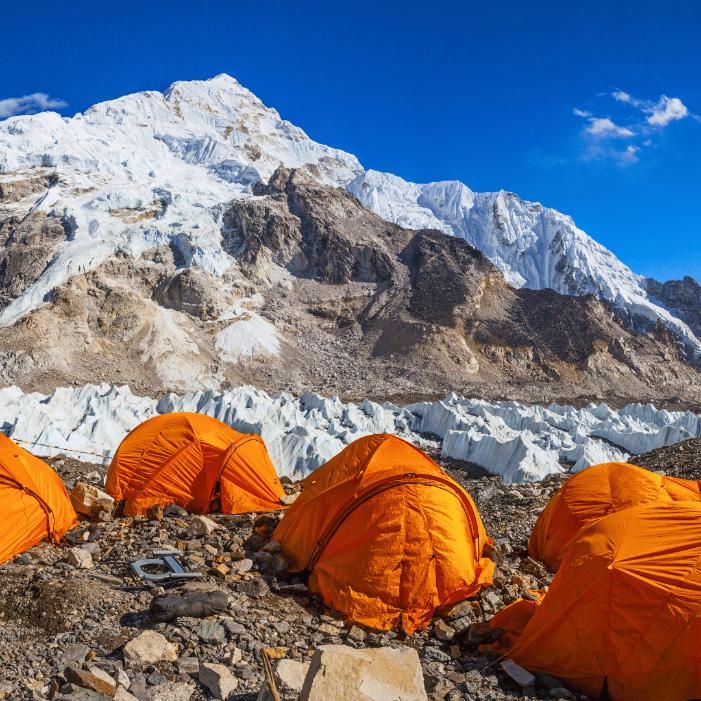
The Annapurna Base Camp Trek is less difficult than the Everest Base Camp Trek . Here’s why:
- Altitude, terrain, and duration affect how challenging a trek is.
- Annapurna Base Camp is at a lower altitude, making it easier on the body due to more oxygen.
- The terrain in Annapurna is gentler compared to the rough trails of Everest.
- The duration of the Annapurna trek is shorter, allowing for gradual acclimatization.
- The Everest Trek requires more walking and acclimatization, making it more physically demanding.
When talking about the scenery for Annapurna Base Camp Trek vs. Everest Base Camp Trek , we can see a lot of differences. Hikers heading for the Annapurna Base Camp Trek can expect diverse scenic views. They range from amazingly beautiful rhododendron forests to snow-covered, magnificent peaks.
Those trekking to Everest Base Camp will encounter uneven landscapes. The area is filled with pretty Sherpa villages.
The Annapurna region offers more varied vegetation and colorful landscapes. In contrast, the Everest region is barren yet astonishing in its beauty.
Popular photo spots along both treks include:
- The stunning sunrise views from Poon Hill on the Annapurna trek
- The panoramic vistas of Mount Everest from Kala Patthar on the Everest trek
These photo opportunities allow trekkers to capture the breathtaking scenery. It showcases the natural beauty that defines these iconic Himalayan trails.
Annapurna Base Camp Trek Highlights comparing with the Everest Base Camp Trek
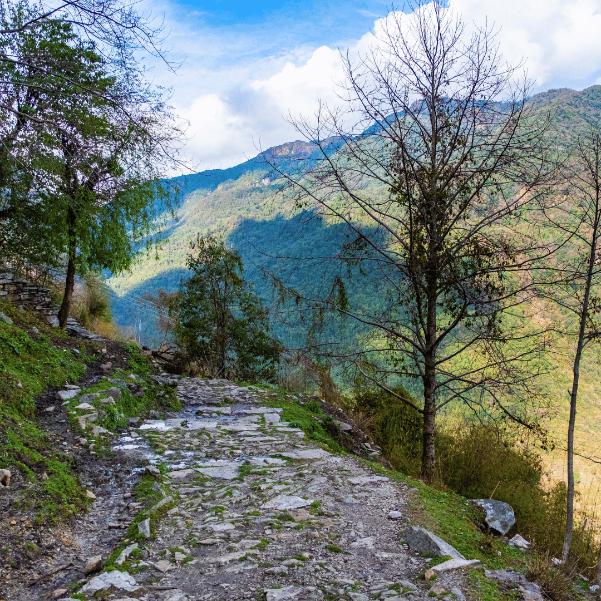
- Panoramic Views
The Annapurna Base Camp Trek offers panoramic views of the Annapurna mountain range, Machapuchare , and the diverse landscapes. Throughout the trek, you can enjoy a rich variety of natural beauty.
On the other hand, the Everest Base Camp Trek presents panoramic views of Everest, Lhotse, Nuptse, and the Khumbu Glacier. The Annapurna trek has dense greenery and terraced fields, while the Everest trek has rough terrain with snow-capped peaks that look beautiful.
When talking about Annapurna Base Camp Trek vs. Everest Base Camp Trek , both treks provide unique panoramic views of the Himalayas, each capturing the essence of this mountain range. These journeys are memorable and visually captivating, perfect for adventure and nature enthusiasts.
- Variety of Terrain
Hikers on the Annapurna Base Camp Trek can expect different terrain. They will encounter dense green forests, terraced fields, and alpine meadows. The trail passes through charming villages, giving a peek into local culture and the way of life over there.
The Everest Base Camp Trek , on the other hand, has a rougher landscape. It includes rocky paths, icy glaciers, and barren moraines. This trek goes through high-altitude areas, offering panoramic views of the world’s tallest peaks.
When talking about Annapurna Base Camp Trek vs. Everest Base Camp Trek , while they both have stunning scenery, the Annapurna region provides a wider variety. It ranges from subtropical forests to snowy peaks, offering very rich natural scenes for trekkers to enjoy.
- Cultural Experience
Engaging with the local culture on the Annapurna Base Camp Trek vs. Everest Base Camp Trek , they both offer unique insights.
Interacting with local villagers and experiencing traditional dances and rituals provided a firsthand look at Nepal’s rich cultural heritage.
Visiting ancient monasteries, participating in local festivals, and trying authentic cuisine immersed trekkers in local customs.
This cultural aspect added depth to the trekking experience, offering a deeper connection to the land and its people.
By embracing the cultural richness, trekkers can gain a greater appreciation for the environment and the communities in these majestic mountains.

Everest Base Camp Trek Highlights

- Close-up Views of Everest
Get ready to be amazed at the close-up views of Everest. It reveals its majestic peak in all its glory. The complete magnitude and beauty of the world’s tallest mountain become apparent. The intricate details of the snow-capped summit, surrounding peaks, and rugged terrain offer the most inspiring perspective.
Being in such close proximity during the trek allows trekkers to deeply appreciate nature’s grandeur. It helps in gaining a better understanding of the mountain’s significance. This intimate experience adds a sense of accomplishment to the journey. It also creates a profound connection with the mountain and its surroundings.
The close-up views of Everest serve as a constant reminder of the challenges faced and overcome during the trek. This makes the entire experience more meaningful and rewarding.
- Sherpa Culture
Sherpa culture shapes the Everest Base Camp Trek . It affects the experience and daily life of trekkers. The Sherpa people are skilled in mountaineering. They value the environment and follow traditional customs. This adds a unique touch to the trek. Their influence goes beyond the trails. It impacts the local community through rituals like prayer flags and celebrations. These traditions promote unity and well-being. Sherpa culture is evident in various aspects of trekking.
For example, yak caravans are used for transport. Stupa shrines dot the trekking route. Local Sherpa families run tea houses. These practices preserve their heritage and enhance the Himalayan exploration experience.
- Khumbu Glacier
The Khumbu Glacier is changing due to climate change. It’s melting and shrinking. Trekkers should be careful of hidden dangers like crevasses under the ice. To stay safe, they need good equipment, expert guides, and knowledge of the route. Scientists are studying the glacier’s movement, melting, and the effects of climate change on its health. This research helps us learn about the glacier and the impact of climate change in the area.
Accommodation Options
Accommodation options along the Annapurna Base Camp Trek and Everest Base Camp Trek routes vary.
While comparing the Annapurna Base Camp Trek vs. Everest Base Camp Trek, both treks offer similar types of places to stay, including tea houses, lodges, and basic guesthouses.
However, the Everest Base Camp Trek has a wider range of choices and more luxurious options than the Annapurna Base Camp Trek.
In terms of comfort, Everest Base Camp offers more amenities like attached bathrooms, hot showers, and electric blankets.
On the other hand, the Annapurna Base Camp Trek may have more basic facilities with shared bathrooms and limited hot water.
Accommodation costs are generally higher on the Everest Base Camp Trek due to the demand for more upscale lodges.
The Annapurna Base Camp Trek is usually more budget-friendly.
When deciding between the two routes, trekkers should consider their preferences for comfort, amenities, and budget.
Best Time to Trek
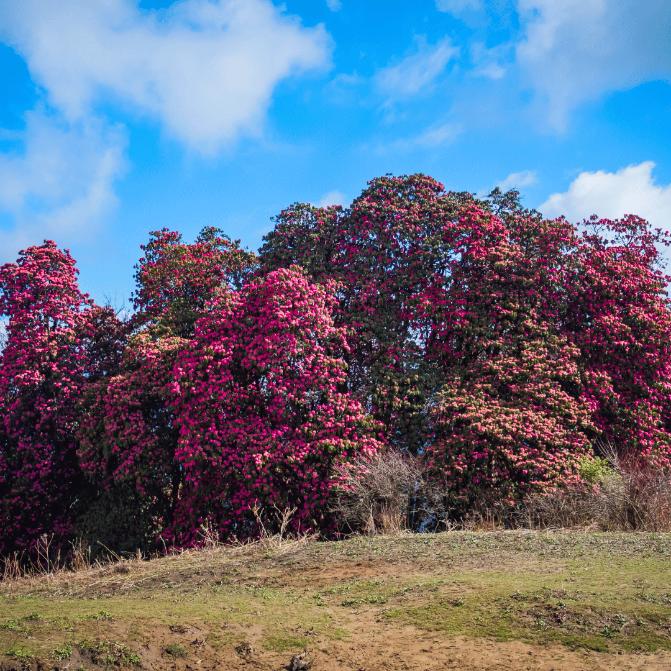
The best time to trek while comparing the Annapurna Base Camp Trek vs. Everest Base Camp Trek, there isn’t much debate. For the Annapurna Base Camp Trek and the Everest Base Camp Trek , it is important to consider weather conditions throughout the year.
Different seasons impact visibility and safety on these treks. Autumn (September to November) is generally ideal, with clear skies and moderate temperatures. Spring (March to May) also offers pleasant weather and blooming rhododendrons along the trails.
However, the monsoon season (June to August) brings heavy rainfall and slippery trails, making trekking challenging and potentially dangerous. Winter (December to February) can pose risks of snowstorms and extreme cold at higher altitudes.
Considering these seasonal variations is important when planning a trek for an enjoyable and safe experience.
Cost Comparison
The Annapurna Base Camp Trek costs less than the Everest Base Camp Trek . Prices can vary based on the operator and season.
Overall expenses for permits, accommodations, meals, and transportation are usually cheaper for the Annapurna trek. However, don’t forget about other costs like gear rentals, travel insurance, and tips for guides and porters. These additional expenses can accumulate during the trek.
Consider these hidden costs when comparing the total expenses of the Annapurna and Everest Base Camp Trek for a more accurate assessment.
Final thoughts
Are you deciding between trekking to Annapurna Base Camp or the Evere s t Base Camp Trek ?
Annapurna Base Camp has a shorter trek and stunning views of Machapuchare and Annapurna peaks.
Everest Base Camp is a more challenging trek with views of Mount Everest , the world’s highest peak.
When choosing between these two destinations in Nepal, it is recommended to think about your fitness level, trekking experience, and scenery preferences.
While comparing the Annapurna Base Camp Trek vs. Everest Base Camp Trek , the Annapurna Base Camp trek is generally considered less difficult than the Everest Base Camp trek. The Annapurna trek involves less elevation gain, a shorter duration, and milder weather conditions compared to the Everest trek.
Both Annapurna Base Camp and Everest Base Camp Trek offer stunning views, but Everest Base Camp provides more dramatic views of the world’s tallest peak, Mount Everest . Annapurna Base Camp offers diverse landscapes with closer views of the Annapurna Range.
Yes, there are altitude sickness concerns when trekking to Annapurna Base Camp or Everest Base Camp. It is important to acclimatize properly, stay hydrated, and descend if symptoms persist. Consider taking Diamox medication as a preventive measure.
The best time to trek to Annapurna Base Camp or Everest Base Camp is during the pre-monsoon season in Nepal, from late September to early November. This time offers clear skies, moderate temperatures, and stunning views of the Himalayas.
Annapurna Base Camp offers more cultural experiences compared to Everest Base Camp, with encounters with various ethnic groups like the Gurungs and Magars, and visits to traditional villages like Ghandruk.
Send an Enquiry
© 2024 - Himalayan Trekking and Tours (P) Ltd. All Rights Reserved.

Everest Base Camp vs Annapurna Base Camp: The Ultimate Trekking Showdown(2023 )
Nepal , home to 8 of the world's 10 tallest mountains, is a trekking paradise. With treks for all levels of experience, the two most popular ones are the Everest Base Camp (EBC) Trek and the Annapurna Base Camp (ABC) Trek . In this comprehensive guide, we'll compare these treks, highlighting their unique features , challenges , and Cost to help you choose the perfect adventure.
Are these treks worth it?
Absolutely! Both treks offer stunning mountain views and unforgettable cultural experiences . You'll journey through isolated villages and serene Himalayan trails , making memories that will last a lifetime. Ebc or Abc Trek , both trek takes you on an adrenaline-pumping journey far from the hustling and bustling of cities.
Overview of Everest Base Camp (EBC) Trek :
The EBC trek takes you to the foot of Mount Everest (8,848m/29,029ft) , the world's tallest peak . This 130km (80 miles) round-trip trek offers unparalleled mountain views, rich cultural encounters with Sherpas , and pristine natural beauty . The EBC trek typically takes 12-15 days , with a flexible duration for acclimatization and side trips. The highest point of the trek is Kala Patthar (5,643m/18,513ft) .

Overview of Annapurna Base Camp (ABC) Trek:
The ABC trek leads you to Mount Annapurna (8,091m/26,545ft) , the tenth-highest mountain in the world . This 110km (68 miles) round-trip trek takes you through diverse landscapes, from terraced fields to lush forests and glacier valleys . The ABC trek typically take s 8-10 days and has the highest altitude at 4,130m (13,550ft) at Annapurna Base Camp itself.
Everest Base Camp VS Annapurna Base Camp Treks:
Trip highlights of the everest base camp trek:.
Mount Everest : The EBC trek through the heart of the Khumbu region offers you a glimpse of the world’s highest peak which is a once-in-a-lifetime experience that draws trekkers from all around the world. This is a major draw for trekkers from around the world, and the Everest Base Camp trek offers a unique opportunity to witness this majestic mountain up close.
Everest Base Camp : Standing at the base camp (5,364m/17,598ft) of the tallest peak is one of the major highlights and a lifetime accomplishment for many trekkers. The base camp offers an incredible view of the towering Mount Everest and other Himalayan peaks, creating an unforgettable and awe-inspiring experience.
Kala Patthar: The viewpoint(5,643 m/18,513ft) offers the world’s best panoramas of Mount Everest , Lhotse , Nuptse , and other surrounding peaks . The breathtaking views from this vantage point are a highlight of the Everest Base Camp trek and offer a sense of awe and wonder at the beauty and grandeur of the Himalayas.
Tengboche: Tengboche is a spectacular village located at 3867m high up in the ebc trail, offering breathtaking views of snow-capped peaks all around. It also inhabits one of the largest and most significant Buddhist monasteries in the Khumbu region at an altitude of (3,867m/12,687ft) is a most visited place for cultural and historical insights and its architecture fusion of traditional Tibetan and Sherpa styles.
Namche Bazaar: Although the area of Everest is quite remote, the bustling market town of Namche Bazaar offers a range of facilities from guesthouses, restaurants, shops, a bank, a medical clinic, cafes, and even a bakery. It also has access to electricity and internet connectivity , which are important for both residents and tourists.
Sherpa Culture: Experience the unique and untouched culture and traditions of Sherpa who have been inhabiting the region for centuries. The Sherpas are known for their warm hospitality, strong faith, and unique way of life in the mountains.
Suspension bridges and Himalayan Sunrise and Sunset: Cross several high suspension bridges adorned with colorful prayer flags, offering stunning views of the valleys below and experience spectacular sunrises and sunsets over the majestic peaks of the Himalayas, creating unforgettable memories.
Lukla Airport: The Lukla airport also known as the Tenzing-Hillary Airport is one of a kind itself. The location and the geography around the lukla airport is amazing in itself. Eventhough, considered to be one of the most dangerous airport worldwide the development and planning of avation has improved and is causalty-less after 2019.
Hotel Everest View : In Syangboche , when you arrive at the Everest View Hotel , you'll be awestruck by the sheer magnificence of the Himalayan mountain range. The views from Everest View Hotel are truly spectacular befitting its name as the snow-capped peaks stretch as far as the eye can see, and it's an incredible sight that will leave you feeling humbled and amazed. The hotel's interior is cozy and inviting, decorated with traditional Nepali and Tibetan artwork that adds to the welcoming atmosphere. The restaurant at the hotel is a real treat for your taste buds. You can savor the mouth-watering flavors of Nepalese and Tibetan cuisine while enjoying the incredible views from the large windows. It's an unforgettable dining experience that will leave you feeling grateful for the opportunity to witness such natural beauty.

Trip Highlights of the Annapurna Base Camp Trek:
Annapurna Sanctuary: This natural amphitheater within the Annapurna Conservation Area delivers jaw-dropping views of the Annapurna range, including the 10th highest mountain globally, Annapurna I , Dhaulagiri , and Machhapuchre . It's also home to diverse flora and fauna, featuring rare species like the snow leopard and Himalayan musk deer.
Annapurna Base Camp: Reaching the base camp (4130m/13,550ft) is a significant achievement for trekkers, as it offers mesmerizing views of the surrounding peaks, such as Annapurna I , Annapurna South , Machhapuchhre, Gandharwa Chuli , Kangfang , Singuchuli, Tharpuchuli (tent peak) , and Hiunchuli , creating an unforgettable amphitheater-like setting.
Machhapuchre Base Camp: Located along the Annapurna Base Camp trail, this sacred peak holds religious significance and is believed to be Lord Shiva's abode . Although climbing the mountain is prohibited, trekkers can still enjoy the captivating natural surroundings.
Rhododendron Forests: As you venture through the Annapurna Base Camp Trek , you'll encounter vibrant rhododendron forests that burst with color during spring. These lush, picturesque forests offer an unparalleled visual experience and a chance to connect with nature.
Gurung and Magar Villages: Discover the unique culture, tradition, and hospitality of the Gurung and Magar villages in the Annapurna region. Nestled in the mountains, these villages boast impressive views of the Annapurna and Dhaulagiri ranges.
Terraced Fields and Suspension Bridges: Witness the beautiful terraced fields that showcase traditional agricultural practices while crossing thrilling suspension bridges adorned with colorful prayer flags, offering stunning views of the surrounding landscape. You will also cross one of the longest suspension bridges, Jhinu Suspension bridges which is about 130 meters long .
Hot Springs: Jhinu Danda's natural hot springs provide a much-needed reprieve for weary trekkers, offering a chance to relax and rejuvenate in the soothing waters surrounded by the forest's serenity.
Diverse Ecosystems: The Annapurna Base Camp trek takes you through a variety of ecosystems, including lush subtropical forests , verdant meadows, and striking alpine landscapes, allowing you to experience the Annapurna Conservation Area's rich biodiversity.
Wildlife: If luck is on your side, you may spot rare and endangered wildlife like the Snow Leopard and langur monkeys, along with numerous bird species in their natural habitat during your journey.
With these captivating highlights in mind, you're now equipped to decide which trekking adventure best aligns with your interests and sense of exploration.
Accommodation:
While going on a long journey, accommodation is one thing everyone looks for and must care about because the day becomes tiring, and you want to rest well to start the next day afresh.
The trek to EBC or ABC is no exception, and you will find various types of accommodation options like teahouses, lodges, and hotels along the way to cater to your budget and preferences.
Accommodation in Annapurna Base Camp Trek
When you go trekking in the Himalayas of Nepal, the teahouse is one of the most popular and affordable options for accommodation. Managed by locals , these teahouses provide a simple but comfortable place to rest after a long day of trekking. Moreover, you'll get a clean and comfortable bed, warm blankets, and good food to keep you going for the next day's trek.
Most teahouses also offer basic amenities such as electricity/solar, toilets , and shower facilities.
However, be prepared to pay extra for a hot shower at higher altitudes. Keep in mind that most of the teahouses may not have indoor toilets, and you might have to use an outdoor bathroom that is shared among guests. Additionally, some teahouses may charge extra fees for access to Wi-Fi and power sockets.
Despite these limitations, teahouses are a great way to experience the local culture and hospitality. You can chat with the locals, learn about their traditions, and enjoy a warm cup of tea or a tasty Nepali meal.

Accommodation in Everest Base Camp Trek:
When trekking to Everest Base Camp , you'll have plenty of options for accommodation. Teahouses, hotels , and lodges are scattered along the trail, providing trekkers with various choices to suit their budgets and preferences. While teahouses are the most common form of accommodation on the trek, hotels and lodges offer more luxurious facilities but come at a higher price.
As you climb higher and higher, everything becomes more expensive due to the lack of availability of supplies and the increased difficulty of transportation. Teahouses provide attached bathrooms until you reach Pheriche, but it's not guaranteed after that.
One of the best parts of trekking to EBC is the food. You'll find a wide variety of delicious options at every teahouse, hotel, or lodge. However, you may need to pay extra for hot showers and charging facilities , particularly as you get closer to the higher altitudes of the trek. It's always wise to bring extra cash to cover unexpected expenses and ensure a comfortable and enjoyable tour.

Food and Culture:
When you embark on a trek to the mountains of Nepal, food is one of the most crucial aspects you need to consider. Fortunately, you'll be treated to some of the most delicious and nourishing meals on the planet during your trek, with dal bhat being a staple favored by Nepalese locals and trekkers alike. The dish is a hearty and flavorful combination of lentils, rice, and vegetables that are easy to digest and perfect for fueling your body. Along with dal bhat , you'll find a wide variety of other Nepalese dishes , including vegetable soups, pickles, lentil dishes, bread, and momos all of which offer a unique taste of the local cuisine. It's worth noting that avoiding heavy or overly spicy foods while trekking is best, as they can strain your body. Opting for traditional Nepalese dishes cooked in local households is the best way to keep your stomach and taste buds happy.
However, if you're looking for a bit of indulgence, you'll also be able to treat yourself to some delicious international dishes like spaghetti, spring rolls, pizzas, burgers, and sandwiches at some of the lodges along the trekking route. Aside from the food, one of the most exciting aspects of trekking in Nepal is encountering the diverse cultures of the people who call the mountains home. The Annapurna Base Camp and Everest regions offer two distinct cultural experiences worth exploring.
If you plan to trek to the Annapurna Base Camp, you'll find that most of the people in this region are Gurung, and you'll have the chance to learn more about their unique traditions and way of life. You may even be treated to traditional folk songs and dances during your trek, which is a beautiful and unforgettable experience.
On the other hand, the Everest region is home to the Sherpa people , who have a vibrant Buddhist culture deeply rooted in the Himalayas. Trekking through this region is an adventure in itself, as you'll have the opportunity to learn more about the Sherpas' unique way of life, history, and customs. Not to mention, the stunning mountain views and landscapes are truly awe-inspiring and will leave you with memories to last a lifetime. The remote geography and higher altitude make the Everest Base Camp trek expensive as it parallel affects the cost and arrangement for food and accommodation, but the trip to everest makes every penny worth it.
Starting point for EBC vs ABC:

Tims and Permits:
For both the Everest Base Camp and Annapurna Base Camp treks , permits are necessary.
For the EBC trek:
Trekkers need to obtain two permits , the Sagarmatha National Park Permit and the Khumbu Pasang Lhamu Rural Municipality Permit , also known as the Everest Region Permit . Additionally, from April 2023 trekkers must obtain a TIMS (Trekkers’ Information Management System) card for the EBC trek. The total permit cost for EBC is 50$. Guides and Porters aren’t mandatory during the Everest Base Camp Trek but you are encouraged to take an experienced guide for safety reasons. However, if trekking to EBC without a guide, trekkers must obtain a TIMS card with the "solo trekker" option.

For the ABC trek:
Trekkers need to obtain the Annapurna Conservation Area Permit (ACAP) and the TIMS(Trekkers’ Information Management System) card from April 2023. The same as EBC the total permit cost for ABC is 50$. Hiring a guide is mandatory for this trek for safety reasons and to support the local economy.

Conclusion:
In conclusion, the Annapurna Base Camp and Everest Base Camp treks offer unique experiences that cannot be easily compared. The choice between the two ultimately depends on your personal preferences and priorities. However, the EBC trek itself cannot be compared to any othe r trek in the world as it takes you to the foot of the world’s tallest peak. So, if you have enough time for trekking with a high level of physical fitness and a budget sufficient for the EBC trek, you would definitely want to stand where the world’s tallest peak stands . The Everest Base Camp trek is considered a classic destination with a rich history, making it an attractive option for many travelers. But, If you have limited time for trekking, with little or no experience and a limited budget , the Annapurna Base Camp trek may be more suitable for you, as it can be completed in a shorter amount of time compared to the Everest Base Camp trek.
When it comes to cost, the Everest Base Camp trek can be more expensive than the Annapurna Base Camp trek , as it covers a greater distance and involves more places to visit along the way. Ultimately, whether you choose to trek to Annapurna Base Camp or Everest Base Camp , you can expect to have a truly memorable and rewarding experience that will stay with you for a lifetime. Written by:Shailes Giri
Share this:
Find us on Facebook
Follow us on Instagram
Follow us on Pinterest
Follow us on Twitter
Watch us on YouTube
Find us on TripAdvisor
We are associated with:
.png)
Start your next adventure here, join our newsletter

Explore the world with tourHQ
- Destinations
- I am a Guide
- I am a Traveller
- Online Experiences
- Currency (USD)

Annapurna Base Camp vs. Everest Base Camp Trek

Tour Guide , Yaren, Nauru
Tour Guide , Kathmandu, Nepal
21 Apr 2024 | 4 mins read
Both offer breathtaking landscapes, unique cultural experiences, and a sense of accomplishment. In this blog post, we will compare and contrast these two treks, considering factors such as difficulty, scenery, cultural immersion, accessibility, and overall experience. Join us as we delve into the Everest Base Camp vs. Annapurna Base Camp Trek debate to help you choose the ultimate Himalayan adventure.
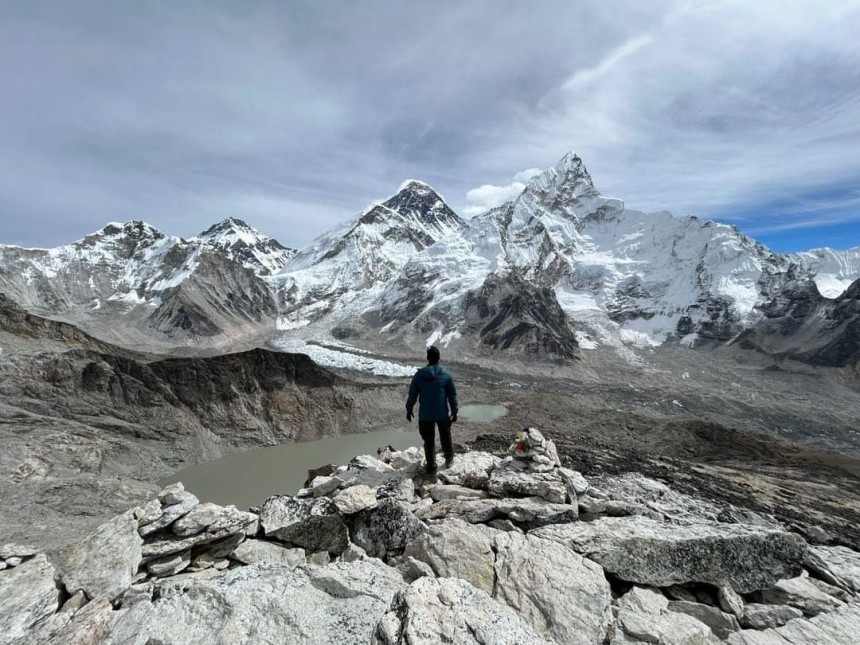
1. Difficulty and Altitude
The Everest Base Camp Trek is known for its higher altitude and more challenging terrain. The trek reaches a maximum altitude of 5,364 meters (17,598 feet) at Everest Base Camp. The trail involves steep ascents, rocky paths, and the risk of altitude sickness. Proper acclimatization and physical fitness are crucial for a successful trek.
On the other hand, the Annapurna Base Camp Trek is considered less challenging in terms of altitude. The maximum altitude is 4,130 meters (13,550 feet) at Annapurna Base Camp. The trail is relatively more gradual, with fewer steep ascents and descents. It is generally considered more accessible to trekkers of varying fitness levels.
2. Scenery and Mountain Views
Both treks offer stunning scenery and panoramic mountain views, but with different highlights:
The Everest Base Camp Trek provides unparalleled views of the world's highest peak, Mount Everest, along with other towering peaks like Lhotse, Nuptse, and Ama Dablam. The trek takes you through the rugged beauty of the Khumbu region, with its dramatic landscapes, glacial moraines, and Sherpa villages.
The Annapurna Base Camp Trek offers a diverse range of landscapes, from lush green forests to alpine meadows and high mountain vistas. The trail provides breathtaking views of the Annapurna mountain range, including Annapurna I, Annapurna South, Machhapuchhre (Fishtail), and Hiunchuli. The trek also takes you through charming Gurung villages and terraced fields.
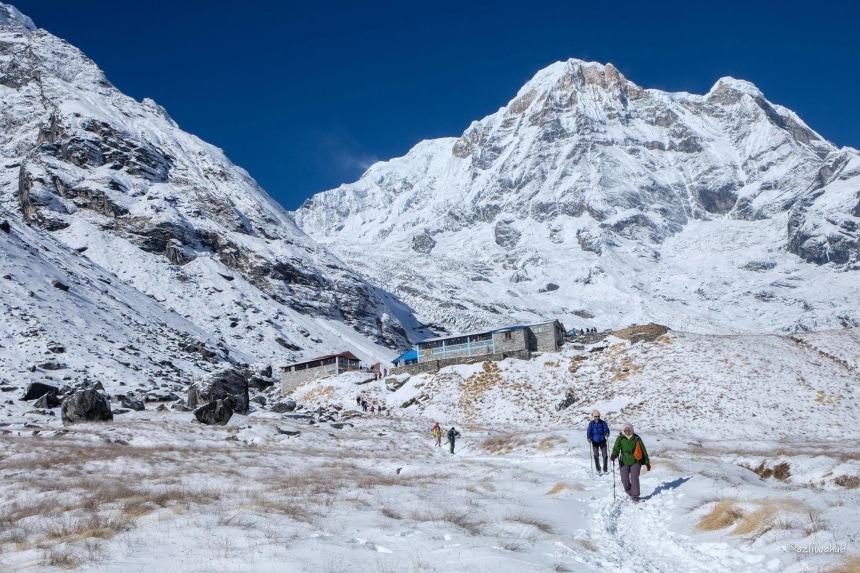
3. Cultural Immersion
Both treks offer opportunities for cultural immersion and interaction with local communities:
The Everest Base Camp Trek allows you to experience the unique Sherpa culture of the Khumbu region. You'll pass through traditional Sherpa villages like Namche Bazaar, Tengboche, and Dingboche, where you can visit monasteries, witness religious ceremonies, and learn about Sherpa traditions and way of life.
The Annapurna Base Camp Trek takes you through culturally rich villages inhabited by Gurung and Magar communities. You'll have the chance to interact with locals, visit traditional houses, and learn about their customs, music, and dance. The trek also offers opportunities to explore the vibrant city of Pokhara, known for its lakeside charm and stunning mountain views.
4. Accessibility and Infrastructure
In terms of accessibility and infrastructure, there are notable differences between the two treks:
The Everest Trekking requires a domestic flight from Kathmandu to Lukla, followed by a trek through the Khumbu region. The trail is well-established, with teahouses and lodges providing accommodation and meals along the way. However, due to its popularity, the trail can be crowded during peak seasons.
The Annapurna Base Camp Trek starts from Nayapul, which is easily accessible by road from Pokhara. The trail passes through the Annapurna Conservation Area, where teahouses and lodges are available for accommodation and meals. The trek offers a range of route options, allowing for flexibility in itinerary planning.
5. Overall Experience and Trekking Season
The overall experience of each trek is subjective and depends on personal preferences:
The Everest Base Camp Trek is renowned for its challenging nature, high altitude, and the opportunity to witness the world's highest peak. It attracts adventurers seeking a more physically demanding and remote trekking experience. The best time to undertake this trek is during the spring (March to May) and autumn (September to November) seasons.
The Annapurna Base Camp Trek is considered more accessible and suitable for trekkers of varying fitness levels. It offers a diverse range of landscapes, cultural experiences, and stunning mountain views. The trek is popular among those seeking a balanced combination of natural beauty and cultural immersion. The best time to undertake this trek is during the spring (March to May) and autumn (September to November) seasons.
Choosing between the Everest Base Camp Trek and the Annapurna Base Camp Trek depends on your preferences, fitness level, and the type of experience you seek. The Everest Base Camp Trek offers a more challenging and remote adventure, with unparalleled views of Mount Everest. On the other hand, the Annapurna Base Camp Trek provides a diverse range of landscapes, cultural immersion, and stunning mountain vistas. Both treks offer unique experiences that will leave you with lifelong memories. Whichever trek you choose, the Himalayas will undoubtedly captivate your heart and soul.
Choose Currency Close modal
- USD US, dollar
- GBP British Pounds
Cookie icon We use cookies!
We, and third parties, use cookies for technical and analytical purposes, for marketing purposes and for integration with social media. For more information, refer to our Privacy Policy and Terms of Consent.
By clicking on 'I agree', you consent to the use of these cookies.
ADVENTURE-PULSE (The Adventure Management Consultants)
Established in 2010
Trek to the Everest Base Camp with Adventure Pulse and dominate the dramatically exciting sport of high altitude trekking!
The Everest Base Camp trek is the highest trekking route available to outdoor enthusiasts and nature lovers, thus making it not only one of the most challenging, but also, one of the most beautiful treks in the Himalayas. This is a non -technical trek and does not require rock climbing or rappelling skills, which makes it the ideal introduction to high altitude trekking for adventure enthusiasts. While on the trek, you will be staying in Tea Houses which are comfortable homestays with world-class amenities such as electricity and internet.
We start from the quaint little village of Lukla (at a height of approximately 9000 feet) and over the course of this two-week-long expedition, will get intimately acquainted with the charming denizens of the Khumbu valley - the wondrous, wonderful, resilient and ever-impressive Sherpa community. This journey will capture your imagination with breath-taking views of some of Nepal's finest rivers, her ancient, undisturbed forests, and the pristine snow-capped peaks – Nepal’s solemn sentinels, each more impressive than the last, and taking you to the very foot of the country's crown jewel; the spectacular, Mount Everest! We know this trail like the back of our hand and promise you the experience of a lifetime!
Everything you need to know about the Everest Base Camp Trek.
Quick Facts
Best Time : March to May (Pre-monsoon season); September to November (Post-monsoon season)
Duration : 15 Days (11 Days of Trekking)
Degree of difficulty :
Max. Altitude : 5545 m
Commences At : Kathmandu
Ends At : Kathmandu
- Detailed Itinerary
- List of things to carry
- Physical Fitness Preparation Guide
- Arrival in Kathmandu.
- Drive from Kathmandu to Ramechap - Fly to Lukla (2810) and trek to Phakding (2660m).
- Trek to Namche Bazar (3440m).
- Namche Bazar - Rest and Acclimatization - Hike to Khumjung (3900m).
- Trek to Tengboche / Dibuche (3870m).
- Trek to Dingboche (4252m).
- Dingboche – acclimatization – Hike to Nangakarshang (5010m).
- Trek to Lobuche (4930m).
- Trek to Everest base camp (5360) and stay at Gorakshep.
- Trek to Kalapathar (5545m) and stay at Pheriche (4200m).
- Trek back to Namche Bazar (3440m).
- Descend to Lukla (2810).
- Fly back to Kathmandu.
- Buffer Day for bad weather.
- Depart from Kathmandu.
Expand all | Collapse all
Day 1 : Arrival in Kathmandu.
day 2 : drive from kathmandu to ramechap - fly to lukla (2810) and trek to phakding (2660m)., day 3 : trek to namche bazar (3440m)., day 4 : namche bazar - rest and acclimatization - hike to khumjung (3900m)., day 5 : trek to tengboche / dibuche (3870m)., day 6 : trek to dingboche (4252m)., day 7 : dingboche – acclimatization – hike to nangakarshang (5010m)., day 8 : trek to lobuche (4930m)., day 9 : trek to everest base camp (5360) and stay at gorakshep., day 10 : trek to kalapathar (5545m) and stay at pheriche (4200m)., day 11 : trek back to namche bazar (3440m)., day 12 : descend to lukla (2810)., day 13 : fly back to kathmandu., day 14 : buffer day for bad weather., day 15 : depart from kathmandu., package details, trip cost includes.
- 3 night’s hotel stays in Kathmandu (1 night before and 2 nights after) on bed & breakfast plan .
- International Airport transfers in private car.
- Experienced & Qualified Guide for the trek.
- Trekking permit.
- National Park Permit.
- Return commercial Flight fare from Kathmandu – Lukla for members with 11 kg check in baggage allowance + 2 Kg handbag.
- Domestic airport departure taxes.
- Full board tea house trekking cost with breakfast, lunch, dinner with accommodation.
- 3 times tea / coffee / hot drink while on the trek.
- Personal Porters for carrying bags during the trek.
- Ground Transportation & Airport transfers for Kathmandu – Lukla flights.
TRIP COST EXCLUDES
- International Flights to Nepal and back.
- Lunch & Dinner while in Kathmandu.
- Beverages and alcoholic drinks.
- Mineral or Boiled Drinking water on the trek.
- Tea / coffee ordered more than 3 times a day.
- Extra snacks ordered by clients outside regular meals.
- Emergency medical evacuation by Helicopters.
- Excess baggage on Lukla flights.
- Tips for staffs (Recommended $ 100 per head).
- Personal expenses and extra services beyond itinerary like WiFi / hot shower.
- Helicopter cost / charter plane cost in case of flight cancellation or evacuation.
- Any Personal clothing or equipment.
1. What kind of physical shape do I need to be in to trek to Everest Base Camp?
This trek into the Everest region is strenuous but does not require any previous trekking, mountaineering or technical climbing experience; only that you be in good physical conditioning. The trek requires you to be able to hike for 4-6 hours over hilly terrain with a light day pack for 11 days. Good cardio-vascular conditioning and exercises for muscles that are used to hiking will make your trip much more enjoyable. Our goal is to climb Kala Patthar at 18,700 feet, and walk on broken glacial moraine all the way into Base Camp, at 17,500 feet. You will spend 11 days in a land where life is simple, trails are steep and the air is thin. Begin training today if you want to make the most from this trip.
2. What are the Entry & Exit Points for the trek?
Your itinerary starts from Kathmandu, the capital city of Nepal. We receive you at the Kathmandu International Airport and transfer you to your hotel located in Thamel, the tourist district of the city. You spend this day in the city and the next morning take a small aircraft from Kathmandu to Lukla (Duration 30 mins) from where we start trekking. On reaching our destination, we take the downward trail back surrounded by breathtaking views of Nepal from river banks and pine forests to snow caped peaks. We fly back from Lukla to Katmandu, trying to keep an additional day as buffer in case of delays due to bad weather. After a day spent in Kathmandu, we transfer you to the International Airport, which marks the end of your itinerary.
3. What are the accommodations like in Kathmandu and while trekking?
In Kathmandu we will be staying in a 3/4 star Hotel or Guest House in Thamel, Katmandu often referred to as a trekker’s paradise. On the trek we will be staying in a combination of clean and friendly Sherpa Lodges / Tea Houses. This is popularly referred to as a Tea House trek, as opposed to a camping expedition.
4. Do I need any special equipment or climbing gear during this trek?
No, as the trek does not involve any technical climbs, no special climbing equipment is required. A rucksack (60-70 lts), good pair of trekking shoes, a warm jacket and a pair of thermals are good enough. Also, we will be sending you a comprehensive mail on the list of Items to be carried which will help you pack rucksack better.
5. What is the communication system available on the way?
There are different ways to be in touch with your Family. You can purchase a local Prepaid SIM Card at the International airport. If you have a Mobile with International Roaming on it, your Phone will work till Day 3 of the trek so you can easily be in touch with your Family. Post which, most of the tea Houses we stay in have the facility of an ISD Phone and the Internet. You can call your family every day or E-mail them during the course of the trek. Although the prices for these facilities may vary from a minimum of 100 Nepali rupees to 500 Nepali rupees per minute.
6. What about High Altitude Acclimatization?
You will notice in the Itinerary that there are 2 exclusive days for acclimatization at Namche & Dingboche (11,400 feet & 14,200 feet). These are rest days to allow our bodies to adapt to the High Altitude.
7. Can you give an example of a typical Breakfast, Lunch & Dinner on the way?
The Meals are freshly prepared in the Tea Houses that we stay in. Typical Days Meals – • Breakfast – Porridge, Two eggs, toast with jam or Butter and Hot tea/coffee/ Chocolate. • Lunch – Rice with Lentils & Vegetables commonly known as Dal Bhat Tarkari, Choice of Fried Rice or Noodles. • Dinner – Choice of Soup, Mashed potatoes, Choice of Noodles/fried Rice and Hot Drinks.
8. Will I be able to take showers/bath on the course of the trek?
Yes there are hot water showers available on most of these tea houses that we would be staying in. You can avail of these facilities at an average rate of 300 Nepali rupees for a 10 minute shower. But usually after the 3rd/4th Day, you yourself would want to avoid it because of dropping temperatures and biting cold outside.
9. What is the medical/emergency precautions taken en-route?
Adventure Pulse requires each of its clients to provide a medical fitness document before joining the group. Our crew is well qualified for any First-Aid procedures if required on the way. In addition a comprehensive Medical & first Aid kit is carried at all times. There are Medical stations available en-route in case of an emergency and also Helicopter evacuation procedures are available on actuals. When we ascend above 2500 meters our bodies have to acclimatise to the decreasing amount of the oxygen available. To allow our bodies to adjust and to avoid any such situations, we have added acclimatization and rest days in the itinerary. Personal Adventure Travel Insurance can also be purchased, which includes helicopter evacuation in case of a medical emergency.
10. What would be a typical day like?
You will be woken in the morning by 5:45 to 6:00 am. Breakfast and hot beverage would usually be served in the dining room of the tea house by 6:30 am. Before breakfast you pack your gear into your duffel bags or rucksacks which are then taken by the porters and will not usually be available to you until the next teahouse that afternoon. We are usually on the trail between 7.00 am and 7.30 am to avoid the heat of the noon and to reach our destination by lunch time. Following a good morning's walk, we stop for tea at around 11 am. This is usually a 30 – 60 minute break to allow for the trekkers to relax and catch their breath. The subsequent walk is generally a little shorter and next destination is usually reached by around 2 pm to 3 pm. Once we have our next destination, tea is served. Washing water is available to wash at the end of the trek day, but it will be cold. Until dinner, there is time to rest, explore the surrounding area and villages or sit and chat with the crew and local people. Dinner is usually served around 6 pm to 7 pm. Trekking evenings afford some of the best memories of your trek, whether it is talking, playing cards, chatting with the crew or joining in some singing and dancing with the local people, it is always a special time.
11. What happens in terms of flight cancellations due to bad weather?
Weather is very un-predictable, especially in high-altitude and can change within minutes. In case we encounter bad weather, we have kept 2 buffer days in the itinerary which would help us complete the trek. In case the weather remains unfavourable and the Kathmandu – Lukla – Kathmandu flights are delayed beyond two days, a helicopter can be chartered, at an extra cost to be borne by the trekkers, in order to reach the destination. Please note – this is optional and if exercised will have to be paid for by the clients.
Extreme temperature variations, high altitude, snow glare & proximity to sun are certain factors which necessitate the need to for proper mountaineering equipment. In order to enjoy your experience in the mountains, we have recommended that you carry the following with you.
- Trekking Boots / Shoes (preferably up to ankle length & water resistant)
- Multiple pairs of cotton and woolen socks (at least 5-6 pairs of each)
- Track Pants for comfortable trekking, Denims to be avoided. (At least 3-4)
- Thermal inners and sweater / warm sweat shirt (1 each)
- Cotton T-shirts (5 to 6 minimum)
- Water proof jacket/windcheater
- Warm thermal jacket
- 01 Peak Cap + at least 01 Woolen Cap
- 02 pair of warm gloves (Liners and outer)
- One pair floaters
Accessories
- Air bag / Duffel bag / Rucksack (No Suitcases during the trek)
- Day Back Pack + Drinking Water Bottle 1 Litre
- Torch + Batteries
- Sleeping Bag
- Knee / Ankle / Wrist Guards (if required)
- Nail Cutter / Pocket / Pen Knife
- Hand sanitizer
- Chap-stick / Vaseline
- Personal toiletries (Tooth Paste / Toilet Paper / Wet Wipes or Baby Wipes etc.)
- Medical kit (With basic medicines for headache, upset stomach, sour throat, water purification tablets/drops, band aids, painkillers & Moov/ Iodex, Vics Vaporub, D-Cold etc.)
- Any personal medication (Individual specific)
- High energy snacks like Dry fruits, Bars of chocolate, Tang, glucose etc.
- Good quality Sun shades.
- Sun block (SPF40+)
Note: If you are unable to procure any of the above mentioned items, then suitable arrangements will be made so that the same can be either bought or rented in Kathmandu based upon actuals.
The Trek to the Everest Base camp is one of the highest and most beautiful treks in the world and requires participants to be in good physical shape to be able to do the trek comfortably. Even though the trek into the Everest region can be steep & strenuous at some places, it does not require that you have any previous trekking or mountaineering experience neither does it require any technical experience; only that you be in good physical conditioning and be able to hike at a comfortable pace for 4-6 hours over hilly terrain with a light day pack. Good cardio-vascular conditioning and exercises for muscles that are used to hiking will make your trip much more enjoyable. Our goal is to climb Kala Patthar at 18,200 feet and walk on broken glacial moraine all the way into Base Camp at 17,500 feet. You will spend 12 days in a land where life is simple, trails are steep and the air is thin. We recommend the following schedule to the participants:
We recommend the following schedule to the participants
- Week One: Participants should develop a habit of being able to get up in the morning and run / brisk walk for a minimum of 3-4 Km at least 3-4 days a week. This would represent at least 20-25 minutes of cardio exercise. Though difficult at first, keep at it. You can stop and take breaks as well. During the day, you should get into the habit of avoiding elevators and taking the steps. You should be able to climb at least 4/5 flights of steps daily. (Avoid going down steps too fast as this could result in some knee injuries). If you Don’t enjoy running and are into some other sport like cycling or swimming, spend about 45 mins cycling or about 600 – 800 mts of swimming for at least 4 days a week .
- Week Two: Assuming you have successfully survived week one and are consistent with your exercise, you can take up the pace a notch. Increase your distance to 5/6 kms per day and 5 times a week, you can additionally go to a gym. Avoid heavy weight training. Focus more on a core workout. These are your muscle groups that run along the length of your body and helps maintain your posture and sustains you during your long hours of working.
- Week Three: In addition to the week Two exercise, one additional feature you should add in Week Three is walking for half an hour during the evenings with a backpack on carrying 3-4 kgs. This could be 2lts of water, some snacks, a jacket etc. This will help strengthen your back and shoulders thus preparing you for the long hours of trekking. If you don’t want to just simply walk, also try increasing your time on climbing flight of steps. As compared to week One, you should aim to be able to climb 10-12 flight of stairs comfortably.
- Week Four: Sustenance. Keep up the tempo, sustain the workout. Try avoiding doing anything very rigorous but be consistent with morning and evening walks / runs and climbing flight of stairs.
- Week Five: Sustain the workout. Increase only if you feel comfortable. Start doing an additional 10-15 mins of climbing stairs in the morning / evening with a daypack of 2-3 kg; about 20-25 floors once a day should help increase the stamina and Endurance considerably.
Contact: [email protected]
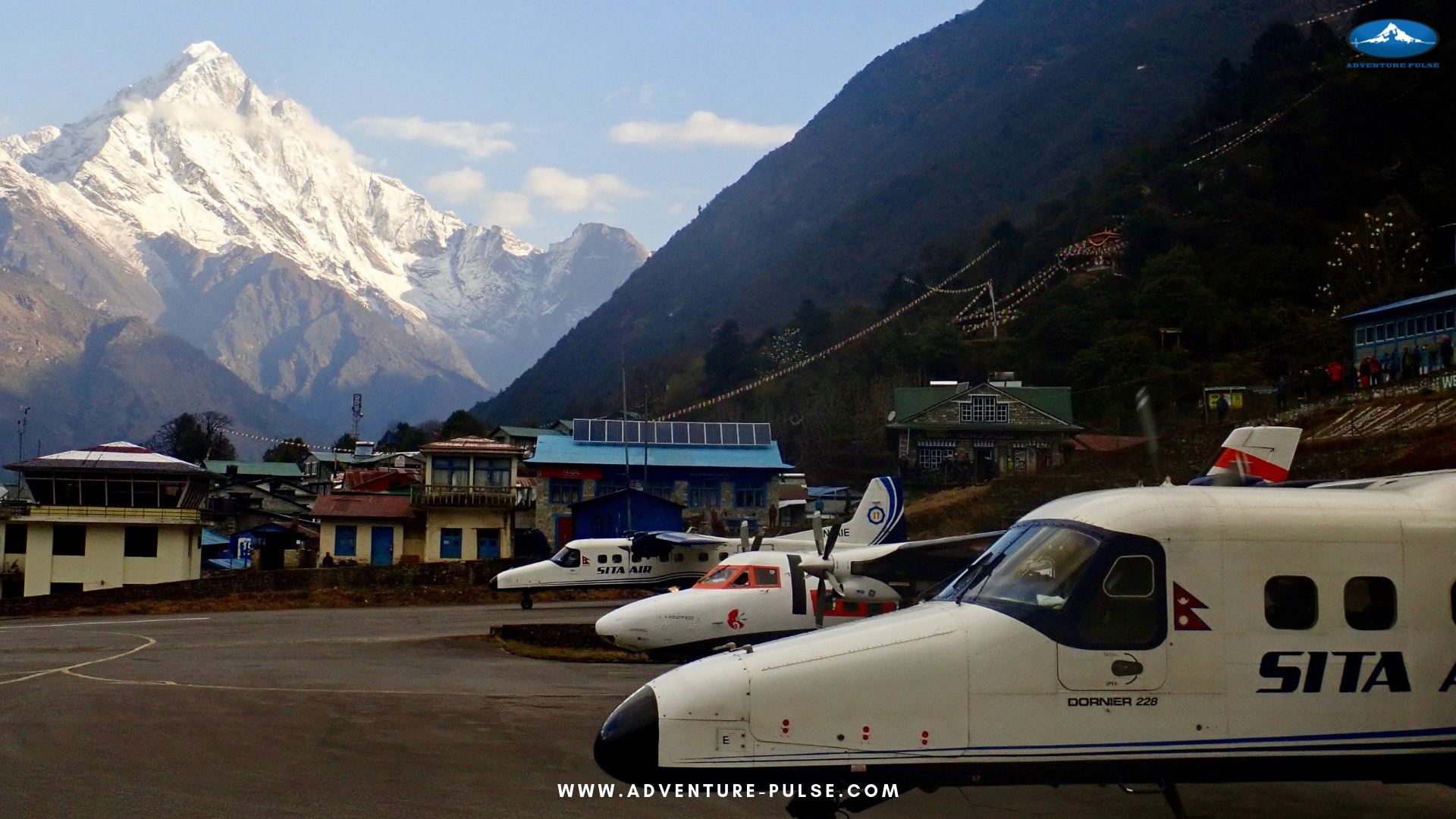
Important Links
Our Clients
Media Coverage
Our Everest Story
Register Now

Want to get in touch?
Sign up for News letter
Sign up for Adventure-Pulse monthly newsletter to receive updates on our upcoming treks and events.
Mail : [email protected]
Call us : 91-7709002311 / 12
WhatsApp : 91-7709002311 / 12

Compare of Annapurna and Everest Base Camp Trekking.
Embarking on a trekking adventure in the heart of the Himalayas is a dream for many adventurers. Nepal offers many trekking routes, but two are very famous: Everest Base Camp and Annapurna Base Camp. Both treks promise amazing views, cultural experiences, and a great sense of achievement. However, choosing between the two can be difficult. In this blog post, we'll look at the details of each trek to help you decide.
Brief Overview of Annapurna Base Camp and Everest Base Camp Treks
Located in the Annapurna Sanctuary, the famous Annapurna Base Camp trek is like setting off on a journey into the heart of Nepal's stunning Annapurna Sanctuary. Starting from the charming city of Pokhara, nestled beside a serene lake and framed by the majestic Annapurna Range, the trek to Annapurna Base Camp is both a discovery and an adventure. A scenic 6-7 hour drive from the busy capital of Kathmandu brings trekkers to the beginning of this remarkable journey.
From Pokhara, the trail winds through traditional Gurung and Magar villages, where time seems to slow down amid terraced fields and cascading waterfalls. Lush rhododendron forests line the path, painting the landscape with bursts of vibrant colors, while the cheerful chirping of local birds provides a peaceful soundtrack to the trek. The ABC trek is famous for its wide range of plants and animals, with thick forests full of different kinds of plants and animals. In the spring, trekkers can see beautiful rhododendron flowers in many colors, and they might spot birds like the Himalayan Monal and the Danphe, which is Nepal's national bird. Sometimes, they can also see animals like Himalayan thar, deer, and if they're lucky, even snow leopards in the higher areas
As trekkers ascend to higher elevations, the scenery changes dramatically, transitioning from dense forests to open alpine meadows adorned with a riot of wildflowers. With towering peaks like the majestic Annapurna Massif, the iconic Machapuchare (Fishtail), and the imposing Dhaulagiri in the background, each step reveals a breathtaking view of nature's magnificence.
The Annapurna Base Camp trek , while moderately challenging, is suitable for trekkers of all levels, offering an unforgettable mix of adventure and serenity amidst the natural splendor. Every moment spent exploring this sacred landscape is a tribute to the timeless allure of the Himalayas and a celebration of the adventurous spirit within us all.
Starting the Everest Base Camp journey feels like stepping into an endless adventure. The Everest Base Camp trek is located in the eastern region of Nepal, in the Sagarmatha National Park. The journey typically begins with a scenic flight from Kathmandu to Lukla, a small airstrip perched on a mountainside. It begins in Lukla, a small place in the Khumbu region. Those who are ready for challenges walk on tough paths, cross shaky bridges, and visit small Sherpa villages. The journey takes place in a beautiful area with rocks, ice, and stunning mountain views. Wildlife sightings on the trek can include Himalayan tahr, musk deer, and the hard-to-find Himalayan blue sheep. You might also spot birds like eagles and vultures soaring above
As the journey continues, the scenery changes a lot. First, there are big forests with tall trees and colorful flowers. Then, it becomes rocky with no plants. Every step shows a different side of nature's beauty.
A highlight of the trip is seeing the Khumbu Glacier, a big river of ice that starts in the west and goes to the bottom of Mount Everest. When you get close to Everest Base Camp , you see an amazing sight. Big mountains like Everest, Lhotse, and Nuptse stand tall in the distance, covered in snow. And in the background, the glacier's walls of ice remind us of time passing.
In this untouched nature, every step shows how strong people can be and how beautiful the Everest area is. With every moment, the mountains call out, inviting people to go on a special journey to learn more about themselves and the amazing nature around them. The Everest Base Camp trek takes trekkers through the rugged and dramatic terrain of the Khumbu region. From lush green valleys dotted with Sherpa villages to barren, rocky landscapes at higher elevations, the trek offers a stark contrast in scenery. Trekkers will cross glacial moraines, high mountain passes, and the Khumbu Icefall, all while enjoying panoramic views of the world's highest peaks. Along the way, they'll see prayer flags blowing in the wind, Buddhist monasteries perched on mountain ridges, and yaks grazing in high-altitude pastures, adding to the journey's unique charm.
Key Highlights of ABC and EBC Trekking
Annapurna base camp (abc) trek.
- Gateway : Pokhara
- Mountain Views : Panoramic views Panoramic views of Annapurna I (8,091m), Machapuchare (6,993m), and Hiunchuli (6,441m).
- Cultural Immersion : Experience Gurung and Magar communities.
- Natural Beauty : Diverse landscapes including rhododendron forests, alpine meadows, and glacial moraines.
Everest Base Camp (EBC) Trek
- GateWay: Lukla
- Close Encounter with Everest : Views of Mount Everest (8,848m), Lhotse (8,516m), and Nuptse (7,861m).
- Sherpa Culture : Insight into Sherpa culture in villages like Namche Bazaar and Tengboche.
- Challenging Passes and High Altitude : Crossing high mountain passes and acclimatizing to altitudes above 5,000 meters.
Compare the Trekking Difficulty between Annapurna and Everest Base Camp
The Annapurna Base Camp (ABC) trek is of moderate difficulty. It starts at around 1,000 meters and gradually goes up to about 4,130 meters at the base camp. Trekkers climb slowly, which helps them get used to the altitude. The trail is well-marked and goes through forests, fields, and villages. While there are some steep parts and river crossings, people with different levels of fitness can do it. But, the weather can be unpredictable, with rain and cold at higher places. It's important to have the right gear, drink enough water, and get used to the altitude to have a safe and enjoyable time.
The Everest Base Camp (EBC) trek is tougher because of higher altitudes and rough terrain. The altitude goes up from around 2,800 meters in Lukla to 5,364 meters at Everest Base Camp. Trekkers have to climb steep hills, walk on rocky paths, and cross suspension bridges, all while dealing with unpredictable weather, like extreme cold and strong winds. Being physically fit, having the right gear, and getting used to the altitude are really important for a safe trip. It's a good idea to think about hiring a guide or going with a group for safety. Even though it's challenging, reaching Everest Base Camp gives you amazing views and a great feeling of accomplishment.
Accommodation and Facilities Compare Between ABC and EBC Trek
Along the Annapurna Base Camp (ABC)

Accommodation along the Everest Base Camp (EBC)

Trek mostly consists of teahouses, which offer basic lodging and food to trekkers. These teahouses usually have simple rooms with two beds and shared bathrooms. Even though they're basic, teahouses give trekkers a cozy place to rest after a day of walking. In bigger villages like Namche Bazaar and Dingboche, there are lodges with more amenities, like private rooms, hot showers, and bathrooms. Meals are served in dining halls where trekkers can enjoy Nepali and international dishes together. Some teahouses and lodges also have places to charge electronic devices so trekkers can keep them powered during the trek .
Cost Compare between Annapurna Base Camp and Everest Base Camp
The cost of trekking to Annapurna Base Camp (ABC) can change based on different things like how long you trek, how you get there, where you stay, and other spending. On average, people might spend between $1500 to $2000 for a trek that lasts 7 to 10 days to ABC. This price usually covers things like permits, where you sleep, meals, guides or porters, how you get around, and other small costs.
Trekking to Everest Base Camp (EBC) can cost between $2000 to $3,000 for a 12 to 16-day trek. This covers permits, accommodation, meals, guides/porters, and transportation. Accommodation varies from basic teahouses to comfortable lodges. Budget for extras like snacks, drinks, showers, phone charging, and guide/porter tips. Consider optional expenses like helicopter rescue insurance and souvenirs when planning.
Conclusion : Annapurna Base Camp (ABC) vs Everest Base Camp (EBC) Trekking
In conclusion, both the Annapurna Base Camp (ABC) and Everest Base Camp (EBC) treks provide unforgettable experiences in the stunning Himalayan landscapes. The ABC trek offers diverse scenery, cultural richness, and a moderate challenge suitable for various fitness levels. Conversely, the EBC trek presents tougher challenges with higher altitudes, rugged terrain, and deeper cultural immersion, making it a thrilling adventure for those seeking a greater challenge.
Whether you prefer the lush valleys of Annapurna or the towering peaks of Everest, both treks guarantee breathtaking views, cultural encounters, and a deep sense of achievement. Ultimately, the trek choice between ABC and EBC depends on personal preferences, fitness levels, and trekking aspirations. Regardless of your decision, both journeys offer an opportunity to reconnect with nature, push your limits, and create lasting memories amidst the majestic Himalayan beauty.
Choose Annapurna Base Camp (ABC) Trek if you:

- Prefer a moderate difficulty level with a lower risk of altitude sickness.
- Enjoy diverse landscapes and want to experience the local culture intimately.
- Are looking for a more budget-friendly option?
- Appreciate the convenience of starting your trek from Pokhara, with additional sightseeing opportunities.
Choose Everest Base Camp (EBC) Trek if you:

- Are in good physical condition and seek a more challenging trekking experience.
- Want to experience the thrill of trekking to the base of the world's highest peak?
- Are eager to immerse yourself in Sherpa culture and history.
- Prioritize stunning mountain views and the prestige associated with trekking in the Everest region.
Ultimately, both treks offer unique and enriching experiences that promise adventure, cultural immersion, and breathtaking natural beauty. Your choice should reflect your personal interests, fitness level, and what you hope to gain from your Himalayan adventure.
Here's a table highlighting the major differences between the Annapurna Base Camp (ABC) trek and the Everest Base Camp (EBC) trek:
Recent blog.

The Annapurna Region Trek Complete Guide.

Best Place to Visit in Nepal During Summer Season.

Accommodation at Everest Base Camp.

Foods To Taste On The Everest Base Camp Trek.
Similar blogs.

Seamless Cross-Border Payments: A Game-Changer for Indian Travelers in Nepal.
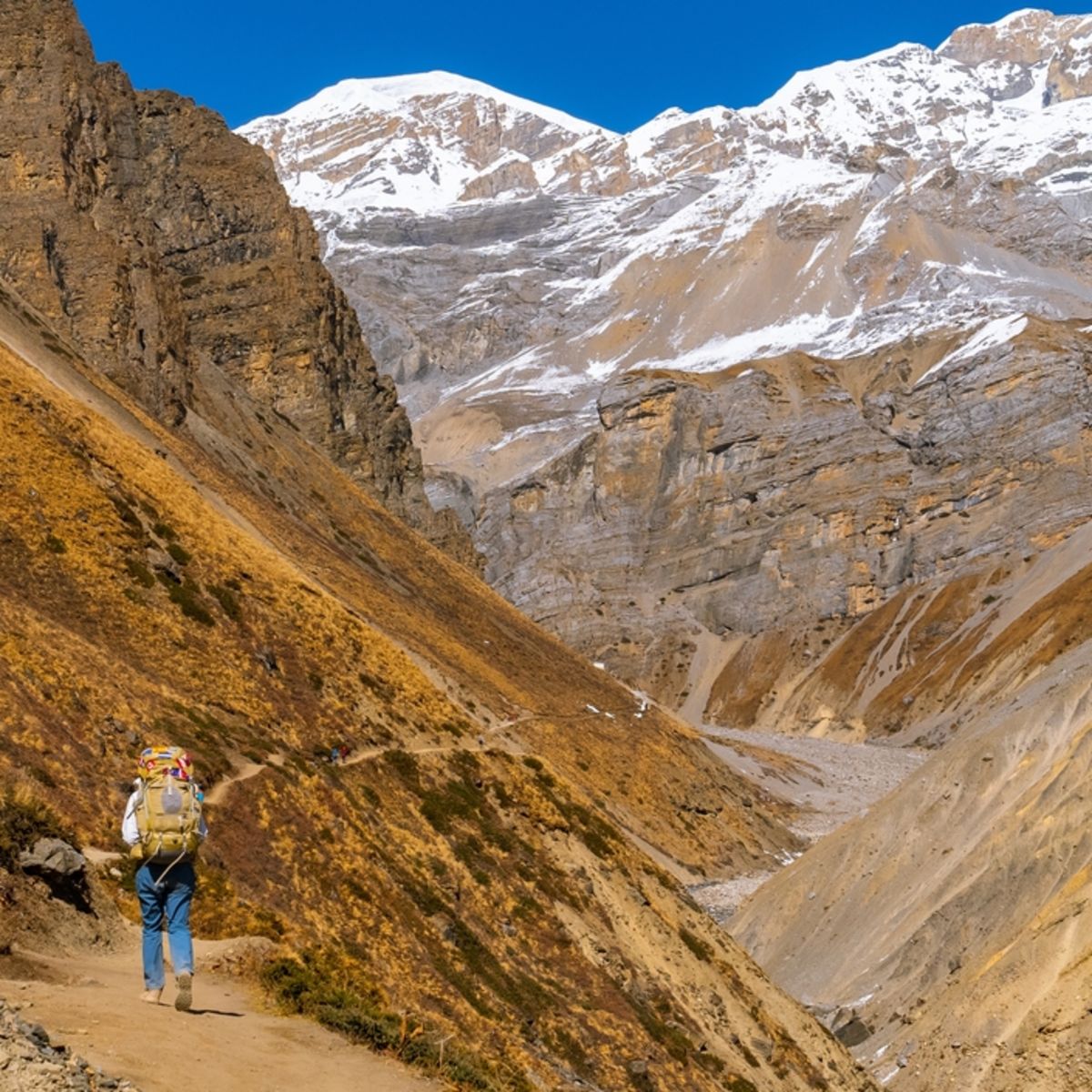
Annapurna Circuit vs Everest Base Camp
So you want to go trekking in Nepal. Wonderful! We want to take you! But do you hike the Annapurna Circuit or to Everest Base Camp? Helping you answer that question is what this post is all about. We talk trek length, difficulty, weather, cost and more!
A note about route variations
Both the Annapurna Circuit and Everest Base Camp treks have variable routes and itineraries that you can follow.
This is because the Everest Base Camp (EBC) trek route has more than one path leading there and back. And you can also add on some exciting detours.
On the Annapurna Circuit (AC), you can now drive some of the initial trek route, meaning you can decide to skip some or all of the early section if you want. And you can also end the trek in different places. And you can add an exciting loop into the Nar and Phu Valleys to make this trek longer.
So as you can see ... variations for both treks are possible!
By the way, if you don't feel like reading any further, but do want to know the differences between the Annapurna Circuit and the Everest Base Camp trek, here's a video to watch instead!
There would be a youtube video here.
Trip duration
At Follow Alice we offer four Everest Base Camp trek routes:
We also offer two Annapurna Circuit trek routes:
Please note that the above durations don't include travel days to and from the trekking trails.
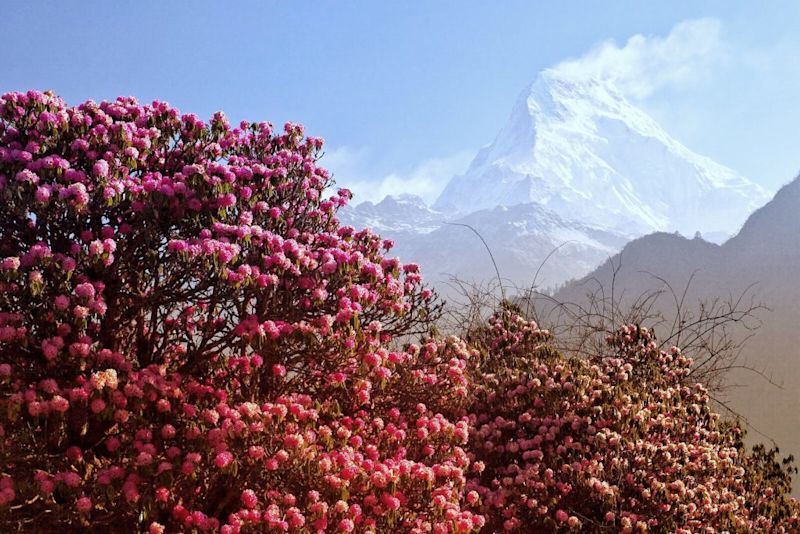
Rhododendrons bloom in the Himalayas in spring
Which one is right for me?
The attractions and pluses of each trek route are many, and it’s mostly your personal preferences which can help you decide if the Annapurna Circuit or Everest Base Camp trek is the better trip for you right now.
The topics we discuss to help you decide include:
- How hard you want to push yourself physically.
- What sort of sights you most want to see.
- How much of Nepal you wish to explore.
- When you want to travel.
- How much you can afford to spend on the trip.
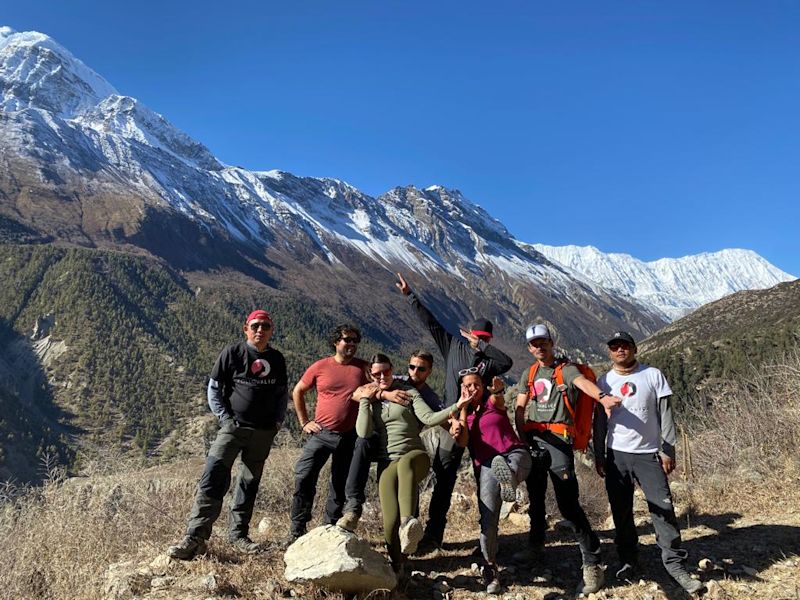
Both the Annapurna Circuit and Everest Base Camp treks take you deep into the Himalayas
Accessibility
The Annapurna Circuit and the Everest Base Camp trek are two very different treks.
Yes, they both take place in the Himalayas in Nepal, and they both involve lots of trekking at high altitude. But they’re incredibly different in many other respects, including the ease with which you can get to them and back again.
The starting point of the Annapurna Circuit trek takes longer to reach than that of the Everest Base Camp trek.
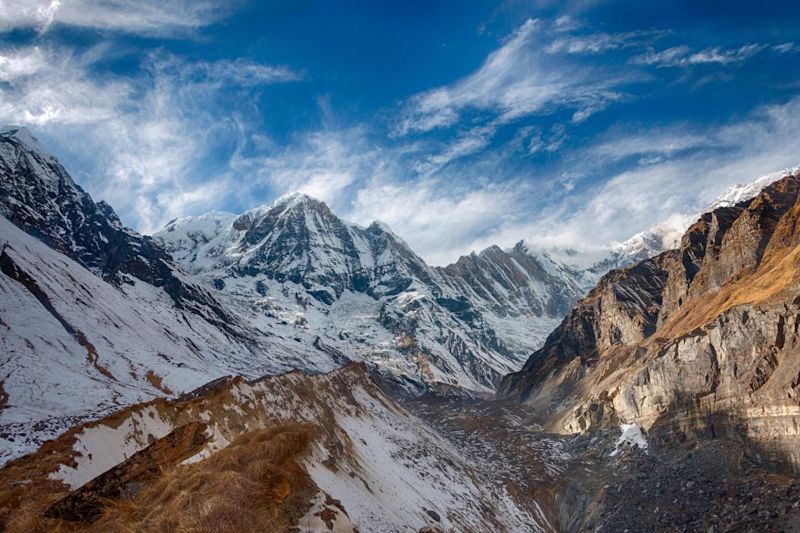
The Annapurna mountains are part of the famous Himalayan range
Getting to the start of the Everest Base Camp trek
For both treks you need to fly into Kathmandu, as already mentioned, as the capital has the country’s only international airport.
Once in Kathmandu, however, those headed to the EBC trek need only take a short 25-minute flight east to the town of Lukla, which is the trek’s starting point.

We fly in and out of Lukla Airport on our way to the Everest Base Camp trek
You could feasibly start the EBC trek the same day you arrive in Nepal! We don’t actually do this, as such rush is unnecessary and risky. Instead, we spend a night in Kathmandu, resting up. Also, a night’s stopover allows some important wiggle room should anyone’s flight into Nepal be delayed.
Important note
As of 2022, you mostly cannot fly directly to Lukla from Kathmandu as there is major airport construction underway and some local flights are consequently not operating. This means you need to drive south to Ramechhap and then fly to Lukla from there. This adds an extra day of travelling on both sides of the EBC trek.
Lukla is a small town 2,060 m (6,759 ft) above sea level. Its airport has a notoriously short runway. Poor weather conditions also can and do delay flights more than is the norm. For this reason our first day of trekking along the Everest Base Camp route is only 5.5 hours, so a delay into Lukla Airport of a few hours doesn’t derail our itinerary.
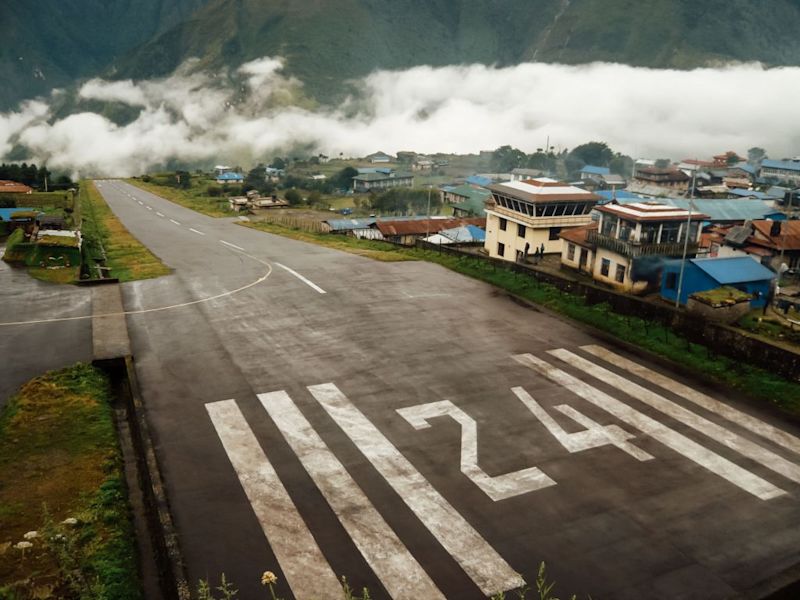
Everyone coming to do the Everest Base Camp trek flies into Lukla Airport
Getting to the Annapurna Circuit
The accessibility of the Annapurna Circuit is a very different matter. After a night in Kathmandu, we have two days of driving in front of us to reach the trek’s starting point. We’ll be driven in a private, air-conditioned vehicle, so it’s nice to know that we’ll be getting there comfortably.
The reason we drive is that you cannot fly to the start of the AC, as with the EBC trek. While you could fly to Pokhara, a city actually known as the gateway to the Annapurna Circuit, you would still then need to hire transport to drive you a long way to the start of the trail.
With Follow Alice you begin trekking the Annapurna Circuit in Pisang, a small mountain village with incredible views!
Follow Alice trekkers are driven all the way to Pisang before they start trekking.
You don't need to travel this far to start trekking the classic Annapurna Circuit route, but because there are now roads connecting many of the villages lower down on the AC, we prefer to skip this section. We're not super fond of walking on jeep track and sharing the way with vehicles. The village of Pisang is where the road ends and from there everyone must proceed on foot. So this is where Follow Alice likes to start the trek.
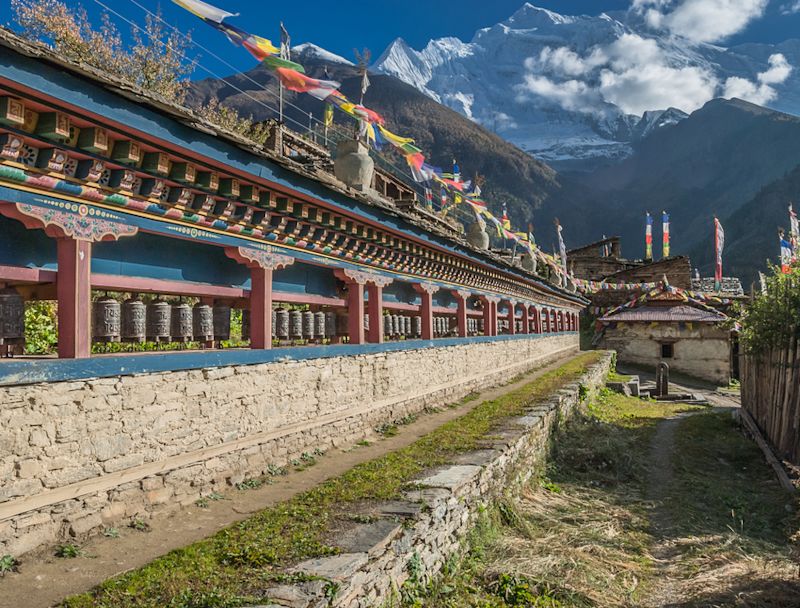
The famous prayer wheel wall in Upper Pisang
Pisang is divided into Lower and Upper Pisang. Lower Pisang is on the south side of the Marsyangdi River, and you must cross a footbridge and climb up a little way to reach Upper Pisang, which is where we overnight before starting to trek the following day.
Getting back to Kathmandu
For Follow Alice trekkers (and many other trekkers), the Annapurna Circuit ends in the town of Ranipauwa in the Mustang District. From here you need to drive south to the airport town of Jomsom. In Jomsom, you catch a small airplane through the staggeringly enormous Kali Gandaki Gorge to the lakeside city of Pokhara.
It's only in Pokhara that you can catch a flight back to Kathmandu.
And so the return journey at the end of the AC trek involves a day of driving and then two short flights. The flights are on separate days, so there's a stopover night in Pokhara. But trust us, you'll be glad for the chance to explore this beautiful and adventure-filled destination!
Communications
Both the Everest Base Camp trek and Annapurna Circuit route have pretty good mobile phone reception and 3G connectivity. Naturally mobile reception can be spotty in certain of the more remote places. But one of the boons of trekking with a local guide – as our clients do – is that guides are able to advise you on the best spots for connectivity.
There are Ncell towers throughout the EBC route that even provide connectivity to those climbing Mt Everest. Many people choose to buy a SIM card in Nepal as the cost of the card and data is so cheap. If you decide to do this, we then recommend going with an Ncell card. Along the AC you should be fine with an Ncell or Nepal Telecom SIM. And you might like to look into buying an eSIM instead of a physical SIM card.
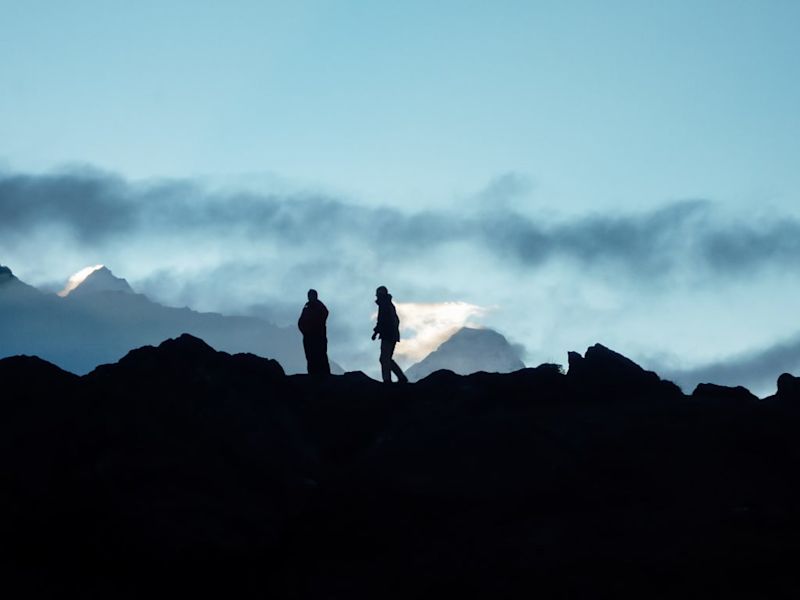
You don't need special skill to trek to EBC or do the AC, but you do need to be fit
Trek difficulty
Both the Annapurna Circuit and the EBC trek are difficult, but still totally doable if you have reasonable levels of fitness and perseverance. We chat in detail in Is the Annapurna Circuit hard? and How hard is Everest Base Camp? about the challenges of each trek. Below, however, we discuss the relative difficulty of each.
Number of trekking days
Let's talk the number of days you'll actually be walking on each trek ...
Everest Base Camp
If you opt for the Everest Base Camp trek with a helicopter return you're on the trail for seven days . This includes six days of trekking plus one acclimatisation day in the middle (although you could do an exciting roundtrip hike on this day if you choose). Note that the day you catch the helicopter you also do a taxing morning hike up Kala Patthar for an unobstructed view of Mt Everest. A great moment. a
On the Classic Everest Base Camp trek as offered by Follow Alice, you're on the trail for 11 days , which includes one acclimatisation day in Dingboche on Day 5. There are some exciting day hikes you can do on this day if you feel up to it.
For the Everest Base Camp and Gokyo Lakes trek you're on the trail for 13 days . This involves 12 days of trekking, plus one acclimatisation day in the middle (on which you could opt to do a great day hike). So if you do the hike, you have 13 consecutive days of walking.
If you tackle the Everest Base Camp and Three Passes trek , you're on the trail for 16 days . Three of these days could be acclimatisation and rest days if you want, although each also has an epic roundtrip hike that you could top to do. On Day 14, for instance, you can rest, or climb up Gokyo Peak for an incredible panoramic view of the Himalayas!
Annapurna Circuit
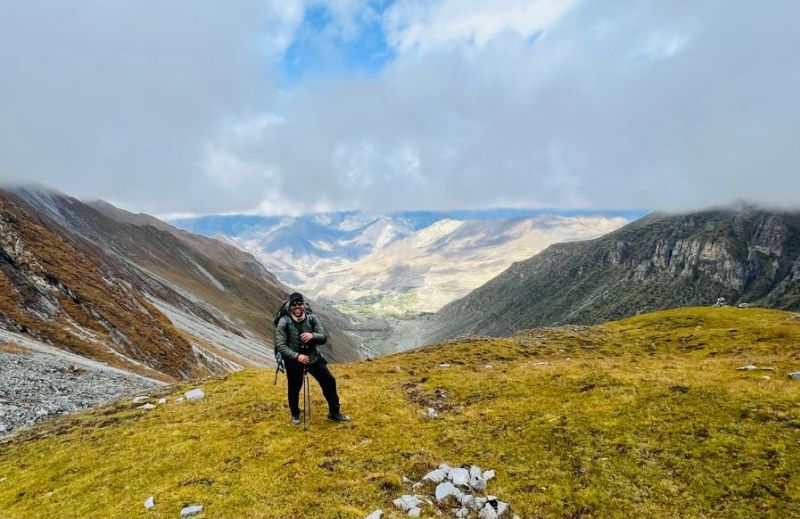
Our client Hala on the long descent from Thorung La to Ranipauwa
With the Annapurna Circuit , you only spend six days on the trek route. Two are acclimatisation days, but there are beautiful roundtrip hikes you can do on those days that allow you to explore more of the area. So that's six days of hiking.
If you opt for the Nar–Phu and Annapurna Circuit trek , you're on the trail for 11 days . One of these days could be a rest day in the village of Phu, or you can do a five-hour roundtrip hike to Himlung Himal Base Camp that day.
Summary: There are long and short itineraries for both EBC and AC
Depending on the itinerary you choose, you can trek for seven, 13 or 16 days in the Everest region. For the Annapurna Circuit, you can trek for just six days, or opt to be on the trail for 11 days.
Distance trekked
Let's now discuss the distances you hike on each trek ...
Everest Base Camp trek
On the Everest Base Camp trek with a helicopter return , we follow the classic route to base camp. This is the most direct route and totals 66 km (41 miles) . However, when you include the optional day hike on your acclimatisation day, as well as the short hike from base camp to Gorakshep (where you sleep that night), and the roundtrip hike to Kala Patthar the morning before your helicopter flight, you actually hike roughly 65 km (40 miles) . If you choose to omit the acclimatisation day hike, you cover 59 km (37 km) overall.
On the Classic EBC trek with our special return route you trek roughly 115 km (71 miles) in total. This includes the trek to Gorakshep after reaching base camp as well as your hike up Kala Patthar the next day, but it doesn't include any hiking you might opt to do on your acclimatisation day.
For the EBC and Gokyo Lakes trek , you cover 135 km (84 miles) in total. This includes the Kala Patthar hike but not the two optional day hikes (which we totally recommend that you do). With those included, you cover 121 km (75 miles). We love this route because you see some different scenery on the return trip because we do a loop instead of heading back the same way we came in. You also see a remoter and quieter part of the region.
For the EBC and Three Passes trek , you cover a whopping 182 km (113 miles) . This includes the Kala Patthar hike. It also includes the Gokyo Peak roundtrip day hike, but not the optional day hikes on the other two rest days. This trek should only be tackled by the very fit.
The Annapurna Circuit is a large loop that takes you through the mountains of the Annapurna Massif. It ranges from 160 to 230 km (99 to 143 miles). The longer route is the path that was popularised in the 1970s. Such a trek takes over a fortnight to complete and nowadays many opt to trek just the middle portion of it.
We at Follow Alice have also organised an abbreviated version of the original Annapurna Circuit trek which takes in just the best-preserved, highest, most remote and prettiest portion of the route. This route is 50 km (31 miles) , not counting the optional day hikes on our acclimatisation days.
Our specific route involves trekking around 50 km (31 miles), not counting the day hikes on our two acclimatisation days.
On the Nar–Phu and Annapurna Circuit trek you traverse 119 km (74 miles) , not counting the optional day hike from Phu. This is, as you can see, the far more arduous Annapurna Circuit option.
Summary: There are long and short distances for both EBC and AC
Depending on the trek route you choose, you can trek for about 65 km (44 miles) on the EBC trek or 121 km (75 miles) on the Gokyo Lakes variation or 124 km (77 miles) on the Three Passes variation.
For the Annapurna Circuit, you can trek for just 50 km (31 miles), or opt to tackle 119 km (74 miles) on the Nar–Phu variation.
The paths along the Annapurna trail are generally in good condition. In some places you actually trek along jeep track, as in recent years the Nepalese Government has been enhancing infrastructure in the area to make it more accessible.
Overall, however, the paths are a bit gentler on the AC than they are on the EBC trek.
We always have a local guide to lead our trek groups, the number one reason being safety. Along the Annapurna Circuit your lead guide is often Sonam Sherpa, and along the Everest Base Camp trek it's usually Oangdi Gurung.
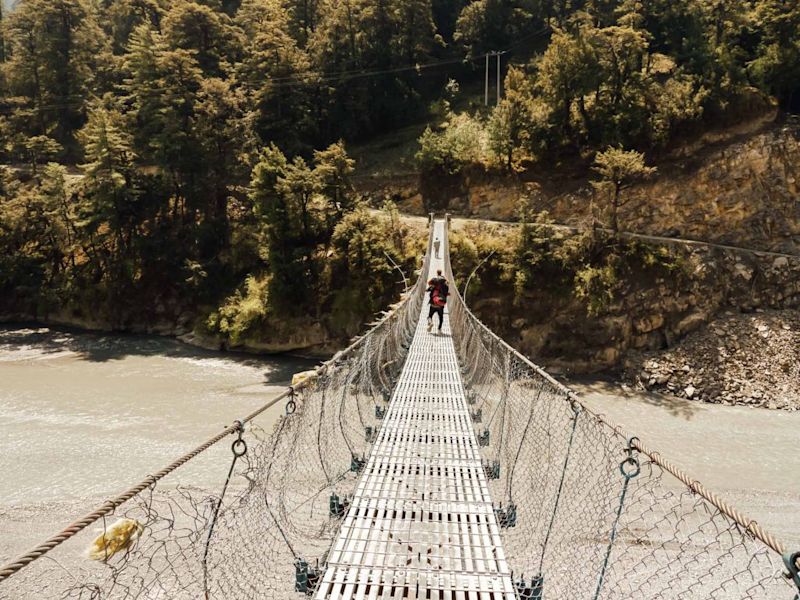
Both the AC and EBC trails include footbridges of various sizes and design
Elevation reached
Both the Everest Base Camp and Annapurna treks lead you very high into the mountains.
Everest Base Camp elevation
The EBC trek starts at 2,860 m in Lukla. Everest Base Camp itself stands 5,364 m above sea level. But base camp isn’t actually the highest point on the trek; we also hike up Kala Patthar (‘Black Rock’), which is 5,643 m above sea level.
That means we ascend a total of 2,836 m during the trek, which is almost three vertical kilometres!
Annapurna Circuit elevation
The Annapurna Circuit requires us to trek to a slightly lower altitude than the Everest Base Camp trek, as shown in the graph below.
The AC trek begins in Upper Pisang, which is a village 3,300 m (10,827 ft) above sea level. Over the next few days we climb to the circuit’s highest point – the mountain pass called Thorung La – of 5,416 m (17,769 ft) above sea level. That’s a climb of 2,216 m (7,270 ft).
After Thorung La, we drop down by 1,161 m (3,809 ft) to the village of Ranipauwa in just one day! So this day can be a bit taxing on the knees.
Summary: The EBC trek involves a bigger jump in elevation
The Everest Base Camp trek route requires you to climb just a little further in elevation than the Annapurna Circuit. If you enjoy figures, you might like to know that you achieve an elevation gain that's 227 m (745 ft) more on the EBC trek than that of the AC.
When you include the hike up Kala Patthar, your altitude gain on the EBC trek is 568 m (1,863 ft) more than on the AC.
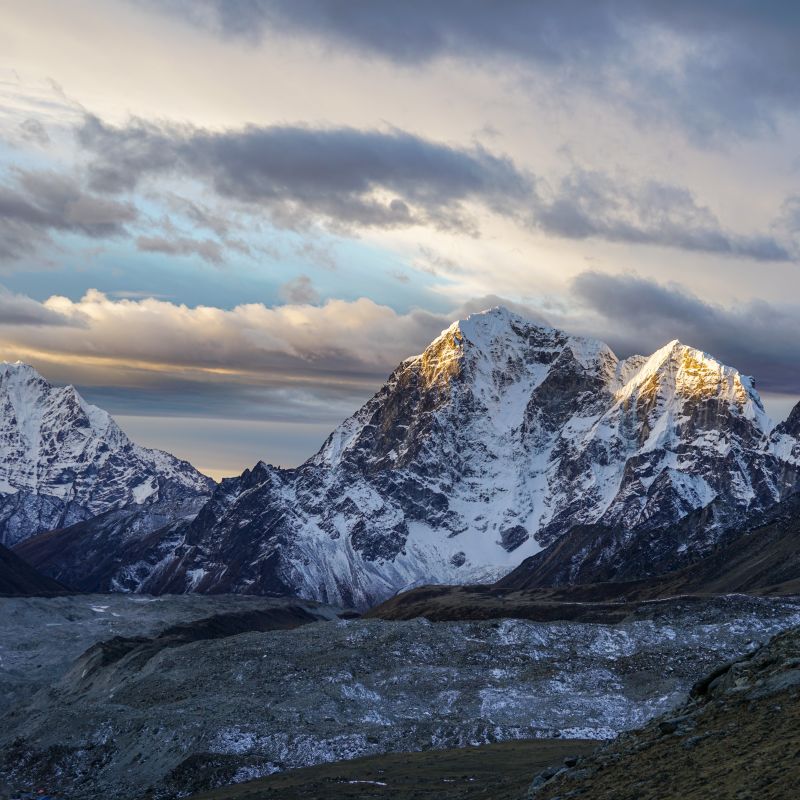
A glorious morning view from atop Kala Patthar
Time spent at altitude
By comparing the above two elevation graphs we can also see that the Everest Base Camp trek involves spending much more time above 5,000 m than does the Annapurna Circuit trek route. This means more time in rarified air, where exerting yourself is far more exhausting. The mental and bodily strain of the EBC trek is therefore more than that of the AC.
It’s important to note that the higher you climb, the more chances you have of developing altitude symptoms, such as headaches and dizziness. These aren’t too problematic, and can be medicated to a degree. The only problem is if you develop severe mountain sickness.
When you engage in high-altitude trekking, especially for the first time, it’s important to understand and accept that if you develop severe symptoms you’ll have to abort your trip and descend quickly to a lower altitude.
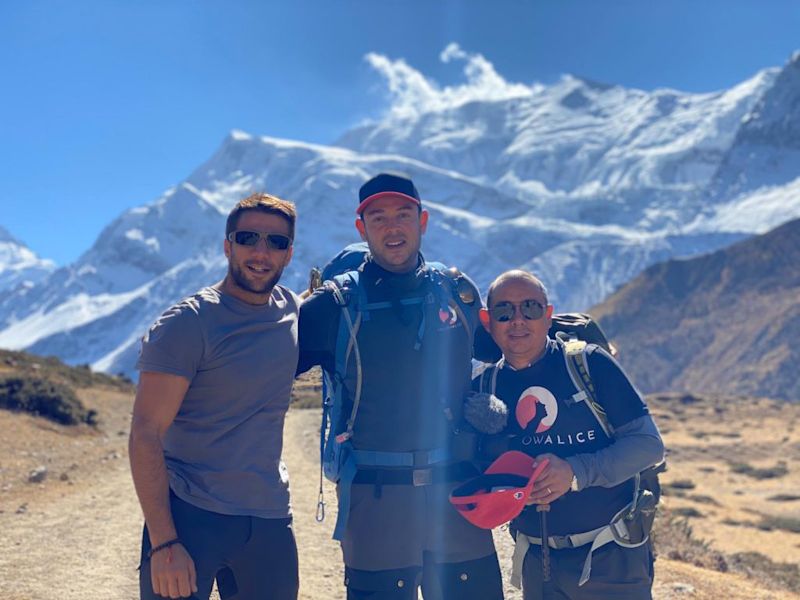
On the Annapurna Circuit you climb well above 5,000 m
The risk of severe altitude sickness
It's very rare for trekkers to develop severe altitude sickness, but it does occasionally happen.
The risk of a ruined trip due to severe altitude sickness is slightly higher on the Everest Base Camp trek than on the Annapurna Circuit, as with the former you climb higher and also spend more time at high altitude. Further, the Everest Base Camp trek allows only one acclimatisation day, while the Annapurna trek has two worked in.
If you’ve never trekked at altitude, the Annapurna Circuit is probably the smarter option.
Firstly, given that you don’t have to climb quite so high on the Annapurna Circuit, the toll on your body from the thin air will be a little less. This trek could serve as a testing ground for you ability to cope with altitude. (Note that altitude sickness strikes randomly, and even the fittest of people can suffer from it.)
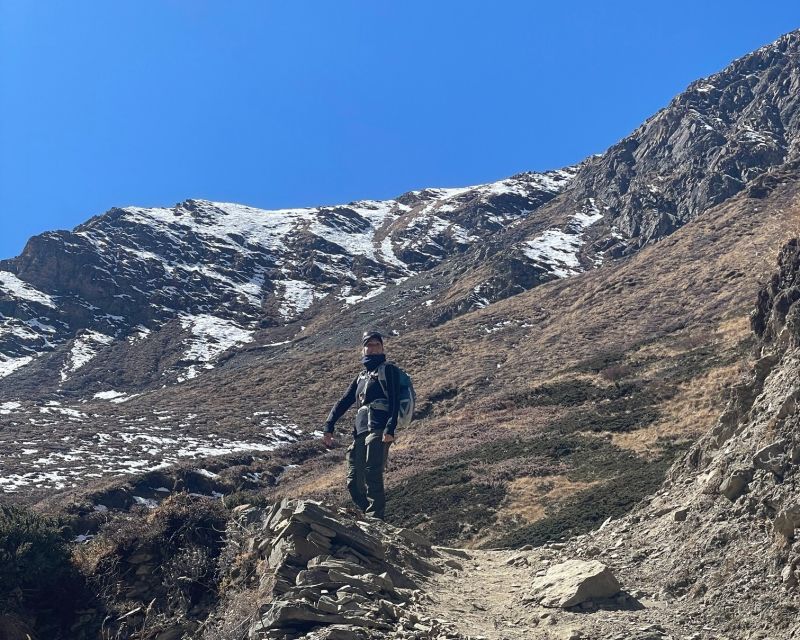
High up on the Annapurna Circuit
Secondly, the Annapurna Circuit is a shorter trek, so if you develop severe symptoms and have to turn back, you’d be missing out on fewer trekking days.
And thirdly, the Annapurna trip as organised by Follow Alice includes quite a few days of travel and sightseeing at low altitude, so even if it turns out that you can’t complete your trek owing to severe altitude sickness, there would still be a lot else to look forward to and enjoy with your travel companions.
Weather is a major deciding factor when it comes to planning any high-altitude trek. It simply has to be.
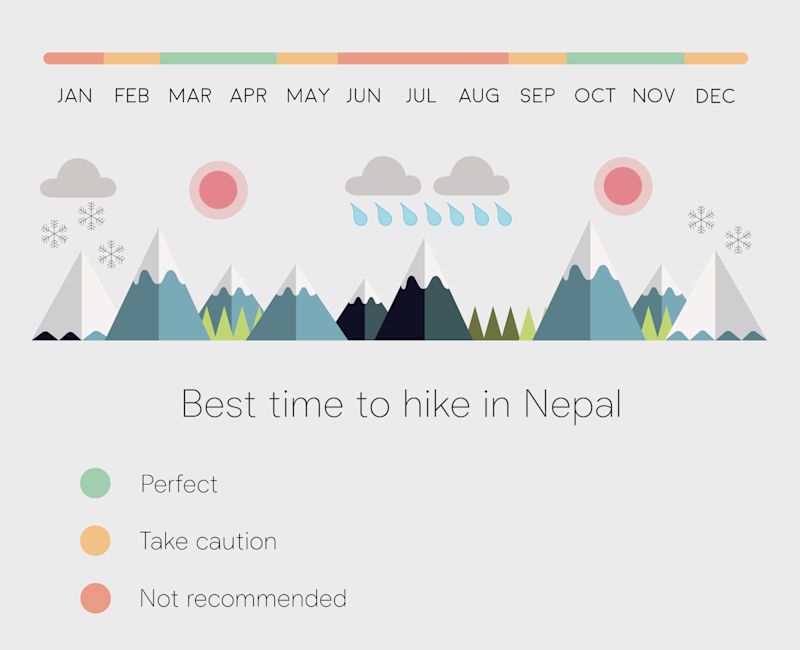
The weather in the Himalayas is both highly variable and at times extremely dangerous. The Everest Base Camp trek is in Nepal’s eastern Himalayas, and the Annapurna Circuit in the central Himalayas. While the weather patterns are similar in both regions, the timing and intensity of the various weather systems affecting them do differ a little.
Learn more about the Best time to hike the Annapurna Circuit and Best time for the Everest Base Camp trek .
Summer monsoon
In summer Nepal is affected by the Indian monsoon , the world’s most prominent monsoon system. The monsoon brings lots of rain, high temperatures and humidity to the Himalayas from June to September. In fact, Nepal receives 80% of its rainfall during summer.
The two main weather systems that we as trekkers have to consider are the summer and winter monsoons.
Very few embark on the Annapurna or Everest Base Camp treks in summer, as the rains make the trails slippery and dangerous, never mind the obvious unpleasantness of hiking in downpours. While parts of both treks take you into the rain shadow of the high Himalayas, the lower parts of the trek routes are very much affected by the monsoon rains and so make summer a bad time for trekking.
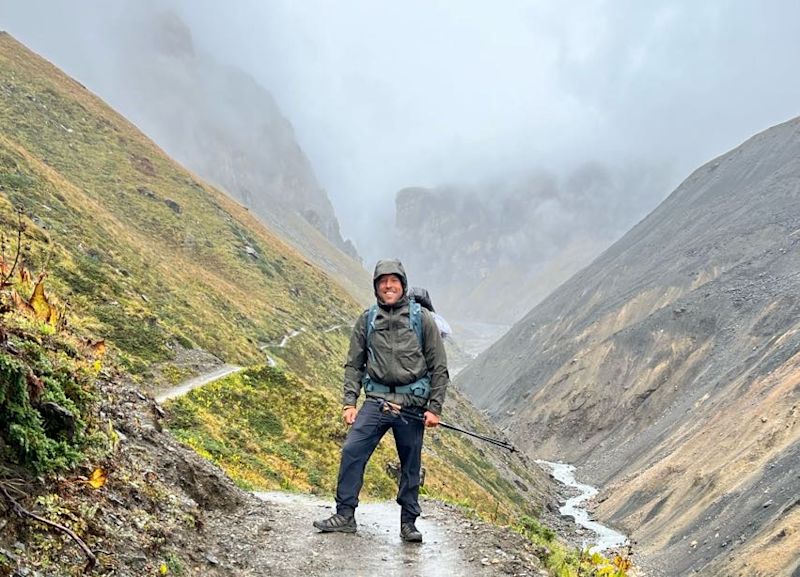
Our client Hala braving the elements on an autumn Annapurna Circuit trek
Winter monsoon
The winter monsoon brings cold temperatures, wind and snow from northern Asia to Nepal between December and February. Some intrepid souls choose to hike the Annapurna Circuit and Everest Base Camp trails in winter, but they are by far the minority.
The trails are certainly much quieter in winter, and the views often crisp, but the temperatures are icy, and night-time temperatures can drop to around –20° C. Also, the wind chill can drop the temperature by a further 10 degrees. Further, the chances of high passes being closed as a result of snowfall mean you can become stranded. Finally, certain passes (like the one to Gokyo Lakes) are routinely closed in winter, leaving only certain routes open to winter trekkers.
For most of us, travelling to Nepal is a major expense and time commitment, and so it’s important to choose a window of time that can best guarantee the sort of weather to make the trek both feasible and enjoyable.
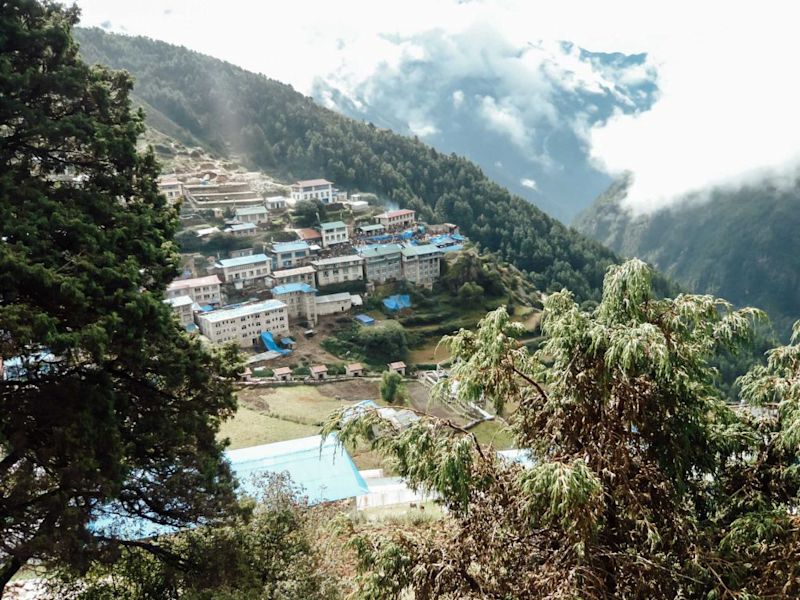
Both the AC and EBC trek routes have sections in a temperate zone
It’s arguably wiser to only take on Everest Base Camp or the Annapurna Circuit route in winter if you’re a very experienced trekker and know that you know you have all the necessary equipment and clothing.
Peak seasons
Peak seasons for both the Everest Base Camp and Annapurna treks are spring and autumn. Seasonal changes reach both regions at roughly the same time.
Everest Base Camp trek peak seasons
Peak seasons for the EBC trek are late March to mid May (spring) and late September to November (autumn).
Many enjoy trekking in spring because this is when Everest Base Camp is an active site, full of yellow and orange tents, mountaineering equipment and excited summitters. Given that the destination of this trek is Everest Base Camp, it’s incredibly special to arrive to the sight of such activity and endeavour.
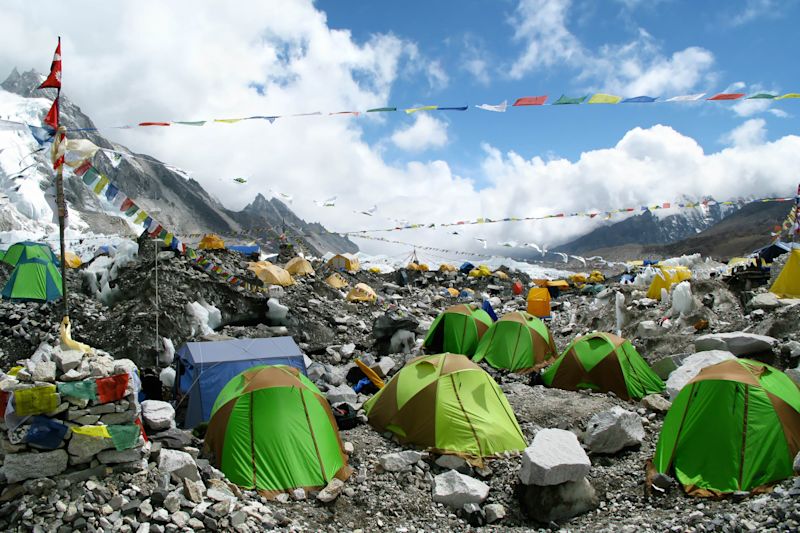
Everest Base Camp in the climbing season
At other times of the year, one’s experience of reaching Everest Base Camp is of approaching an empty expanse that you only know to be your destination because of a sign surrounded by wind-battered prayer flags.
The other peak season – autumn – is the more popular trekking time with many because of the temperate weather and clear views. Many of the flowers will, however, be gone by this time of the year.
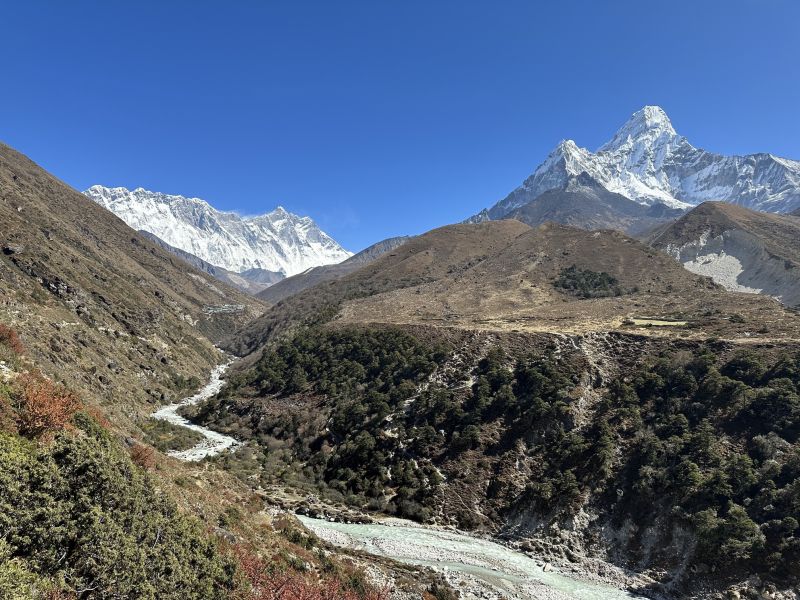
Our client Ross Anker took this pic along the EBC trek in autumn
Annapurna Circuit peak seasons
Peak seasons for the Annapurna Circuit are April and May (spring) and October and November (autumn).
Each peak season has different perks and drawbacks. Spring, for instance, offers beautiful flowers, but there can be a bit of a haze at times. Autumn, on the other hand, offers steadier, warmer weather and better visibility, but you don’t have the spring flowers and fresh greenery along the lower half of the trek route.
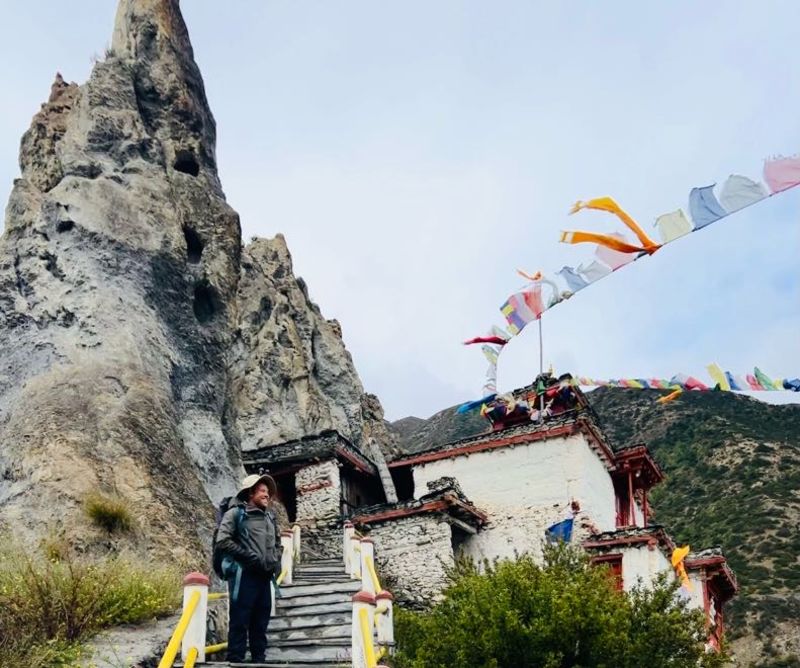
Our client took this snap along the Annapurna Circuit in autumn
Crowds
Both the Annapurna Circuit and EBC treks have grown in popularity in recent decades.
There are pros and cons to this, such as better services and crowded trails respectively. If you choose to go in a peak season, which many do for the better weather, you have to accept that you’ll be sharing the route with many other trekkers.
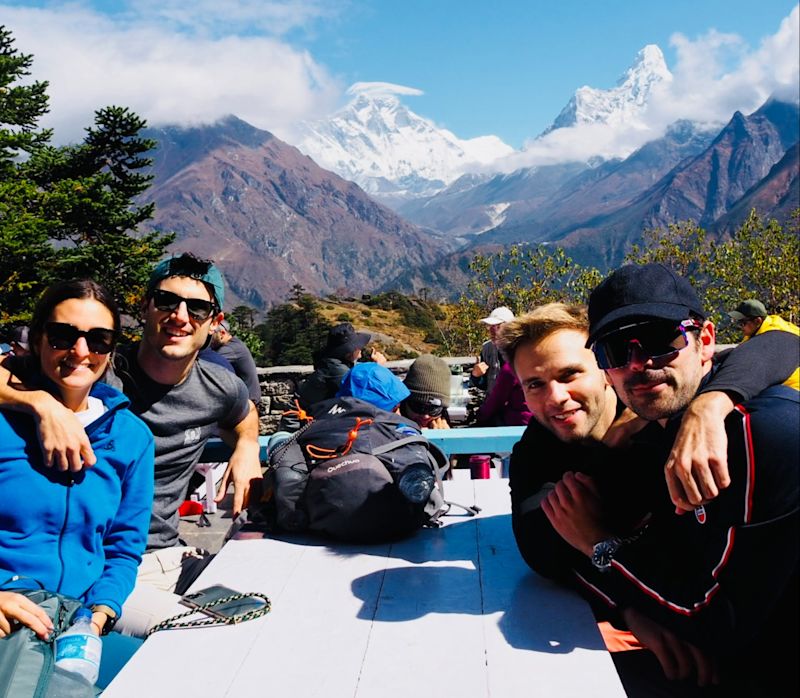
Lunch stop at a restaurant along the EBC trek
Everest Base Camp trekker numbers
According to Nepal Tourism, in 2016 over 45,000 foreigners visited Sagarmatha National Park.
Mt Everest, Everest Base Camp itself, and most of the EBC trek route lie within this park, and there are no roads, so we can take this number as a good indication of combined trekker and mountaineer numbers.
The bulk of EBC trekkers hike the route in one of the two peak seasons. A few hundred trekkers can join the route each day in peak season. Consequently lodges and teahouses along the route can and do fill up over peak seasons and sometimes there are overflow trekkers who have to pitch tents for the night. At Follow Alice we book our accommodation ahead of time to ensure we have enough beds for bodies.
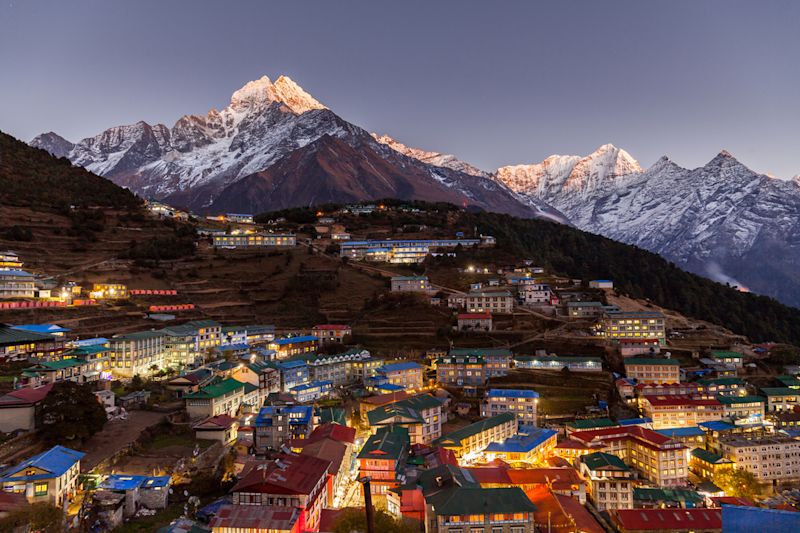
Namche Bazaar is a bustling town along the EBC trek
Annapurna Circuit trekker numbers
According to UNESCO, Annapurna receives about 60% of Nepal’s international trekking visitors , making it the more popular trekking area in terms of numbers.
However, there are no specific trekker numbers for the Annapurna Circuit, as there are other trekking routes in the Annapurna Massif such as the Annapurna Base Camp trek.
While we can’t put a finger on exact numbers, again we do know that lodges and teahouses along the Annapurna Circuit fill up during peak seasons, so we know that a few hundred trekkers can join the route each day in peak season.
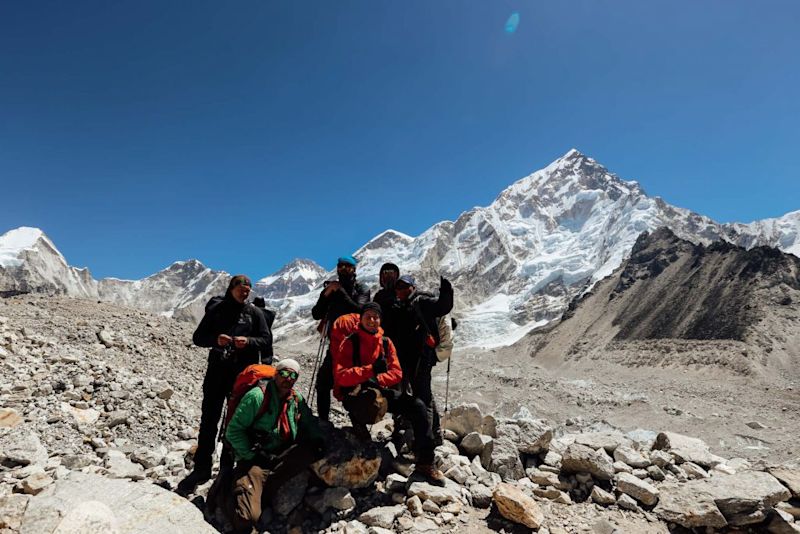
Trekkers on the Annapurna Circuit
As you can see, both EBC and Annapurna have similar peak trekking seasons, as the weather is much of a muchness along both trek routes at any given time of the year. If you choose to embark on one of the trips with Follow Alice – and we hope you do – then you can either check out our scheduled departures, or suggest a date of your own. We're very flexible with dates.
And yes, if you want to be He-Man or She-Ra, you could trek Annapurna and then trek EBC straight after!
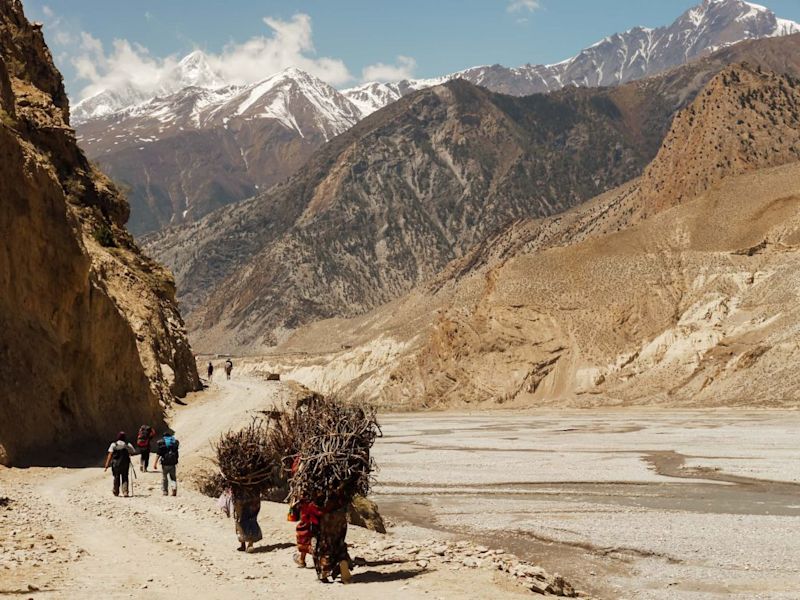
Some of the 'crowds' on the Annapurna Circuit are local people going about their daily business. It's a privilege to see how life is lived in such a different part of the world.
Every holiday requires you to crunch some numbers, including those important money numbers. That said, if you travel with Follow Alice, the maths becomes far simpler, because you only have two main outlays: your flights, and your Follow Alice fee.
If you have limited or no previous experience of trekking, then you may also need to invest in some equipment, which would be another important expense to consider.
International flights
The price of flights will obviously be the same, as you can only fly into Kathmandu, as previously discussed, because Nepal only has one international airport.
Follow Alice fee
There are many good reasons to travel with a tour operator when embarking on an adventure holiday like trekking to EBC or along the Annapurna Circuit. An obvious reason is safety, another that most of the admin and busy work is taken care of for you.
With Follow Alice you pay a once-off package fee that covers almost every single cost you might incur within Nepal.
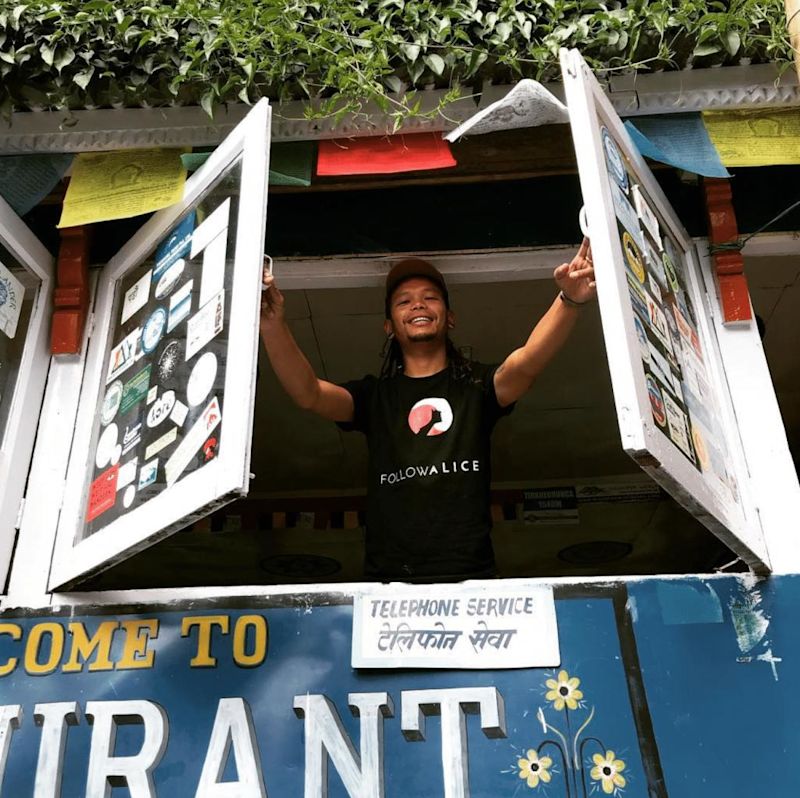
Oangdi is one of our fabulous Nepal trek guides
The longer the trek, the more expensive it is, naturally. Also, a helicopter flight back from EBC adds substantially to the fee.
For instance, the Follow Alice Annapurna Circuit cost covers all transport within Nepal, all accommodation, nearly all meals, all park and other permits, and the tour guide and porter fees. The Everest Base Camp cost similarly covers all transport within Nepal, all accommodation, nearly all meals, all park and other permits, and the tour guide and porter fees.
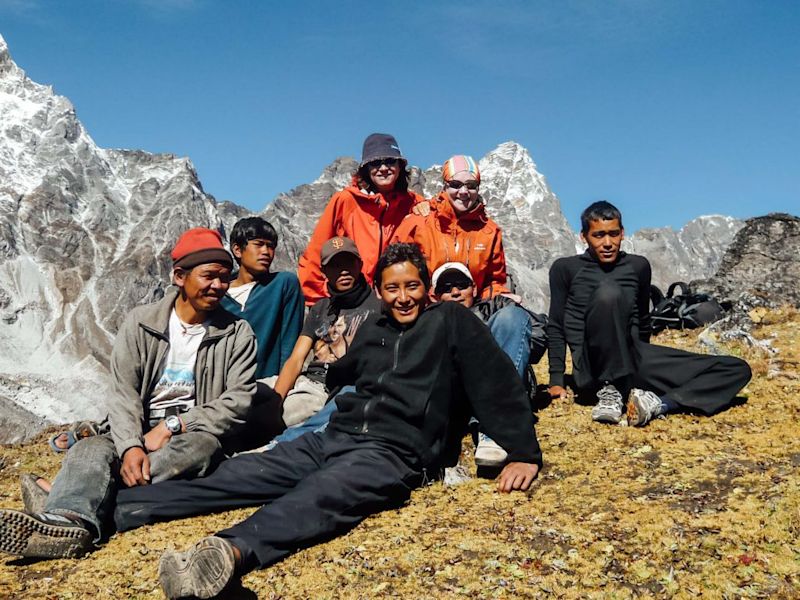
Trekkers taking a load off for a moment along the Everest Base Camp trek
For first-time trekkers, or those who haven’t before trekked at high altitude, there will be a necessary financial outlay in obtaining the gear needed for the cold and harsh climates hiked in the higher parts of both of the treks. Your Annapurna Circuit packing list and Everest Base Camp packing list are however the same, as both require sturdy, warm and waterproof equipment, clothes and accessories.

You need sturdy trekking equipment to hike in the Annapurna Mountains
Many trekkers hire some of the more expensive equipment upon arrival in Nepal. Kathmandu is awash with stores hiring (and selling) everything a trekker might need, like sub-zero sleeping bags and trekking poles.
Famous mountains
One of the primary reasons any of us head to Nepal is to witness the majesty of the Himalayan peaks.
Mountains of the Everest Base Camp trek
The EBC trek has the obvious – and understandable – allure of bringing you into close quarters with the King of the Mountains: Mount Everest. The mythos surrounding this giant makes this trek something of a pilgrimage.
As you likely know, Mt Everest was first summited by the Sherpa Tenzing Norgay and the Englishman Sir Edmund Hillary in 1953 . It’s an incredibly dangerous mountain to climb, and has claimed many intrepid lives.
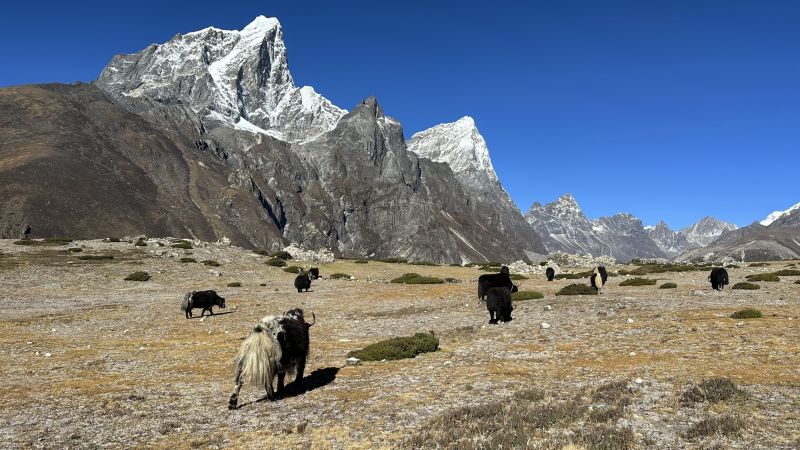
You trek among spectacular mountains throughout the EBC trek
Other noteworthy peaks of the Everest Base Camp trek
The Everest Base Camp trek isn’t only about Mt Everest though. You are also rewarded with views of other significant and beautiful mountains, which include:
- Ama Dablam (6,812 m). This distinctly shaped mountain is a favourite with many Everest Base Camp trekkers because it keeps you company to the right for a few days along the trail. It’s steep faces are dramatic and its sharply jutting peak make it unique and memorable among the rest of the peaks. The ridges on each side of the main peak are said to resemble the arms of a mother protecting her child.
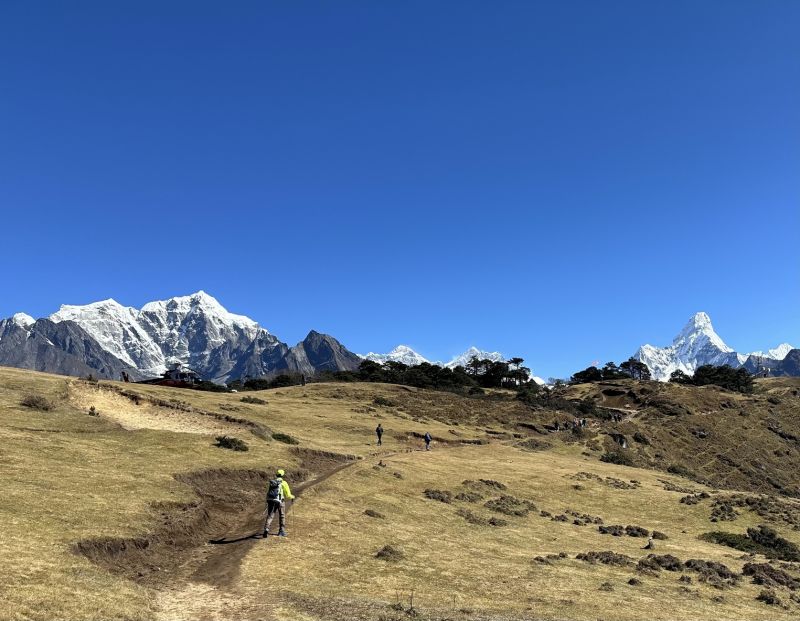
Ama Dablam (to the right) is a favourite mountain with many EBC trekkers
- Cholatse (6,440 m) and Taboche (6,542 m). These two peaks are connected by a long ridge. The Chola glacier slides down the east face of Cholatse, while Taboche towers above Dingboche, where we spend a night on the outgoing trek. When we head back from Everest Base Camp we trek straight towards these two peaks.
- Nuptse (7,861 m). This is a stately mountain when viewed from the south that lies just 2 km west of Everest. Though a thousand metres shorter, it more than holds its own next to its illustrious neighbour.
- Cho La Pass (5,420 m). This pass is special because we actually cross it! The views down to the villages of Dzongla and Thagna are fantastic, not to forget the views out to numerous other peaks.
- Gokyo Ri (5,357 m). This peak sits adjacent to the Ngozumpa glacier, which is Nepal’s largest. We trek to its namesake town of Gokyo on our return route.
There are, of course, many other peaks crowded into the Khumbu region where we do the EBC trek, but we can’t name them all here. It’s best you just do the trek to see them all for yourself!
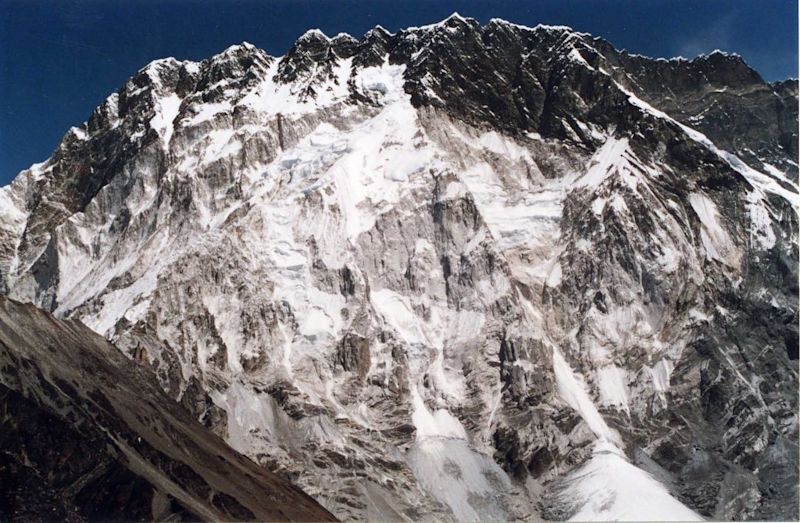
Nuptse, view from Chukhung River
Mountains of the Annapurna Circuit
The Annapurna Circuit also offers up-close-and-personal views of some extremely high and awesome mountains. Because the mountains here are part of the Annapurna Massif, they don’t always rise from such depths, but they still reach amazing heights.
Eight of the 14 tallest mountains in the world are in Nepal!
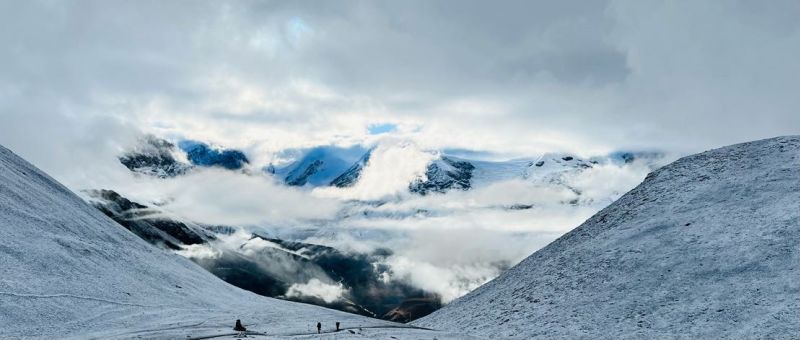
The view from atop Thorung La
Noteworthy peaks of the Annapurna Circuit
Annapurna I (8,091 m), the alpha male of the Annapurna region, is the world’s tenth highest mountain. Other noteworthy peaks on display during the Annapurna Circuit trek include:
- Annapurna II (7,937 m). This is the world’s 16th highest peak. It’s also the easternmost peak of the Annapurna range, so the first one we see when we join the circuit. It’s a stunner.
- Khangsar Kang (7,485 m). This peak is adjacent to the ice lake of Kicho Tal. We hike to the lake while acclimatising for a couple of days in the town of Manang. When at the ice lake we’re surrounded by a glorious 360 degrees of snowy mountain peaks.
- Chulu (6,584 m). This is a popular summiting mountain. If you take binoculars on the trek (a good idea), you might like to look for little ant people ascending it.
- Machhapuchhre (6,993 m). This mountain is off limits to climbers to maintain its shape and health. We’re more than happy with this decision, as its sheer slopes are a thing of true beauty.
- Dhaulagiri (8,167 m). This mountain - the seventh highest in the world! - is to the west of the Annapurna Circuit. Its name means ‘dazzling, white, beautiful mountain’. We see it near the end of our trek when we descend into the Mustang District.
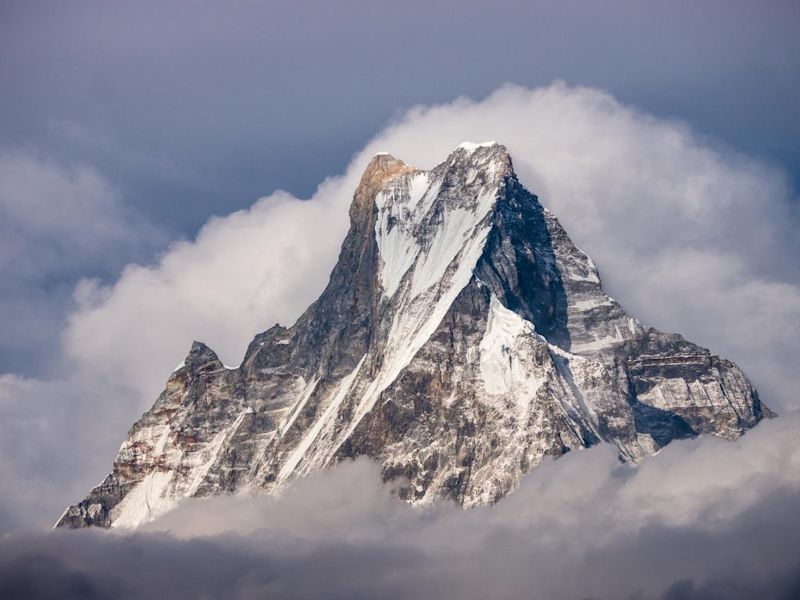
Machhapuchhare viewed from Tadapani
Culture and religion
The Everest Base Camp trek takes place in Nepal’s eastern Himalayas, while the Annapurna Circuit is in the country’s central Himalayan region. There are many similarities between the peoples of the two regions, but also significant differences.
The Sherpa of the Everest Base Camp trek
If you’re someone who likes to immerse yourself in just one area and culture rather than contiki-ing your way through a holiday, then the EBC trek is for you. This part of the Himalayas is home to the Sherpa people. The Sherpa are famous worldwide for their mountaineering feats, which are made possible by how well they cope with high altitude.

A beautiful Sherpa girl with her goat
The Everest Base Camp trek exposes you to the culture of the Sherpas. The Annapurna Circuit exposes you to the cultures of various distinct people groups.
The Sherpa people are mostly Tibetan Buddhist. Buddhism was brought to the area in the late 1600s and largely replaced the animism that previously held sway. The EBC trek exposes you to many colourfully decorated Buddhist buildings and monuments. There are the well-known stupas, for instance, which are hemispherical monuments that mark a significant spot or house relics. These can be found throughout the Khumbu region.
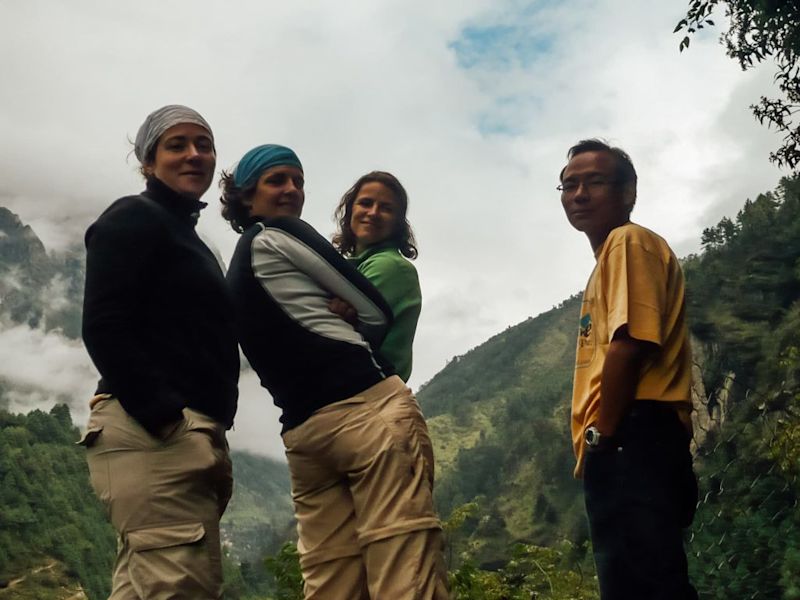
Everest Base Camp trekkers looking pretty pleased with their lot
Different people groups of the Annapurna Circuit
The Annapurna Circuit exposes you to many more cultures and communities than does the EBC trek. It actually gives you a better perspective of the people groups of Nepal. This is because the majority of Nepalese people are of Indian heritage and Hindu faith.
Manang District
The first half of the Annapurna Circuit (the eastern half), takes you through the Manang District of Nepal. In the subtropical, lowland part of Manang you’ll meet the Chhetri people, who migrated to the Himalayas hundreds of years ago from India. The Chhetri constitute over 15% of the Nepalese population. This region is also home to the Brahmins, which is a name many westerners know because priests in the Hindu religion come from the Brahmin caste.
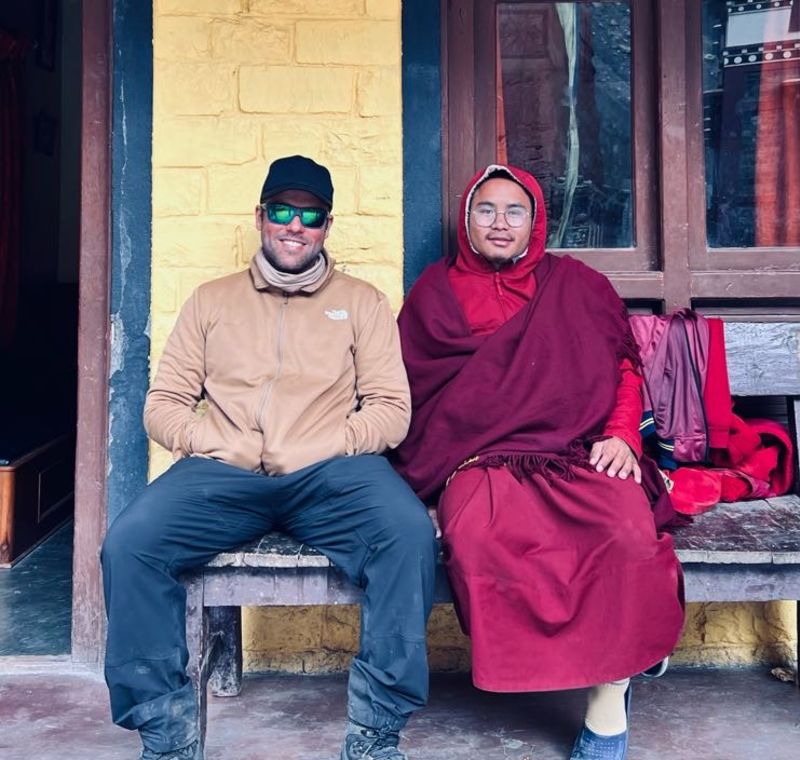
Our client Hala Macknight connecting with a local monk on the circuit
Hinduism is a prominent religion in the Annapurna region. Annapurna is actually the Hindu goddess of food and nourishment. The mountains are named after her as she’s believed to reside there. The fact of the Hindu-origin name is another indicator that the cultural tradition of this central region of the Himalayas is very different from that of the Khumbu, where Tibetan Buddhism dominates.
Hinduism is a prominent religion in the Annapurna region.
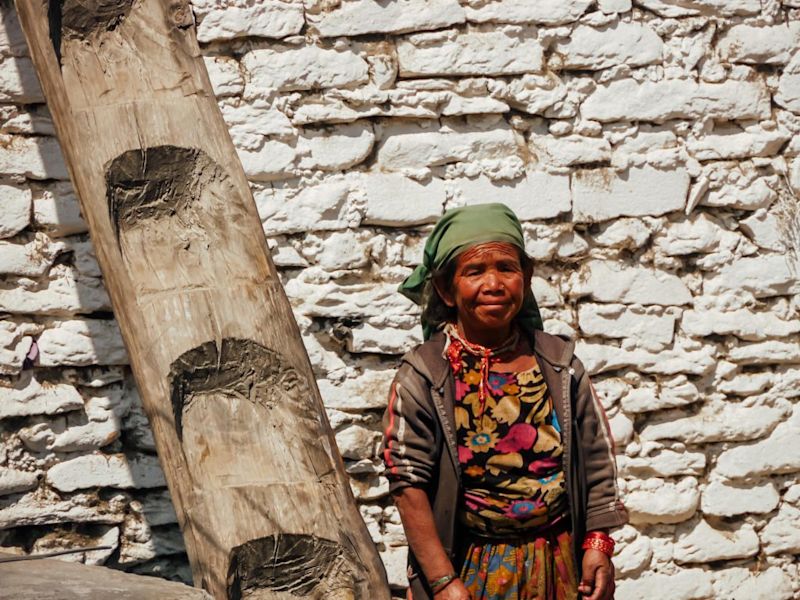
The Annapurna region is home to many different people groups with differing histories, languages and religions
When you climb higher into the Annapurna mountains you start to encounter communities where the inhabitants have stronger ethnic, cultural and religious ties to Tibet than they do to their fellow citizens of Indian descent. The people therefore look different, dress differently, build differently designed buildings, speak different languages, and on it goes. Stupas and other Buddhist structures start to crop up.
Mustang District
During the second half of the Annapurna trek one descends from Thorung La into the Mustang District. This region is home to people like the Manangi, Magar and Thakali. Again, they have their own distinct identities linked to the Mustang region and its history.
Tibetan Buddhism and Hinduism aren’t the only religions followed by the people of the Annapurna region. There are also adherents of Bon, shamanism and animism.
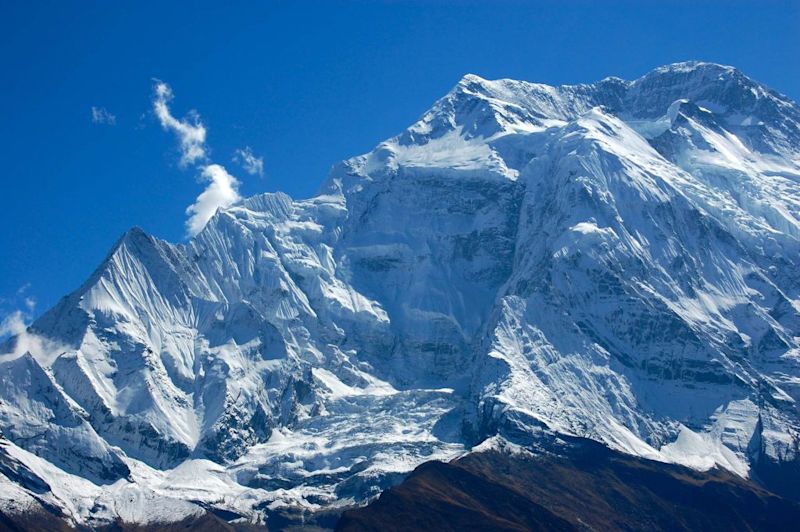
View of Annapurna II from the north, as we see it on the Annapurna circuit trek. Does anyone else see the face in the mountain? Could it be Annapurna herself?
Cultural sites
We can’t mention every village, gompa, monastery and prayer wall that is noteworthy, beautiful and deserving of a mention, so we’ll just mention a few that represent that spectrum. They’ll whet your appetite while keeping some things a surprise. And also perhaps help you in your Annapurna versus Everest Base Camp ponderings.
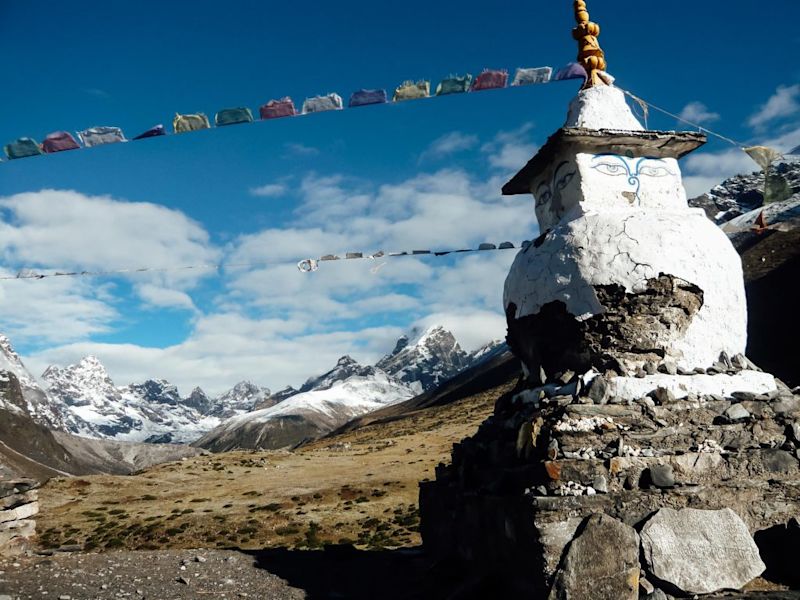
One of many stupas on the EBC trek route
Everest Base Camp cultural attractions
Almost everyone trekking to Everest Base Camp stops over in Namche Bazaar for at least one day to acclimatise. We do the same. Fortunately, there’s plenty of sightseeing to do within Namche Bazaar, not to mention a few great day hikes. We recommend visiting the Sherwi Khangba Center. It has a wonderful Sherpa Culture Museum as well as a Sherpa Culture Photo Gallery.
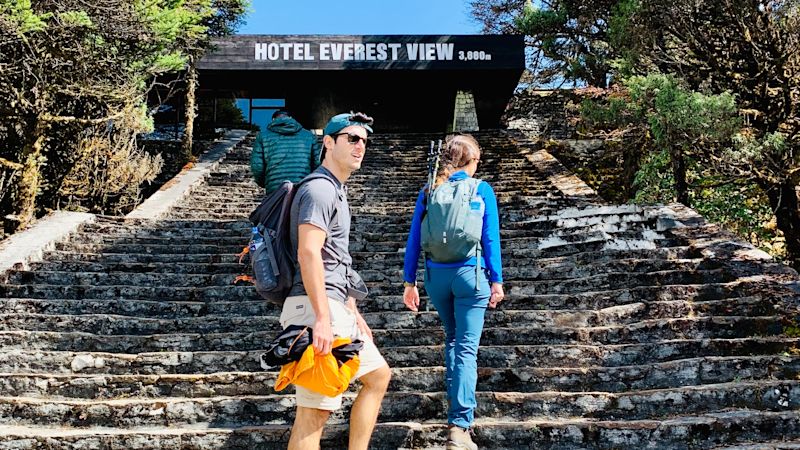
Walking up to Everest View Hotel
If you decide to do a hike from Namche Bazaar, you should definitely stop for a drink at Everest View Hotel. You can enjoy a 360-degree view of the mountains around you at this uniquely placed hotel.
Further along the trail we stop over for a night in the village of Tengboche. Here we have the chance to visit Tengboche Monastery, the largest monastery in Khumbu . The colourful monastery, also known as Dawa Choling Gompa, is home to about 60 Tibetan Buddhist monks. The monks wear the traditional and distinctive maroon robes.

Close up of some of the prayer wheels that make up the Tibetan Buddhist Prayer Wheel Wall of Upper Pisang, a village along the Annapurna Circuit trek
Tibetan Buddhism is a type of Buddhism that developed in the eighth century in Tibet. It involved mixing Buddhism with the indigenous Tibetan religion of Bon. The present-day leader of Tibetan Buddhism, as you likely know, is the Dalai Lama, who lives in exile in India.
Annapurna Circuit cultural attractions
In Upper Pisang, which we visit on Day 4 of the trek, there is the long Tibetan Buddhist Prayer Wheel Wall. This is an oft-photographed site along the trek. It consists of a line of hand-carved cylindrical copper wheels that you roll with your hand.
On our second day of acclimatisation in the town of Manang we recommend a visit to the Himalayan Rescue Association clinic. Established in 1981, the clinic seeks to protect trekkers in the Annapurna region through both education and emergency assistance. You can also learn about the 2014 snowstorm disaster and what was done to assist trekkers during that fateful time.

A suspension bridge near Kagbeni
After the trek we visit the mediaeval riverside village of Kagbeni. Here one finds the Kag Chode Thupten Samphel Ling Gompa, which means Monastery of the Place to Stop and Develop Concentration on the Teachings of Lord Buddha. The monastery was founded in the fifteenth century and is still in use today. It's painted a striking orange and has a desolate mountain dropping scree at its feet as a neighbour.
Prayer flags
Wonderfully, the colourful Tibetan prayer flags we’ve all come to associate with the Himalayas are to be found in abundance along both the EBC trek and the Annapurna Circuit.
On both treks we see prayer flags strung from religious buildings as well as from homes, businesses and bridges. They’re placed where they are to bless the area and promote peace, compassion and wisdom. For many of us, a trek without prayer flags wouldn’t really feel like a Himalayan trek at all. That's how synonymous they've become with the region.
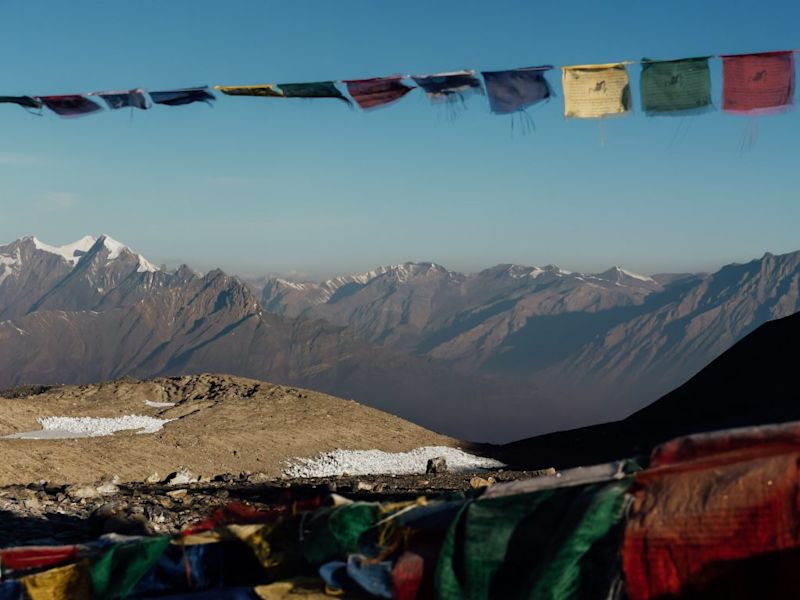
Prayer flags are iconic to the Himalayas
Trek route variety
When it comes to sheer variety, the Annapurna Circuit route beats out the Everest Base Camp route . Not only is the Annapurna region more culturally diverse, as already touched upon, but the landscape, wildlife and trek route offer many more shifts and surprises.
For starters, the Annapurna trail is a roughly circular route . This means you never have to retrace your steps, which for some is important.

Trekkers en route to Thorung Phedi on the Annapurna Circuit
On the EBC trek, the only way into Sagarmatha National Park is through the Khumbu Valley. The start and end days of the trek must therefore necessarily be the same. Unless of course you fly back to the start point via helicopter – there'll be no retracing of steps if that's the case.
Both the Annapurna Circuit and the Everest Base Camp trek have so much to offer in terms of fascinating wildlife, local culture, and religious landmarks.
You can expect dirt footpaths for large parts of both treks. You can also expect foot bridges, uneven steps, rocky paths, and loose rocks and gravel. In places you’ll be walking along narrow contour paths with steep drops.
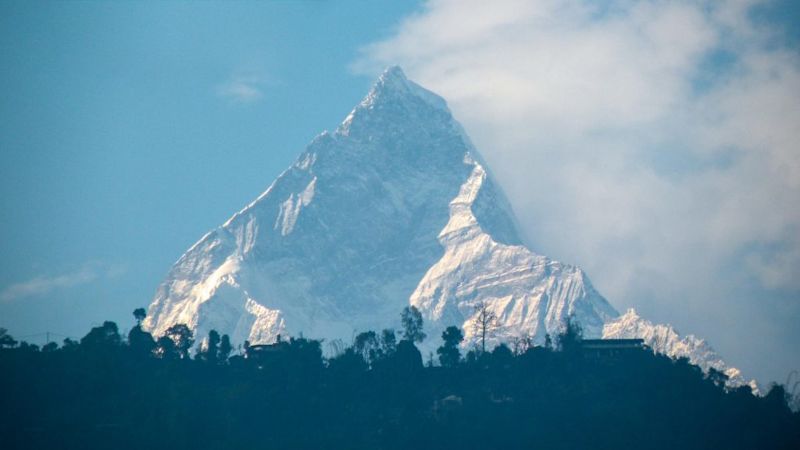
Another view of the magnificent mountain Machhapuchhre
Even if you trek in a typically warmer month, the weather in the Himalayas can be capricious and you can get a dump of snowfall at any time of the year. You should therefore anticipate the possibility of walking in snow .
Natural features
No doubt the main reason you want to go trekking in the Himalayas is to feel small and awe-filled in the midst of such natural grandeur and beauty. Both the EBC and Annapurna treks have so much to share in terms of mighty glaciers, icy lakes, rushing rivers and deep gorges. For the nature lover, these treks are an immersion into Mother Nature’s power and creativity.
Everest Base Camp natural features
Most of the EBC trek takes place within Sagarmatha National Park, one of the largest of Nepal’s dozen national parks. It’s a Natural World Heritage Site. Sagarmatha is also part of the Sacred Himalayan Landscape, a transnational protected space that’s home to some very important landscapes and wildlife.
Within Sagarmatha National Park you’ll encounter two distinct climatic zones:
- The temperate zone of the lower Himalayas
- The arid mountain zone of the higher Himalayas
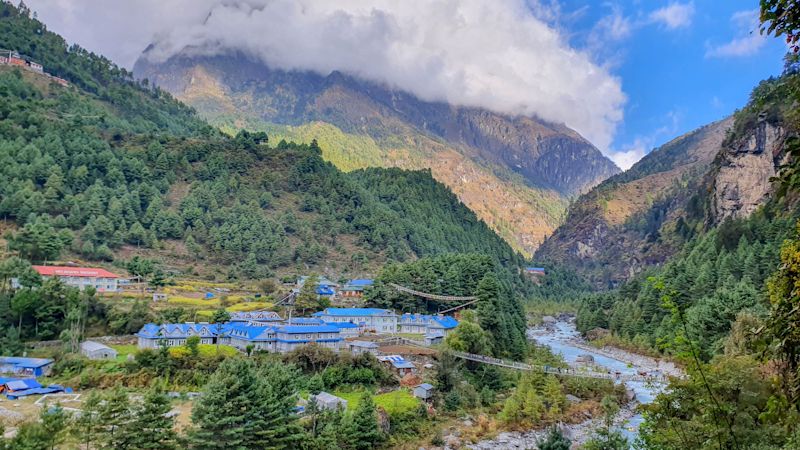
We overnight in the temeperate village of Phakding on the first night of the EBC trek
In the temperate zone you can expect steep, tree-clad valleys, flowers and flowering bushes, gorges and cliff faces, and rushing rivers and waterfalls. When you venture into the higher, arid zone, you’re above the tree line and in the company of boulders, ice patches, barefaced rock and snow-covered mountains.
The Khumbu Glacier
The Khumbu Glacier is the world’s highest glacier.
The Khumbu Glacier has a large icefall known as the Khumbu Icefall on its west end. EBC is situated at the foot of the Khumbu Glacier, and so is a very real goal post to work towards on the trek.
Gokyo Lakes
The Gokyo Lakes, a World Heritage Site, is a true highlight of our EBC and Gokyo Lakes trek itinerary.
Six main lakes make up the Gokyo Lakes, with Thonak Lake being the largest. The lakes are the world’s highest freshwater lake system. They're an otherworldly sight: pale blue water completely surrounded by barren slopes and snow-capped peaks. Or, in winter, pale water surrounded by a world of white.
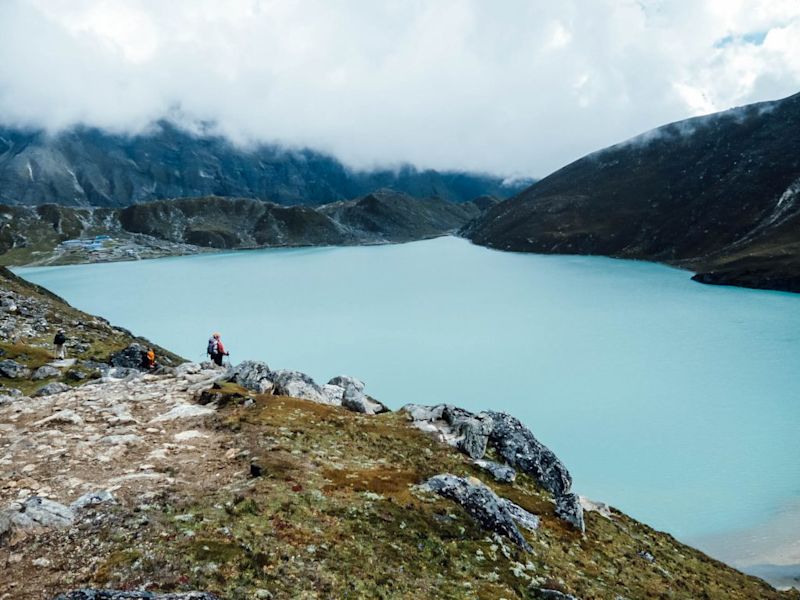
One of the beautiful Gokyo Lakes, where we spend two nights during the Everest Base Camp trek
Annapurna Circuit natural features
The Annapurna Conservation Area (ACA) is by far the largest protected area in Nepal, and is seven times larger than Sagarmatha National Park!
Like Sagarmatha National Park, the ACA also has a temperate zone and cold mountain zone, but it has the bonus of offering a subtropical zone as well.
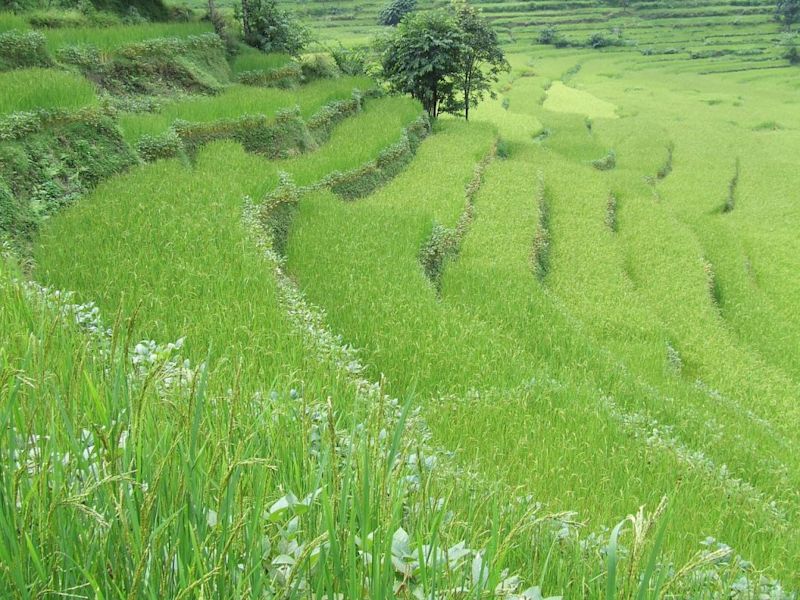
Terraced farms are a common sight along the lower section of the Annapurna Circuit
The forests of the subtropical region receive much more rain and offer dense forests with creepers and lots of undergrowth. The forests of the temperate zone are made up of trees like pine, oak and juniper.
During our first acclimatisation day in Manang, there’s the option of a day’s hike to Kicho Tal (Ice Lake). This is a gorgeous hike to a gorgeous location, so even though the going is steep and tough, we encourage trekkers to try do it. The ice lake is completely surrounded by some of the world’s highest peaks, and also offers one of the quieter spots along the Annapurna as not all make the effort to climb up to it.
The Kali Gandaki Gorge
The Kali Gandaki Gorge (or Andha Galchi) is the world’s deepest gorge. During our short flight from Jomsom to Pokhara on Day 11 of the Annapurna trip, we wind our way through this gorge in a small aircraft, enjoying a plane ride like no other.

The Annapurna Circuit offers the most varied scenery of any classic Nepal trek
Finally, when we’re happily resting our tired feet in Pokhara, we’ll be able to look out over the lovely Phewa Lake. Pokhara sits on the banks of the lake, and is a popular tourist destination in its own right. You might choose to hire a canoe and row about – destination or no destination in mind!
One of the highlights of the Annapurna and Everest Base Camp treks is the animal and birdlife, many species of which are unique to that part of the world. Many of the animals to be on the lookout for can be found in both Sagarmatha National Park and the Annapurna Conservation Area (ACA), given their similar and connected ecosystems.
It’s only the lowest portion of the Annapurna route that offers subtropical wildlife like monkeys, which you won’t find along the Everest Base Camp trek.
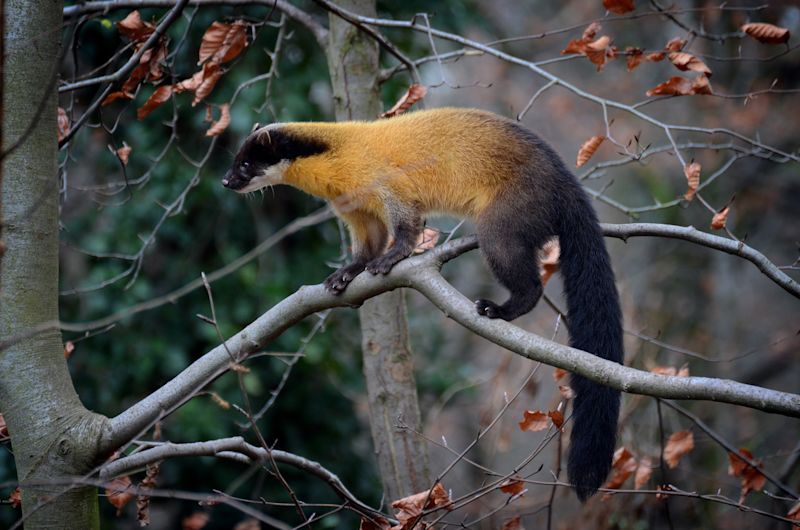
Yellow-throated martens live can be found on both the AC and the EBC trek
Wild animals
Both the ACA and Sagarmatha are home to a variety of very special animals. Probably at the top of most people’s lists would be the endangered snow leopard. You might like to watch this short video on snow leopards by National Geographic to learn about this elusive creature. Did you know that the snow leopard is also called an ounce?
Sagarmatha and the ACA are also home to the endangered red panda. The red panda is not actually closely related to the giant panda, even though its name suggests otherwise. Legend has it that if you see a red panda you go straight to heaven. Okay, we made that up, but to see a red panda in the wild would surely feel rather heavenly.
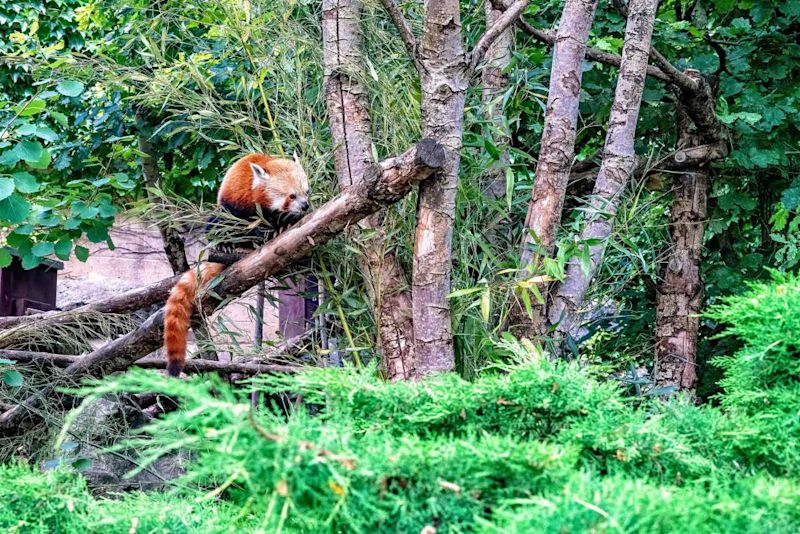
A red panda
Other animals in the two regions include:
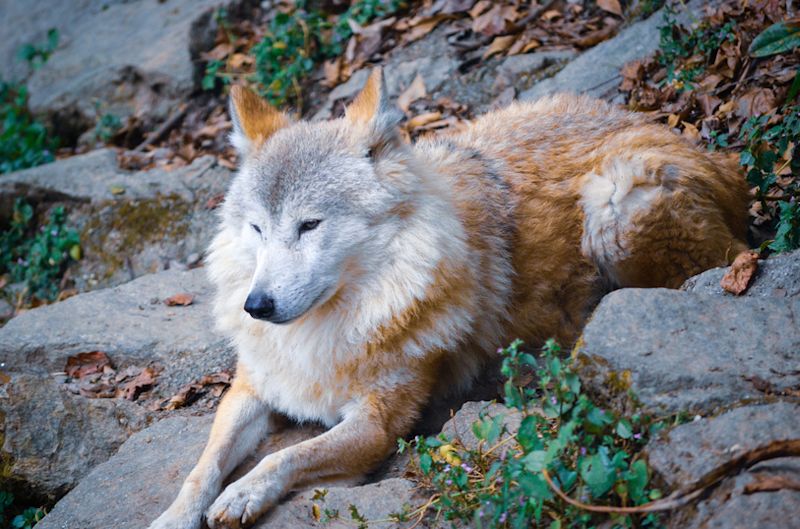
A Himalayan wolf
One of the perks of travelling in a group is having a local tour guide who is trained to spot wildlife.
On both the Everest Base Camp and Annapurna treks we have local guides to lead us along the entire trek route and help us enjoy the time by doing things just like pointing out hard-to-spot animals.
Oangdi is one of our highly qualified and awesome Nepal trek leaders
To learn more about the EBC trek animals and see some pics, please look at What animals will I see on the Everest Base Camp trek?
Domesticated animals
Obviously the wild animals aren’t the only animals you’ll encounter on either of the two trek routes. There’ll also be yaks, cattle, yattle (yak-cow hybrids), donkeys and horses to step aside for on the path, or photograph as they graze in pastures.

Yaks and yattle are seen everywhere in the Nepali Himalayas
Sagarmatha National Park has been designated an Important Bird Area by BirdLife International. It has over a hundred bird species.
The ACA, being seven times larger in area, has even more birdlife to offer: it boasts hundreds of different bird species. If you’re a birdwatcher, look out for beautiful flycatchers, greenfinches, dainty bush chats, griffons, and, of course, eagles. The list really could go on and on.
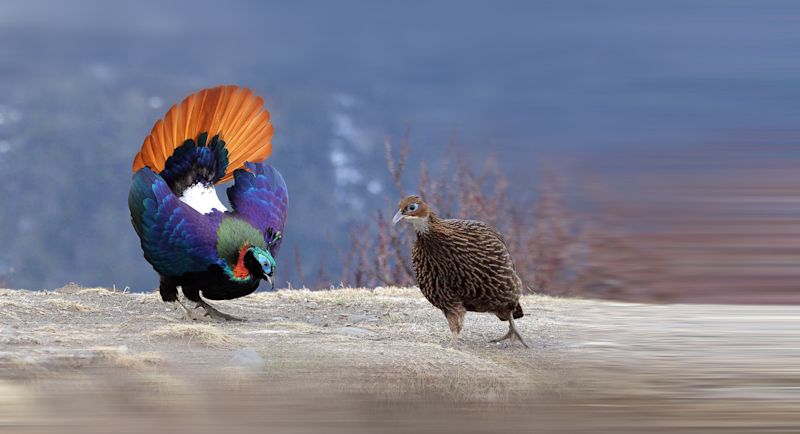
Male and female Himalayan monals
Trees, plants and flowers
One of the joys of travel is seeing beautiful new plants and trees. Many people choose a destination just to see exotic spring flowers or towering trees. We feel them. So in the tradition of rating Annapurna versus EBC: which stacks up better in terms of the flora on offer?
Rhododendrons on the EBC trek
Plants of the Annapurna Conservation Area
If you’re particularly keen to see flowers and other plants, then you’ll likely enjoy the Annapurna Circuit that much more. This is because you’ll pass through a subtropical climate in addition to the temperate and mountain climates that you encounter on the Everest Base Camp trek.
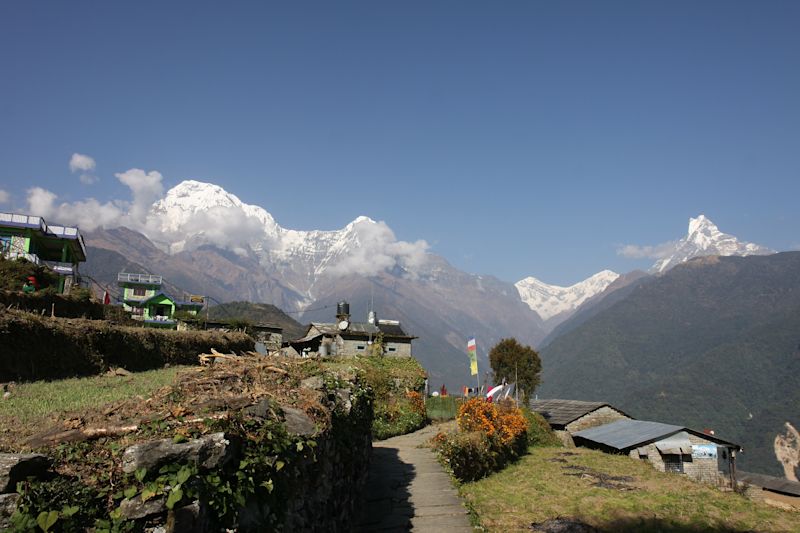
Flowers soften the upper reaches of the circuit
The subtropical zone receives far more rain, which is why farmers can grow rice, buckwheat, beans and other crops reliant on plenty of water. You can also anticipate plenty of beautiful flowers and trees, such as irises, orchids, magnolias and fig trees. The sacred fig, which can be found on the trek route, grows heart-shaped leaves and has significance in Hinduism, Buddhism and Jainism.
In the temperate zone of Annapurna you can expect oak, maple, fir and pine forests. You can also look forward to cherry trees and the region’s signature rhododendrons.
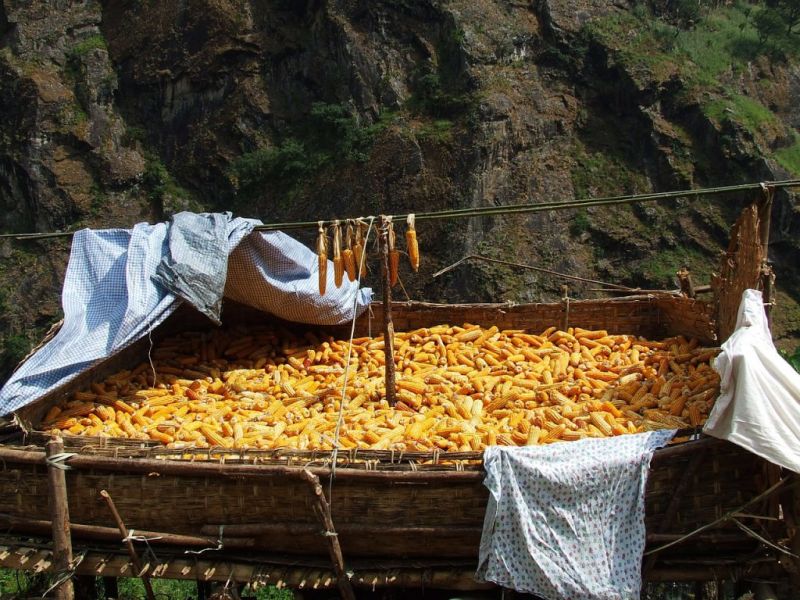
An Annapurna farmer dries his crop of corn
Plants along the Everest Base Camp trek
During the first portion of the EBC trek one sees bamboo, hemlock, juniper, birch, blue pines, silver firs and rhododendrons.
By the time we reach Everest Base Camp, however, we’re above the tree line in the tundra zone. In this zone we're down to mostly lichens, mosses and hardy grass tufts. That’s not to suggest the EBC trail has a paucity of vegetation however! The lower portion of the trek is lush and beautiful, and you’ll be ooh-ing and aah-ing plenty .
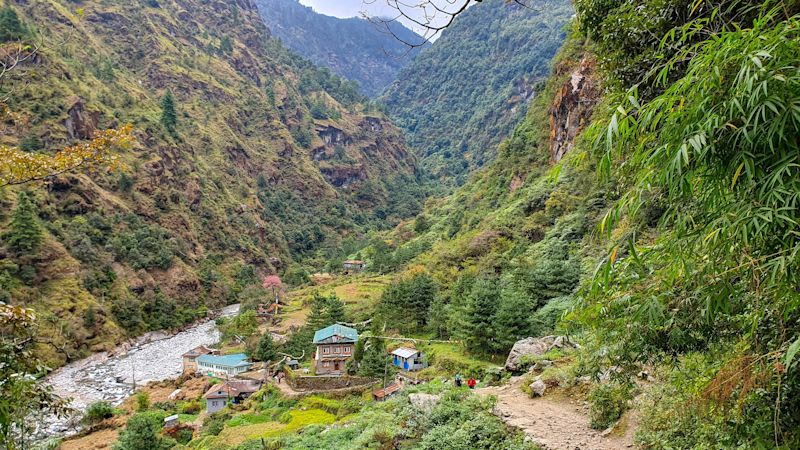
Surke village along the EBC trek route
Making the choice
Are you still struggling to decide between Annapurna and Everest Base Camp? If so, maybe it'll help for us to say this: this is one of those situations where there is no wrong decision!
There's no bad decision here. If you trek to Everest Base Camp, you win. If you trek the Annapurna Circuit, you win. 😉
And if you choose to fly back from Everest Base Camp via helicopter then you get to enjoy the most scenic flight your life! So you also win! There really isn't a bad option!
But most likely you feel confident by now that you know which trek is for you at this time. Please feel free to contact us if you’d like to discuss either of the treks. We’d love to share our knowledge and experiences of these two beautiful, world-class treks with you and help you plan a trip you’ll never forget.
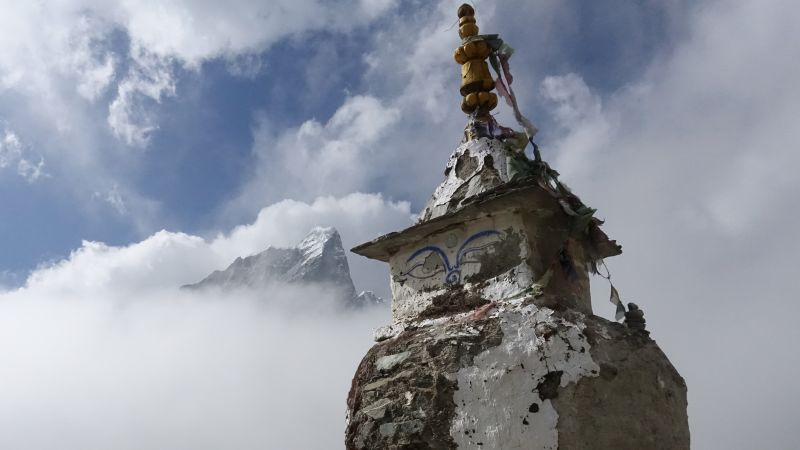
There are many gompas and prayer flags along the trek routes of the Nepal Himalayas

- Classic EBC Trek
- EBC + Gokyo Trek
- Jiri to EBC
- 3 Passes Trek to EBC
- Island Peak and EBC
- Acclimatisation
- Packing List
- Get a Trek Quote
Everest Base Camp Trek Distance, Length and Elevation
The Everest Base Camp Trek is the most popular trek in the Nepal region and one of the most iconic and well-known treks in the world.
After a nerve-racking flight into Lukla airport that is sure to get you pumped up, you will retrace the footsteps of Sir Edmund Hillary, Tenzing Norgay and the countless other brave men and women who have summited Everest after them.
The route takes you through the beautiful Sagarmatha National Park and eventually ends up at Everest Base Camp, where you will feel the buzz and excitement of potential summiteers of the world’s tallest mountain (the main climbing season kicks off in April and culminates in the 3rd or 4th week of May).
Popular questions asked about the Everest Base Camp Trek always seems to follow the similar pattern of ‘how hard?’, ‘how long?’ and ‘how high?’.
This article will cover the raw data behind the trek to answer all those burning question about distance, length and elevation.
To get a better understanding of how challenging the trek is, read our in-depth article on the difficulty of the Everest Base Camp Trek .
Everest Base Camp Trek Distance
The classic Everest Base Camp trek from Lukla to EBC and back is 130km long – 65km each way – which may sound like a lot of trekking!
Fear not, because the typical round trip to Everest Base Camp takes around 12 days, the actual distance you will be covering each day will be about 15km – a much more reasonable and achievable number.
Furthermore, the average walking pace is about 5km/hour, so 15km per day does not sound too bad anymore.
Obviously, you will not be trekking at that pace because of the rocky terrain, gradual ascent and high altitude gains that have to be made.
The point being made is that the distance is very attainable for all people of all ages, shapes and sizes!
If you book through a tour operator , you will likely have the luxury of having your large bags carried for you by porters or by yak / mules. This should further take the strain off your body and allow you to focus on getting yourself safely up and back down the trail.
How Long Is Everest base Camp Trek?
The typical length, in terms of time, of the Everest Base Camp trek is around 12 days. There are variations of standard route, like Jiri to Everest Base Camp and Gokyo Lakes trek , which take longer.
The outward route from Lukla to Everest Base Camp is significantly longer, in terms of time, than the return route to allow for proper acclimatization and to minimize the risks of Acute Mountain Sickness and related illnesses.
It should take around 9 days of trekking to reach base camp and just 3 days to return to Lukla.
To get a better idea of the distances and day-by-day break down of the typical Everest Base Camp Trek we have posted a sample itinerary below:
- Day 1: Arrive in Kathmandu where you will spend the night.
- Day 2: Fly from Kathmandu to Lukla, then walk to Phakding – 9 km (4 hours)
- Day 3: Trek from Phakding to Namchee Bazaar – 12 km (6 hours)
- Day 4: Acclimatization day. No walking except maybe a quick hike up to the Everest View Hotel.
- Day 5: Trek from Namchee Bazaar to Tengboche – 10 km (6 hours)
- Day 6: Hike from Tengboche to Dingboche – 12 km (6 hours)
- Day 7: Acclimatization day in Dingboche. Explore the area.
- Day 8: Trek from Dingboche to Lobuche – 12 km (7 hours)
- Day 9: Hike from Lobuche to Gorak Shep to EBC and back to Gorak Shep – 15 km (8 hours)
- Day 10: Hike from Gorak Shep up Kala Pathar and then to Pheriche – 13 km (7 hours)
- Day 11: Trek from Pheriche back to Namchee Bazaar – 14 km (8 hours)
- Day 12: Hike from Namchee Bazaar to the airstrip at Lukla – 15 km (8 hours)
- Day 13: Fly back to Kathmandu
- Day 14: Leave Kathmandu
Elevation On EBC Trek
The most challenging element of the trek is probably elevation . Even at the start of the trek at Lukla airport you will be at an altitude of over 2,600m. As most people’s bodies are not used to these altitudes, the trek involves acclimatization days and the ascent to Everest Base Camp will occur at a much slower pace than the descent to allow for acclimatization and to ensure safety.
Typical elevation gains will be in the range of 400-800m each day. Days when the gain is large and the altitude is significantly high will usually be followed by an acclimatization day that doubles up as time for some sightseeing and exploration of the surrounding areas.
Here is an Everest Base Camp trek elevation and altitude profile for the standard trek.
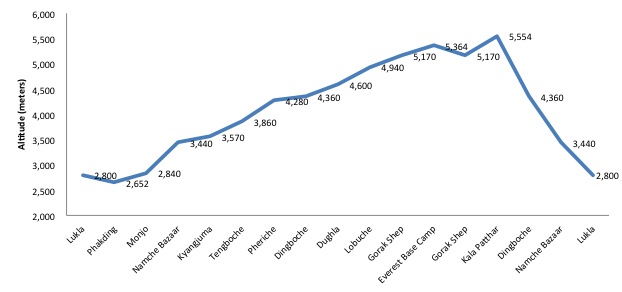
The highest point on most Everest Base Camp Treks tends to be the Kala Patthar viewing point where you will be blessed with some of the best views of Everest and the nearby peaks. Kala Patthar stands at just over 5500m, but not too much time is spent at that altitude as the trek then descends back down to Pheriche and eventually back to Lukla Airport.
Hopefully these facts and figures have convinced you set out on your own trek to Everest Base Camp – if so, happy trekking!
Tags: Everest Base Camp Trek Distance, How long is the Everest Base Camp Trek? Length of the Everest Base Camp trek, Everest Base Camp trek altitude, Everest Base Camp Trek elevation
Mark Whitman
Hi, I'm Mark! Welcome to EBC Trek Guide - the Web's No.1 Trekking Guide to Everest Base Camp. I have trekked all over Nepal, but the Everest region remains my favourite. I hope you find all the answers you are looking for on this site. If you have any questions don't hesitate to drop a comment below! Happy Trekking!
Leave a Reply
Your email address will not be published. Required fields are marked
Really useful post to reflect the daily walking distance , gain elevation and length of track regarding EBC treks thanks for sharing
Hi Mark, just wondering if Island Peak (in November) is do-able for my son who will be 17 years old. We’re both pretty fit but we don’t have any climbing experience. I did EBC in 2014. Cheers.
Hi Anthony, thanks for getting in touch. It is possible to climb Island Peak in November. The hike to Island Peak usually includes a visit to EBC before to help with acclimatisation. The climb itself is a real challenge and not for the faint-hearted. I would highly recommend doing some winter mountaineering courses before embarking on the adventure. You will need to be comfortable using crampons, crossing a glacier with ladder crevasse sections and ascending a tough headwall with a fixed rope jumar. You can read more about Island Peak here: https://www.mountainiq.com/guides/trekking-in-nepal/routes/island-peak/
Thanks Mark, your info was very helpful = )
Thanks for info. It needs to write per day max hgt of destination
on the clair ridge oil platform we climb 17km per day.8.5 up and 8.5 down….how many times do we climb the equivolent of everest per week ?
Hi Donald, I’m not sure the answer to your question. I would estimate that on the average day on the EBC trek, you gain about 800-1500m in altitude and lose about 400-800m. The average elevation gain is about 400-800m per day. Hope this helps.
Hellow ! My name is Jaak, my friends name is Andras and we are from Estonia. We wish to make a little trek, max 10-11 days for max alt. 5500/5600m and to stay overnight 5000+ meters few nights. It mast be an acclimatization trek, because my friend are going to K2 summit expedition in july. My friend have gone earlier on Mount Everest summit .Could You please think about it and say, is it possible to organize trek like this between 08.05 – 21.05. We do not need a guide service and accomondation can be easy. Thanks in adavance, Jaak and Andras
Hi Jaak, we are not a tour oeprator so unfortunately we cannot help organise your trek. For a tour operator recommendation go here: https://ebctrekguide.com/go
Looking over the Everest Trek itinerary (which is similar to other organized Everest treks), it seems a little ambitious for the uninitiated. What I mean (and I’ve done the trek independently as well as extensive mountain climbing and backpacking in the Cdn. Rockies) is that while each day’s trek is reasonable, the day-after-day grind will wear down some people. I would recommend anyone attempting this pace first do some multi-day backpacking in the mountains to see how he or she reacts to what is a fairly relentless pace. A Stairmaster is a poor substitute. Also, people who’ve not trekked high up (above 12,000 feet) should know that altitude brings new challenges.
I love to try EBC from Lukla
please tell distance between first base camp to everest summit
Hi Murali, the distance from EBC on the south side (Nepal side) to the summit is approx. 20 kilometres. The altitude gain is nearly 3,300 meters though.
Thanks for all the information… Inshalah I will be there on the last August
Hi, I would like to do EBC on my own since having a porter or a guide with me all the time does not work for me. I am wondering how safe it is to hike alone for a female. I am also wondering if getting accommodation can be a problem if you dont book in advance. Finally, is the path well marked. Many thanks!
Hi, it is possible to trek solo and if you go during the high seasons (March-May or September-November) then there will be quite a few people on the trail. Getting accommodation each day should not be a problem but you might not get your pick of teahouses. Generally porters run ahead of trekkers to secure the best teahouses. The standard EBC path is not well marked but maps of the region are very detailed and easy to follow. All the best!
I am Ram and 40 year old i would like to know more about Everest trekking , i would like to do and what is the process
Hi Ram, I recommend browsing our site – it provides all the information you need. Start here: https://ebctrekguide.com/
Why is there so little time spent at EBC?
Hi Laurie, There are a few reasons why the time at EBC is limited. Firstly, trekkers cannot actually get all the way into the camp. The stop point is just before the camp, and there isn’t a huge amount to see. 10-20 minutes there is more than enough. Secondly, EBC is a good two hour hike from the last tea house at Gorak Shep. So to hike there and back means hanging around EBC is not recommended. Finally, the best views of Everest, the surrounding mountains and EBC is from Kala Pattar, which is right next to Gorak Shep and if you move fast can be hiked on the same day that you visit EBC. Hope this helps!
I’m planning to trek solo in December – January. I read is the low season, with probably a lot of snow. You consider this dangerous? Which equipment would you consider? Your info it’s very clear thank you very much!
Hi Mariano, yes, there is more snow in December. As long as you are trekking the standard route to EBC there is no additional danger. If you plan to cross some big passes, like those on the Gokyo route or Three Passes Trek, I would caution against that. Most passes will be closed in December anyway. In terms of gear, here is what you need: https://ebctrekguide.com/everest-base-camp-trek-packing-list
Thank you for sharing all this information in your blog . Very useful information, it opened my eyes to things i wasn’t aware about. Great way to start preparing for next years climb
Thanks Ebby!
Thanks for the info Mark, helps a lot. Planning to do the trek in December. Would appreciate any pointers to make it comfortable as I am told the Climate is extremely cold.
Hey Ismail, yes, December is pretty cold. Make sure to bring a four season sleeping bag and warm winter jacket / gloves / beanie etc. Layers will be important too, check out our packing list for advice: https://ebctrekguide.com/everest-base-camp-trek-packing-list
Hi, we are a family of 4 and interested in doing EBC in July 2019. Wanted to check what the minimum age is. My two sons are 12 and 10 years old and are physically fit. Thanks
Hi Jeet, there is no official minimum age for the EBC trek, although I wouldn’t take a child younger than 10. In terms of timings I would avoid July – this is the middle of the monsoon season and a terrible time to trek. The best time to go is either Feb-May or Sept-November. Hope this helps.
My other is a smoker and we would like to trek to EBC. Please give her some words of wisdom from your experience with smoking trekkers.
Hi William, words of wisdom… stop smoking. No in all seriousness, one can trek to EBC and smoke but I wouldn’t recommend it. If at all possible, I would encourage your ‘other’ to abstain from smoking, especially on the upper reaches of the trek.
Hello we are 3 friends and want to do EBC, want to know the formalities. Preferable date is 23rd march
We are planning to trekk to Everest base camp in next month . What is your advice for me
Hey, little mistakes on the altitude, Lukla is 2850m and the Kala Patthar is 5643m. 😉 btw I recommend to not hire any porter, that’s too easy with them and you won’t have the same satisfaction. I did it by myself without help and I was so proud to carry my bag in front of all this groups of tired people (but with no bags 😉 ) you’re going for a challenge or not ?
can you hire poter and guide at lukla. how is the chance if you trek to phaking and try to get a tea house without prior booking
Yes it is possible to hire a guide / porter in Lukla. If you ask at one of the many teahouses they should be able to assist. In terms of teahouse availability, this varies by season and time you arrive. Ideally it is best to send a porter ahead early in the day to make a booking for you, but generally if you arrive at a reasonable time it is usually possible to find a free room in one of the teahouses.
Great informative stuff, I’m Planning on 4 old guys 60 +62 to EBC In Nov 2020 Let you know how it goes
can I see everest from namchee bazaar?
Technically you need to hike up to the Everest View Hotel which is just above Namche. But it is only a 20 minute walk away so yes you can.
Is it possible to take a helicopter from Lukla to EBC and then hike back to Lukla with a group? I have taken a bus to EBC and that would be an option too. We would be staying the week before at a 10,000' elevation to help with acclimatization. Thanks,. Tom
Hi Thomas, it is possible to get a helicopter to EBC, but it’s pretty expensive and due to the high altitude weight is usually limited to one passenger (maybe two).
How far from base camp 4 to the peak and back?
Hi Albert, just to be clear this website is about hiking to Everest Base Camp, not climbing Mount Everest. But to answer your question, Camp 4 is on Everest is located on the South Col at just over 8000m. It’s about 1-mile climb to the summit and takes about 7-8 hours.
All of these guides have been so helpful! I leave for EBC in a week and have been panic googling to try to be as prepared as possible. Thank you for the info!
Sure thing Megan!
Hi! What clothing do you recommend for doing the EBC trek first couple weeks of November? Thanks!! Great article
Hi Jackie, I recommend checking out this packing list: https://ebctrekguide.com/everest-base-camp-trek-packing-list
very informative mark thank you. i will be doing this in october 2023
Thanks Tony!
Hi Mark, is there scope to buy all the kit you need in Kathmandu as I’m traveling light at the moment. Im in the far east in shorts and flip flops and my gear is back in the uk. If so how much would I be looking at?
Yes, there are loads of gear stores in Thamel.
Very informative, intresting and nicely articulated! Loved it.
Get a quote from the best local trek operator in Nepal!
Get my recommendations on the Best EBC trek operators
Nepal Trek Booking Open For 2024 2025

( [email protected] )
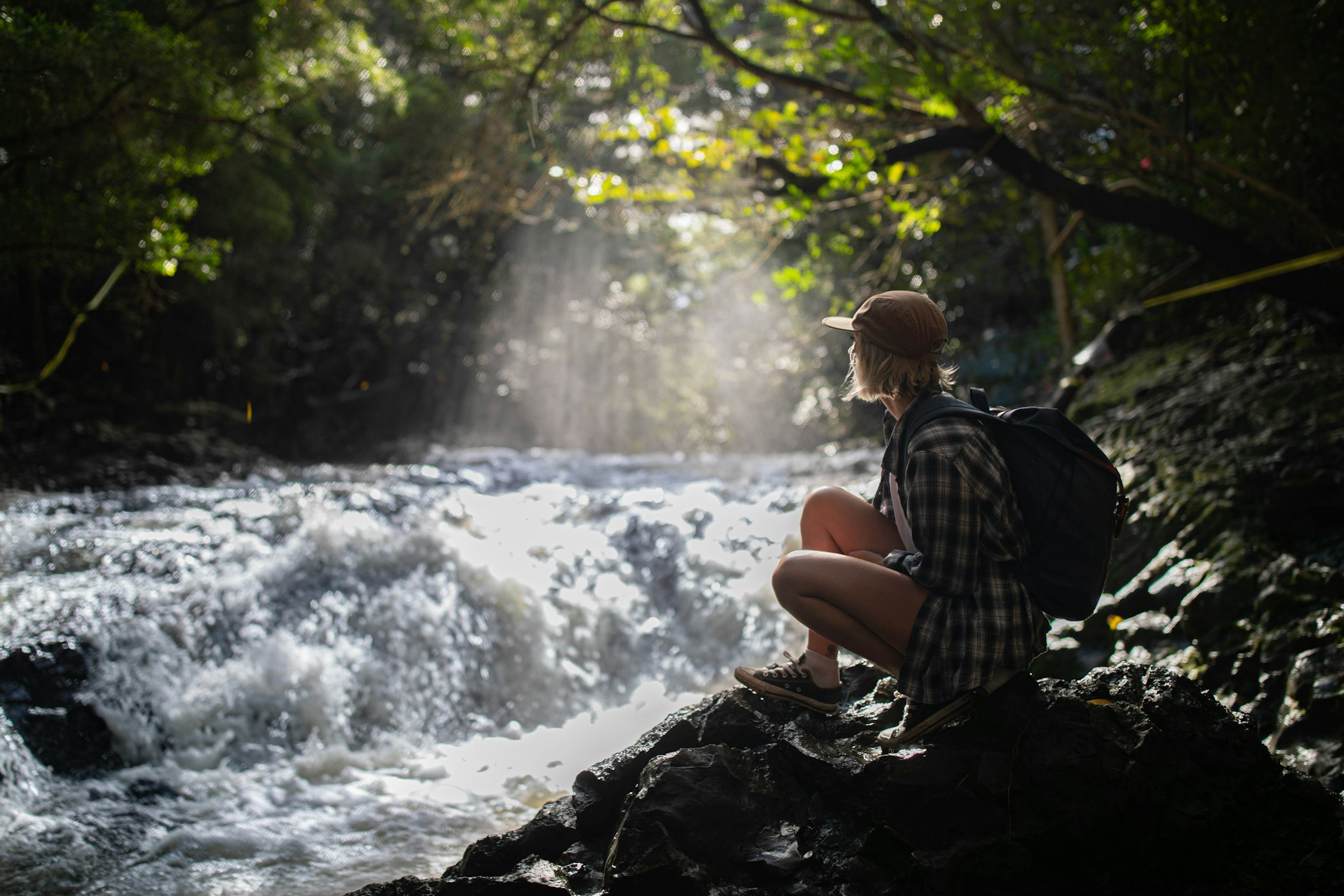
Annapurna Vs Everest Base Camp Trek
Everest base camp and Annapurna base camp both treks are adventurous treks. Every traveler wishes to stand in front of Everest and Annapurna . The wish becomes a dream and leads you toward a destination of EBC and ABC . Both EBC and ABC are wonderful places that you must visit in your lifetime. We hope your visit will repeat a number of times after seeing its attraction and beauty. There are some differences regarding distance, duration, budget, permit, and altitude between the Everest Base Camp (EBC) and Annapurna Base Camp (ABC) trek. An attempt to include details of both the ABC and EBC trek is made in this article with the aim of giving information on both the EBC and ABC trek at once.
Which is tougher Everest Base Camp Trek or Annapurna Base Camp Trek?
Annapurna Base Camp (ABC) and Everest Base Camp (EBC) both are mountain rides on foot. Climbing up and up till you reach the base of the Himalayas is not an easy task. EBC is at the highest altitude than ABC, it takes a long time to reach EBC than ABC. Thus EBC is tougher than ABC . To know which one either EBC or ABC is tough, let’s see separately about the location, altitude, and difficulties of the EBC and ABC trek.
Everest Base Camp Trek Difficulty
THE EVEREST BASE CAMP TREK Location is Solukhumbu district, Province No.1- Nepal in Sagarmatha National Park .
EBC trek duration: Everest (8848m) is the third pole of the world. It is one of the mediums to be on the lap of Everest. EBC treks need minimum 15 days. These 15 days include the total time from arrival in Nepal to departure from Nepal. Day by day you will walk towards hills and downhills enjoying the beauty of the place fascinated by the gorgeous Himalayas, variety of plants and animals, ethnic cultural beauty of Sherpa, monuments, and many more.
EBC trek elevation: In the EBC trek, walking begins from Lukla (2860m) and leads up to Everest base camp (5364m). The altitude rise is very high i.e. 2504m from Lukla to Everest base camp.
EBC trek challenges: This elevation rising with each day trek leads to altitude sickness and tiredness, the food of cold region may not suits you, you may caught a cold and become sick. The rainy days doesn’t give proper visibility, thick fog will decrease the charm of surrounding. Due to lack of internet connection in some places, you will be out of contact from your families. Physical imbalance and atmospheric challenges may leads to an incomplete trek sometime.
Annapurna Base Camp Trek Difficulty
ANNAPURNA BASE CAMP Trek location is Kaski district, Province no. 4 (Gandaki Province) Nepal in the Annapurna conservation area.
Abc trek duration - Annapurna I (8091m) is the 10th highest mountain of the world. It is one of the mediums which guides you on the base of Annapurna massif. ABC trek requires minimum 10 days. If you desire to go Ghorepani Poon Hill trek and Ghandruk along with the Annapurna base camp then you need 14 days. These 14 days include days from arrival in Nepal to departure from Nepal. ABC trek route is not as difficult as EBC trek. Elevation rises day by day but doesn’t comprise more slanted uphills. The waterfall, amazing diversified flora, landscape with a variety of soil texture, Local Gurung culture and hospitality is great part beyond walking.
ABC trek elevation: In the ABC trek, walking begins from Nayapul (1070m) and leads up to Annapurna base camp (4,130m). The altitude difference from the beginning to the destination of the trek is 3060m.
ABC trek challenges: Since ABC lies in low altitude than EBC, there will be less chance of altitude sickness, The path is less steep so walking will be comparatively easier than EBC trek. Due to low elevation than the EBC trek, there will be less chance of suffering from cold and falling sick. Less problem in digestion and in taking food. Chances of an incomplete trek due to bad weather, and physical illness will be less.
When is the best time to visit Everest Base Camp (EBC)?
The best time to visit Everest base camp is spring and autumn season. Spring season – 15th February to 15th May and autumn season- from 15th September to 15th December is the best time to visit Everest because of pleasant weather, clear vision and less risk on path during these months. A cheerful environment, panoramic view of mountains, burble of rivers and stream, blooming rhododendrons energize you with joy and happiness. All hotels remain open, and lots of trekkers on the path will encourage you to complete your journey.
EBC trek in monsoon is not preferred because you could not enjoy your trek due to rainfall. Parasites called leeches spread more on the path and they may bite you. Due to rainfall Path becomes sloppy, chances of falling down increase. You couldn’t see the view properly due to the thick fog and clouds on the mountain.
EBC trek in winter is very dangerous, it is unpredictable whether you can reach Everest base camp or not because of extremely low temperatures. Temperature fall up to -17° C to - 20°C. Most hotels remain closed and proper food will not be available.

What is the best time to visit ABC?
The best time to visit Annapurna base camp is the spring and autumn seasons. It is analyzed by trekkers that in case of low snowfall, Trek is possible in all months of the year even though spring (15th February to 15th May) and autumn (15th September to 15th December) are considered as the best. Because in spring and autumn, the weather remains perfect for trekking, days remain best with pleasant weather. You can take full entertainment with your journey. The view of mountain ranges will be clear, the path will not be wet and dangerous. All teahouses remain open, good food will be available.
ABC trek in monsoon is possible but high risk of the wet path, and rain coverage makes your trek joyless and difficult. You could not enjoy the environment during the trek due to rainfall or even snowfall. The view remains unclear and the mountain will hide inside clouds and fog.
ABC trek in winter is not selective because of low temperatures and snowy paths. It would be very difficult to reach your destination because of cold and snow cover everywhere. Most of the Tea houses remain closed and would be difficult to get a comfortable place to take rest as well.
How much does it Cost for The Everest base camp trek?
EBC trek cost is 1000$ - 3500$ per person. The cost varies depending on the days you want to spend during your trek and the tea house where you stay during the trekking and the rest of the days of your visit.
The EBC trek permit you should pay is the Sagarmatha National Park permit. The cost is Nrs 3000 for foreigners and Nrs 1500 for SAARC nationality. You should also pay 2000 NRS for Pasang Lhambu Muncipility.
How much does it cost for the Annapurna base camp trek?
ABC trek cost is 750$-1850$. Cost depends on the days you spend during the trek and the places you visit. Also on the tea house where you will stay during the trek and your visit.
ABC trek permit you should pay is ACAP permit 28$ and TIMS permit 20$ per person.
(ACAP – Annapurna conservation area permit and TIMS – Trekker’s information management system)
Which is better Annapurna or Everest Base Camp Trek?
To remove confusion on choosing the ABC or EBC trek, we have a tabular representation to compare the ABC and EBC trek.
From the table, it is clear that If you want to go on the highest altitude and spend more time on the Himalayan region then the EBC trek is better for you. If you haven't done any mountainous trek then you should go for ABC trek first. From the view of expenses, the ABC trek is cheaper than the EBC trek. So you can choose ABC trek in case you want to do the cheaper and more adventurous trek. If you are searching more challenging and remarkable trek, then EBC is the best choice cause the EBC trek only can take you on the base of the highest altitude of the world.
How to reach Annapurna and Everest base camp?
The table below gives full information about day-wise activity for Annapurna and Everest base camp trek. It takes 13 days for ABC trek and 15 days for the EBC trek. You should walk 3-7 hours regarding your destination per day in both trek ABC and EBC.
Itinerary for Annapurna vs. Everest Base Camp Trek
Accommodations .
Air pressure reduces with increasing altitude and the amount of oxygen in the air becomes low which causes altitude sickness. To get recovered from altitude sickness your body demands rest for which proper accommodation is essential.
Everest base camp has better accommodations than Annapurna Base Camp. Annapurna base camp has only 4 hotels with seven rooms and GorkShep (Everest base camp) has five hotels with more than 40 rooms in each.
Annapurna trekking site has limited hotels with 7 rooms and four beds each room after Chommrong due to the Annapurna conservation area but the Everest trekking site has many hotels with more than 20 rooms in each. Hotels in Labuche has a capacity of 60-70 person and Gorchep have 100 in each hotel.
Internet and charging facilities are available in hotels/ tea houses of both ABC and EBC trek but you have to pay an extra charge for it. If you are planning a solo or Self trek without Guide to ABC then take the Annapune base camp Trek route hotel number in Advance so it will be easier to book a room in the High season.
Annapurna vs. Everest Base Camp elevation
Altitude variation occurs from step to step in the ABC and EBC trek. The table below shows the altitude of major places of both EBC and ABC trek in comparative form.
Scenic beauty
Everest and Annapurna both are ranges (Mahalangur and Annapurna) of Hindu Kush Himalaya. Both places are fascinated with panoramic view of numerous mountain ranges, rhododendron with alpine vegetation, faunal diversity and ethnic culture of Sherpas, Tibetan and Gurung society. Somewhere you will see rocky mountain, somewhere snow capped mountains and somewhere you will see cold desert. The breathless beauty of EBC and ABC is unexplainable.
Nuptse (7861m), Lotshe (8561m), AmaDablam (6812m), Thamserku (6623m), Mt.Pumori (7161m), Lobuche (6119m), Tabuche (6542m) etc. are seen in Everest base camp trek whereas Annapurna I (8,091m), Mt.Manaslu (8163m), Mt Dhaulagiri (8167m), Annapurna II (7937m), Annapurna III (7555m), and Annapurna IV (7525m), Ghangapurna (7455m), Annapurna south (7219m), Macchapuchre (6993m), Himchuli (6441m) Mardi Himal (5587m), and many more are seen from Annapurna region.
From where do ABC and EBC trek Start?
Everest Base Camp Trek: The EBC trek typically starts with a flight from Kathmandu to Lukla , a small town in the Khumbu region of Nepal. Lukla has a small airport. From Lukla, trekkers usually hike to Phakding and then on to Namche Bazaar, a bustling market town and the gateway to the Everest region.
Annapurna Base Camp Trek: The ABC trek usually starts from the city of Pokhara, which is about 200 kilometers west of Kathmandu. From Pokhara, trekkers drive to Nayapul and then hike to Tikhedhunga. The trek then passes through charming villages, lush forests, and terraced farmland before reaching the base camp of Annapurna. While there is no direct flight from Pokhara to Lukla, many tour operators offer a combined ABC and EBC trek, which involves flying from Pokhara to Kathmandu and then to Lukla.
Basic requirements for ABC and EBC trek
ABC and EBC trek constitute cold climatic zones and snowy pathways. Thus you should be careful on clothing and other trekking gear. Here is a list of trekking requirements you should bring on both EBC and ABC treks.
- Warm jacket – down jacket,
- Water and windproof jacket (alternatively bring a poncho or umbrella)
- Long-sleeved synthetic fleece (windproof material, if possible)
- Thermal underwear
- Hat, a pair of gloves and a scarf
- Comfortable hiking trousers (loose fitting)
- Shorts and trousers, or a skirt
- 2 pairs of warm wool-blend socks
- 2 pairs of running socks or liner socks
- Proper hiking boots
- Running shoes and flip-flops
- 2-3 T-shirts
- Water bottle
- Hiking/trekking boots
Trekking Gear
- Polarizing sun-glass to avoid potential snow blindness
- Backpack and backpack cover to protect against rain and dust
- Trekking map
- Head torch or small torch, plus spare batteries
- Sleeping bag and silk liner water bottle
Miscellaneous
- Toiletries (shampoo & Condition)
- A small lightweight and quick daring towel
- Bar & soap
- First aid Kid
- Water filter or water purification tablets.
- Some Diamox pills against potential altitude sickness
- Toilet paper
A word from Mission Summit Treks and Expedition
Everest base camp and Annapurna base camp trek both are wonderful adventurous trekking. We suggest choosing ABC for beginners because of the easy path and low altitude than EBC. After a successful attempt at the ABC trek never miss the EBC trek because your trekking aspects would not be meaningful until you reach Everest Base Camp – the highest altitude of the trekking trial.
Mission summit treks stand by your side to make your trekking aim successful. Join us, we will change your trekking aim into reality.
RECENT NEWS
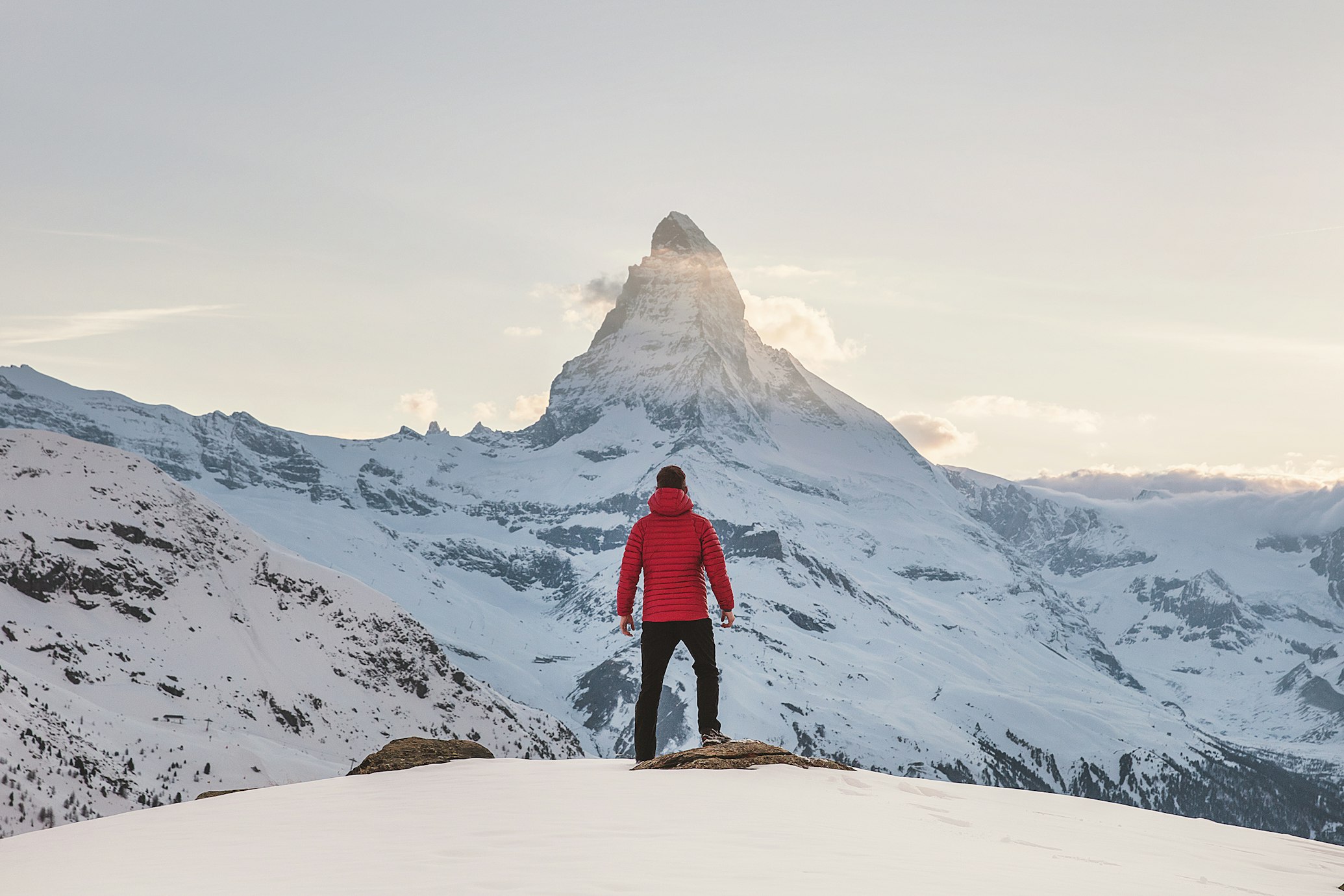
50 Resources And Tools To Turbocharge Amazon Product Scraper
.png?w=auto&h=400)
Everest Base Camp Trek
Everest base camp trek overview.
The trek to Everest camp base is one of the most adventurous and thrilling treks in Asia, which along with different kinds of trails also has the enchanting scenic natural beauty to please you with. The camp base, located in the Khumbu region of Nepal, is the gateway to the highest mountain peak in the world, therefore it’s also called “steps to heaven”. The trekkers would garner a wholesome experience of himalayan culture for as long as 12 days as they trail through the different himalayan villages with each composting its unique culture. The plan of expedition of the Everest Base Camp is tailored such that trekkers don’t feel burdened and get a good time to spend around the different sites they pass by during the journey. During the trek while passing through its shaded trails, rough and steep terrains you’d get to explore the beautiful sunset views from the sightseeing location in the village Dingboche.
Each day of the expedition would take a minimum of 4 to 5 hours of trek to complete the journey to the destination point. The leftover hours of the day could be well spent in discovering the place of your stay and at some places you’ll stay mandatorily for acclimatisation purposes, on such days exploring local markets and sightseeing locations would be best. The major and important highlighted places like Namche Bazaar, Tengboche Monastery at Dingboche, Imja Khola Valley and other places would be fun to explore as well.
Book Everest Base Camp Trek Package
Everest base camp trek, nepal, brief overview of the trek.

- Maximum Altitude of Everest Base Camp - 18,513 ft
- Duration - 8 Days
- Trekking Distance - 130 Kms
- Trail type - Difficult
- Airport - Tribhuvan Domestic Airport, Kathmandu
- Snow Season - Winter, usually starting in the month of November
- Service Available (in months) - throughout the year
- Base Camp - Lukla
- Best Season - April to early June and September to mid-December
- Region - Nepal
- Who Can Participate - The minimum age required to embark on the most thrilling trek is 15 years. The maximum age for this trek isn't specified, however if you're above 70, it would be advisable to proceed with extreme caution.Participants are required to have previous experience of at least one high altitude trek of upto 5,000/16,400 ft.
Short Glance At Itinerary For Mt. Everest Base Camp Trek
Day 1: It would be a 2 to 3 hours long trek from Lukla to Monjo.
Day 2: Move from Monjo towards Namche Bazaar over a trek of 2 to 3 hours.
Day 3: Stay at Namache for the purpose of acclimatisation. A short stroll of 20 to 30 minutes to Namche Museum.
Day 4: It would be a long day, when you walk to Phunge Tenga from Namche in 3.5 hours, then to Tengboche Monastery in an additional 2.5 hours. Stay at Deoboche village.
Day 5: A 3 hour long trek from Deoboche via Pangboche. Another 2.5 hours trek to the village of Dingboche.
Day 6: It would be the no-trek day. But you may explore the local sightseeing locations.
Day 7: You’d aim to reach Lobuche by crossing Dudh Koshi river.
Day 8: From Lobuche the trek to Gorak Shep would be arranged. It would take 5 to 7 hours to reach the Base camp and after spending some time there a return to Gorak Shep would be accomplished.
Day 9: Descend back to Kala Patthar from Gorak Shep in around 3 hours.
Day 10: Further descending to Namche Bazaar in a few hours long trek, crossing places like Tengboche and Phungi Thanga.
Day 11: The last trek of 5 hours to Lukla from Namche Bazaar.
Day 12: Transferred back to Kathmandu from Lukla.
EBC Trek Detailed Itinerary
Everest Base Camp trekking is a 12 days long expedition and the itinerary of each day is meticulously planned. Therefore, it’s advisable to read the layout of each day plan while choosing for the programme.

Trek Distance: 7 Kms | Duration: 3.5 Hours | Elevation: 2652m
A picturesque flight awaits us as we leave Ramechaap for Lukla, the entry point to the Everest region. With only one runway and a perilous location atop a cliff, this airport ranks among the most risky in the world.
When you get to Lukla, you will meet our representatives waiting to greet you.
Your first hike to Phakding begins after lunch as you follow the Dudh Koshi river's banks.
At Phakding, you spend the night.

Trek Distance: 10 Kms | Duration: 4 Hours | Elevation: 3440m
Prepare for the journey to Namche Bazaar after breakfast.
Huge, verdant mountain ranges frame the path, and the rivers Dudh Koshi and Bhote Koshi can be seen below on their respective suspension bridges.
You'll be stopping for lunch at Monjo, so stock up on nutritious necessities before continuing on to Namche, as this is the final place to eat before reaching that city.
Ascend a steep trail after receiving your Sagarmatha National Park permits at Jorsalle till you reach Namche Bazar.
On the side of a mountain shaped like an arch, you'll find Namche, the region's traditional commercial hub.
You'll be spending the night in Namche Bazaar.

Elevation: 3440m
The whole day you would stay in Namche for acclimatisation.
Spend the day sightseeing, shopping for essential items, exploring coffee shops and bars and finally dining a sumptuous meal at the restaurants.
At Namche Museum there is a lot to know about the history of the place which you can stop by while exploring the colourful Namche Bazaar.
Spend the night in the Mountain lodge/ stay houses of Namche.

Trek Distance: 8.6 Kms | Duration: 5 Hours | Elevation: 3860m
Have a hearty breakfast, and then pack up your things for the day's hike to Tengboche.
Take it slow on this flat and easy trail with stunning views of the Himalayas.
Explore the region and look for native animals like the Himalayan tahr and the monal.
Eat lunch in Phunki Tenga, a little town with teahouses and military outposts.
Discover the Khumbu region's largest Buddhist monastery, Tengboche, at the top of the mountain.
Reaching up to Deboche, make yourself comfortable and eat dinner in your house.
Spend the night in the peaceful town of Deboche, home to a number of monks.

Trek Distance: 11 Kms | Duration: 6 Hours | Elevation: 4360m
The next in the itinerary of Everest Base Camp trekking is passing the village of Pangboche through the Chortens and Mani walls.
In the village is located The Pangboche Monastery, where you’d find the fragmented mummified hand and the legends say that it came from a Yeti.
You would get tired after walking for 14 kms in upto 4 hours, then a lunch treat at Imja valley is a must before descending to Lobuche River.
Night stay would be arranged in Dingboche village for the day.

Elevation: 4360m
This another day would be spent in Dingboche for the purpose of acclimatisation and giving yourself some rest.
You would trek upto the sightseeing location of the world's top three mountain peaks- Mount Lhotse, Mount Makalu and Mount Cho Yu.
A perfect night stay would be arranged in the stay houses of Dingboche.

Trek Distance: 18 Kms | Duration: 4.5 Hours | Elevation: 4940m
You would leave Dingboche on day 7, to trek upto Dusa and along the edge to Dughla town.
While dragging yourself along the flat trail till Dughla you’d get to embrace the most beautiful Mount Everest base camp views of the expedition.
As you keep walking innumerable pinnacles like Taboche (6,542m/21463 ft), Cholatse (6,440m/21129 ft), Ama Dablam (6,856m/22493 ft), and Lhotse (8,516m/27940 ft) would cross your path.
After strolling 18 kms for over 4.5 hours across Dughla pass, you would reach Lobuche.
Finally, concluding your day at a height of 4940 metres, enjoy a tea and your stay at Tea House/ Mountain Lodge at Lobuche.

Trek Distance: 23 Kms | Duration: 6 Hours | Elevation: 5634m (Everest Base Camp)
It would really prove to be an adventurous day when you cover the longest trek so far through narrow mountain gaps with glacial moraines reflecting the morning sunlight alongside world’s highest Khumbhu glacier.
You would finally set your foot at the base camp after a 23 km long trek. After a brief lunch break before resuming the journey of Everest Base Camp trekking, as you reach the destination and enjoy every spilling emotion of happiness, victory captures every moment well.
After a 6 hour long trek and covering a trail upto the height of 5634 metre you would finally come back to Gorak Shep and stay there overnight.

Trek Distance: 11 Kms | Duration: 3 Hours | Elevation: 5550m (Kala Patthar)
After a tiring and long day, on the 9th day a short trek of 11 kms to Kala Patthar would be arranged.
You’d experience the beauty of an extraordinary sunrise view at an altitude of 5550 km which would compensate for all your hard work.
A trek back to Gorak Shep to enjoy a warm breakfast would conclude the day. After coming down to Pheriche, you’d have an overnight stay there.

Trek Distance: 19 Kms | Duration: 5.5 Hours | Elevation: 3440m
Descending the steep mountains would be fun, after a tasty breakfast at Pheriche you would come back to Namche after a 19 km long trek.
The 5.5 hour long trail would take you through Orso Somare and Pangboche tracing the west bank of Imja River.
While coming down to Namche Bazaar you would get through the dense forest of Tengboche and descend to Phunki Thengafor, where you would rest overnight.

Trek Distance: 18 Kms | Duration: 5 Hours | Elevation: 2800m
This would be the last day of trek, the challenging and soul stirring journey of Everest Base Camp trekking would be completed after descending a distance of 18 km.
You would cross over the Dudh Koshi river and take a descent route to Jorsaley national park while enjoying the blissful scenery en-route.
The trek would be headed towards Lukla via Phakding, where you would conclude the accomplishment of the most adventurous trek of Asia.
Spend a camp night at Lukla one last time and enjoy the peace and beauty of its night before returning back to your hay day life in cities.

- From Lukla, you would fly back to Kathmandu with the last glimpse of the heart melting views of Himalayas. Before finally moving back to your hometowns, take a last stroll around colourful backpackers hub Thamel.
Everest Base Camp Trek Packages

You are only a little distance away from reaching the world's summit. Cross "Trek to Everest Base Camp," a.k.a. "The World's Most Adventurous Hike," off your list.
Price Inclusions
Stay: Included in the price is your lodging in local Tea Houses or Mountain Lodges for the duration of your tour (11 nights).
Activities: Traveling to the foot of Mount Everest is a bucket list item for many.
Guide: During the trek, you'll be assisted and guided by a certified trek leader and a Sherpa. Each hiker may have their porter carry a maximum of 10 kg.
Permits: Permission to trek in Sagarmatha National Park, often known as a TIMS card. Permission to Enter the Khumbu Area. Inclusion of all federal, state, and local levies.
Transfers: Flights within the country, for transfers (Ramechhap- Lukla -Ramechhap)

You are only a little distance away from reaching the world's summit. Tick off the most daring Everest Base Camp Trek from your list.
Price inclusions
Stay: Tea Houses and Mountain Lodges for lodging throughout the tour (11 nights). Kathmandu hotels for overnight stays (02 nights)
- Activities: Journeying to the foot of the highest peak in the world
- Guide: All the way through the trek, you'll be assisted and guided by a certified trek leader and a Sherpa. Each hiker will have one porter carry up to ten kilogrammes of gear.
- Permits: Permits to trek in Sagarmatha National Park, also known as a TIMS card. Permission to Enter the Khumbu Area. All local and governmental fees.
- Transfers: Transportation to and from Kathmandu's airport. Pickup and Drop-Off at Ramechhap's Manthali Airport. Local flights (Ramechhap - Lukla - Ramechhap)
What to Pack for Your Everest Base Camp Trek?

- Heavy fleece or down jacket
- Moisture-wicking long-sleeve t-shirts
- Gortex or waterproof jacket with hood
- Fleece pants
- Moisture-wicking short-sleeve t-shirt
- Windbreaker
- Hiking shorts
- Trekking pants
- Waterproof pants
- Hiking socks
- Long underwear
- Warm thermal socks
- Sock liners

Toilet Paper
Lip balm with sunscreen
Advil or Ibuprofen
Antibiotics (Cipro for travellers’ diarrhoea)
Medical tape, Moleskin, duct tape for treating/preventing blisters
Diamox (for altitude sickness)
Anti-chafe balm
Diaper rash cream (Can treat rashes or chaffing)
Personal prescriptions
Toothbrush/toothpaste
Hand sanitizer
Razor (as needed)
Face lotion
Feminine hygiene products

Duffle bag for carrying gear
Trekking Gear & Supplies
Water bottles or hydration bladder
Waterproof cover for daypack
40L Daypack
Lightweight water filter or iodine water tablets
Travel pillow or pillowcase
Headlamp with extra batteries
Sleeping bag rated to -18°C/ 0°F
Hand warmers
Camera with extra batteries and memory cards
Quick-drying trekking towel (optional)
Small lock(s) for duffle bag and daypack
Sleeping bag stuff sack
Drybags in several sizes
Stuff sacks for dirty clothes/shoes

- Snacks & Food
- Rehydration powder or gels
- Snacks (combine protein & carbs)
- Thermos (optional for hot beverages)
- Important Documents
- Passport (needed at entry gate for registration)
- One passport-size photo
- Travel insurance
- Money ($200-300 cash is recommended)
- Additional Supplies
- Journal/pen
- Playing cards
- Portable solar charger/power bank
Know Before You Go to EBC Trek

Taking the 25-minute flight to Lukla from Kathmandu is the most convenient route to the Everest base camp. Due to ongoing repairs and renovations, however, flights between Kathmandu and Lukla are now departing via Ramechhap Airport (Manthali Airport) instead of the original route. Jiri is also accessible through road, which can be taken to continue on to Lukla. Additionally, a helicopter service is available to transport you from Lukla to Kala Pathar. To get to the base camp, also known as Gorak Shep, from Lukla, you'll have to pass through Phakding, Namche Bazaar, Thyangboche, Dingboche, and Lobuche.

Anytime from late May and mid-Sep is the ideal time to visit Everest Base Camp. The best times to embark on a hike are between the months of September and November, or February and May, when the weather is relatively predictable, the views are unobstructed, and the temperature at Base Camp rises to a comfortable minus six degrees Celsius. At the end of April or the beginning of May, you might also run into teams of mountaineers at Base Camp, getting ready for their summit bids on Everest. Although the temperatures between late November and early February are exceptionally low—around -15°C during the day and even lower at night—clear skies are typically the norm, and quieter routes and teahouses add to the exhilarating sense of untamed remoteness.
It is possible to walk to Everest Base Camp in January even if there may not be much snow, but it is freezing.
- February and March
Nighttime temperatures in February and early March can drop to roughly -20°C, but clear skies should allow you excellent visibility of Everest during this time. In addition, there will be fewer people on the path, and the teahouses will be more peaceful, making the journey to Base Camp feel more like an expedition.
- March and April
March and April are peak hiking months because of the higher temperatures and the abundance of rhododendrons and other flowers further up the trail. The lengthening of the days means there will soon be plenty of time to go sightseeing, especially since the early mornings will be bright and clear. Late in April, you might see climbers in Base Camp acclimatising before starting their ascent to Camps I, II, and III on Everest's slopes, and then making an attempt at the summit.
In early May, just before the monsoon, you can still make the trek to Base Camp, though you may have to share the area with mountaineers who are engaged in a series of 'rotations,' in which they climb higher and higher before retreating to Base Camp to rest and recoup before attempting to reach the summit.
- June July and August
The monsoon season in Nepal begins in late May and continues through the months of June, July, and August, into the beginning of September. Trails are muddy and infested with leeches, the mountains are frequently shrouded in cloud, and landslides are regular and disruptive to travel during the rainy season, even though it may not rain continuously throughout the day.
- September, October and November
Towards the end of September, as the monsoon winds down, the autumn trekking season begins. The weather is perfect for hiking in the months of October and November, thanks to the lack of precipitation and the resulting abundance of clear skies and clean air. Daytime highs are around -10 degrees Celsius at Base Camp, which is cooler than the spring season, but the days are dry and the scenery is beautiful.
Even though it will be much cooler in late November and December (with nighttime lows well below freezing), these months are also ideal for going on a hiking adventure. People who want to avoid the cold will likely abandon their treks, which means the trail to Everest Base Camp will be much less crowded.

It is advisable to the trekkers to not bring any non-biodegradable material along and contribute to sustainable tourism.
While following the difficult Everest base camp trek, all the participants must follow the instructions of the trek leader and guide for their own safety.
Don't push yourself too hard; instead, take it easy and let your body relax and recuperate between daily hikes. Experiencing pain and exhaustion when hiking is inevitable, so make sure to get enough rest and take pain medication as needed.
All the participants are required to carry enough money at hand because you won’t find ATMs in Lukla at short distances.
Pack an efficient daypack with all the essentials like warm clothes, sunglasses, trekking boots, gloves, socks, woollen caps, medicines, rainwear, water bottles and other essentials
Before setting off on a trek, one of the most crucial things to consider is whether or not you have the proper gears. Thus double-check your gears to make sure nothing will let you down.
Take a note that sunburn at higher altitude might happen quicker, so keep your skin and eyes safe with moisturiser and sunglasses.
Keep extra batteries for head torch and other electronics handy as the batteries in cold might die quicker than at home.
- Don’t forget to carry water bottles along and keep yourself hydrated throughout the trek.

In order to reach Everest base camp, one can explore the various routes available. All the routes are unique, and adventurous in their own ways and ready to welcome you in their pleasant beauty while offering challenges simultaneously. However, here is explained the shortest route from Kathmandu to the base camp via Namche.
Kathmandu to Lukla ( 130-140 km) - The intriguing Everest base camp trek begins from Lukla which is the gateway to Everest region. In order to reach Lukla, you'd require to take a plane from Kathmandu and land at Lukla airport, one of the most risky airstrips in the world.
Lukla to Namche - After the commencement of the iconic trekking, As the trailhead and entry point for the EBC Trek, Lukla is where the journey begins. You begin your ascent from Lukla and hike to Phakding before continuing up to Namche Bazaar. Namche is a great tourist hub and is renowned for its breathtaking Everest view from a comfortable elevation.
Namche to Everest Base Camp- To reach the destination of base camp, on moving out of Namche trekkers would ascend to the villages of Pangboche, Tengboche, Dingboche, Lobuche and the renowned Gorakshep. The trail would continue for a minimum of 8-10 days.
General Trivia About EBC Trek

There are two base camps for Everest trekking, one in the North at Tibet and the other at South in Nepal. Everest Base Camp, in the Khumbu region of Nepal is the endpoint of this legendary trek for Everest.
While following the trek to the base camp you would pass the famous Sherpa village of Dingboche. It’s the home of Tenzing Norgay,the first person to climb Everest.
Edmund Hillary and Tenzing Norgay had marked the south base camp of Everest in Nepal and stored their supplies at the mountain base and that is how the Everest Base Camp was born.
Every trekker aspiring to climb Mount Everest makes sure to stop at Tengboche Monastery, which has the largest Buddhist gompa in the valley to light candles and seek blessings. Overtime, it has become a very significant ritual without which a trekking event won’t even be started.
Why To Go for Everest Base Camp Trek?
Everest base camp trek is one of the most sought-after trek routes where the trekkers from across the globe arrive to escape the fast cities and gain a valuable soul stirring experience. As they climb up the base camp in Nepal covering an impressive 17,598 feet height, not only do the trekkers overcome obstacles of the journey but also enjoy the serene splendid beauty of the mighty mountains. The trek is considered amongst the most famous treks in Himalayas for being towards the edge of the world's highest peak as well as due to the kind of adventure it offers. While following the trail one gets to enjoy the magnificent sights of mystical monasteries and Sherpa villages, the highlights of the trek would also include Kala Patthar, Gorak Shep and Sagarmatha National Park Museum.
You May Also Book
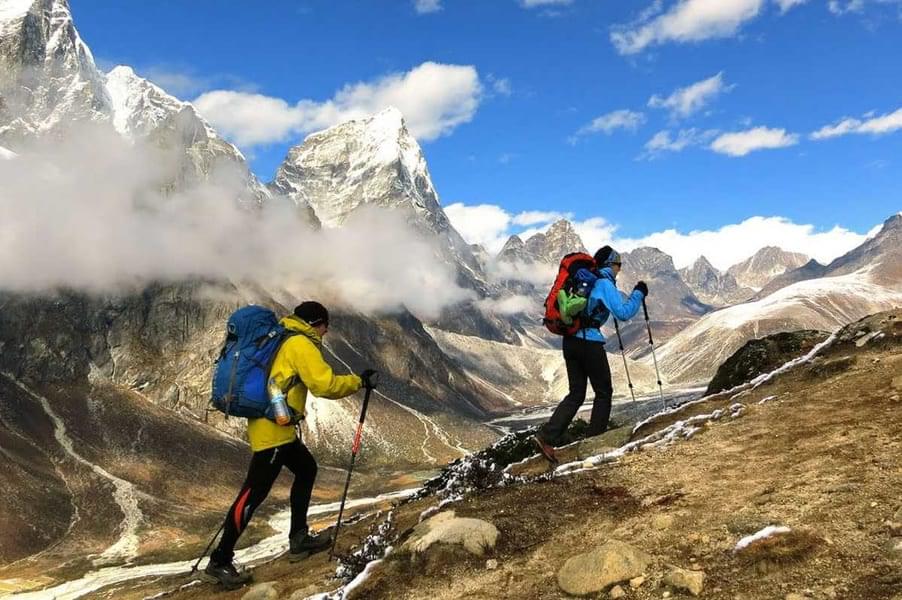
FAQ's of Mt. Everest Base Camp Trek
How difficult is the everest base camp trek.
The trek to the Everest Base Camp is among the most difficult treks in Asia. But, that shouldn’t discourage you from going on the trek because the difficulty level of the trek is moderate. The trail of the trek passes through the villages of Nepal which are located at higher altitude. The passage is diverse, sometimes quite harsh but other times smooth, therefore the trekker won’t require any expertise and past experiences in trekking for joining in. You would be walking 8 hours per day for a continuous 12 to 14 days to finally land at the formidable Khumbu Icefall. Therefore, it’s advisable to add a good exercise schedule in your daily routine as well, to keep yourself in physically good shape to not face any problem during the trek like cramps and fatigue. he basics like walking, jogging, squats and stair climbing would be sufficient though you may add other exercises as per your bodily requirements. Try to be consistent with the exercise schedule and keep repeating the exercises for longer duration.
What is the best time to go on a trek at Everest Base Camp?
The schedules for Everest Base Camp are arranged throughout the year, but the best and suggested months to plan a trek would be March to Mid June ( spring season) and September to Mid December ( Autumn season). The valleys and villages of Nepal become more beautiful and pleasant during these months and seasons of the year.
How many days are required for Mount Everest Base Camp trekking?
The level of difficulty of the trek is modest and it takes around 12 to 14 days to complete it via the route from Lukla where you land after an adventurous plane ride from Kathmandu. The usual route passes through the town of Namche, villages of Pangboche and Dingboche and Khumbu region to finally land at the Everest Base Camp.
What are the package inclusions of Mount Everest trekking?
A round trip between Kathmandu and Lukla via flight.
Accommodations throughout the trip are covered in the package.
Different sightseeing short treks would be arranged.
Entry permits for Sagarmatha National Park, TIMS and Khumbu region would be covered.
The essential facility of porters who would carry luggage weighing upto 10 kgs.
A basic medical kit would be provided during the onset of the trekking.
What is the total length of the Everest Base Camp trekking?
The total length of the trek is around 130 Km, with 65 Km falling on each side. This distance can be usually covered between 12 to 14 days at ease.
Do you need any special training for the Everest Base Camp trek?
The trek of Everest Base Camp is considered moderately difficult, but you won’t require a special training to participate in the trek. The trek doesn't involve a very steep mountainous trail, it also has smooth and shaded pathways which makes the passage pleasant to tread. You may still include a basic set of exercises in your daily schedule like walking, cycling, swimming and other such cardiovascular activities.
How much heavy backpack should you pack for Mt. Everest Base Camp trek?
Your backpack should have the capacity to carry at least 60 Litres of weight. Don’t worry if you have packed extra stuff, you would have potters accompanying you to carry at least 10 kg of your load.
What are the nearby places in Kathmandu which can be visited?
While going for a trek to Everest Base Camp and your stay at Kathmandu you can visit other nearby places like Pashupatinath Temple, a sacred hindu temple complex; Thamel, a local market place which is quite famous for its coffee; Garden of Dreams, it’s the perfect place to rejuvenate your spirits after the 12 days long trekking tour; and, at last you can visit Hanuman Dhoka Temple.
What is the Everest base camp height?
The height of the Everest base camp varies. Like, the camp will be located at 5,380 m (18,513 ft) on the south side of Mount Everest in Nepal if your climb is beginning from the south east ridge. When approaching the Kala Pathar from the Gorakshep valley, your base camp elevation will be 5,545 metres.
Which is better: Everest Base Camp or Annapurna Circuit?
Because it is a longer route overall, the Everest Base Camp trek is more difficult than the Annapurna Circuit trek.The Annapurna circuit is a little easier because the average height is substantially lower, and there are less hard ascents.
Is Everest base camp hard?
Yes, it is a moderately demanding destination. Usually, two weeks are needed for the trek. The EBC Trek doesn't necessitate any prior trekking experience, but it is recommended that the trekker be both determined and physically fit.
Can a beginner go to Everest Base Camp?
Yes, Absolutely, beginners can participate in the Everest Base Camp Trek. The trek to Everest Base Camp is recognised for its gentle gradients and only a few hard ascents, making it certainly doable by beginners as well.
How cold does it get at Everest Base Camp?
It is quite cold at the Everest Base Camp. There is perpetual snow on top of Mount Everest besides a lot of severe weather. At Everest Base Camp, you can easily anticipate a nighttime temperature range of -20 to -3 degrees Celsius.
How far is the walk from base camp to Everest Summit?
From Nepal's Everest Base Camp, the peak of Everest is another 20 kilometres away. About 40 or 45 days are needed to make the ascent to the top of Everest. This is because hikers have to set up at least four separate camps in different areas, supply each one with essentials like food and fuel, and then return to the original base camp.
Treks in Himachal
Treks in uttarakhand, treks in ladakh, treks in nepal, treks in north-east, treks in kashmir.
.png?w=auto&h=400)
The content and images used on this site are copyright protected and copyrights vests with the respective owners.
© 2024 www.heyhimalayas.com All rights reserved.

Base Camp Adventure

- Email: [email protected]
Three Passes Trek vs Everest Base Camp Trek

The debate over which destination is better for hiking – Three Passes Trek or Everest Base Camp has been raging over for a few years. Although they are more alike in that they both lie in the Everest region and both are tremendously popular, there are still so many differences that don’t let them associate.
Both Everest Base Camp and Three Passes are primarily known for their astonishing views, sweeping landscapes, and unique geographical features. But, behind their amazing scenes, there are many challenges that trekkers have to overcome to reach the finishing line.
Trekking is more difficult in the trail of Three Passes than Everest Base Camp, with a larger walking through innermost reaches without human settlement. Rising up an altitude of 5,535 meters , Three Passes Trek is relatively more difficult than Everest Base Camp.
Trekkers can quickly run out of breath on the trail of Three Passes as it’s more inclined and rough. It also means that Everest Base Camp has more craze than the Three Passes as many trekkers navigate the trail. It’s even traveled by mountaineers climbing Mt. Everest and those visiting Kala Patthar and Island Peak.
Meanwhile, hikers traverse Three Passes to explore Gokyo Lakes, surrounding snow peaks and sweeping landscapes. Some smart travelers do take time from their busy days and manage to take a round trip of both places. But, it’s rare as they have to spend a lot of time on the trail, which is not feasible for all travelers.
Difficulties of Three Passes Trek vs Everest Base Camp Trek

Although it’s hard to assess which trek is more difficult between Three Passes and Everest Base Camp as both lie in the Khumbu region, it’s easy to see why trekkers hesitate a little bit to hike Three Passes. It may start easy, walking the same course as Everest Base Camp from Lukla, but the trail gradually gets tougher.
It traverses mountainous terrain filled with sharp rocks and boulders that draws all the energy. Hikers walking the trail quickly get tired and exhausted due to the continuous rising path. In Three Passes Trek vs Everest Base Camp Trek, the effect of atmospheric pressure is more extreme on the former due to rapid exposure to higher elevation up to 18,100 ft.
It witnessed trekkers passing glacial moraine and over the Imja Tse before heading to Ngozumpa Glacier. The trails also cross Kongma La Pass, Cho La Pass, and Renjo La Pass to end up at Gokyo, from where the views are incredible.
Visitors will get to explore almost half a dozen tranquil lakes that have fed on glaciers. It includes Thonak Lake, Dudh Pokhari, and Gokyo Lake. They’ll get to enjoy the magnificent sight of Mt. Everest, Cho Oyu, Makalu, and Lhotse.
Meanwhile, trekkers don’t struggle on the trail of Everest Base Camp as much as they do on Three Passes. The trails indeed have a few ups and downs with some steep slopes and lofty hills, but that’s all it is. With many small settlements along the way, trekkers have plenty of places to stop over and have a break during the Everest Base Camp Trek.
It’s rare for hikers to suffer from extreme altitude sickness like hypoxemia and pulmonary edema. Most of them only show minor symptoms like headache, dizziness, and nausea since the impact of low oxygen is relatively less here.
The path heading to Base Camp is steep but not as rough as Three Passes. Most hikers only struggle while trekking on the course between Lobuche and Gorakshep due to loose rocks and frozen lakes. For the most part, they only have moderate hiking trails that pass through wild forests, remote villages, and river valleys.
Read details on how difficult is EBC trek ? & Three Pass trek difficulty
- Full Name *
- Contact Number
- Your Message/Inquiry *
Everest Base Camp Trek:
- Flight from Kathmandu – Lukla – Phakding
- Phakding to Namche Bazaar
- Acclimatization in Namche
- Namche to Tengboche
- Tengboche to Dingboche
- Dingboche for acclimatization
- Dingboche to Lobuche
- Lobuche to EBC via Gorakshep
- Gorakshep to Kala Patthar and back to Pheriche
- Pheriche to Namche Bazaar
- Namche Bazaar to Lukla
- Fly back to Kathmandu
Everest Three Pass Trek
- Kathmandu to Lukla to Phakding
- Trek from Phakding to Namche
- Acclimatization in Namche Bazar
- Dingboche to Chhukhung
- Chhukhung to Lobuche
- Gorakshep – Kala Pattar – Dzongla
- Dzongla to Gokyo Lakes via Cho La Pass
- Acclimatize in Gokyo and hike up to Gokyo
- Gokyo to Renjo-La Pass to Lunden
- Lungden to Namche
- Namche to Lukla
- Lukla to Kathmandu
Weather on Three Passes Trek vs Everest Base Camp Trek

Everest Base Camp is often pictured to have unpredictable weather, and so does Three Passes with low precipitation and temperature. High wind storms and snowfall are experienced at both treks, depending on the season. Frequently changing weather at both base camp and Three Passes makes the hike extremely difficult for travelers.
Hence, it’s no doubt that both these treks experience some significant changes in weather with the varied season. But, if compared, the weather in Three Passes is slightly more brutal than Everest Base Camp due to higher elevation.
Spring and Autumn are the most likable seasons for climbing Three Passes with pleasant weather and high temperature. It goes the same for Everest as well. They put up the best weather and marvelous scenery for hikers of base camp.
It’s around this time when the climate is warm and friendly, making it easy for trekkers to climb the way up to Kongma La Pass. Mild weather, clear views, and extra hours of daylight make the Everest Base Camp hike comfortable and easy.
The climate in winter at base camp varies from Three Passes, where trekkers have to bear the arctic cold. Travelers visiting base camp will also have to brave cold weather but not as severe as the other one. Even though it’s frosty, the weather is still bearable, and there are only a few sections that are layered in thick snow.
Meanwhile, During Three Passes, visitors are required to walk beside the glacial moraine of Ngozumpa and navigate the rocky terrains that are hidden in thick snow. Walking the trail is hard during the season as it’s super sticky and sloppy. In winter, the average temperature at Everest Base Camp ranges from -6 to -13 Degree Celsius, whereas at Three Passes, the temperature drops up to -19 Degree Celsius .
Acclimatization on Three Passes Trek vs Everest Base Camp

With the trail going continuously upward, trekkers will have to dedicate some of their time to physical fitness and well-being at Everest Base Camp and Three Passes. Trekkers will have to acclimate before climbing high to adjust to new climatic conditions and weather.
Trekkers of Everest Base Camp are usually recommended to take a rest at least three times throughout the trip. However, some pro trekkers find the trail to base camp easy, so they skip a day or two and ascend the trail without a break.
Meanwhile, for trekkers of Three Passes, there’s no option for escaping the acclimatization, especially when they have higher chances of suffering from altitude sickness. Trekkers have to take a full rest before going to a higher altitude where there’s low barometric pressure.
Visitors trekking both Three Passes and Everest Base Camp stops at Namche Bazaar for acclimatization. After that, trekkers have to take different trails, while Everest Base Camp visitors take a day off at Dingboche; trekkers at Three Passes stop at Chhukung Valley.
Trail running to Chhukhung from Dingboche is sheer and runs from the edge of the valley, which is exhausting for anyone. Adding more trouble, the paths are filled with rock, debris, and ice sheets which is why they have to relax before facing the challenges.
Leaving aside a few hikers, almost every climber here also acclimatizes at Gokyo before heading up. They spend their days visiting the Gokyo Lake and ascending the path to Gokyo Ri, which provides an astonishing view of surrounding snow-capped mountains and glacial lakes, and rocky hills.
Cost of Three Passes Trek vs Everest Base Camp

If you think there’s a huge difference in the price of Three Passes Trek vs Everest Base Camp, then you’re mistaken. The price gap between the treks doesn’t even come to notice unless trekkers look closely at it.
The cost for Three Passes Trek can range from US$1,400 to US$2,000 , depending on various factors. Our package costs only $1425.
The trek itinerary can also cause a significant change in the cost of the Three Passes Trek. It means the longer you intend to stay in the region, the higher it’s going to cost.
Our Everest base camp trek package costs $1220.
Accommodation and food also affect the price of Three Passes Trek and Everest Base Camp. Since there are not many settlements on the trail of Three Passes, they’ll have to carry tents and sleeping bags which causes the rise in cost.
But, then again, they don’t have to pay the charges of tea houses which cost US$4 to US$6 per night. At higher elevation, it costs even more due to fewer accommodation options. Snacks and drinks are only available in the lower region so, trekkers of both Everest Base Camp and Three Passes will have to pay an equal amount.
However, for hikers of Everest Base Camp, there are more choices for dwelling. From guest houses to homestays and tea houses, trekkers can book a room anywhere they like in the lower region. But, after going at a higher altitude, they’ll have no options but to stay in a tea house which costs around US$3 to US$5 and more.
Trekkers will also have to pay US$30 for the trek permit of Sagarmatha National Park and an extra US$10 for TIMS. Hiring a porter and guide can cost anywhere from US$25 to US$30. If you exceed the backpack’s weight by more than 25 kg , expect to pay even more.
And hiring a guide will cost you $30-$35 per day.
Flying from Kathmandu to Lukla will cost them an amount worth US$150 to US$200 . If they choose to fly the town via private helicopter, the cost will rise with a total sum of US$400 for a maximum of 5 people. It means each passenger onboard will incur a cost of US$600 or more, depending on the number of travelers.
Crowds at Three Passes Trek vs Everest Base Camp

Considering that the Everest Base Camp is the most visited trek destination, it’s more crowded than Three Passes. Trekkers from far across the world traverse their trail to catch the magnificent view of Mt. Everest along with Ama Dablam Cho Oyu and Nuptse.
Those who have come to visit Kala Patthar or ascend the summit of mt. Everest and even Island Peak walk the main EBC trail. As a result, the trek route of Everest Base Camp remains busier as compared to Three Passes.
There are more traffic jams on the main EBC trail, making it inconvenient for hikers. Most of the hikers aren’t able to reach the destination on time as visitors block the paths. It’s hard to maintain the pace on such trails and even enjoy the privacy.
On a positive note, trekkers of Everest Base Camp will never feel alone as they’ll always have someone to accompany them. Accommodation and food will surely be a problem with more trekkers on the journey, but if you learn to cooperate, that won’t matter.
On the other side, Three Passes offers a more peaceful walking path to the trekkers. Since not many hikers take the long walk to Gokyo and instead pave their way from the EBC trail, it’s more quiet and pleasant.
The trails are, of course, difficult but not impossible to navigate. Trekkers have to hire a trekking guide or porter who can guide them along the path as it’s tough to get a company on Three Passes. The accommodation also gives them a tough time as there are barely any villages above Dzongkha.
Accessibility of Three Passes Trek vs Everest Base Camp

To a greater extent, Three Passes Trek vs Everest Base Camp is quite similar to each other. They both kick off from Lukla and make their way through Phakding and Namche Bazaar. Unfortunately, the trek ahead splits up, with the walk to Three Passes becoming more difficult and strenuous.
As a multi-day trek, Three Passes has a more challenging walking trail that is rugged and uphill. Trekkers get easily tired after Chukhung as the paths are steeper and narrow. Of course, a lot override sharp rocks, moraines, and valleys that can’t be easily traversed.
They take several hours of walking along with strong physical stamina and endurance power. The trail heading to Lobuche via Kongma La and Gokyo through Cho La Pass is jagged with continuously elevated crust, stones, and rocks.
Hikers have to climb the mountain ridges and cross several bridges to arrive at Gokyo. Since there are only a few settlements on the Dzongkha and Lungde, they have to spend the night at a tented camp.
Compared to Three Passes, Everest Base Camp is more easily accessible with shorter trek routes. It treats the hikers fairly by providing them a trekking route within reach and has not many difficulties. They start the trip in a big way by taking a flight to Lukla that’s scenic and comes with a mesmerizing view.
From Lukla, trekkers have to climb up the hillside to Phakding and then Namche Bazaar. En route, they have to cross multiple suspension bridges, pass several villages and craggy hills. After a day off at the Sherpa town, they head to Tengboche with a gentle uphill walk which takes 5-6 hours depending on the speed.
The trail running to Dingboche is slightly steep with stone stairs but not as bumpy as Three Passes. Most hikers struggle to navigate the route from Dingboche as they are uneven and crammed with large stones.
The low barometric pressure at the high altitude also makes the trek to Everest Base Camp difficult but not inaccessible. They can even walk the trail of Everest Base Camp but with a bit more precaution and preparation.
Preparation of Three Passes Trek vs Everest Base Camp

Preparation for Three Passes Trek vs Everest Base Camp trek is very much the same. Trekkers have to come prepared before each hike since walks have uneven paths with mountainous terrain and lofty hills. They’ll have to spend a good amount of time in the gym to keep themselves ripped.
However, the physical training for Everest Base Camp is different from Three Passes. While trekkers can go a little easy on the Everest Base Camp trek exercise, excuses can’t be made for Three Passes Trek.
Assessing physical fitness, they’ll have to plan a workout program that helps them increase the strength in major muscles and build endurance power. They have to spend at least a month on cross-training and exercise to stay fit and in top shape.
Not just that, they’ll also have to improve their balance which can be done with the help of cardio exercise. Jogging, cycling, brisk walking, and running will help a lot in developing physical stamina.
Apart from that, they’ll also have to take a few short and long walks, if possible, on different terrains. In that way, they’ll be able to beat the jagged trails of Three Passes without any difficulty.
For Everest Base Camp, trekkers don’t have to follow intense workouts or spend hours and hours in the gym. Since it’s moderate trekking, they can follow regular exercise and keep the body in shape so that there won’t be a lot of trouble walking the path.
Trekkers can spend less than a month on athletic training and diet to easily defy the zigzagged trails. It’s even better if they also take a few short hikes. In that way, they won’t get exhausted even while climbing the steep hills.
- 4+3=? * Solve above and submit button will appear!!!
You may also like...

Mardi Himal Trek in December

Nepal Tea House Trek

Easy Treks in Nepal

IMAGES
VIDEO
COMMENTS
It's the biggest safety issue when hiking to Everest Base Camp. At Everest Base Camp, the air only has 50% of the oxygen of the air at sea level. This makes it harder to get the oxygen your body needs - you'll hike slower, and take more breaks (which is normal and totally fine!). You also may experience some altitude sickness.
The typical Everest Base Camp itinerary is as follows: Day 1: Flight from Kathmandu to Lukla; trek to Phakding. Day 2: Phakding to Namche Bazar. Day 3: Acclimatization day in Namche Bazar. Day 4: Namche Bazar to Tengbouche. Day 5: Tengbouche to Dingboche. Day 6: Acclimatization day in Dingboche. Day 7: Dingboche to Lobuche.
The Everest trek gets you closer to the heart of the high mountains than the Circuit, which offers more in the way of traditional village life. Finally, Everest Base Camp is an out-and-back trek, so you'll repeat some sections, whereas Annapurna is by its nature an A to B loop. Annapurna's trails start an hour's drive from the town of Pokhara ...
For a complete cent-by-cent cost breakdown of our trek to Everest Base Camp in 2020. Cost of trekking to EBC in different ways in a nutshell: Package tour EBC trek with international agency $1700. Package tour EBC trek with local agency $1600. Independent EBC trek with a guide and porter $1370.
This classic trek takes place in the Bagmati Zone of Nepal and allows you to experience the immense beauty of the surroundings. Along your trek, you will get to witness 4 of the 6 highest mountain peaks in the world — Cho Oyu (8,201 m), Mt. Makalu (8,470 m), Mt. Lhotse (8,516 m), and Mt. Everest (8,848 m). Everest Base Camp is a teahouse trek ...
The Everest Base Camp Trek unfolds as a visual symphony of nature's grandeur, where each step reveals a new stroke of beauty on an ever-changing canvas. The journey begins amidst verdant forests and soon, the terrain transforms into a rugged expanse of rocky trails, challenging every step and demanding a steadfast spirit.
Classic Everest Base Camp trek. The classic Everest Base Camp trek takes about 14 days, including time in Kathmandu before and after. From Kathmandu, you'll fly into Lukla Airport (2,860m/9,383ft) with its famously short runway - try to sit on the left side of the plane so you can catch your first views of Mt. Everest.
Temperatures on the Mt Everest Base Camp Trek can range from 5 °C (40 °F) to 20 °C (70 °F) depending on month, and as low as -30 °C (-22 °F) at night during the winter months. If you trek during the warmer months (Mar-May and Sep-Oct), the cold is not a big problem and shouldn't be hard to cope with. Winter is a different story.
The Everest Base Camp Trek is a classic adventure! IMG offers treks through the Khumbu Valley of Nepal to the Everest South Side Base Camp as well as through Tibet to Everest North Side Base Camp. Dozens of companies offer Everest Treks, but we believe our experience, safety precautions, and solid record of trekking and climbing in the ...
THE ESSENTIAL GUIDE. In this guide we cover everything you need to know about the Everest Base Camp Trek in Nepal. This includes suggested itineraries and practical information about accommodation, costs, what to pack, independent vs. guided treks, transport, and more. We also offer a route map with GPX download for use on the trek.
The Chadar Frozen Trek is renowned as one of the world's most iconic and challenging treks, offering a unique and extraordinary experience for adventurers. Takes trekkers through the starkly beautiful and remote landscapes of Ladakh, providing an opportunity to witness the untouched beauty of the region. Trekkers traverse the frozen Zanskar ...
The Annapurna Base Camp Trek is less difficult than the Everest Base Camp Trek. Here's why: Altitude, terrain, and duration affect how challenging a trek is. Annapurna Base Camp is at a lower altitude, making it easier on the body due to more oxygen. The terrain in Annapurna is gentler compared to the rough trails of Everest.
The ABC trek leads you to Mount Annapurna (8,091m/26,545ft), the tenth-highest mountain in the world. This 110km (68 miles) round-trip trek takes you through diverse landscapes, from terraced fields to lush forests and glacier valleys. The ABC trek typically take s 8-10 days and has the highest altitude at 4,130m (13,550ft) at Annapurna Base ...
The Everest Base Camp Trek is known for its higher altitude and more challenging terrain. The trek reaches a maximum altitude of 5,364 meters (17,598 feet) at Everest Base Camp. The trail involves steep ascents, rocky paths, and the risk of altitude sickness. Proper acclimatization and physical fitness are crucial for a successful trek.
Trek to the Everest Base Camp with Adventure Pulse and dominate the dramatically exciting sport of high altitude trekking! The Everest Base Camp trek is the highest trekking route available to outdoor enthusiasts and nature lovers, thus making it not only one of the most challenging, but also, one of the most beautiful treks in the Himalayas ...
The Everest Base Camp trek takes trekkers through the rugged and dramatic terrain of the Khumbu region. From lush green valleys dotted with Sherpa villages to barren, rocky landscapes at higher elevations, the trek offers a stark contrast in scenery. Trekkers will cross glacial moraines, high mountain passes, and the Khumbu Icefall, all while ...
Both the Everest Base Camp trek and Annapurna Circuit route have pretty good mobile phone reception and 3G connectivity. Naturally mobile reception can be spotty in certain of the more remote places. But one of the boons of trekking with a local guide - as our clients do - is that guides are able to advise you on the best spots for ...
The classic Everest Base Camp trek from Lukla to EBC and back is 130km long - 65km each way - which may sound like a lot of trekking! Fear not, because the typical round trip to Everest Base Camp takes around 12 days, the actual distance you will be covering each day will be about 15km - a much more reasonable and achievable number.
Everest Base Camp Trek: The EBC trek typically starts with a flight from Kathmandu to Lukla, a small town in the Khumbu region of Nepal. Lukla has a small airport. Lukla has a small airport. From Lukla, trekkers usually hike to Phakding and then on to Namche Bazaar, a bustling market town and the gateway to the Everest region.
Brief Overview of the Trek. Maximum Altitude of Everest Base Camp - 18,513 ft. Duration - 8 Days. Trekking Distance - 130 Kms. Trail type - Difficult. Airport - Tribhuvan Domestic Airport, Kathmandu. Snow Season - Winter, usually starting in the month of November. Service Available (in months) - throughout the year. Base Camp - Lukla.
The trek itinerary can also cause a significant change in the cost of the Three Passes Trek. It means the longer you intend to stay in the region, the higher it's going to cost. Our Everest base camp trek package costs $1220. Accommodation and food also affect the price of Three Passes Trek and Everest Base Camp.